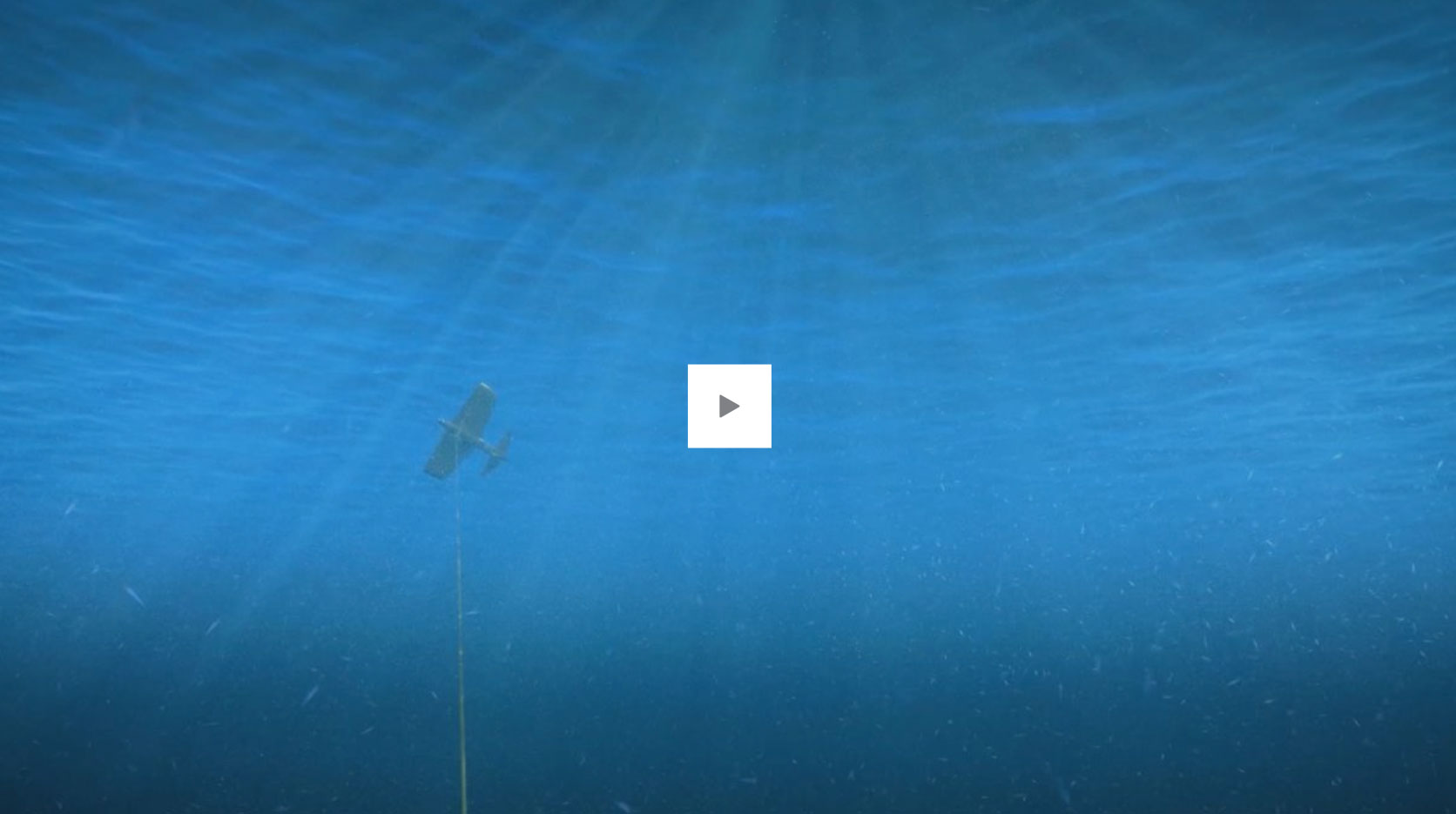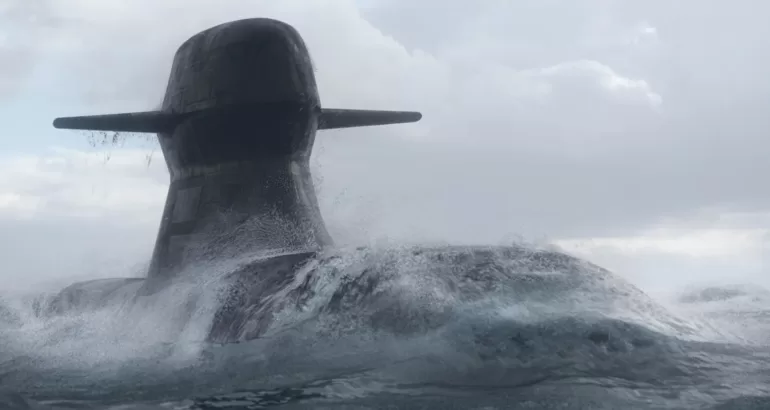4 November 2024
Saab’s Seaeye SR20 eWROV succeeds in milestone water trials
Saab UK announces that the Seaeye SR20 eWROV, its most advanced fully-electric work-class remotely operated vehicle, has successfully completed inshore water testing.
The SR20 successfully completed a dedicated period of water trials last month, marking a significant milestone for the robotic vehicle’s development.
The testing was a key part of the verification and validation work package, testing against the specification, measuring performance, and stressing the Remotely Operated Vehicle (ROV) as a system. In particular, the SR20 demonstrated its high degree of precise manoeuvrability and dexterity, using both manual joystick control and automation. This testing has paved the way for sea trials which will take place in spring 2025.
Andy Fraser, Managing Director at Saab UK, said:
“The SR20 going to water trials is a huge milestone in Saab UK’s journey to take electric ROV capabilities to the next level, focusing on eco-responsibility and greater efficiency. We’re thrilled that the trials were a success and I look forward to seeing what the next step is for this ground-breaking vehicle.”
The SR20 is Saab UK’s highly capable and environmentally-conscious work-class underwater vehicle, which is designed for operational concepts such as resident deployment and over-the-horizon control. The all-electric vehicle, which uses limited oil (reducing its environmental footprint), sets itself apart with its exceptional thrust and performance, electric manipulators, and impressive efficiency compared to hydraulic systems.
Ocean Infinity is the SR20’s launch customer, transforming operations using innovative technology as they develop a fleet of uncrewed robotic vessels.
2 July 2024
Saab’s Seaeye Cougar-XTi stood out due to its remarkable carrying capacity, a crucial factor for HBC Group’s operations. The Cougar-XTi is a highly flexible and extremely powerful electric ROV, depth rated to 2000m. The ROV is fitted with six 500 Volt, DC thrusters that provide exceptional thrust for stable vehicle operations in high current environments.
These features allow the transport of survey equipment that was previously too large for HBC Group’s existing ROVs, catering to the specific needs of clients, particularly those in offshore wind farms.
The versatility of the Cougar-XTi extends to carrying specialised tools for hydrographics and geophysical services. HBC Group utilises PMAC Group’s system for cathodic protection measurements, and the manipulator arms play a crucial role in non-destructive testing.
Christian Eilersen, CEO at HBC Group Said:
“We are thrilled to elevate our offshore inspection capabilities with the Seaeye Cougar-XTi. This advanced ROV enables us to meet the unique needs of our clients in offshore wind farms, and its addition to our fleet reflects our ongoing commitment to excellence and innovation in the field of offshore inspections.”
Looking ahead, HBC Group plans to deploy the Cougar-XTi for daily inspections, allowing them to bid on tenders that were previously inaccessible due to payload constraints. The order/capability is expected to open new avenues for the company in the offshore wind sector.
Jon Roberston, Managing Director at Saab Seaeye said:
“We’re thrilled to empower HBC Group with the advanced Seaeye Cougar-XTi. This sale underscores our commitment to delivering top-tier equipment, redefining standards for efficiency and reliability in offshore operations.”
In addition to the Cougar-XTi, HBC Group highlighted the success of its previous ROV purchase with Saab, the Seaeye Tiger. The company noted its reliability and higher uptime compared to previous ROVs. The Tiger has played a crucial role in recent inspections on offshore wind farms in Denmark, the UK, and Germany, particularly in waveform inspections.
The addition of the Cougar-XTi to HBC Group’s fleet signifies the company’s commitment to staying at the forefront of technology in the offshore inspection services sector.
29 March 2024
Owner of largest fleet of Seaeye Falcon ROVs buys five new units
Aberdeen-based Underwater Contracting (UCO), owner of the largest fleet of Saab UK’s Seaeye Falcon remotely operated vehicles (ROVs), has purchased five new units for a total of 38 Falcon systems.
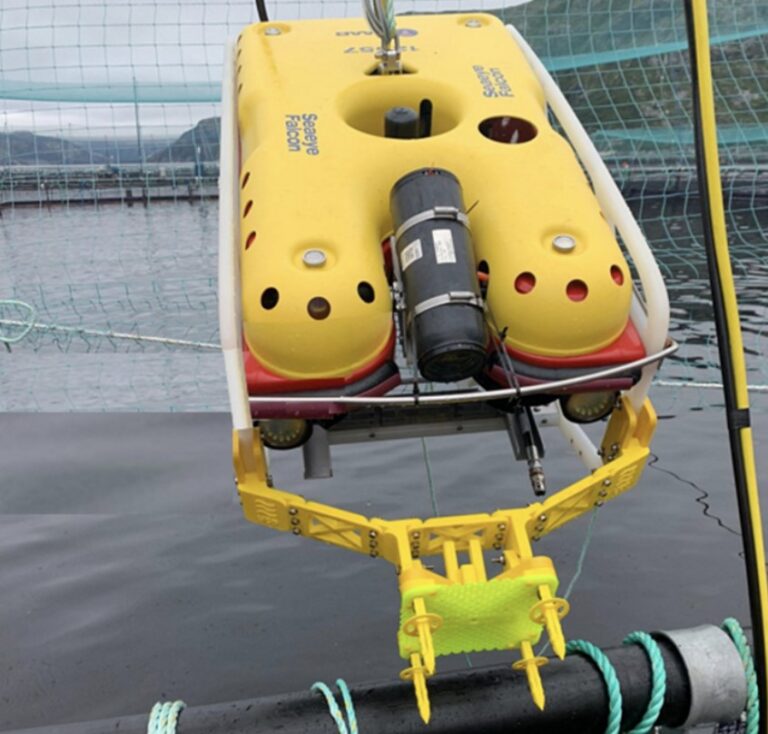
UCO said it had expanded its fleet in response to major new multi-year contract wins across all sectors which will see it provide a range of services in Europe, North America and the Middle East.
In addition, the company announced it had made significant investment in additional equipment and now holds a stock of £250,000 dedicated Saab Seaeye Falcon spares and more than £350,000 worth of auxiliary equipment ranging from manipulators to station holding and everything in between.
“Adding these additional systems to our fleet will enable us to respond to the upsurge in business and the major new contracts we have won in recent months,” said Mick Bower, UCO Managing Director.
“We have also made significant investment in adding to our stock of in spares and auxiliary equipment for the Falcons, so we can respond immediately to any issues or additional requirements that might arise during the delivery of our services for existing and new clients. Providing excellent customer service is integral to the way we run our business and having these items to hand when we need them, avoids unnecessary delays for our clients.”
6 October 2023
INDONESIAN CUSTOMER SAYS SEAEYE FALCON TOPS OTHER BRANDS
Jakarta-based PT Fabila Teknik Sejahtra, has bought Saab’s Seaeye Falcon remotely operated robot, declaring it superior to other brands.
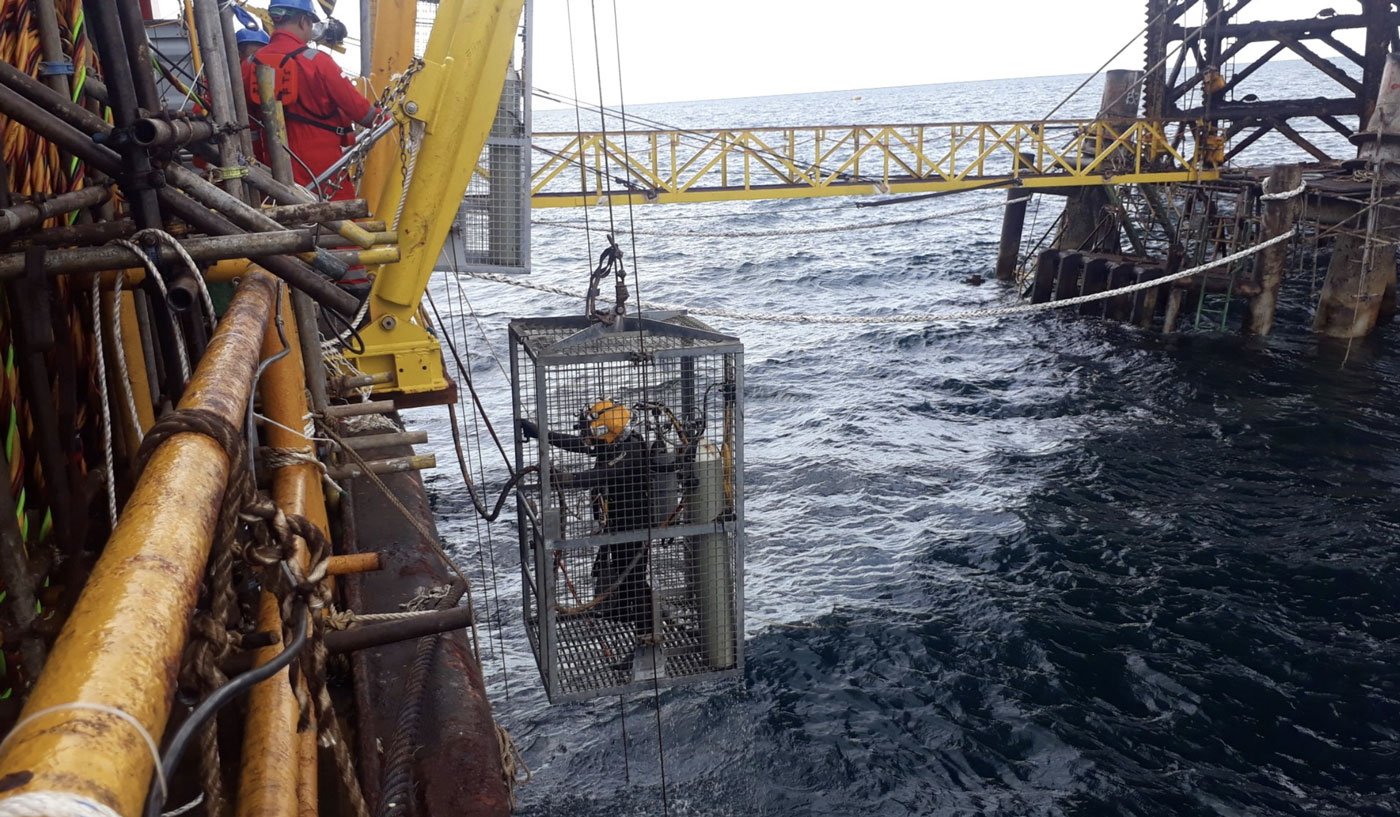
PT Fabila’s marine and offshore undertakings include condition inspection and surveys throughout Indonesia.
The diving company will deploy the Falcon in their marine and offshore contracting services support across Indonesia.
“The Falcon’s performance is far better than other brands and is the clear choice of many other diving companies,” says PT Fabila director, Enif Widoyoko,
Important to Fabila is the Falcon’s reputation for mastering the challenge of strong currents and being “tougher” than competitive brands, Enif Widoyoko says.
He also finds that Saab has an advantage concerning support:
“Information such as the operating manual, wiring diagrams and troubleshooting guides are complete and comprehensible, spares are easy to order and their distributor, Unique, is easy to work with.”
As PT Fabila’s marine and offshore undertakings include condition inspection and surveys, their Falcon comes fully equipped for the tasks including a Tritech Gemini sonar, a cathodic potential probe kit, Cygnus ultrasonic thickness gauge and a rotary wire cleaning kit.
For diving companies, the Falcon plays a vital role by undertaking missions too hazardous for divers, such as where the depth of water and strength of current become dangerous for divers.
The Falcon can also improve diver safety and increase efficiency by pinpointing and examining locations of interest before sending down divers.
The world’s most successful robotic vehicle in its class, the Seaeye Falcon has a reliability record covering over a million hours underwater.
Just a metre in size, it is easily manhandled and its intelligent control architecture, combined with five powerful thrusters allows precise manoeuvrability in turbulent waters amongst complex structures, whilst loaded with various cameras, sensors and tooling typically found on much larger robotic vehicles.
.jpg)
The world’s most successful robot, the Seaeye Falcon, with a million hour underwater record, can work in strong currents at a wide range of both complex and hefty tasks whilst handling an array of tooling, sensors and skid configurations.
Saab Seaeye is world leader in electric underwater robotics.
PT Fabila Teknik Sejahtra is committed to advancing technology and services in the marine and offshore industry.
For more information contact:
Matt Bates
Saab Seaeye Ltd
+44 (0)1489 898000
Email Matt Bates
www.saabseaeye.com
Enif Widoyoko
PT Fabila Teknik Sejahtra
+ 62 21 830 8618
Email Enif Widoyoko
www.fabilats.com
7 September 2023
MORE SEAEYE FALCONS FOR UCO
Owners of the world’s largest fleet of Saab UK’s Seaeye Falcons, Underwater Contracting (UCO), has ordered a further six Falcons, boosting their fleet to 33 vehicles.
.jpg)
Seaeye Falcon is capable of handling UCO’s hugely successful FOOVER mortality recovery system.
This follows the award of further major contracts in the aquaculture, renewable, and oil and gas sectors to UCO that will see the Falcon fleet working continuously over multi-year contracts providing a range of services in Europe, North America and Australia.
Specialists in ROV operations, UCO has successfully deployed Seaeye Falcon underwater vehicles since 2018 across three continents covering various sectors of industry.
In that time UCO has productively utilised the power and intelligence of the Falcon system when designing and developing industry-leading technologies, including their FOOVER Mortality Recovery system, NETFIX Net Repair system and G-LANCE Cage Cleaning system, inspection cleaning tools.
They chose the Falcon as the world’s top selling underwater robotic vehicle in its class and for its versatility.
The Falcon is designed and manufactured at Saab UK’s Fareham site.
Underwater Contracting Ltd (UCO), based in Aberdeen, is a leading provider of underwater services for the maintenance of aquaculture sites throughout Scotland, North America, Canada and Europe and is part of the Ocean Marine Group.
Saab Seaeye is world leader in electric underwater robotics.
For more information contact:
Matt Bates
Saab Seaeye Ltd
+44 (0)1489 898000
Email Matt Bates
www.saabseaeye.com
Mick Bower
Underwater Contracting Ltd
+44 (0)1224 872861
Email Mick Bower
www.underwatercontracting.com
3 August 2023
SEAEYE FALCON KEY IN JAPAN’S OFFSHORE WIND ENERGY
Japan’s expanding offshore wind industry has added a further Seaeye Falcon underwater robot as a key operational resource for working in complex environments.
.jpg)
The world’s most successful robot, the Seaeye Falcon has a proven record across many different markets, working reliably at a wide range of both complex and hefty tasks whilst handling an array of tooling, sensors and skid configurations.
Tokyo based systems provider Marimex says Japan’s wind power construction operators value the Falcon for being a compact and powerful robot that is ideally suited for shallow waters and strong currents.
The small footprint of the metre-sized Falcon is also important for offshore energy operators as construction is carried out using fleets of small service vessels needed in shallow waters.
Growth in Japan’s offshore wind power construction comes as the Japanese Government seeks to achieve carbon neutrality by 2050.
Marimex says that the Falcon’s broad operational capability means that not only can it be used for preliminary surveys, but also for post-construction maintenance monitoring and many other applications.
As the world’s top selling robotic vehicle in its class, the Falcon has a reliability record covering over a million hours underwater.
The success of the highly portable Falcon comes from combining intelligent control architecture with five powerful thrusters to enable precise manoeuvrability in turbulent waters amongst complex structures, whilst loaded with a wide range of cameras, sensors and tooling, typically found on much larger robotic vehicles.
Saab Seaeye is world leader in electric underwater robotics.
Marimex Japan KK is primarily involved in importing and selling ROVs and providing maintenance services and is a Saab Seaeye distributor.
For more information contact:
Matt Bates
Saab Seaeye Ltd
+44 (0)1489 898000
Email Matt Bates
www.saabseaeye.com
Mifuyu Shoji
Marimex Japan KK
+81 3 5858 8467
Email Mifuyu Shoji
www.marimex.co.jp
17 May 2023
SEAEYE FALCON PICKED FOR ARCHAEOLOGY AND OFFSHORE ENERGY
Italy’s DST (Deep Sea Technology) has chosen a 1000m-rated Saab Seaeye Falcon DR robotic vehicle to support archaeological research and offshore energy.
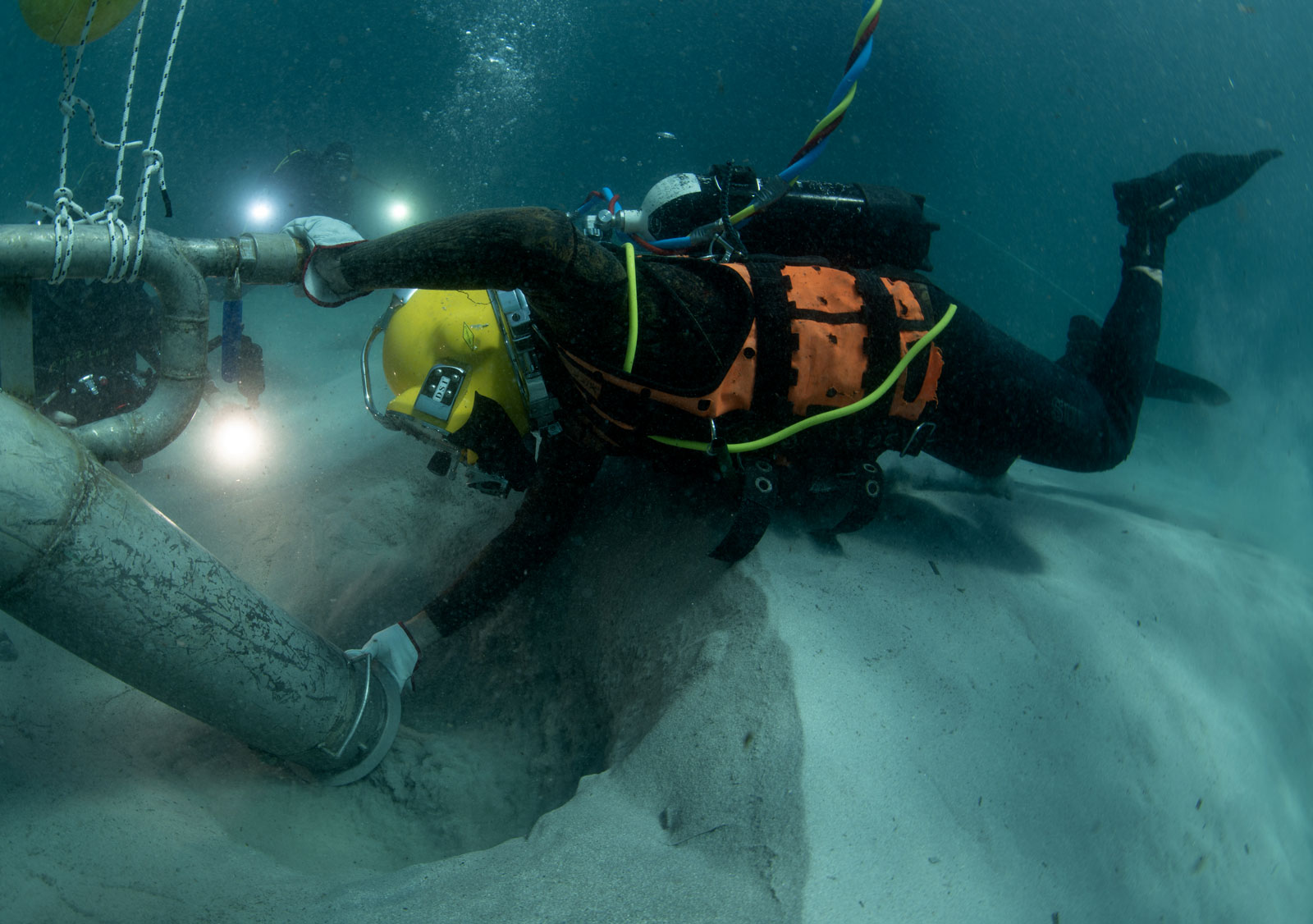
DST divers working on the wreck of a Spanish galleon off the Sardinian west coast.
The Seaeye Falcon DR will be employed by Naples-based DST, a commercial diving business, across its operations supporting offshore energy and maritime archaeology in both shallow and deep waters. The Falcon package includes a Tritech Super SeaPrince sonar and skid-mounted five function manipulator and rope cutter.
“The Falcon DR will extend our operational capabilities,” says Alessandro Scuotto, CEO of DST. “It will operate in both single configuration and for diver support and we plan to further enhance the vehicle with new system options in the future.”
The Seaeye Falcon has a proven record globally in many marine archaeological missions involving filming, recording, surveying and delicately recovering artefacts when appropriate.
During diving operations, the Falcon can helpfully preview dive sites, watch over divers and save time by transporting tools and materials back and forth.
As the world’s most successful robotic vehicle in its class, the Seaeye Falcon has a reliability record covering over a million hours underwater.
Its success comes from having the power and intelligent control to handle a wide range of resources for undertaking numerous intricate and demanding tasks in strong currents and turbulent waters.
Just a metre in size, the Falcon is easily manhandled, and its iCON™ intelligent control architecture, combined with five powerful thrusters, allows precise manoeuvrability amongst complex structures, whilst loaded with various cameras, sensors and tooling, typically found on much larger robotic vehicles.
.jpg)
The world’s most successful robot, the Seaeye Falcon has a proven record in many marine archaeological missions involving filming, recording, surveying and delicately recovering artefacts when appropriate.
Saab Seaeye is world leader in electric underwater robotics.
Deep Sea Technology (DST) operates in the underwater sector, both in deep and shallow waters, specialising in a wide range of services including the design, construction, installation and maintenance of subsea pipelines and offshore structures, underwater research and recovery.
For more information contact:
Matt Bates
Saab Seaeye Ltd
+44 (0)1489 898000
Email Matt Bates
www.saabseaeye.com
Alessandro Scuotto
DST (Deep Sea Technology)
+39 081 553 5816
Email DST
www.deepseatechnology.com
4 May 2023
LOTOS CHOOSE SEAEYE LEOPARD FOR BALTIC FIELDS
LOTOS Petrobaltic, part of multi-energy concern ORLEN, has ordered Saab’s Seaeye Leopard work class robotic vehicle to service underwater infrastructure within Poland’s B3 and B8 oil fields in the Baltic Sea.
.jpg)
LOTOS Petrobaltic chose the Leopard for its operational versatility, voting it the best amongst competitors.
After evaluating other work vehicles on the market, LOTOS Petrobaltic chose the Seaeye Leopard for its versatility and ability to accommodate far more equipment options for a wider range of tasks.
Current tasks include the comprehensive inspection of underwater structures, construction cleaning, cutting, dredging for inspection, basic support for head installations and support for diving teams.
The Leopard’s adaptability is particularly important for LOTOS Petrobaltic. The vehicle’s design means it can be expanded and configured in the future to perform comprehensive measurements and underwater works and inspections for a wide range of customers. It will be equipped with a survey package to include multi-beam sonar, LIDAR and pipetracker.
Their current Leopard configuration includes a Sonardyne DVL/INS survey system, Sprint-Nav INS, Digital Edge recording and event system, five cameras including Kongsberg HD system, also a One Laser for video and measurement, Tritech Super Seaking sonar, a seven-function manipulator, Schilling Orion gripper, electric torque tool, rotary disc cutter, WeSubsea dredge system, FlexiClean cleaning tool, water jet system and caviblaster, Cygus ultrasonic thickness gauge, multiplex survey pod and tooling sled.
The Leopard package also includes a tophat tether management system (TMS), an ‘A’ Frame launch and recovery system (LARS) and a custom control cabin.
At the same time, LOTOS Petrobaltic is preparing their supply vessel, Bazalt II, as a dedicated operational platform for the Leopard, including adapting it to receive the LARS system and the custom configured control cabin, along with additional peripheral systems.
The 3000m-rated Seaeye Leopard is the top-selling electric work vehicle of its class and the most powerful of its size in the world, enabling it to tackle large and complex work tasks previously performed by much larger hydraulic systems.
At half the size of an equivalent hydraulic work vehicle, operators find the Leopard more agile and responsive and able to handle stronger currents and wave motion. It can also tolerate higher environmental temperature ranges and has a considerable acoustic advantage for survey work over hydraulic equivalents.
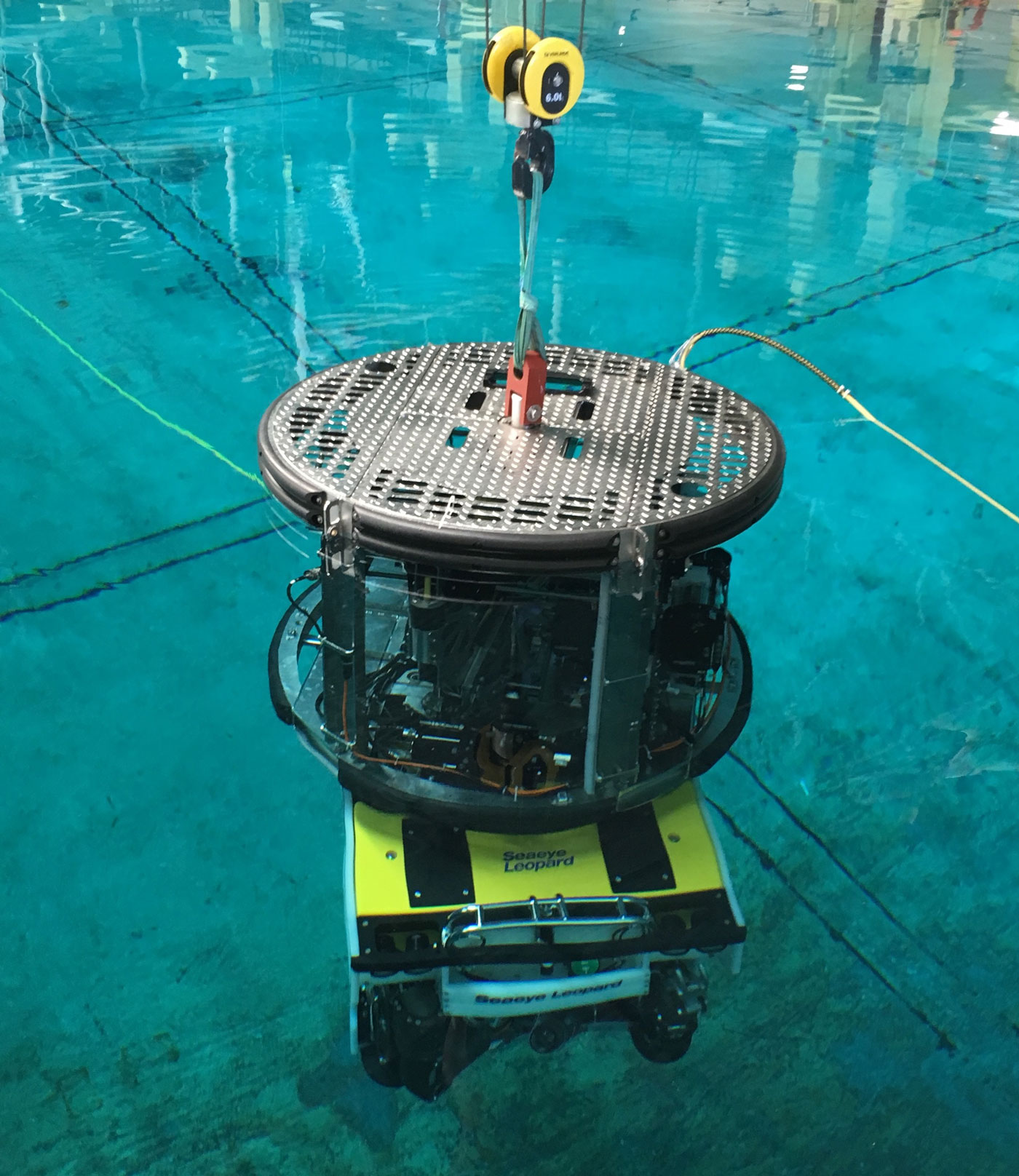
The 3000m Seaeye Leopard is the most powerful work robot for its size in the world with the versatility to tackle large and complex work tasks performed by much larger hydraulic systems.
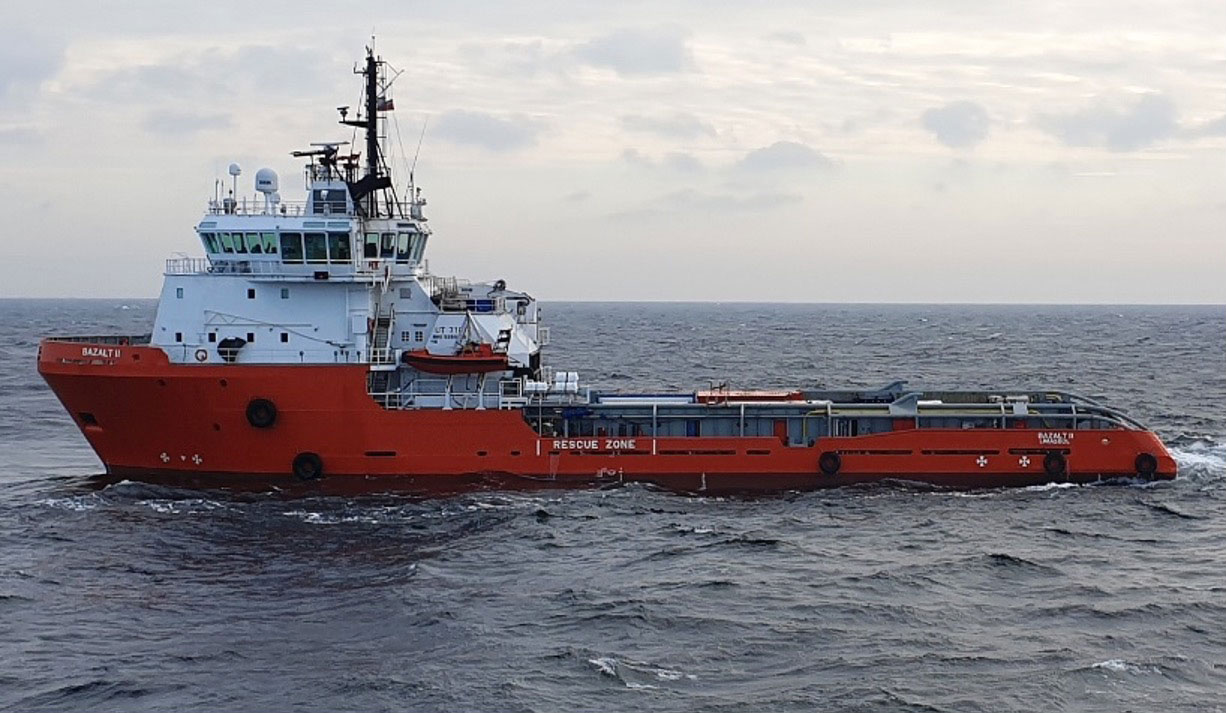
The supply vessel Bazalt II is being configured as a dedicated operational platform for the Seaeye Leopard.
LOTOS Petrobaltic implements the strategic objectives of the ORLEN Capital Group in the exploration and production of hydrocarbons.
Saab Seaeye is world leader in electric underwater robotics.
For more information contact:
Matt Bates
Saab Seaeye Ltd
+44 (0)1489 898000
Email Matt Bates
www.saabseaeye.com
Grzegorz Zajfert
Miliana Shipmanagement Ltd
+48 500 002 419
Email Grzegorz Zajfert
www.lotos.pl
19 April 2023
SAAB SEAEYE LEOPARD FOR SPANISH NAVY SUBMARINE ESCAPE AND RESCUE
A £multi-million complete Saab Seaeye Leopard system has been supplied to the Spanish Navy for submarine escape and rescue, and underwater intervention.
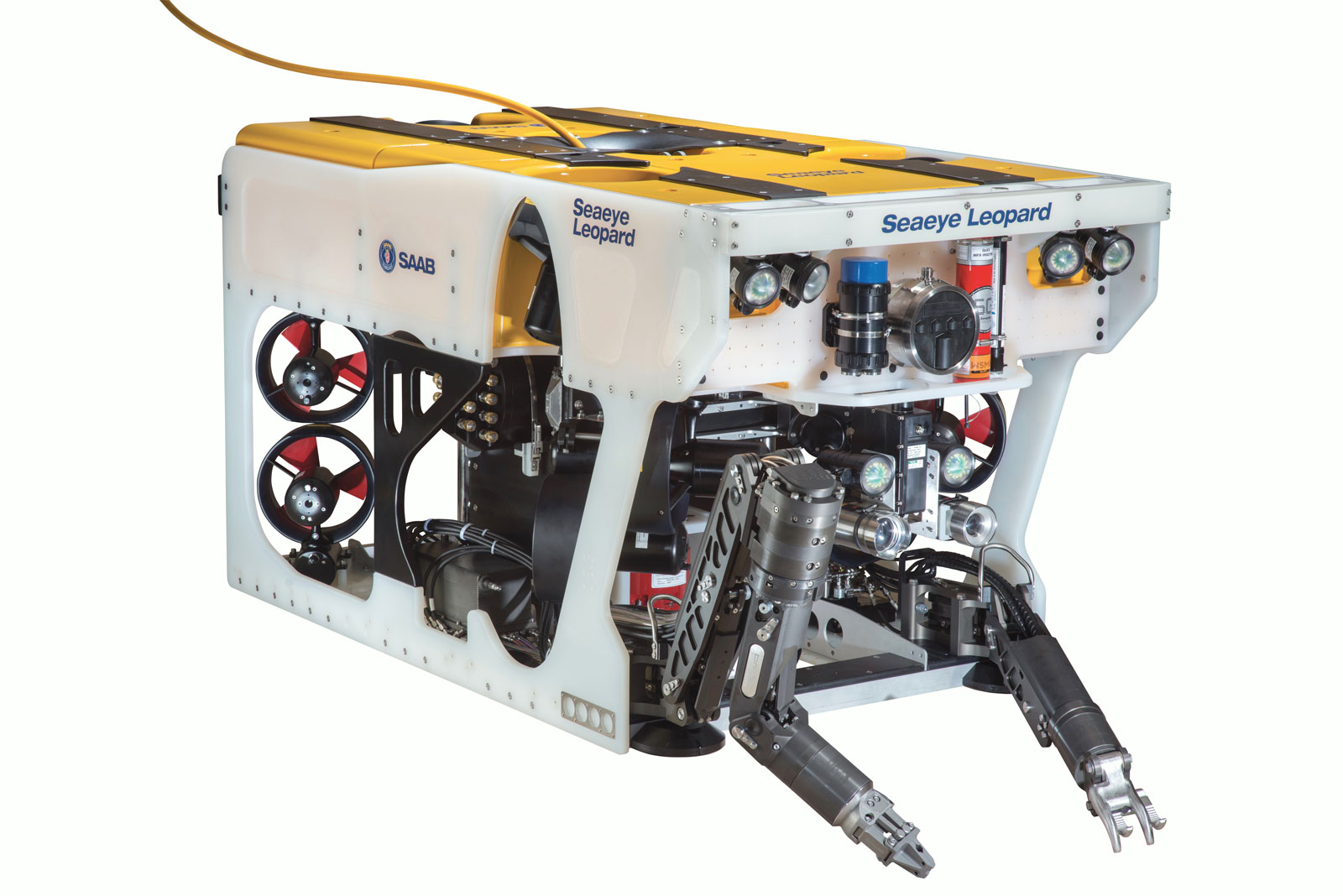
Saab Seaeye Leopard: the most powerful electric work vehicle of its size in the world.
The NATO Support and Procurement Agency (NSPA) acquired the Seaeye Leopard electric remotely operated robotic vehicle system for the Spanish Navy to fulfil the responsibilities of the International Submarine Escape and Rescue Liaison Office and provide diving support.
It is the first codification by NATO for a remotely operated vehicle meeting their standards. The Leopard also met the Spanish Navy’s full ISO/IEE 15288 standards for remotely operated vehicles, along with their standards for the control cabin.
The Leopard can locate and survey a distressed submarine using its array of sonar systems and cameras to provide both colour zoom and low-light black and white video images for rescue planners. In urgent rescue situations the Leopard can work tirelessly 24 hours a day, for days on end in challenging conditions.
According to the information provided by the Spanish Navy through NSPA the Leopard will also contribute enormously to the Spanish Navy underwater intervention capability, especially in the areas of salvage operations, underwater search and reconnaissance and diving support activities.
Assisting in the procurement process has been Saab Seaeye’s Spanish-based distributor, Marine Vision, who will also engage in on-going support.
Life support
To help keep the crew alive, the Seaeye Leopard can transport and insert pods carrying emergency life support stores into the submarine — and attach ventilation hoses. For debris clearance the Leopard has powerful work-class manipulators, along with a six-inch rotary disc cutter and a 38mm anvil cutter.
The complete package includes a tether management system which acts as a subsea garage for the Leopard and from which it is flown when reaching the operational depth. The Leopard was chosen over its hydraulic alternative as the Leopard is typically 50% more efficient, 30% more compact and 50% lighter than an equivalent hydraulic vehicle.
Umbilical cables and handling systems are also significantly smaller and lighter, leading to lower deck loading requirements, smaller deck footprints, smaller vessel requirements and smaller transportation needs.
Air transportable
Included is a pilot’s control cabin and the entire system, or relevant free-swimming or tether-management configurations, is in the process of being certified for air transportation aboard an Airbus A400M to fulfil a global role in rescue operations.
Powerful and manoeuvrable
The most powerful of its size in the world, the Seaeye Leopard has 11 powerful thrusters and with its iCON™ intelligent control is more highly manoeuvrable in strong currents than a hydraulic vehicle and, being acoustically quieter, can produce more accurate sonar data.
Saab Seaeye’s intelligent control system offers pilots better handling characteristics — including pitch and roll stabilisation — for best quality survey data, whilst delivering stable flight even when fitted with large tools and transporting heavy loads.
Importantly, iCON™ gives clear and enhanced information to the operator and pilot whilst independently managing each device on the vehicle, including auto redundancy, ensuring the vehicle keeps working even with multiple equipment damage.
Simulator
Included in the procurement is a complete simulator system for pilot training that will simulate the operation of the Leopard during a rescue mission.
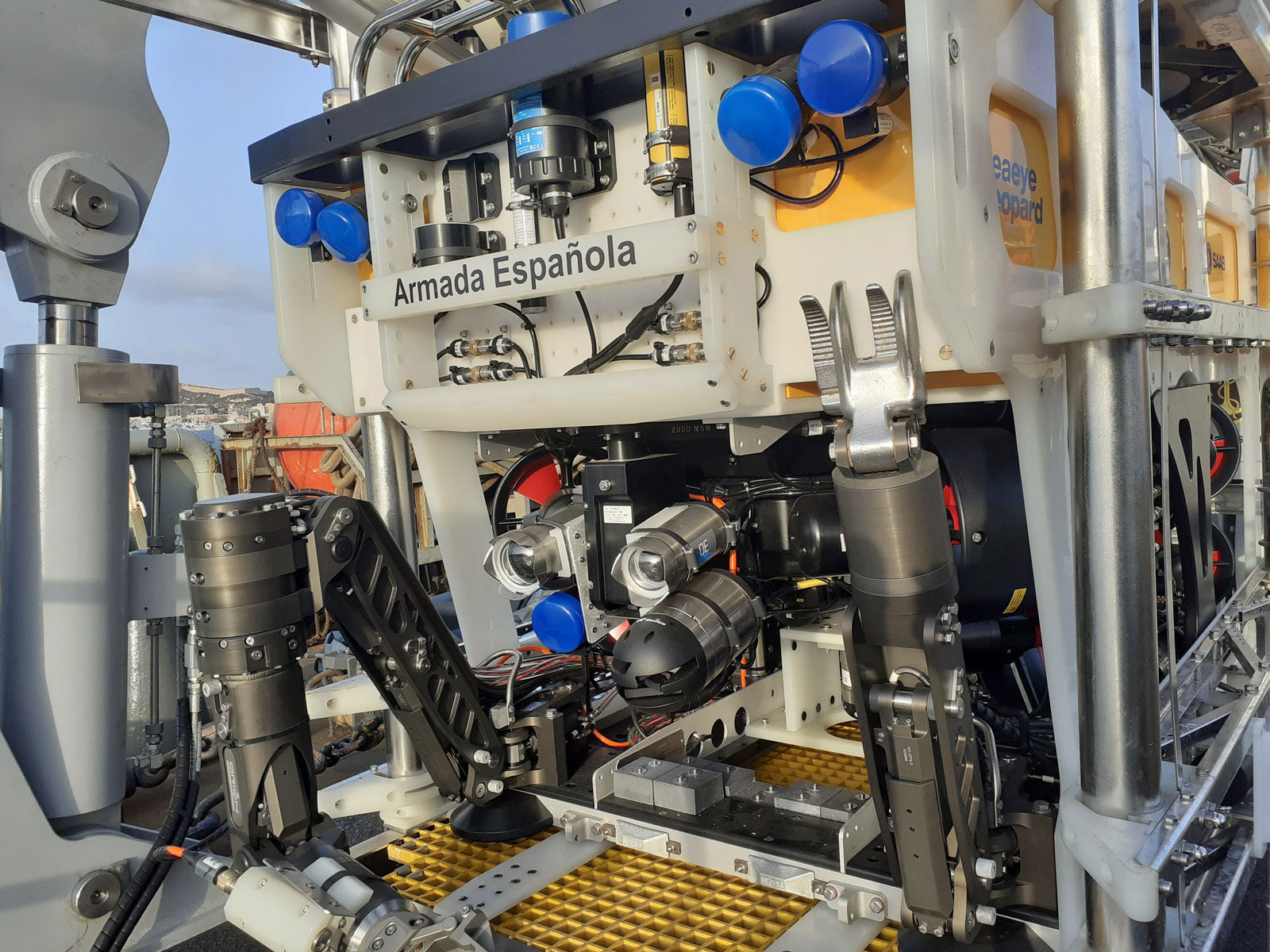
The Spanish Navy’s Saab Seaeye Leopard.
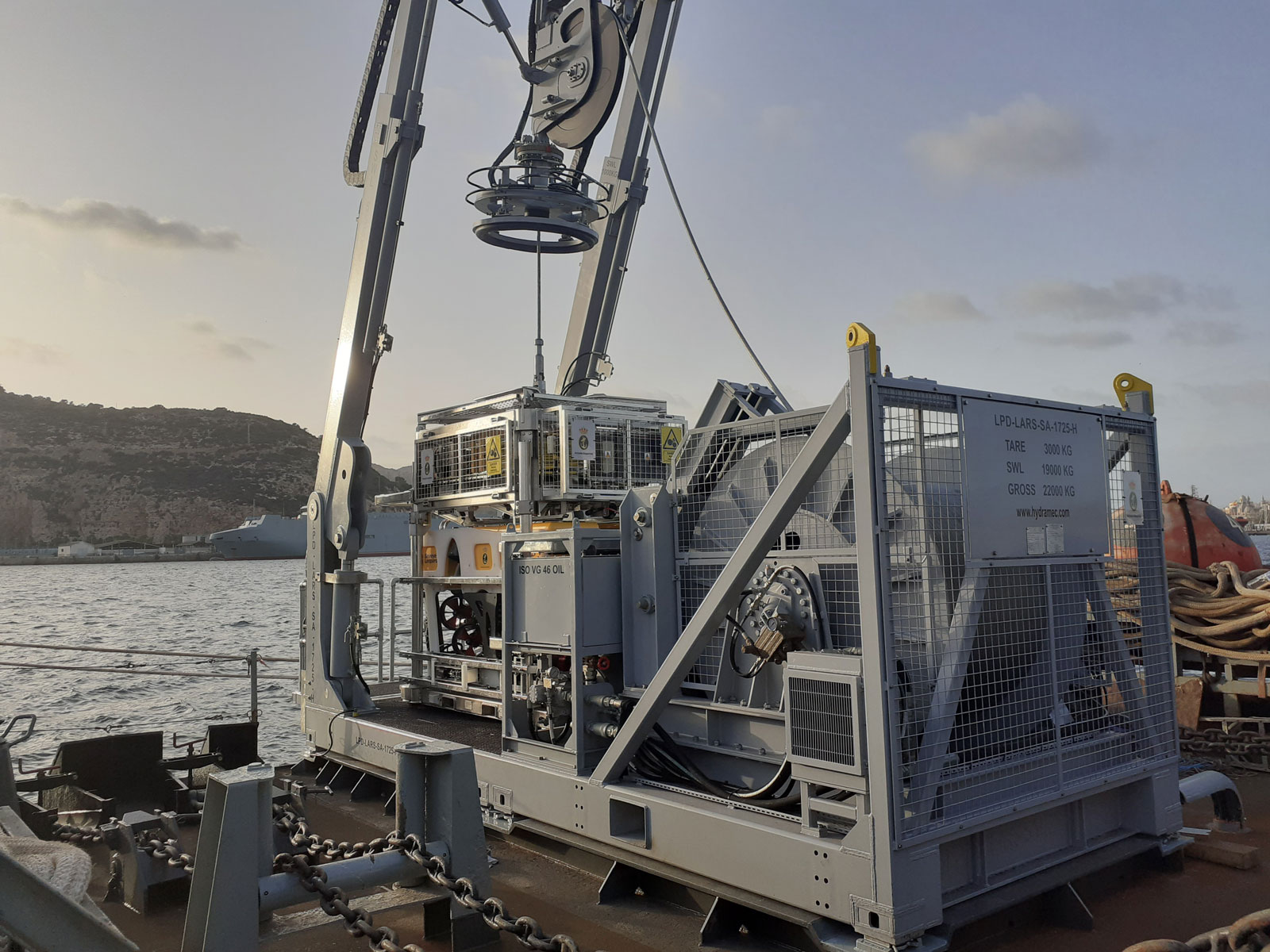
Complete Saab Seaeye Leopard system, including TMS and LARS installed on Spanish Navy vessel ‘Neptuno’.
Saab Seaeye is world leader in electric underwater robotics.
For more information contact:
Matt Bates
Saab Seaeye Ltd
+44 (0)1489 898000
Email Matt Bates
www.saabseaeye.com
31 March 2023
FALCON FLIES DEEPER IN CANADA’S FIRST NATION WATERS
Ocean Dynamics has ordered a second, deeper-rated, Saab Seaeye Falcon for the inspection of instrumentation monitoring of the ocean around Canada’s northwest coast and First Nation coastal waters.
.jpg)
The 1000m-rated Falcon can be fitted with a wide range of tools, sensors and cameras and remain steady in strong currents and turbulent waters.
Already an owner of a 300m-rated Seaeye Falcon, Ocean Dynamics’ President, Josh Chernov says he chose the new 1000m-rated fibre optic Falcon because it can accommodate HD cameras and has the flexibility for integrating more advanced technologies.
Josh Chernov says the Falcon has proved to be reliable and able to stay working for longer than other underwater vehicles — and has better quality video.
Ocean Dynamics supports the University of Victoria’s Ocean Networks Canada programme of 50 instrumentation platforms and six observatories, plugged into over 900 kilometres of fibre-optic cable on the seafloor. The network provides marine scientists and coastal communities internet access to data for ocean management, disaster mitigation, and environmental protection.
Along with an inspection role, the Falcon will be assisting in the removal and replacement of instrumentation platforms and cabling when needed.
The world’s most successful system of its class, the Falcon’s winning concept comes from packing five powerful thrusters and an intelligent distributed control system into a small, easily manhandled metre-sized vehicle that can adopt different tools and sensors for undertaking numerous intricate and demanding tasks whilst mastering strong cross currents.
Ocean Dynamics supports inshore and offshore ocean science and exploration.
Saab Seaeye is world leader in electric underwater robotics.
For more information contact:
Matt Bates
Saab Seaeye Ltd
+44 (0)1489 898000
Email Matt Bates
www.saabseaeye.com
Josh Chernov
Ocean Dynamics
+1 250 867 4995
Email Josh Chernov
www.oceandynamics.ca
27 February 2023
SAAB UK CONTINUES FAREHAM GROWTH
Saab UK’s Fareham-based Seaeye business hosted local MP, Suella Braverman, 24th February 2023, as she visited their new site that is bringing jobs and investment to Fareham.
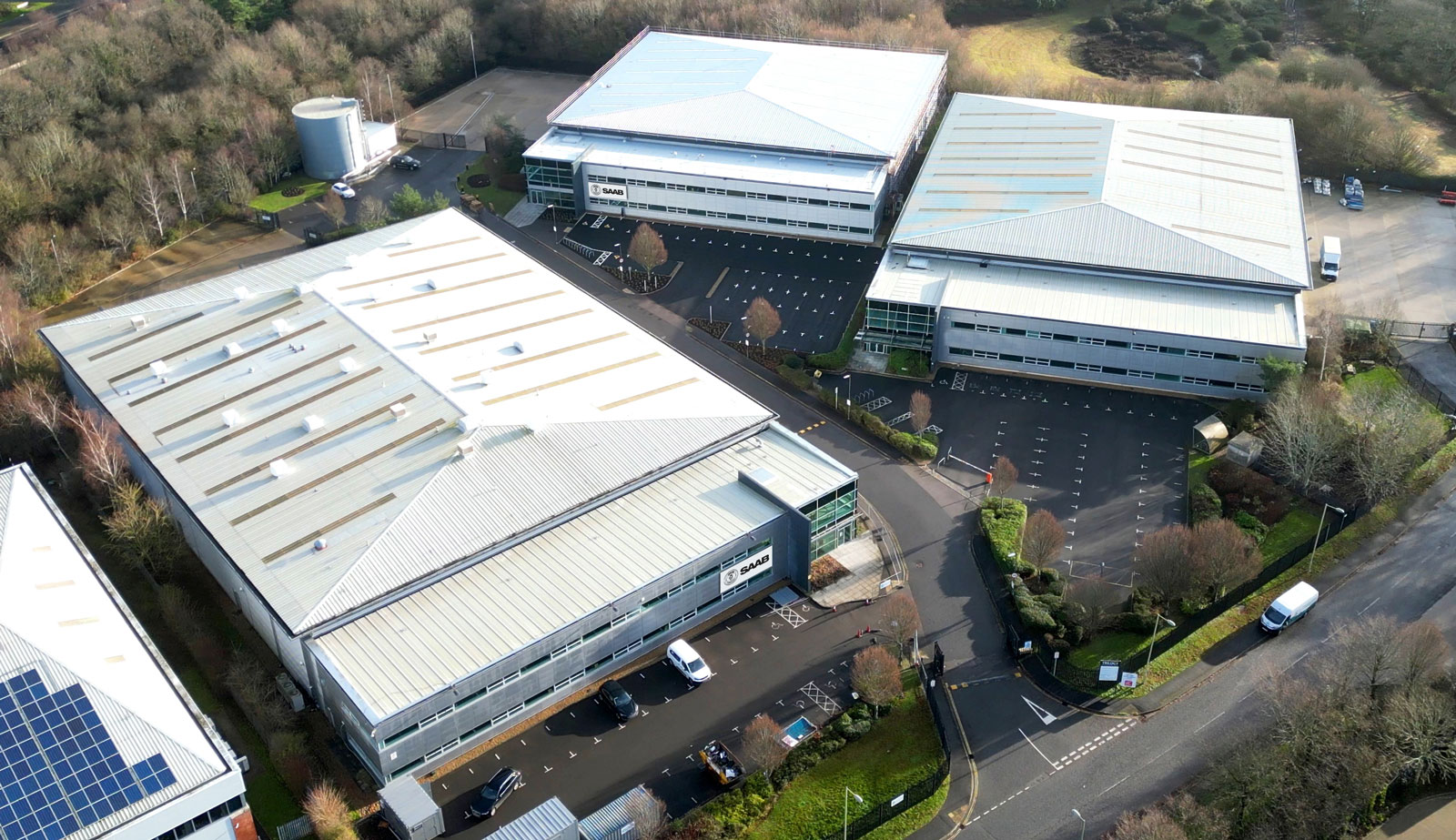
Saab UK’s new facilities in Fareham, UK.
Fareham-based Seaeye, a world leader in underwater robotics, has been expanding rapidly recruiting skilled jobs locally. The new site in Segensworth sees Saab’s presence grow to 8,400 m2 (83,000 ft2) as part of a multi-million-pound investment and more than 100 new jobs being created.
The Rt Hon Suella Braverman KC MP visited the site to meet with Saab UK’s senior management team, to hear about the further growth being planned in Fareham and to see the progress being made on the new facilities. Commencing shortly the move is expected to complete in the Autumn.
In November 2021 Saab UK’s Seaeye business, a world leader in underwater robotics, secured a contract from Ocean Infinity for their new electric work remotely operated vehicles (eWROV) which are being developed and built in Fareham. The new eWROV product, is the world’s most capable and intelligent all-electric, work-class underwater robot. This is the latest addition to the Seaeye underwater portfolio used across a variety of offshore energy sectors, ocean science and defence. Its electrification is the key to its improved performance and sustainability-related attributes.
The Rt Hon Suella Braverman KC MP, said:
“It was a pleasure to be back with Saab in Fareham and to see first-hand how this local success story continues to grow. There are so many exciting job opportunities being offered for a wide variety of skillsets, doing meaningful and interesting work both here at home and abroad.”
Dean Rosenfield, Managing Director of Saab UK, said:
“Saab has been in Fareham for many years now and we are keen to continue our commitment to the local community. The success of Seaeye has seen us grow here over the years and I expect this to continue with further expansion to come as we increase our UK production activities.”
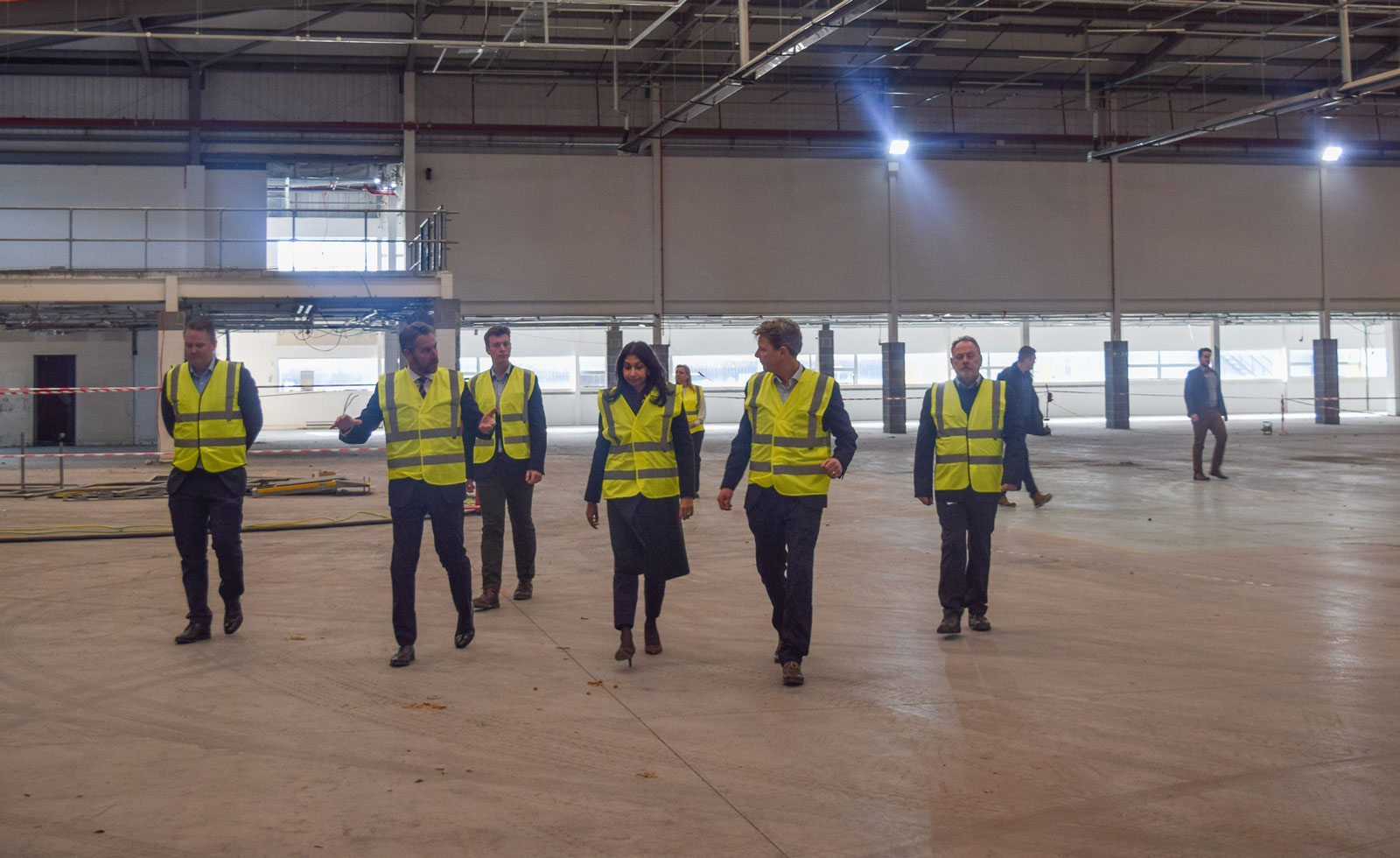
Preview tour of new facilities by Suella Braverman MP.
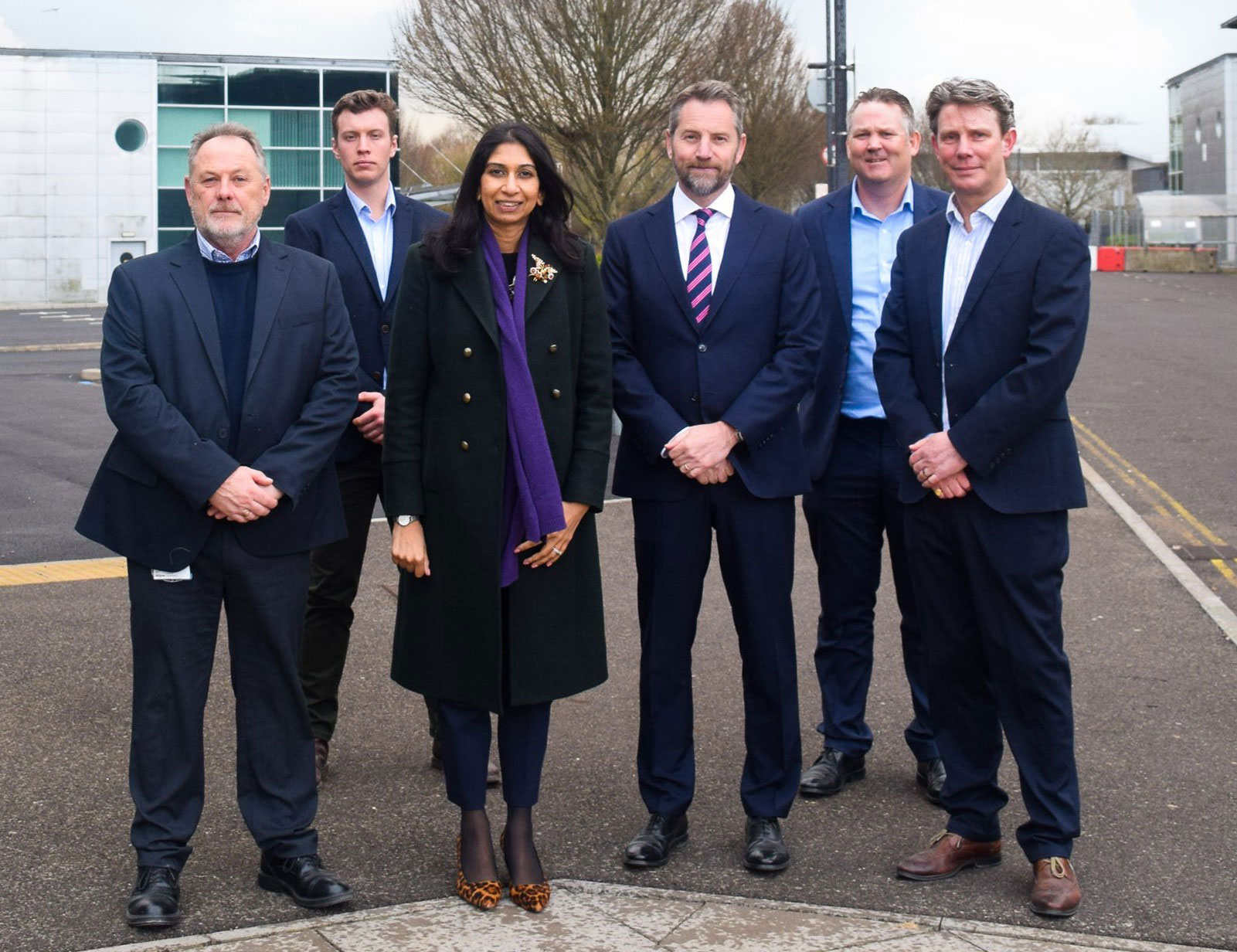
Suella Braverman visiting Saab UK’s new Fareham facilities hosted by Saab UK Group MD Dean Rosenfield, Seaeye MD Jon Robertson and team.
eWROV has the in-built capability to be operated by onshore command and control centres. A reduced need for on-site personnel offers considerable savings to the user, as well as improving safety and reducing emissions by reducing the need for large support vessels and by removing the need to fly in personnel using helicopters.
Saab Seaeye is world leader in electric underwater robotics.
Saab UK is a national Ltd company that operates across the length and breadth of the United Kingdom. We bring together the best of Swedish innovation and British engineering. Directly and indirectly through our supply chain we support thousands of British jobs and provide technologies that keep people and society safe.
For more information contact:
Matt Bates
Saab Seaeye Ltd
+44 (0)1489 898000
Email Matt Bates
www.saabseaeye.com
Nicolas Clark-Majerus
Saab UK
+44 (0)7856 001 858
Email Nicolas Clark-Majerus
www.saab.com/UK
23 February 2023
UCO WINS HUGE CONTRACT WITH SAAB SEAEYE FALCON FLEET
Underwater Contracting (UCO), owners of the world’s largest fleet of Saab’s Seaeye Falcons, has expanded to 27 vehicles as they win one of the largest contracts in the global aquaculture sector.
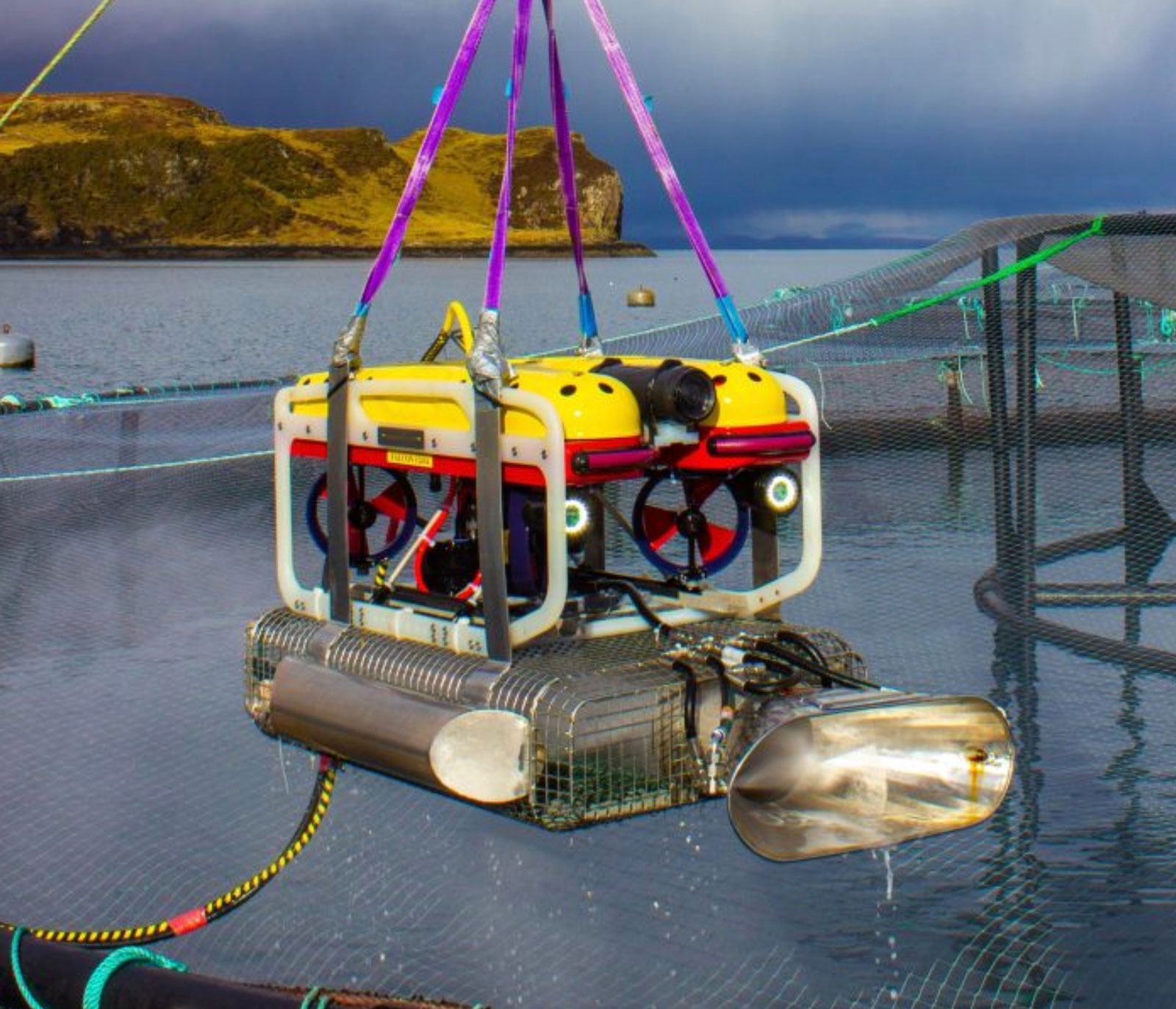
Seaeye Falcon is capable of handling UCO’s hugely successful FOOVER mortality recovery system.
The agreement will see the Falcon fleet working 365 days a year over multi-year contract terms and providing a range of services in Europe, North America and Australia.
Specialists in aquaculture, UCO, has successfully deployed Seaeye Falcon underwater vehicles since 2018, for animal welfare and installation integrity across aquaculture sites across three continents.
In that time, they have productively utilised the power and intelligence of the Falcon system when designing and developing industry-leading technologies, including their FOOVER Mortality Recovery system, NETFIX Net Repair system and G-LANCE Cage Cleaning system.
They chose the Seaeye Falcon as the world’s top selling underwater robotic vehicle in its class and for its versatility, being able to be utilised not only in aquaculture, but in the offshore energy and maritime sectors as well.
With a reliability record totalling over one million hours underwater, the Seaeye Falcon is a compact metre-sized vehicle that can be fitted with role-changing, heavy tooling systems. With five powerful thrusters and intelligent control architecture, the Falcon is capable of precise manoeuvrability amongst complex structures and strong currents. The Seaeye Falcon is designed and manufactured at Saab UK’s Fareham site.
Underwater Contracting Ltd (UCO), based in Aberdeen, is a leading provider of underwater services for the maintenance of aquaculture sites throughout Scotland, North America, Canada and Europe and is part of the Ocean Marine Group.
Saab Seaeye is world leader in electric underwater robotics.
For more information contact:
Matt Bates
Saab Seaeye Ltd
+44 (0)1489 898000
Email Matt Bates
www.saabseaeye.com
Mick Bower
Underwater Contracting Ltd
+44 (0)1224 872861
Email Mick Bower
www.underwatercontracting.com
30 January 2023
HABITAT-SAVING ALGORITHM HELPED BY SEAEYE FALCON
Scientists at the Washington Department of Fish and Wildlife (WDFW) have acquired a second Saab Seaeye Falcon underwater robot. The Seaeye Falcon is used to conduct surveys of marine fish and invertebrates in Washington’s Puget Sound, where some rockfish populations were fished to levels that threatened extinction.
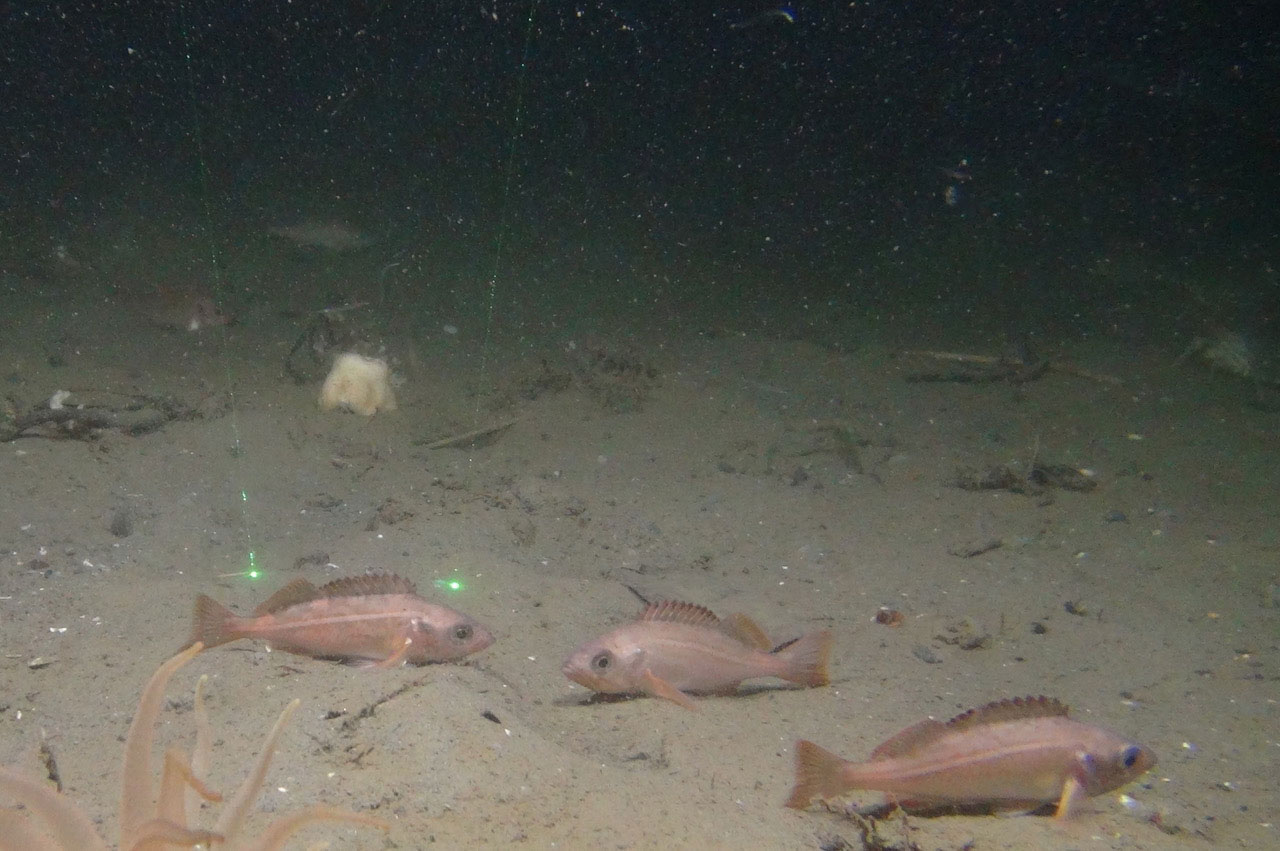
High-definition stereo camera and paired lasers are used to assess individual fish size and the density of fish in a measured field of view.
The surveys are used primarily to monitor the recovery of rockfish listed under the United States Endangered Species Act, but also provide information on the unique geological features in Puget Sound. The WDFW has also used their Falcon to survey the habitat surrounding U.S. Navy bases in Puget Sound to meet Federal permitting requirements, locate and recover lost equipment and conduct special studies of sea urchins and sea cucumbers.
The new Seaeye Falcon is a 300m rated system and equipped with a high-definition fibre-optic video system capable of collecting higher resolution imagery than WDFW’s original Falcon, which has seen over 4000 hours of use since 2007.
“The HD imagery collected with the new vehicle will greatly improve our ability to detect small and cryptic rockfishes, leading to more precise estimates of abundance, and will be used to train machine-learning algorithms being developed to partially automate the video review process, which is expected to substantially improve survey and post-processing efficiency,” explains research scientist Robert Pacunski.
Not pushed around
“The Falcon can precisely manoeuvre amongst the cracks and crevasses of complex underwater rock formations favoured by rockfish and has the power not to be pushed around by the current,” says Robert Pacunski.
Specialised equipment fitted to the Falcon includes a pair of parallel lasers and a stereo camera for assessing individual fish size and the density of fish in a measured field of view. An Imagenex multi-frequencing gyro-stabilised sonar is used to identify target habitats and avoid uncharted obstacles (for example, derelict fishing gear, subsurface electrical and telecommunications cables). Depending on survey needs, the vehicle can be fitted with a conductivity-temperature-depth meter to collect data in real-time for examining linkages between physiochemical water quality parameters and fish distribution/abundance.
The world’s most successful system in its class, the Falcon’s winning concept comes from packing five powerful thrusters and an intelligent distributed control system into an easily manhandled metre-sized vehicle that can adopt different tools, cameras and sensors for undertaking numerous intricate and demanding tasks in strong currents.
Assisting the acquisition of both Saab Seaeye Falcons was the local distributor in North America, Jack Roberts of Symphotic TII Corporation.
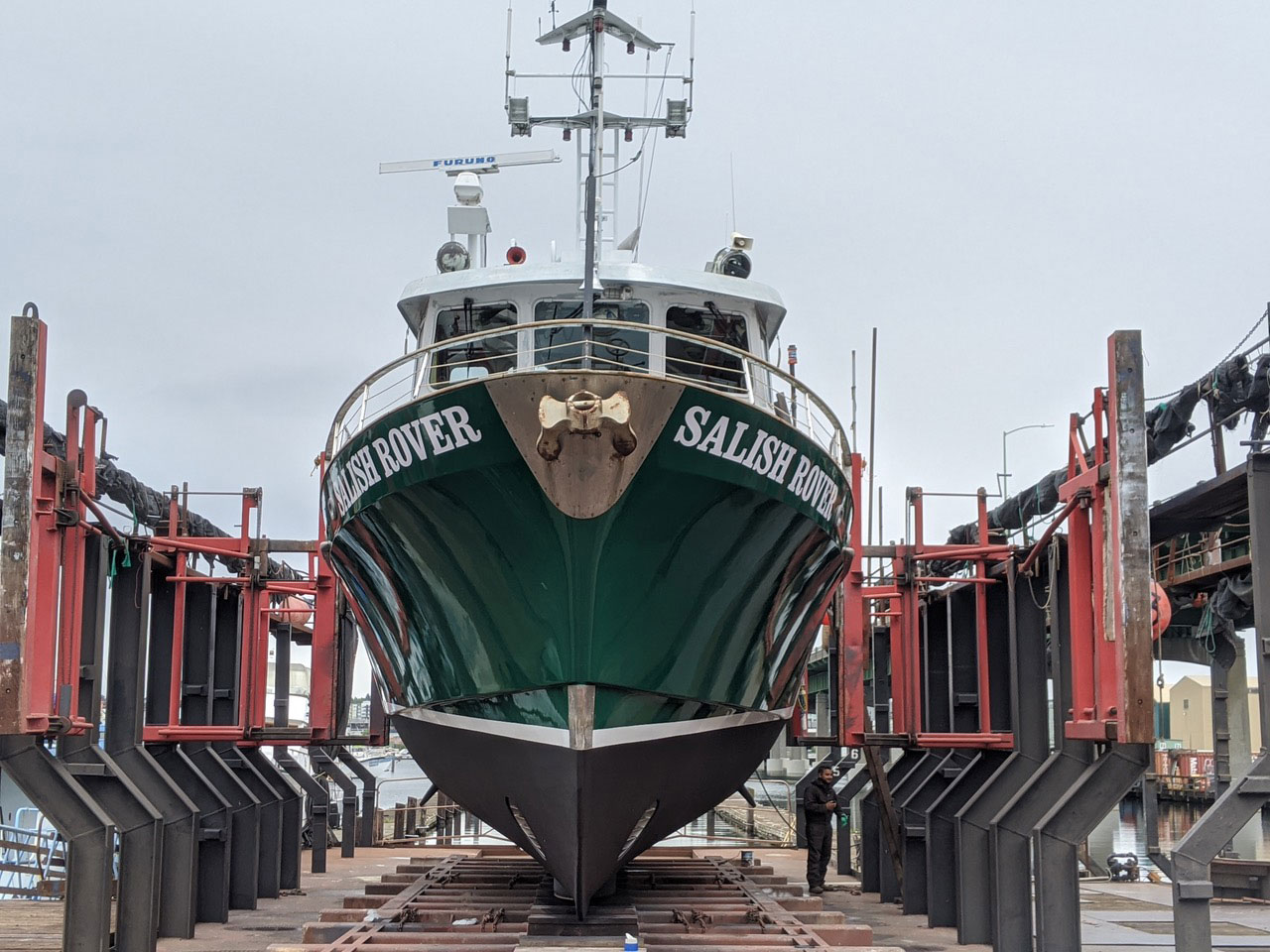
New Research Vessel Salish Rover from which WDFW’s new deep-rated Seaeye Falcon will be deployed.
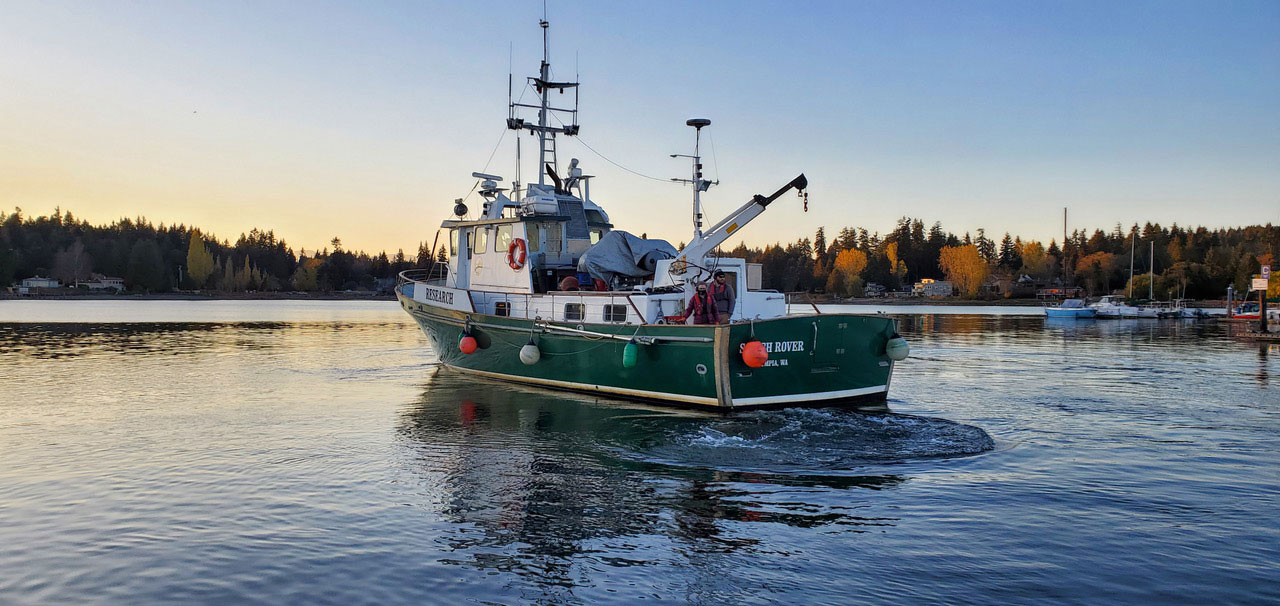
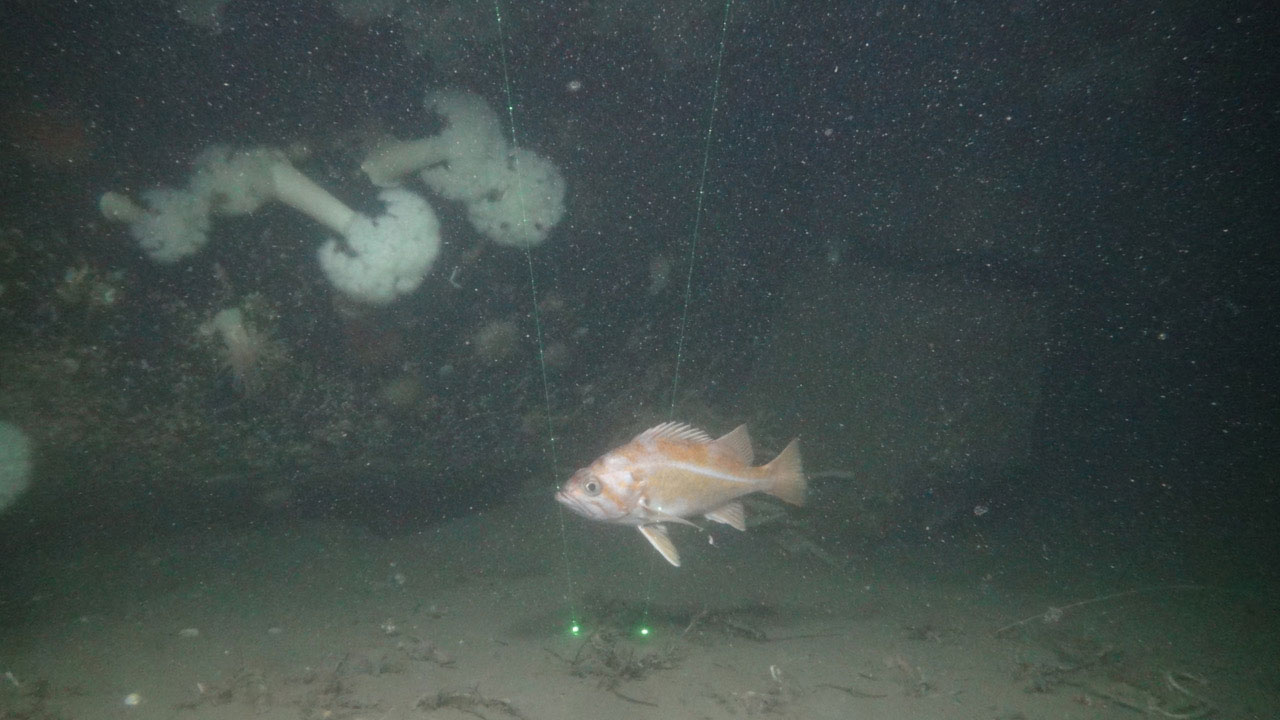
The lasers are spaced at 10cm and are used primarily to calculate the width of our survey transects, but also to give us some indication of fish size.
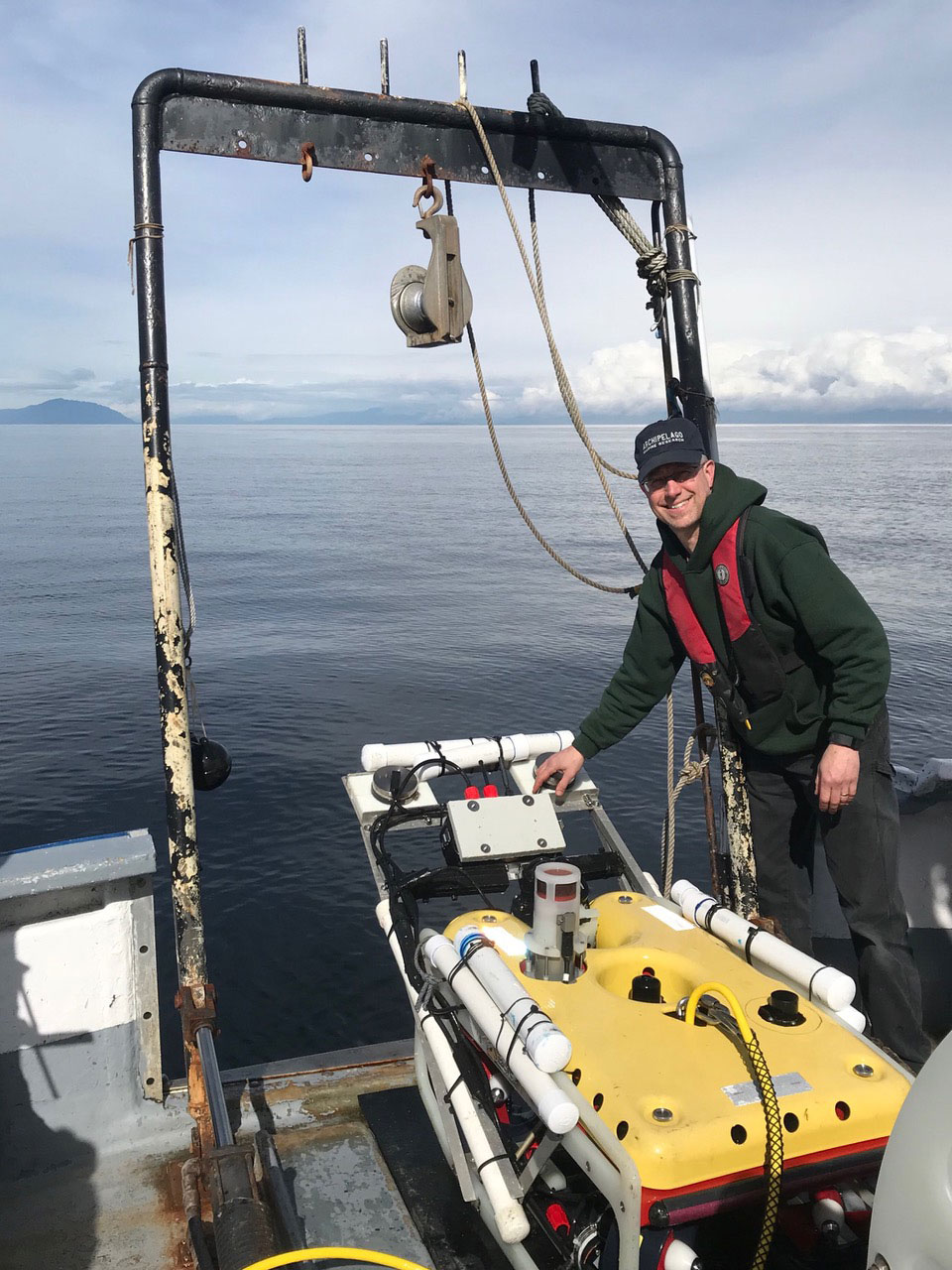
Scientist Bob Pacunski with the WDFW’s original Falcon rigged with the research team’s heavily front-loaded survey system that has spent 4000 hours underwater.
The Washington Department of Fish and Wildlife is dedicated to preserving, protecting, and perpetuating the state’s fish, wildlife, and ecosystems while providing sustainable fish and wildlife recreational and commercial opportunities.
Saab Seaeye is world leader in electric underwater robotics.
For more information contact:
Matt Bates
Saab Seaeye Ltd
+44 (0)1489 898000
Email Matt Bates
www.saabseaeye.com
Robert Pacunski
WDFW Marine Fish Science Unit
+1 425 379 2314
Email Robert Pacunski
www.wdfw.wa.gov
12 January 2023
SEAEYE FALCON THRIVES IN CROCODILE-INFESTED WATERS
ASI Group have deployed a Saab Seaeye Falcon robot into crocodile-infested waters in East Africa. The crocodiles have been preventing manual inspection of remote inland underwater structures supporting East Africa’s power generation.
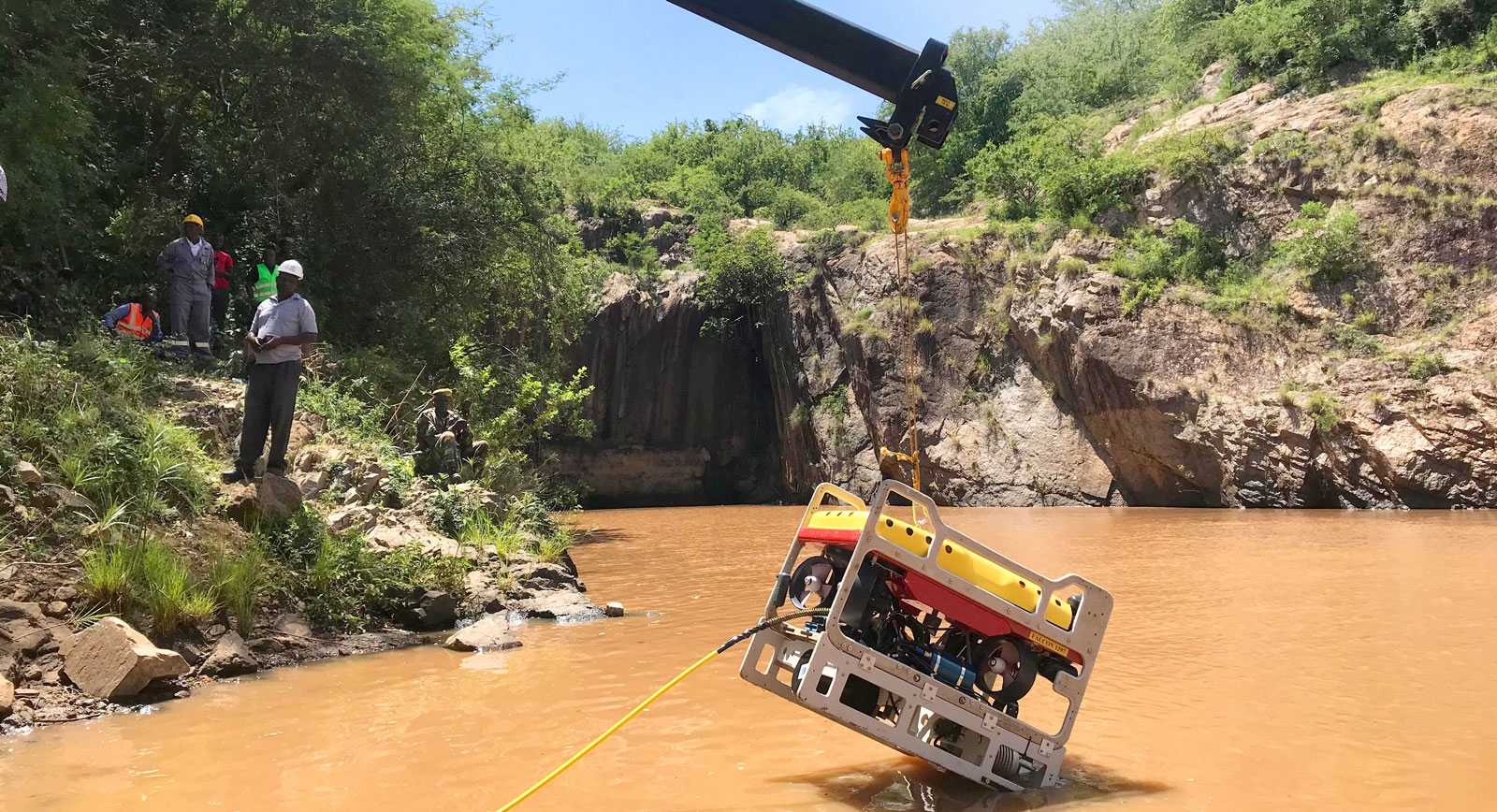
Imaging the smallest anomalies in the murkiest waters.
The curious crocodiles soon lost interest in the Seaeye Falcon as the robot ventured into rivers and reservoirs, as well as inside structures and tunnels, to inspect and survey the wide variety of infrastructure supporting five power stations.
Inspecting assets, critical to the continuous operation of facilities that provide electricity to over 20 million people, was within the scope of work by ASI, a global specialist in inland waters.
It required several inspection operations to assess the many underwater structures including intake screens, stoplogs guides, long tunnels, drop shafts, and stilling basins.
A truck crane was used to remove covers and stoplogs, and to launch the Falcon into a variety of access locations. The crane’s long boom kept personnel a safe distance from the crocodiles.
Even in extremely murky waters the smallest anomalies in structures were captured on the Falcon’s sonar by ASI operators.
Deep in the jungle
Areas previously considered inaccessible were surveyed, proving the versatility of the multi-beam sonar system provided by ASI.
In one location, the Falcon was lowered over 20 metres by crane to reach a basin surrounded by jungle.
At another location, the entire boat and survey gear were hand-carried 300 metres down rocky terrain to access a stilling basin requiring assessment.
The remote access technology that enables inspection and survey operations in locations that are inaccessible and unsafe for personnel was also used to access water-filled tunnels.
Using the Falcon for tunnel inspection avoids dewatering, which risks the tunnel’s infrastructure, including collapse.
Millions depend on data collected
With millions of residents depending on the energy produced by the power stations, a clear understanding of the infrastructures’ status is essential to enable proactive scheduling and greater reliability of the assets.
The survey data collected was used by ASI to construct 3D models of the various water control structures. By reviewing and comparing the collected data with known build-data, a clear understanding of the installations’ conditions was established.
Repeatable assessment across the locations utilising remote systems and acoustic inspection devices allows detection of anomalies and their change over time.
Considerable savings
ASI reports that considerable cost savings have been achieved by deploying the advanced systems protocol using their Falcon configured with an integrated sonar survey package and inertial navigation system
Although small enough to be easily manhandled, the Falcon, with its iCON™ intelligent control architecture, combined with five powerful thrusters, allows precise manoeuvrability in strong currents and amongst complex structures, whilst loaded with sensors, tooling and systems typically found on much larger robotic vehicles.
The Seaeye Falcon is the world’s most popular robot in its class with a reliability record covering over a million hours underwater.
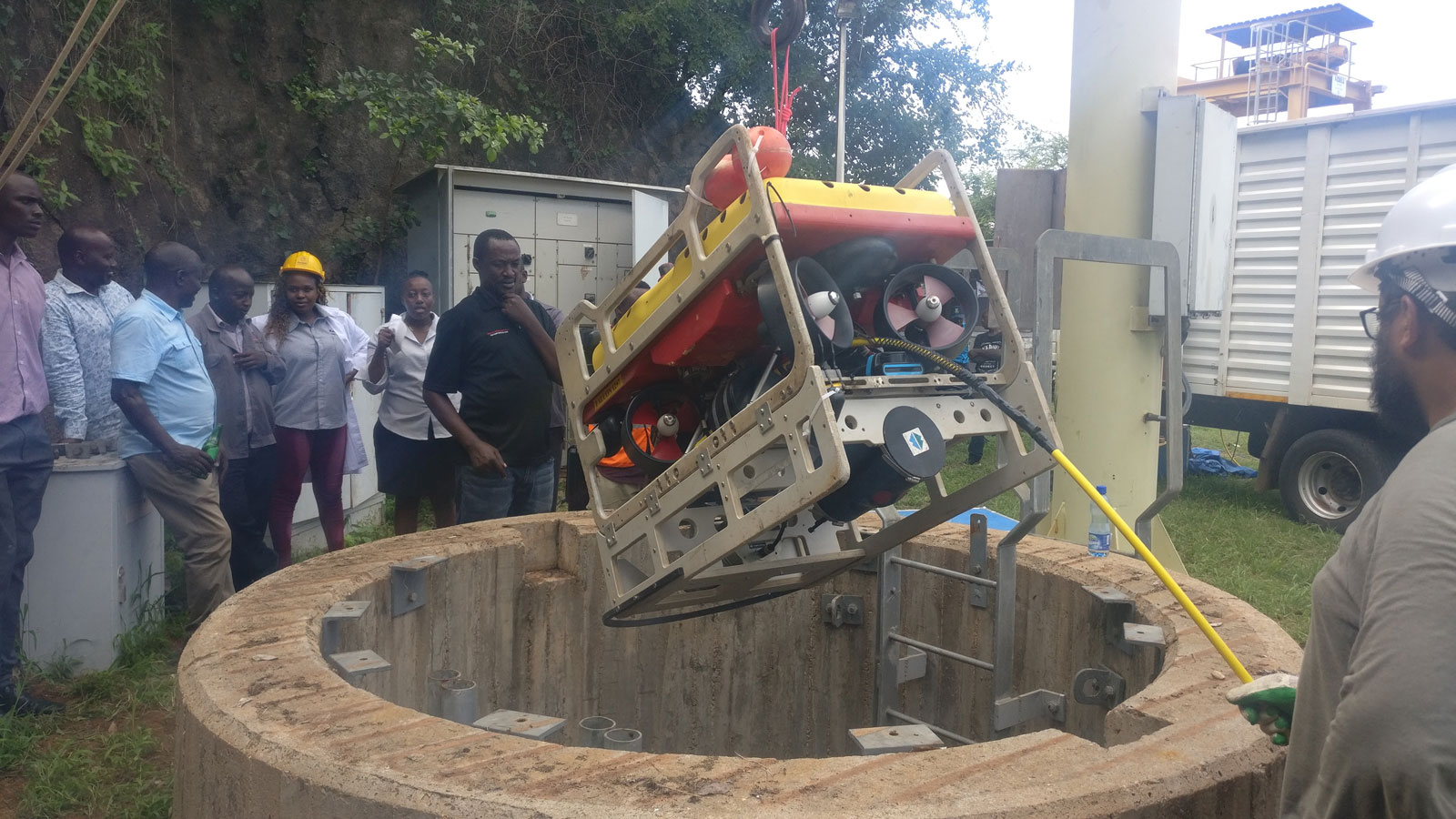
Inspecting water-filled tunnels saves de-watering.
ASI Group Ltd. (ASI) has been an industry leader in underwater inspection, maintenance and repair and biofouling monitoring and control services since 1987.
Saab Seaeye is world leader in electric underwater robotics.
For more information contact:
Matt Bates
Saab Seaeye Ltd
+44 (0)1489 898000
Email Matt Bates
www.saabseaeye.com
Merry Dang
ASI Group Ltd.
+1 905 643 3283
Email Merry Dang
www.asi-group.com
14 December 2022
KITE FLYING WITH FALCON
Flying kites underwater to generate electricity is an innovative renewable energy concept being installed in the Faroe Islands, supported by SJH Diving and their new Saab Seaeye Falcon.
Animation — courtesy Minesto — tidal kite movement and array.
(To see Video copy this link: https://minesto.frontify.com/d/C2QTuQ6m2RRx/media-library/show/eyJpZCI6Njg1MDI0NSwidGltZXN0YW1wIjoiMTY3MTAxMTc0MCJ9:frontify:0qGuDDFnUnWXtDan6YGAaLyOxDYXO1OjPayqlF37nmI)
The subsea kite turbine is a unique concept created by developer Minesto to generate electricity in tidal streams and ocean currents using the principle of flying a stunt kite in the wind.
By swooping through the water in a constant figure of eight motion on a tethered cable, the kite turbine accelerates through the water considerably faster than the actual flow speed.
The electricity generated from a kite turbine is several hundred times greater than from a stationary turbine.
In support of multiple kite installations, Faroes-based SJH Commercial Diving will deploy their Seaeye Falcon underwater robot for inspecting power-cable runs along the seabed to the shore and inspecting and cleaning foundation points.
Best in strong currents
Símin Jákup Højsted of SJH Diving says the Falcon was the best choice for strong currents compared to five competitive makes of vehicles.
SJH Diving has been involved with the project for over two years.
Minesto is a marine energy technology developer founded in 2007, since when it has successfully developed its unique marine energy technology called Deep Green.
The ability to also operate at low velocities makes Minesto’s Deep Green the only technology to be cost-efficient in both tidal and ocean currents.
Mastering currents has helped the Falcon become the world’s top selling robot in its class, along with its being an easy to use, small, intelligent, powerful, and multi-tasking with a reliability record covering over a million hours underwater.
SJH’s Seaeye Falcon comes with a multi-beam sonar, single function and five function manipulators, a cathodic potential probe and a fully-kitted cleaning skid.
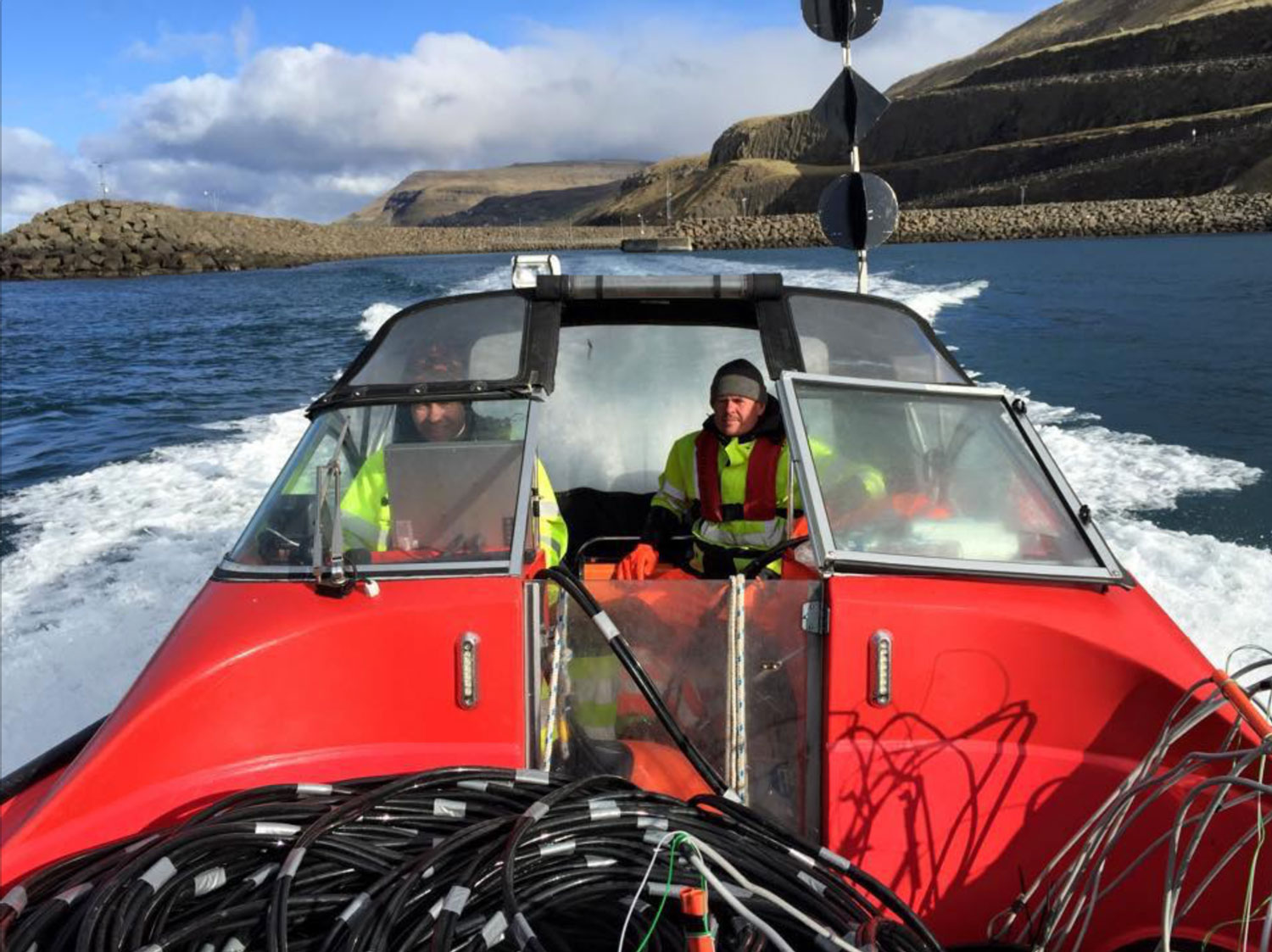
SJH Commercial Diving vessel dedicated to the support of the array of subsea kite installations.
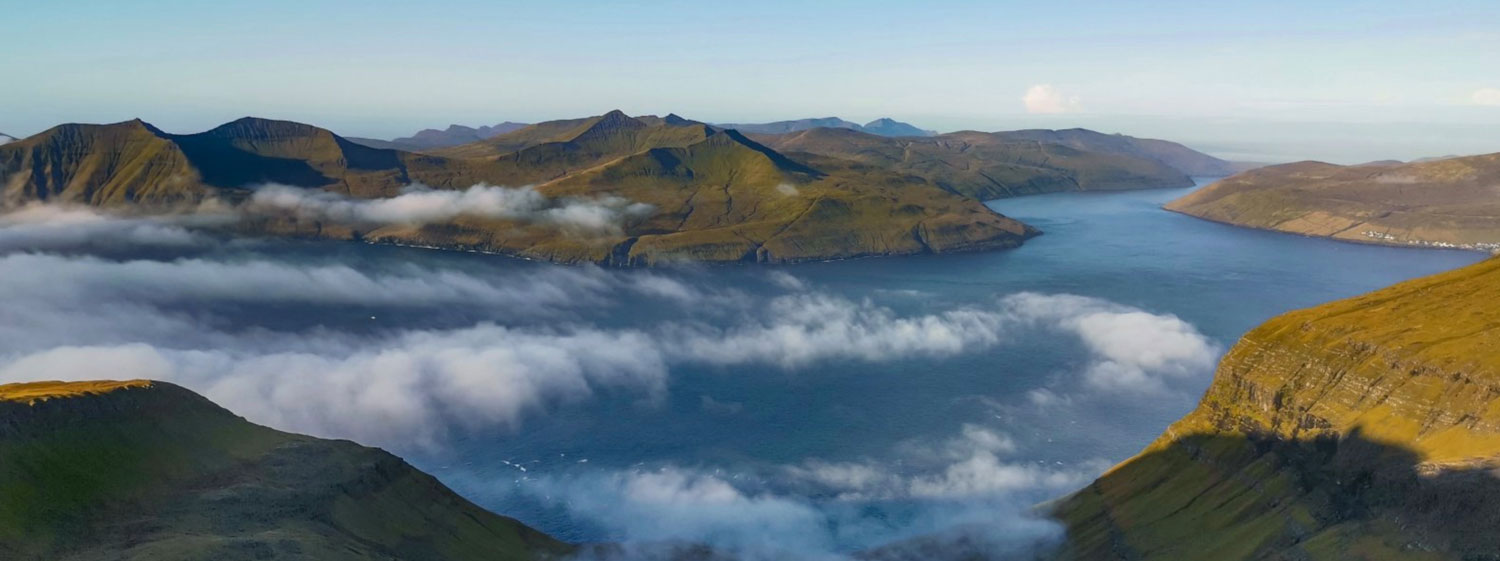
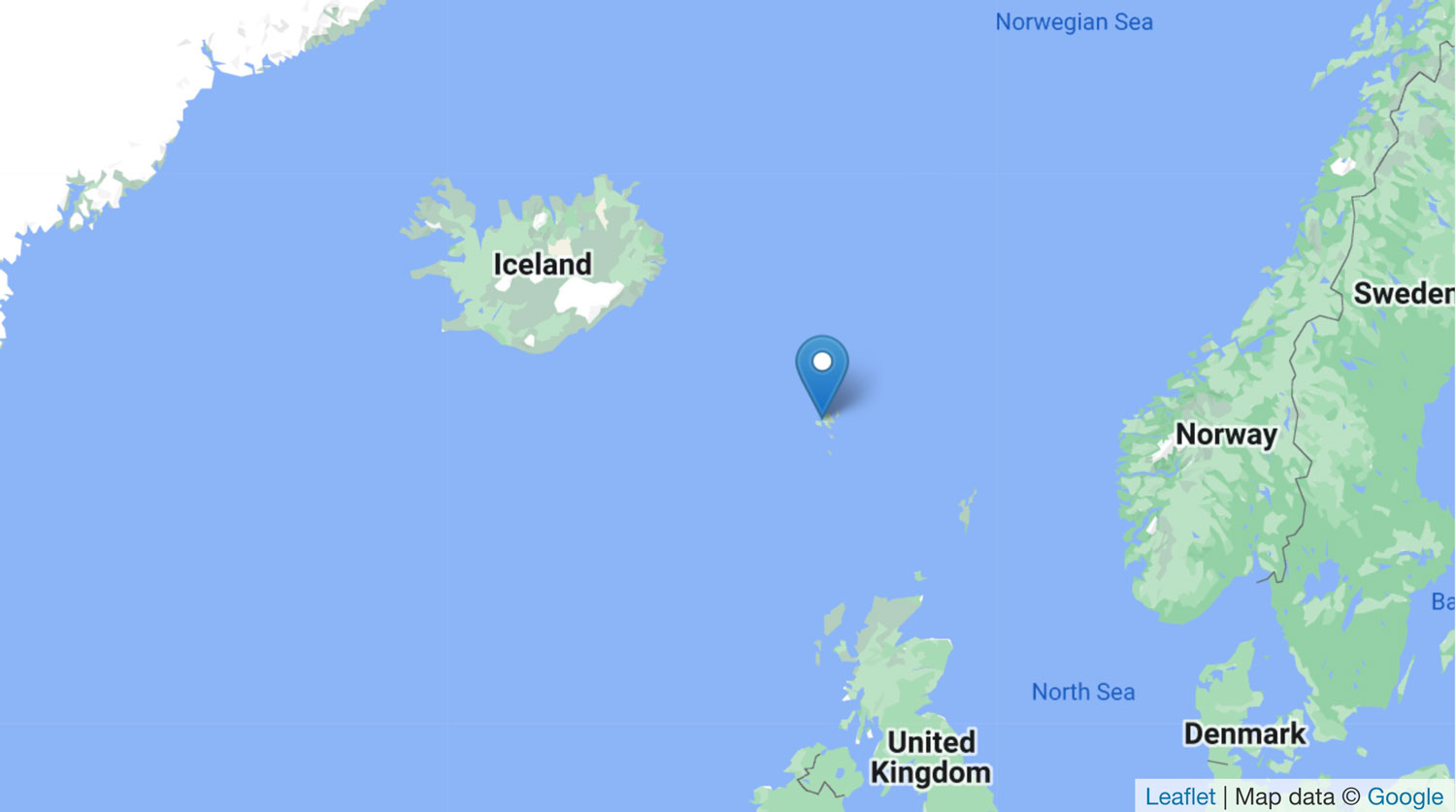
Faroe Islands.
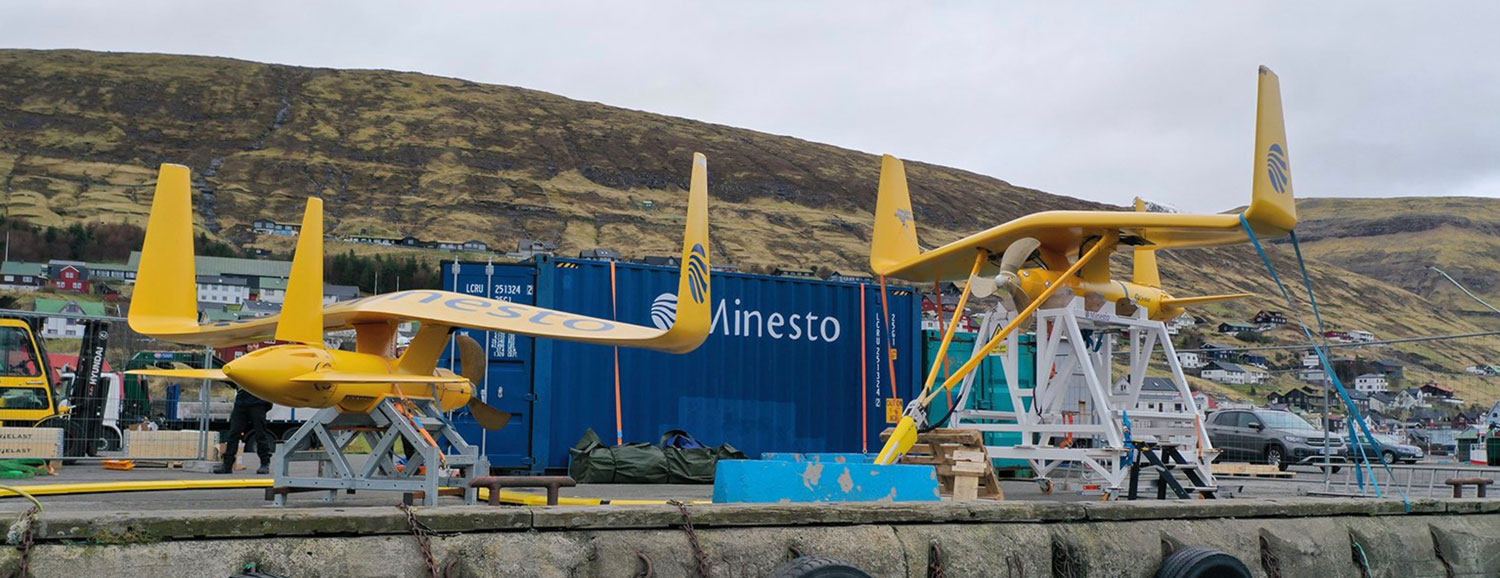
Minesto subsea kites awaiting installation.
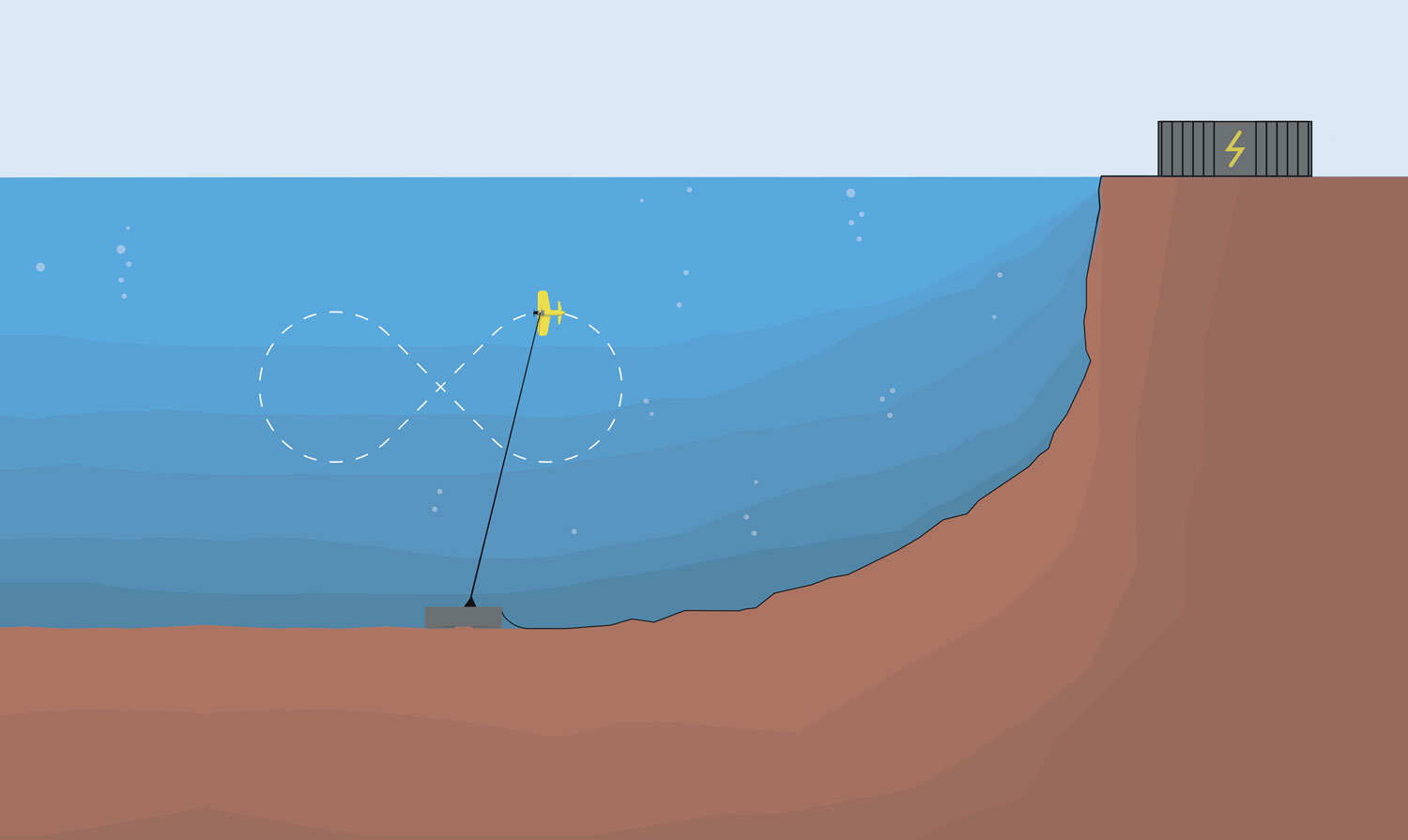
Swooping in a constant figure of eight motion accelerates the kite through the water considerably faster than the actual flow speed and generates electricity several hundred times greater than from a stationary turbine.
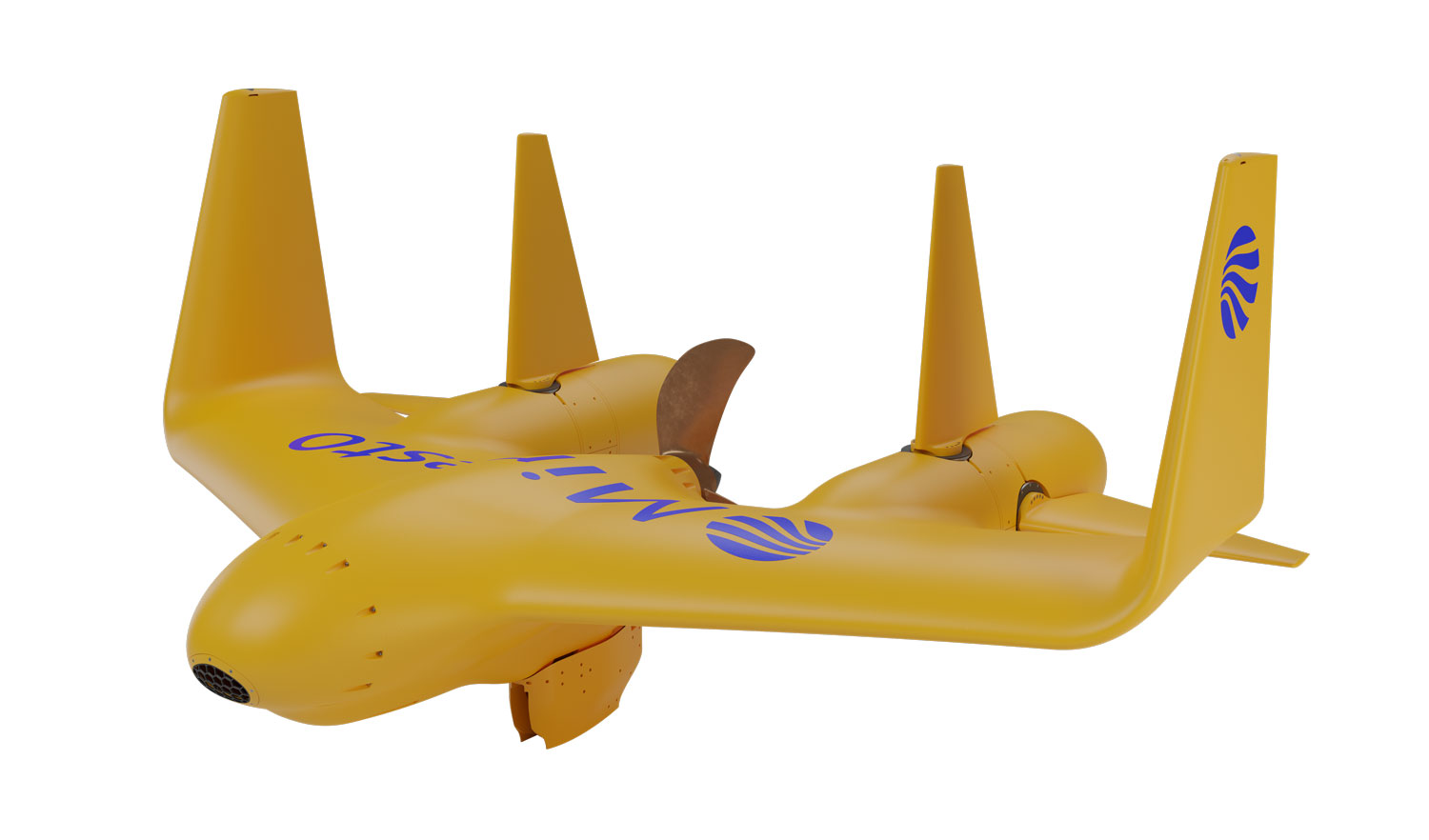
Minesto subsea kite turbine.
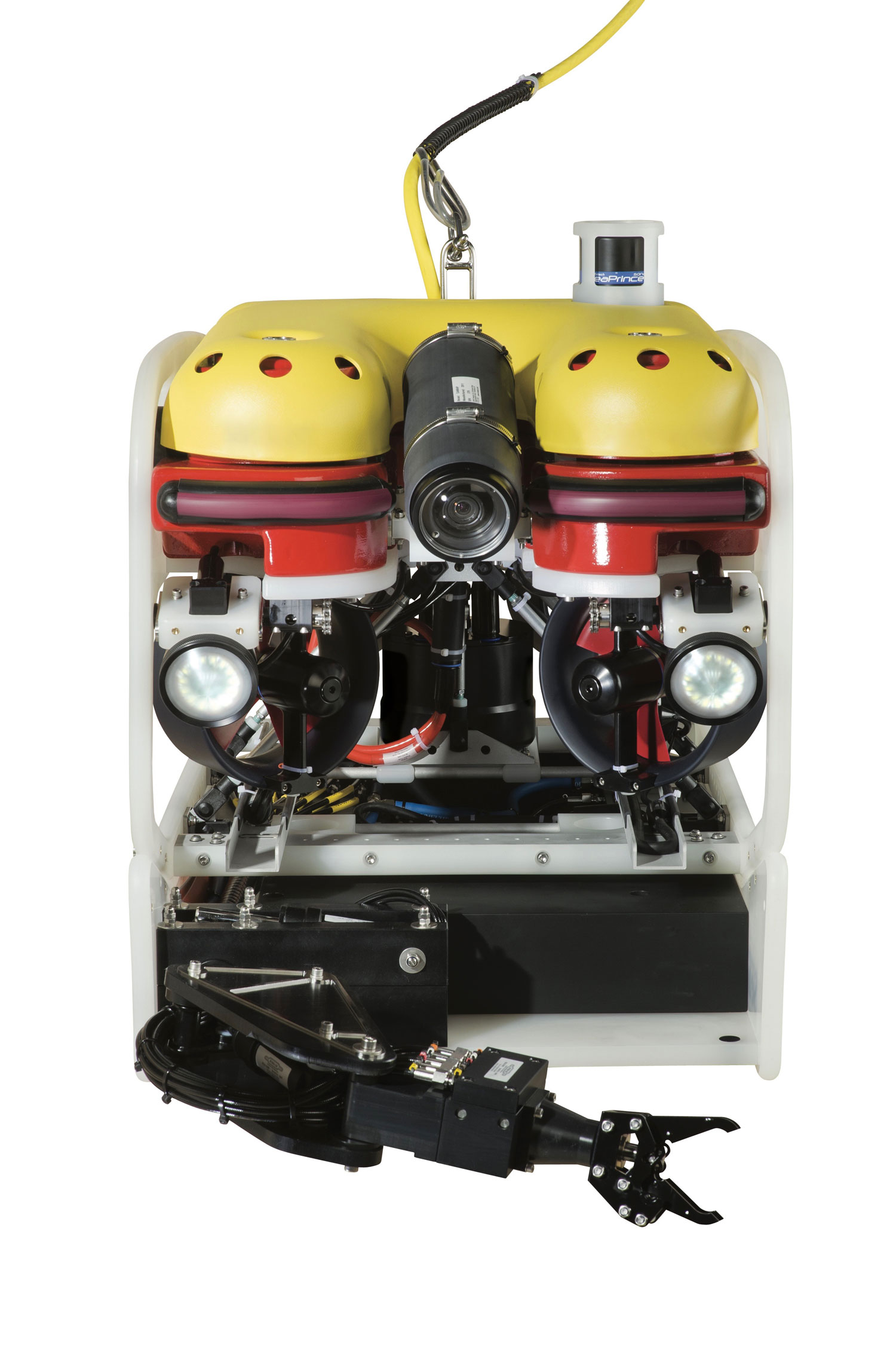
A Seaeye Falcon can be rated either 300m or 1000m and fitted with a wide range of cameras, sensors and tooling.
Saab Seaeye is world leader in electric underwater robotics.
For more information contact:
Matt Bates
Saab Seaeye Ltd
+44 (0)1489 898000
Email Matt Bates
www.saabseaeye.com
Símin Jákup Højsted
S.J.H. Commercial Divers
+29 852 8464
Email Símin Jákup Højsted
http://www.sjh.fo/english/home
28 November 2022
NUCLEAR SURVIVOR
A proven survivor — the Saab Seaeye Tiger has spent five years working in nuclear storage ponds at Sellafield, one of the most highly radioactive and highly alkaline places on the planet for a robotic vehicle.
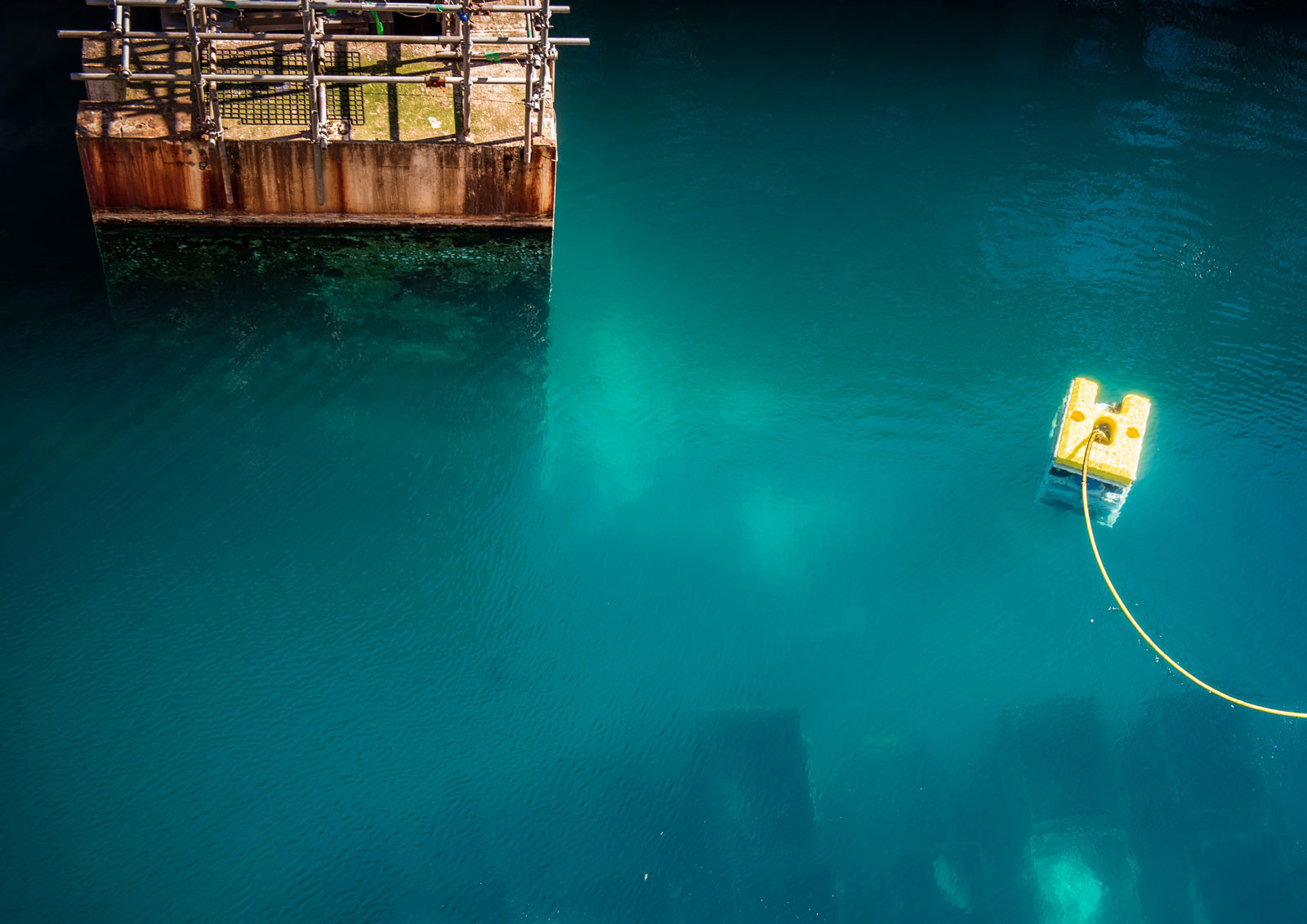
The Saab Seaeye Tiger has spent five years working in nuclear storage ponds — one of the harshest places on the planet for a robotic vehicle.
Celebrating this record-breaking achievement are the Sellafield team and Saab Seaeye engineers who nuclear-proofed the Tiger to survive an extremely corrosive environment whilst sorting 15kg spent fuel rods in the nuclear ponds.
Les Barker of Sellafield’s innovation team says:
“The Tiger-N has improved the amount of work we can do in the ponds in a day — sometimes doing 10 times what we’ve managed in the past.
The Tiger’s reliability also means that the people using and maintaining them are getting less exposure to radiation.”
To limit radiation dose risk to operators and maintainers, in an environment that is highly hazardous to humans, the Tiger was adapted to ensure systems and materials would survive extreme corrosion to limit exposure time spent on maintenance and cleaning.
Exposure to radiation is carefully limited as unplanned downtime would quickly exhaust operators’ safe working period in any one year.
The adapted design is called Tiger-N, for nuclear, with six having been delivered to the site so far.
Not only does the Tiger-N need to be corrosion-proof, but also systems such as its quick-change tool skids. These include an under-slung manipulator skid, a four-function forward facing manipulator skid, sludge scoop dredger skid, cutting skid and an under-slung water-jet cleaning skid.
“We’ve now used these robots to move 20 per cent of the pond’s inventory into safe modern storage. It has gone from, ‘let’s try something’, to a major success which has reduced the hazard the pond presents,” concludes Sellafield’s Les Barker.
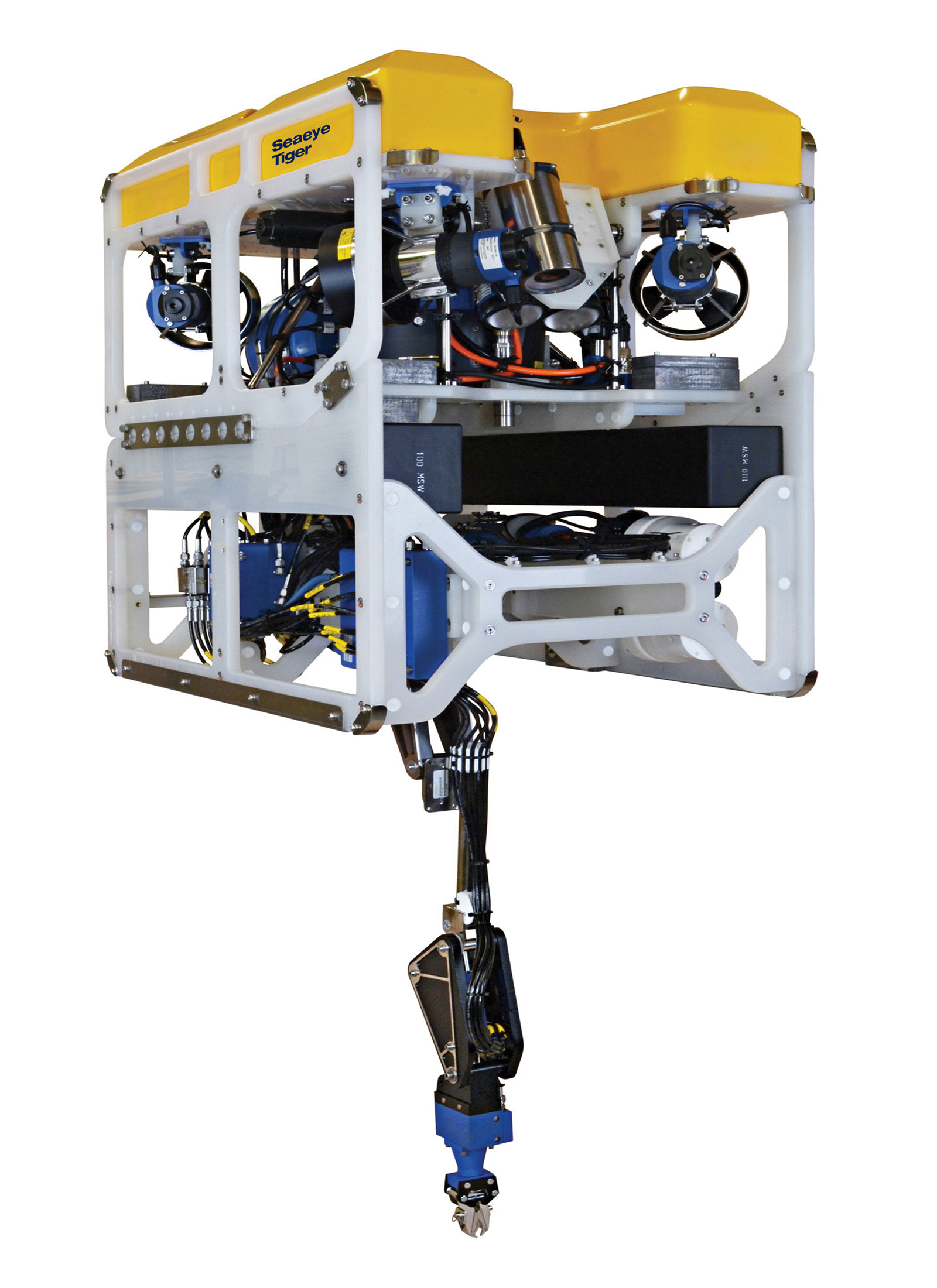
Saab Seaeye is world leader in electric underwater robotics.
For more information contact:
Matt Bates
Saab Seaeye Ltd
+44 (0)1489 898000
Email Matt Bates
www.saabseaeye.com
Ruth Hutchison
Sellafield Ltd
+44 (0)1946 786227
Email Ruth Hutchison
16 November 2022
FALCON HELPS PROTECT MALDIVES CORAL REEFS
A Saab Seaeye Falcon underwater robot has helped complete the first-ever systematic scientific survey of the waters of the Maldives — the lowest-lying nation on earth.
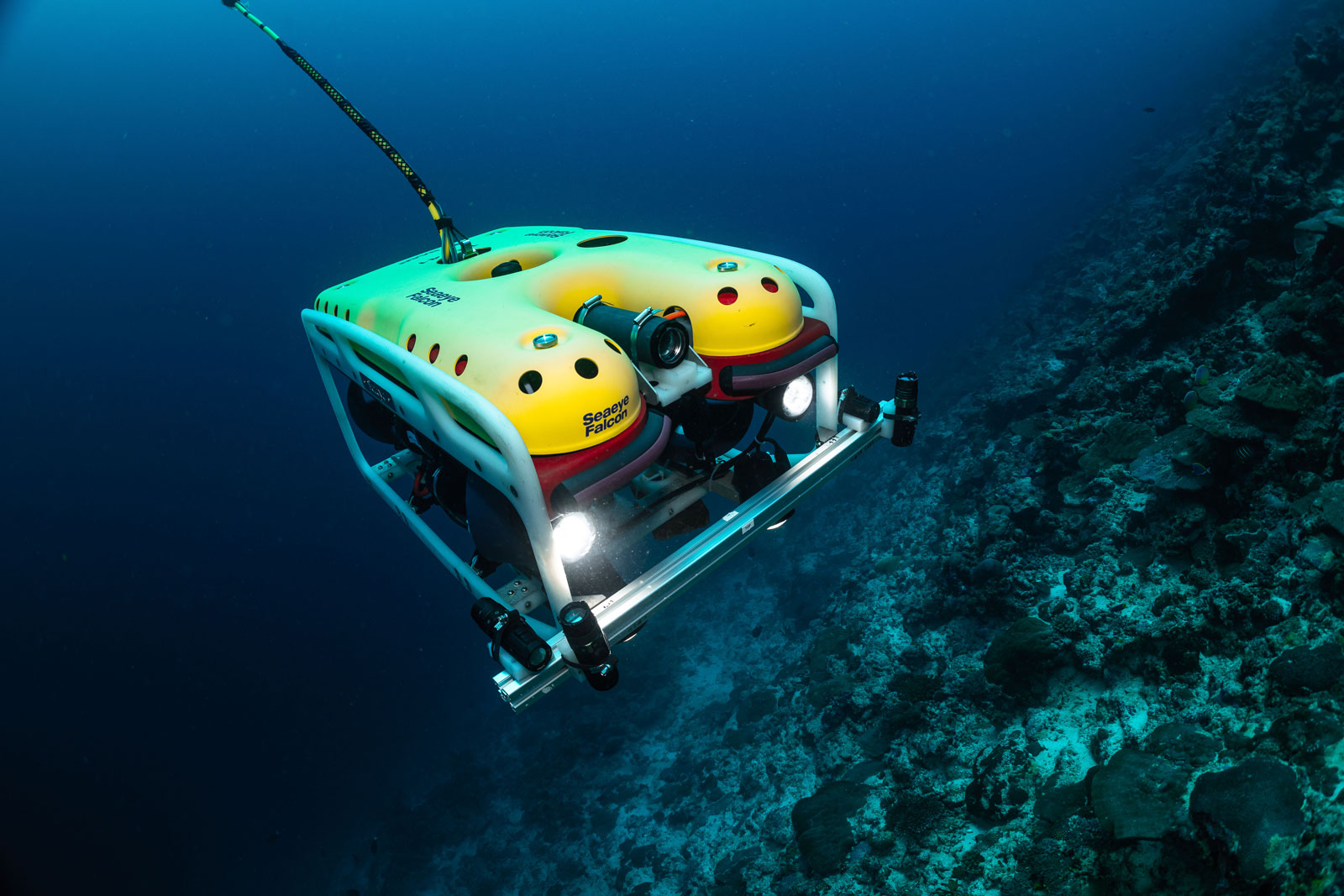
Saab Seaeye Falcon fitted with special stereoscopic camera array. Nekton Maldives Mission © Nekton 2022.
The Maldives is just 1.5 metres above sea level on islands of coral reef atolls. Globally, coral reefs account for 32% of known biodiversity. They are seen as the ‘rainforests of the ocean’, yet at least 97% could be lost with a 1.5-degree temperature rise.
The Nekton Foundation in partnership with the Maldives Marine Research Institute undertook the mission to understand the Maldives’ ecosystem to help create extensive new protected marine areas and strengthen the resilience of coral reefs to protect the islands from increasingly intense storms and erosion caused by climate destabilisation.
As an official partner to the mission, Saab Seaeye donated use of the Falcon to work alongside human-occupied submersibles, autonomous systems and research technologies.
The Falcon and other submersibles and divers collectively documented the extensive biodiversity of the ecosystem from shallow waters to 1000 metres.
Analysis of video transects from the Falcon has revealed 107 fish species and 130 organisms that live on the seabed, such as coral, sponges and algae. Analysis is ongoing with more species expected to be identified.
The Falcon also recorded charismatic megafauna such as turtles and sharks. These specific observations will be used to support projects engaged in long-term population assessments.
The research recorded extensive coral bleaching at many locations. In other locations, however, exceptionally healthy coral reefs were found. This offers hope that healthy coral reefs can thrive, particularly in areas where cold water upwellings prevent bleaching. These areas may be critical to support coral propagation projects.
Marine life in high definition
To enable scientists to document the biodiversity of the ocean around the Maldives, Nekton scientists devised, tested, improved and deployed a novel methodology for using the Falcon for video transects in shallow waters on the complex topography of coral reefs and operating in areas of strong currents.
Two sets of cameras were positioned on the vehicle, one set forward facing and the other set downward facing. They were spaced 80cm apart and at inward angle of 8 degrees ready to be calibrated for stereoscopic video recording.
The same system was used by snorkelers and other submersibles to complete video transects in an identical manner and at different depths.
Challenge of shallow waters
“Surging currents in the shallows and sheer subsea cliffs made this one of the most challenging operations on the mission,” says Mission Director, Oliver Steeds.
“Only the Falcon could handle the swell surges and powerful currents, including up-currents and down-currents,” he explains.
Renowned for its ability to hold steady in strong currents while filming and manoeuvring, the Falcon is the world’s top robot in its class with a reliability record covering over a million hours underwater.
Nekton is a not-for-profit UK-based research foundation working with the University of Oxford and a wide range of partners engaged in the scientific exploration and protection of the ocean.
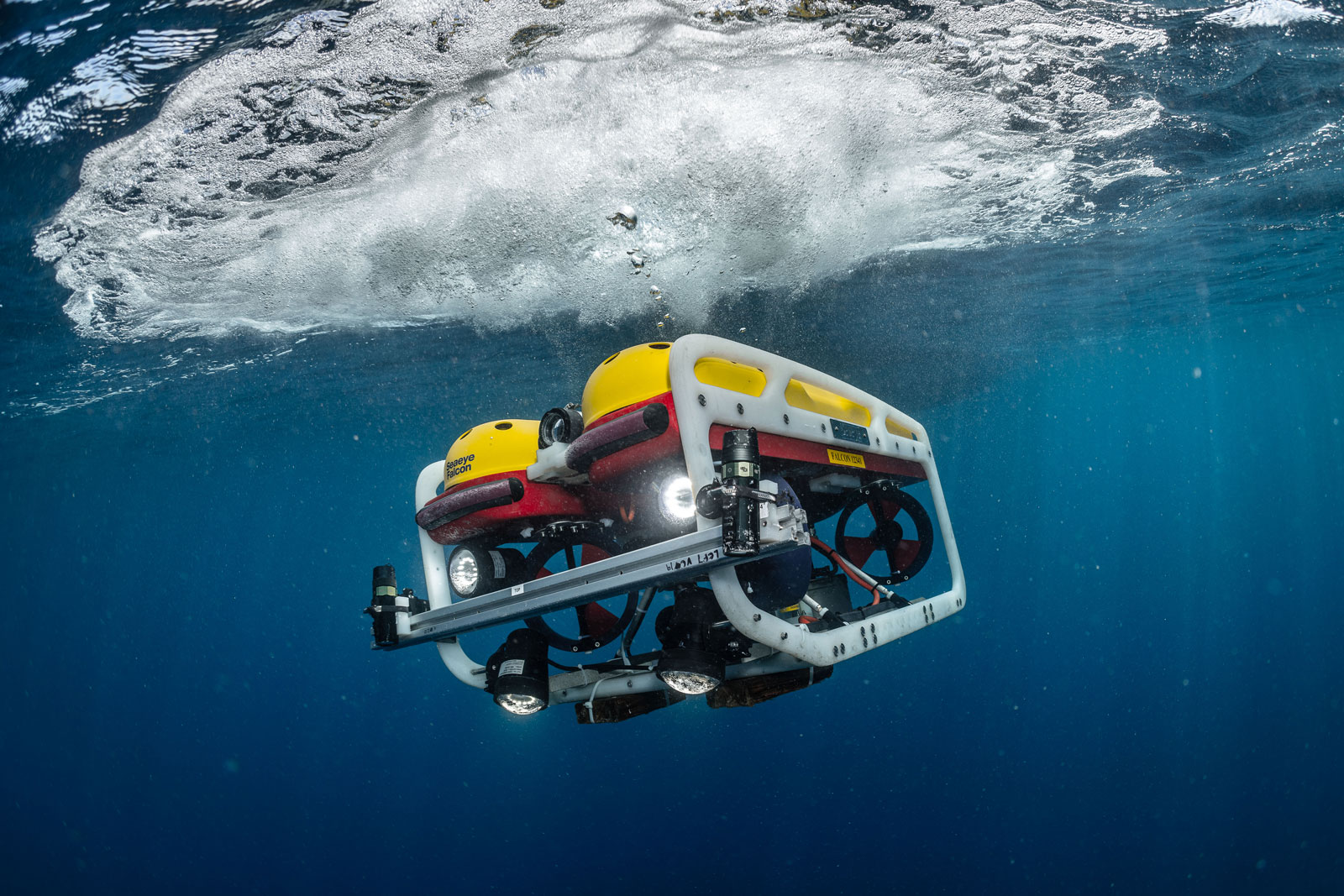
The Seaeye Falcon was able to transect steep reef cliff faces and maintain stability in strong currents and swell surges. Nekton Maldives Mission © Nekton 2022.
Nekton is a not-for-profit research foundation working with the University of Oxford and a wide range of partners to accelerate the scientific exploration and protection of the ocean.
Saab Seaeye is world leader in electric underwater robotics.
For more information contact:
Matt Bates
Saab Seaeye Ltd
+44 (0)1489 898000
Email Matt Bates
www.saabseaeye.com
Oliver Steeds, OBE
Nekton Foundation
+44 1865 309685
Email Oliver Steeds
www.nektonmission.org
9 November 2022
SAAB SEAEYE IN ANGOLAN ‘RIG TO REEF’ PROJECT
The transformation of an oil platform into an artificial reef is underway in Angola.
 The transformation of an oil platform into an artificial reef is underway in Angola.
The transformation of an oil platform into an artificial reef is underway in Angola.
It is the first platform in Africa to be decommissioned in a project led by environmental quality services company, EQS, with a Saab Seaeye Falcon underwater robot deployed for the task.
Chief Technical Officer at EQS, Carlos Rodrigues says, “By operating the Seaeye Falcon and all its related capabilities, EQS is supporting its aim to fulfil specific works in a safe and cost-effective manner delivering accurate and relevant information.”
The Falcon is assisting in the survey and mapping of all underwater components, including checking the wellhead, pipelines and the surrounding maritime environment.
Baseline environmental conditions are determined by taking water and sediment samples at several stations and at different depths, focussing on biological matter, namely zooplankton, phytoplankton, and benthos.
Significant marine growth already exists throughout the structure with abundant marine life already in the area for populating the rig when toppled on its side to become an artificial reef.
Once decommissioning is complete, a series of surveys will be scheduled to monitor the evolution of marine growth on the newly created reef.
EQS selected the Seaeye Falcon for its ability to handle an array of cameras, sensors, tooling and complex data gathering systems that include a digital multi-frequency profiling sonar.
Having reached the end of its service life the rig’s transformation into a reef is being undertaken under the auspices of The Ministry of Mineral Resources, Oil and Gas of Angola.
EQS helps offshore energy clients navigate the complex environmental regulatory landscape including compliance, HSE subjects, and business liabilities.
The mission involves a multi-disciplinary team from different companies and sectors of activity, including marine biology, hydrographic surveys, quality inspectors and personnel specialised in survey equipment such as the Falcon.
Future work involves clearing an area of fish nets, restoring platform signalling and marking, positioning of signal buoys and confirmation of pipeline locations along with the surveys to monitor marine growth.
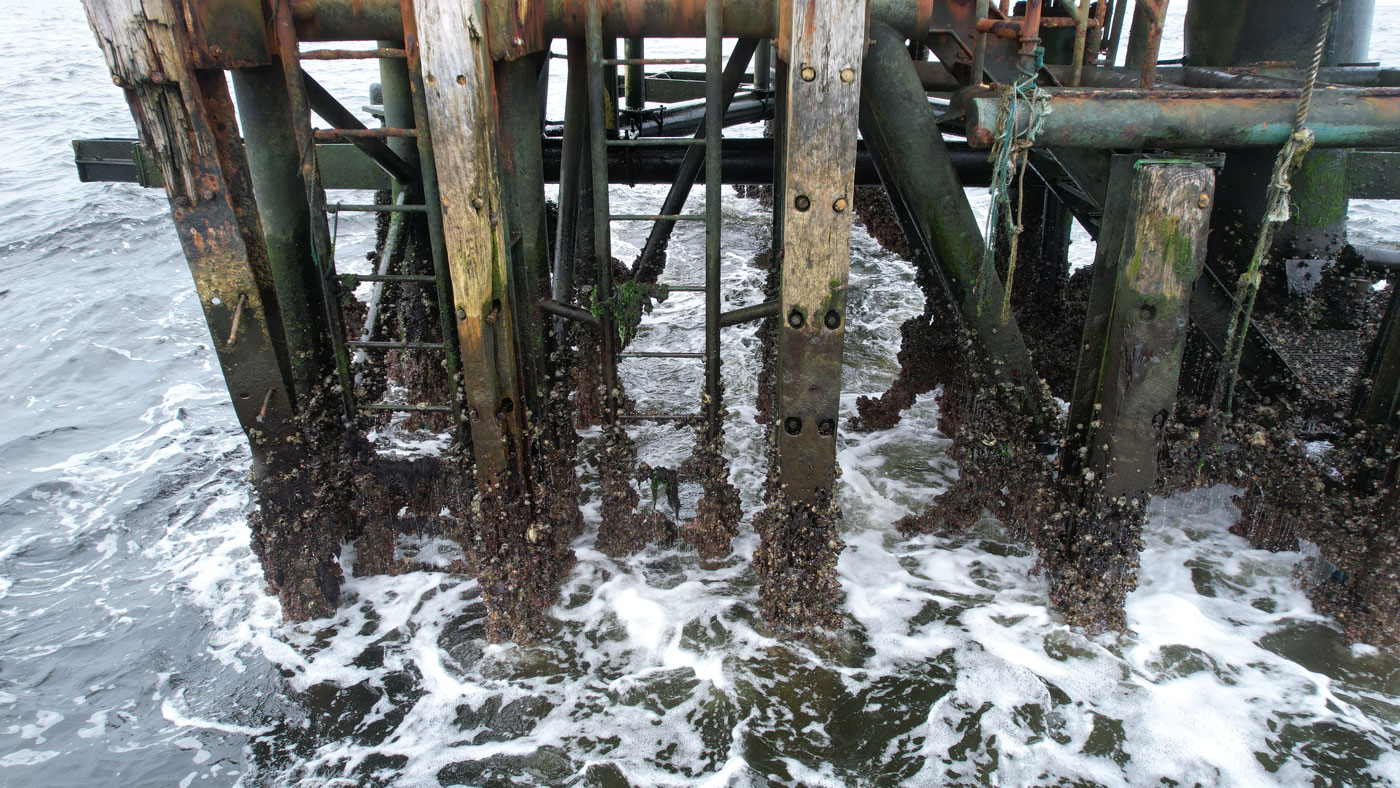 The platform is already presenting significant marine growth.
The platform is already presenting significant marine growth.
 EQS team viewing video images from the Saab Seaeye Falcon of the marine growth and marine animal activity at the platform.
EQS team viewing video images from the Saab Seaeye Falcon of the marine growth and marine animal activity at the platform.
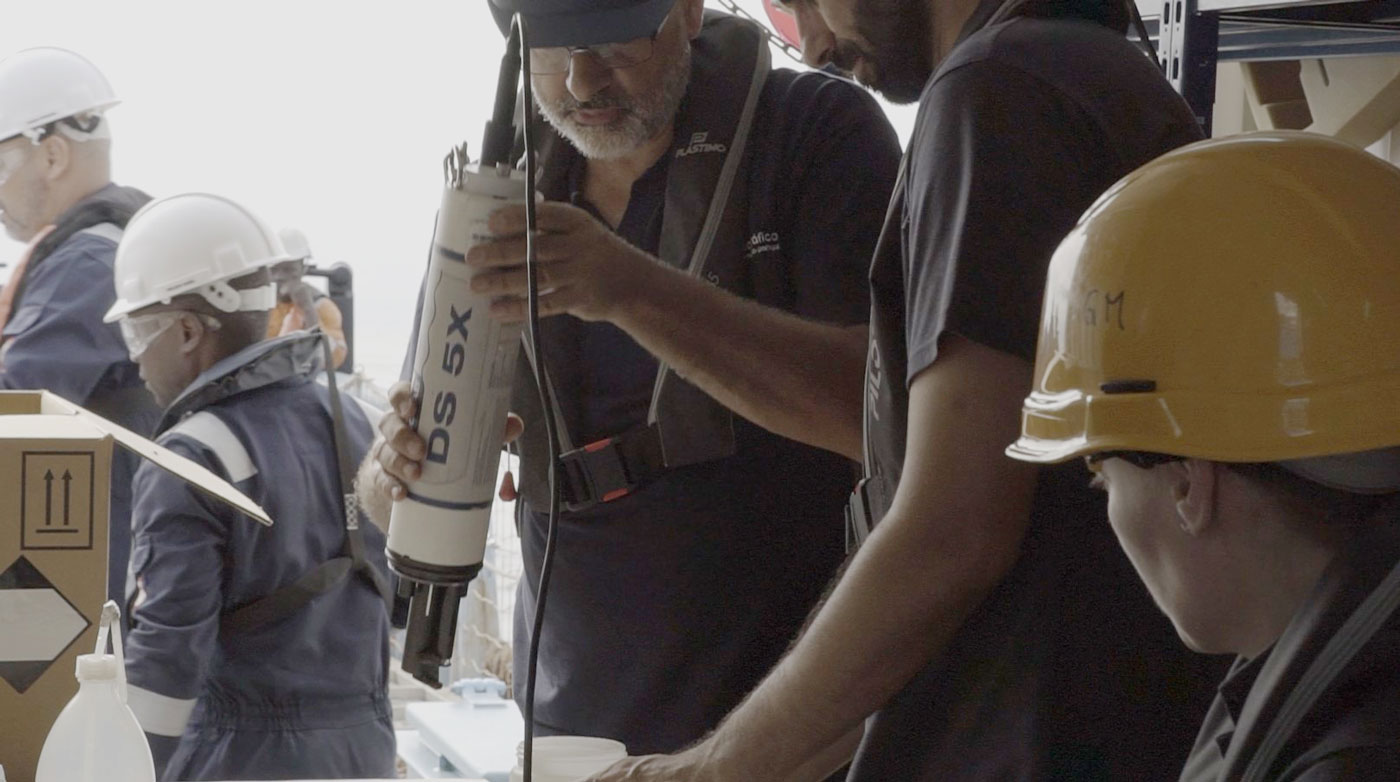 Multiparametric probe.
Multiparametric probe.
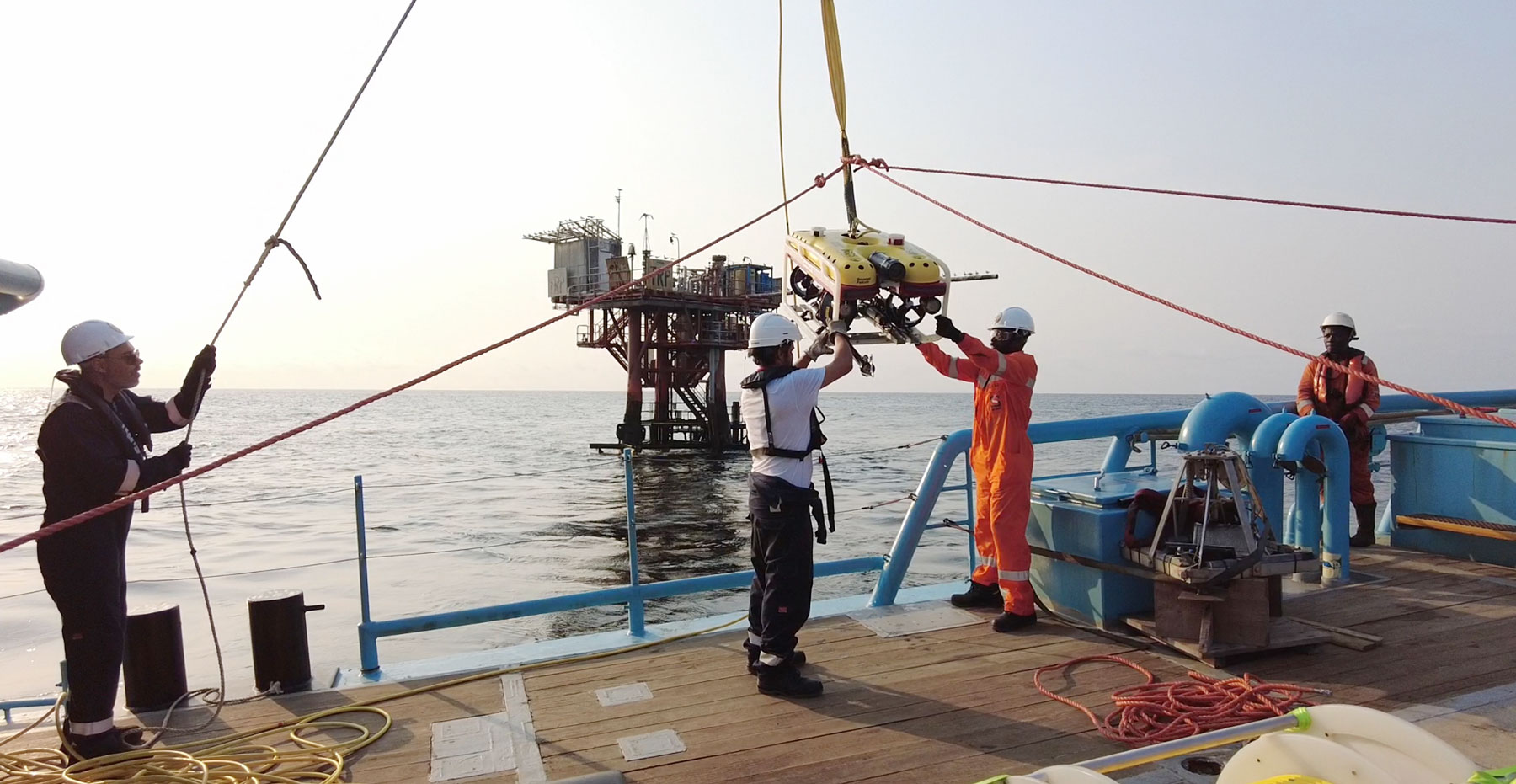 Seaeye Falcon underwater robot being deployed for inspection of the abandoned platform that will become an artificial reef.
Seaeye Falcon underwater robot being deployed for inspection of the abandoned platform that will become an artificial reef.
.jpg) EQS selected the Seaeye Falcon for its ability to handle an array of cameras, sensors, tooling and complex data gathering systems that include a digital multi-frequency profiling sonar.
EQS selected the Seaeye Falcon for its ability to handle an array of cameras, sensors, tooling and complex data gathering systems that include a digital multi-frequency profiling sonar.
Saab Seaeye is world leader in electric underwater robotics.
For more information contact:
Matt Bates
Saab Seaeye Ltd
+44 (0)1489 898000
Email Matt Bates
www.saabseaeye.com
Carlos Rodrigues
EQS
+351 934 422 810
Email Carlos Rodrigues
www.eqs-fze.com
6 October 2022
AUSTRALIA’S SUPER-SIZED SALMON FARMER GETS A FIFTH FALCON
Huon Aquaculture, Australia’s second largest salmon farmer, has purchased another Saab Seaeye Falcon underwater robotic vehicle to support its marine and environmental operations.
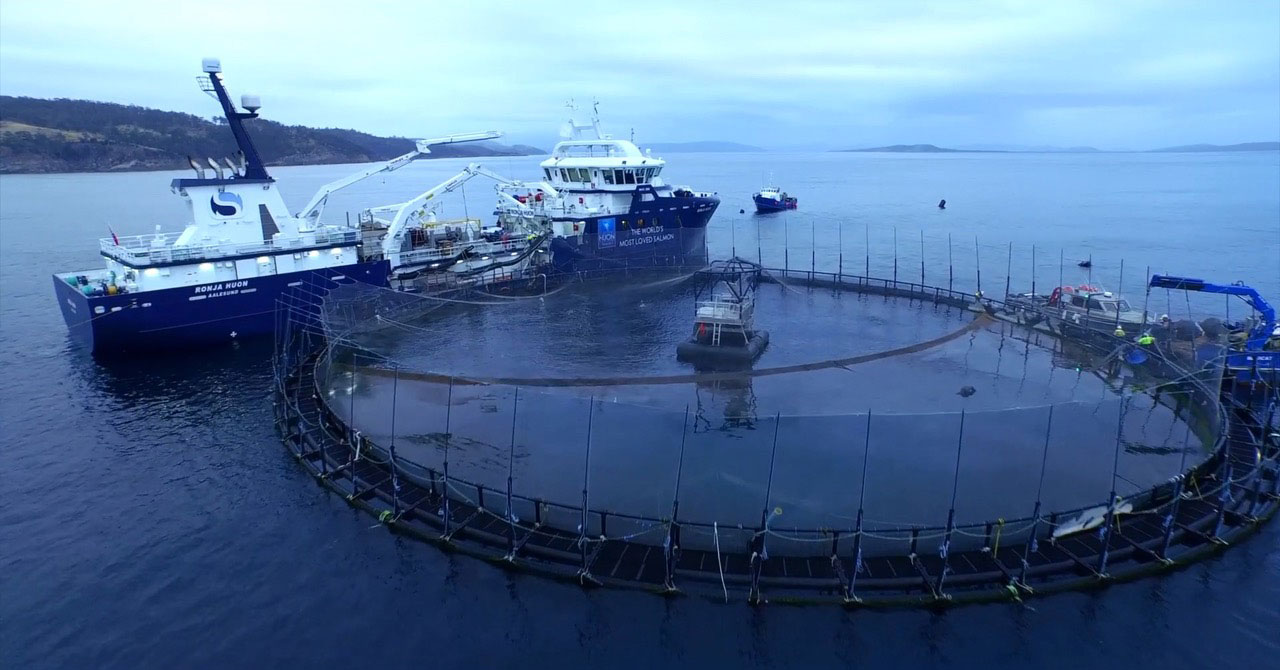
Falcons inspect and maintain Huon’s critical subsea farm infrastructures.
This brings Huon’s Falcon fleet to five. Huon sees the Seaeye Falcon as a vital farming tool for surveying and monitoring their marine leases in South East Tasmania, Australia.
Huon purchased their first Falcon in 2015 and have, since then, been operating Falcons 24 hours a day, seven days a week.
Dr Shea Cameron, Huon’s Subsea and Remote Systems Manager, says the Saab Seaeye model is invaluable to the company’s farming operations:
“Our dive and mooring teams use Falcons to inspect and maintain our critical subsea farm infrastructure.”
He says their Falcons spend more time in the water than any of the others in Huon’s large fleet of remotely operated vehicles that range from large specialist net cleaning vehicles to smaller eyeball class systems.
Dr Cameron adds that the Saab Seaeye Falcons have consistently proven to be a tough and capable platform, easy to service and with excellent manufacturer support.
“They can be rebuilt and repaired quickly and sent back out to work — making Huon a proud Saab Seaeye Operator!” Dr Cameron says.
As the world’s top selling robot in its class, the Saab Seaeye Falcon’s global success comes from being an easy to use, metre-sized, intelligent, multi-tasking, powerful, five-thruster strong, highly maneuverable robot with a reliability record covering over a million hours underwater.
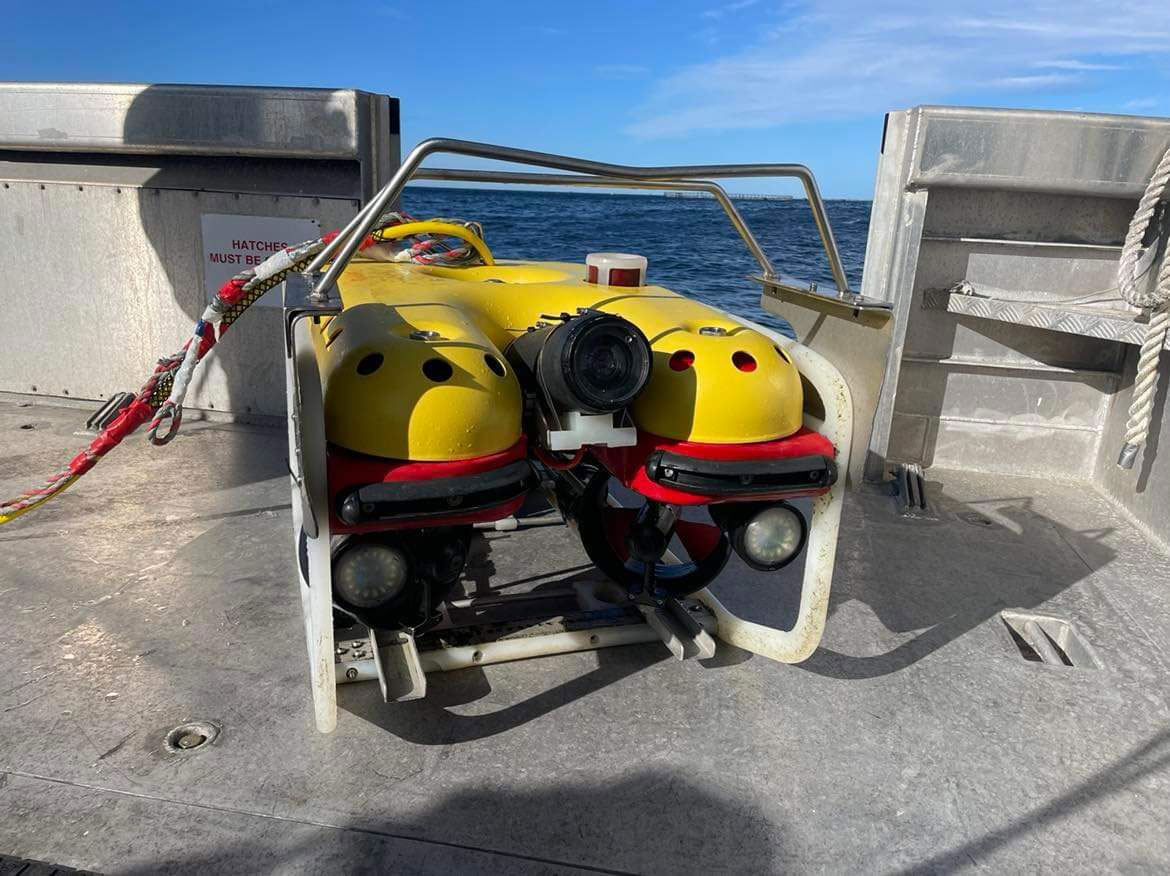
Huon has been operating Falcons 24 hours a day, seven days a week since 2015.
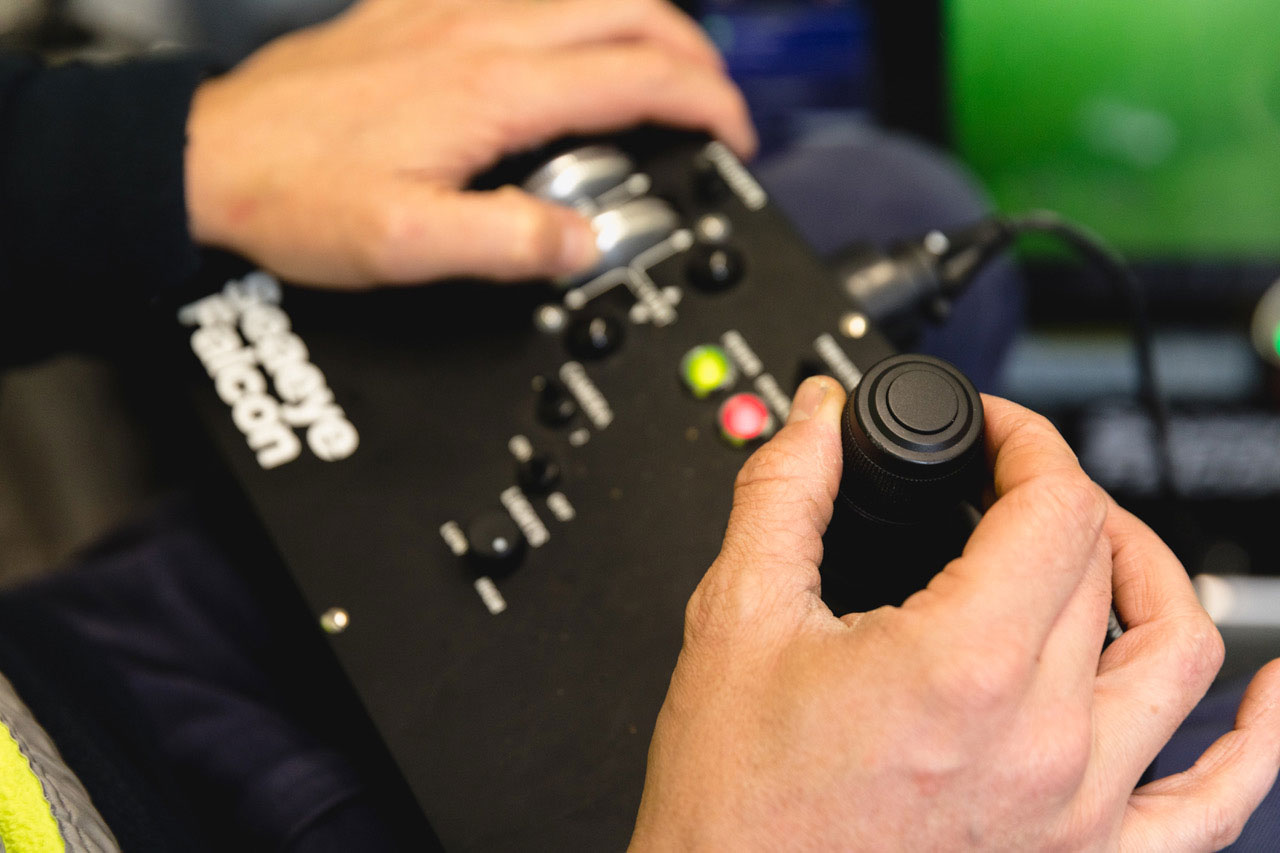
The world’s top selling robot the Falcon’s global success comes from being an easy to use, intelligent, powerful, highly manoeuvrable robot with a reliability record covering over a million hours underwater.
Saab Seaeye is world leader in electric underwater robotics.
Huon Aquaculture, founded in 1986, produces over 25,000 tonnes of salmon annually and is fully committed to farming and environmental stewardship in a responsible way.
For more information contact:
Matt Bates
Saab Seaeye Ltd
+44 (0)1489 898000
Email Matt Bates
www.saabseaeye.com
Dr Shea Cameron
Huon Aquaculture Group Limited
+03 6295 8115
Email Dr Shea Cameron
www.huonaqua.com.au
29 September 2022
FALCON IS WINNING STRATEGY FOR HYPROPS NIGERIA
Hyprops Nigeria Limited has chosen the Saab Seaeye Falcon as the best robotic vehicle resource for increasing their long-term footprint in Nigeria.
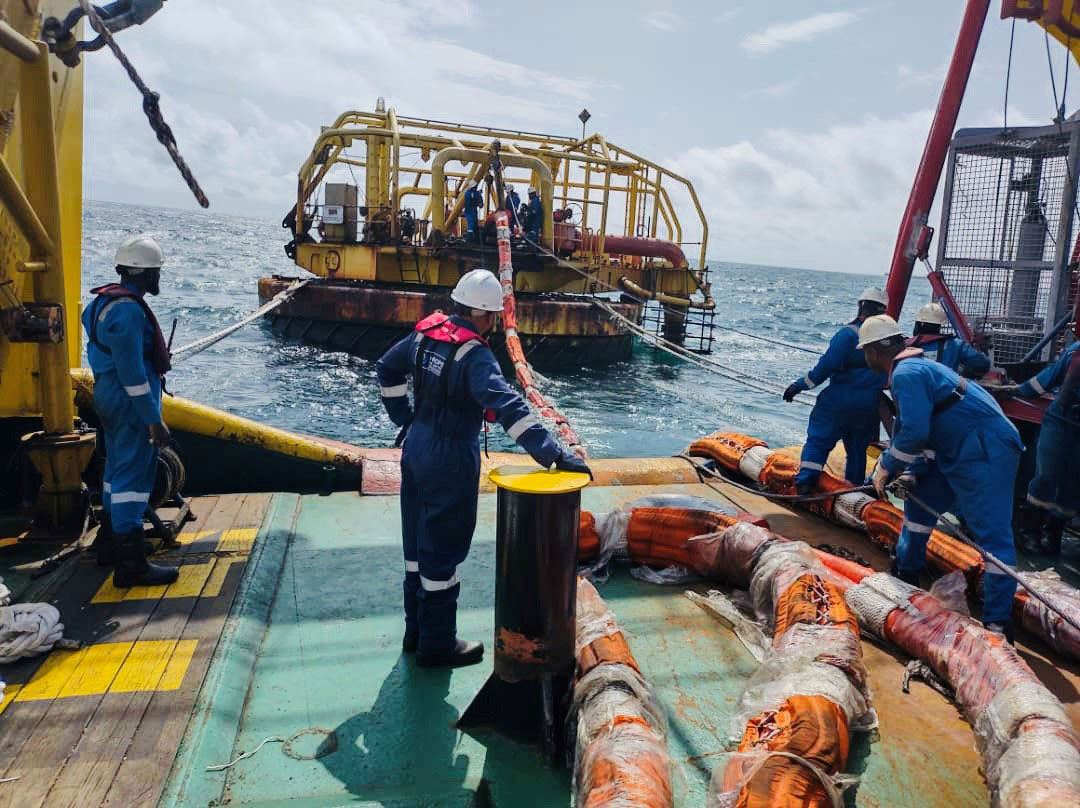
“Our current customers demand the Falcon as a trusted, easy-to-use resource,” says Hyprops.
“The Falcon has proven over the years to be capable and versatile, with a lightweight and portable construction that gives us the ability to perform diverse and difficult-to-access subsea operations.”
Incorporated in 1997, Hyprops provides a wide range of services to the Nigerian offshore oil and gas sector and adding the Falcon as their resource is in keeping with the Federal Government’s initiative to increase indigenous participation in the sector.
Hyprops describes the benefits expected from their Falcon:
- Depth options ranging from 300m to 1000m
- iCON™ intelligent control system allowing the option of customisation of the vehicle and giving the pilot total control
- Easy access to spares and a choice of tools and accessories
- Open frame construction allowing ease of fitting various sensors and tooling to meet client requirements
- Five-function manipulator arm, wire cutter and brushes enabling light work intervention
Hyprops conclude that the Falcon will give them the ability to meet the constant and vital need to inspect pipelines, flowlines, risers, vessels and platforms in both shallow and deep-water projects.
Already the world’s top selling robot of its class, the Saab Seaeye Falcon’s success comes from being an easy-to-use, metre-sized, intelligent, powerful, five-thruster-strong, highly manoeuvrable, multi-tasking, robot with a reliability record covering over a million hours underwater.
Hyprops will deploy the Falcon on subsea inspection, survey, light-intervention and maintenance services for current and future projects in the Nigerian market where their clients include international and indigenous oil companies.
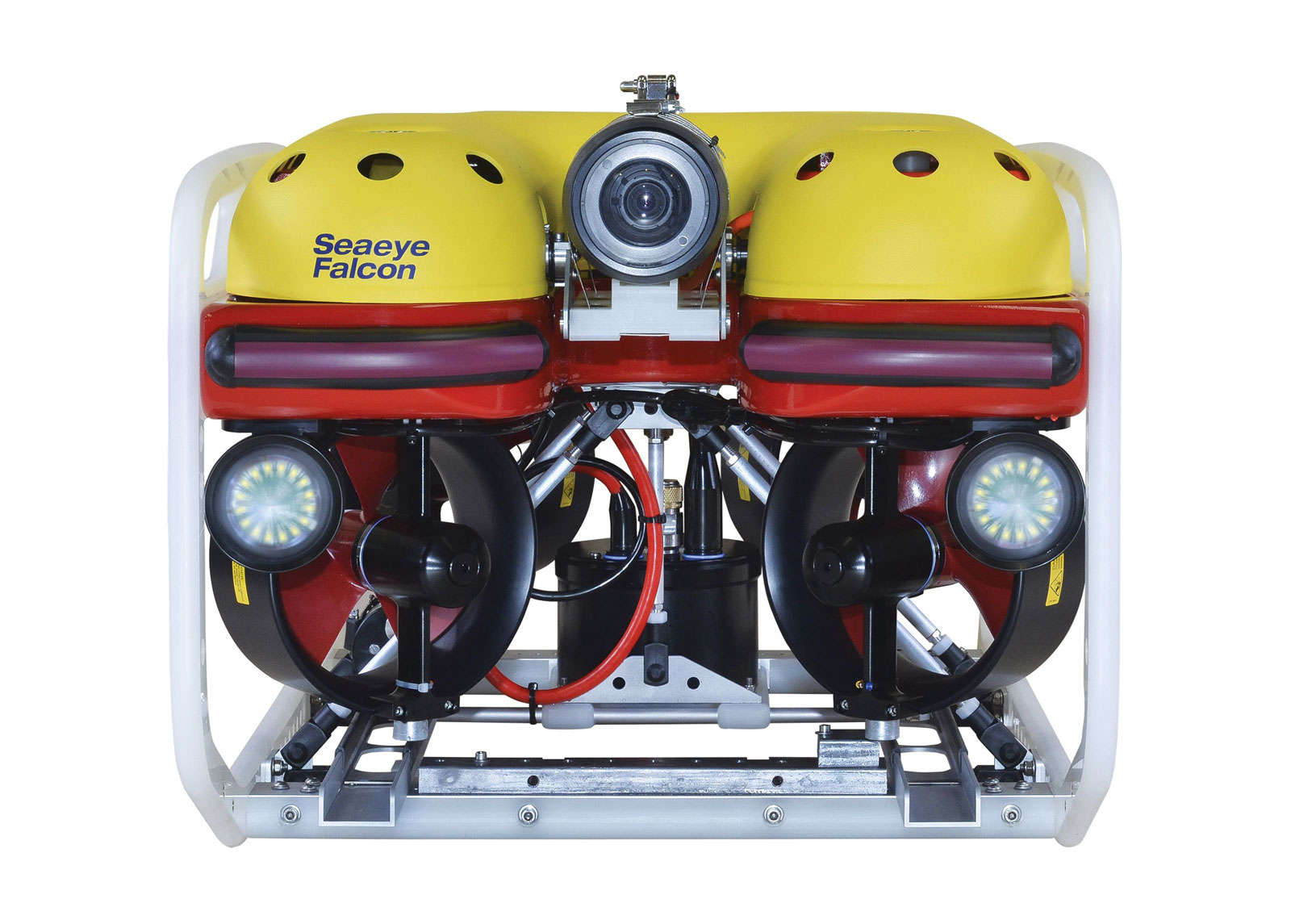
Hyprops: “Customers demand the Falcon as a trusted, easy-to-use resource.”
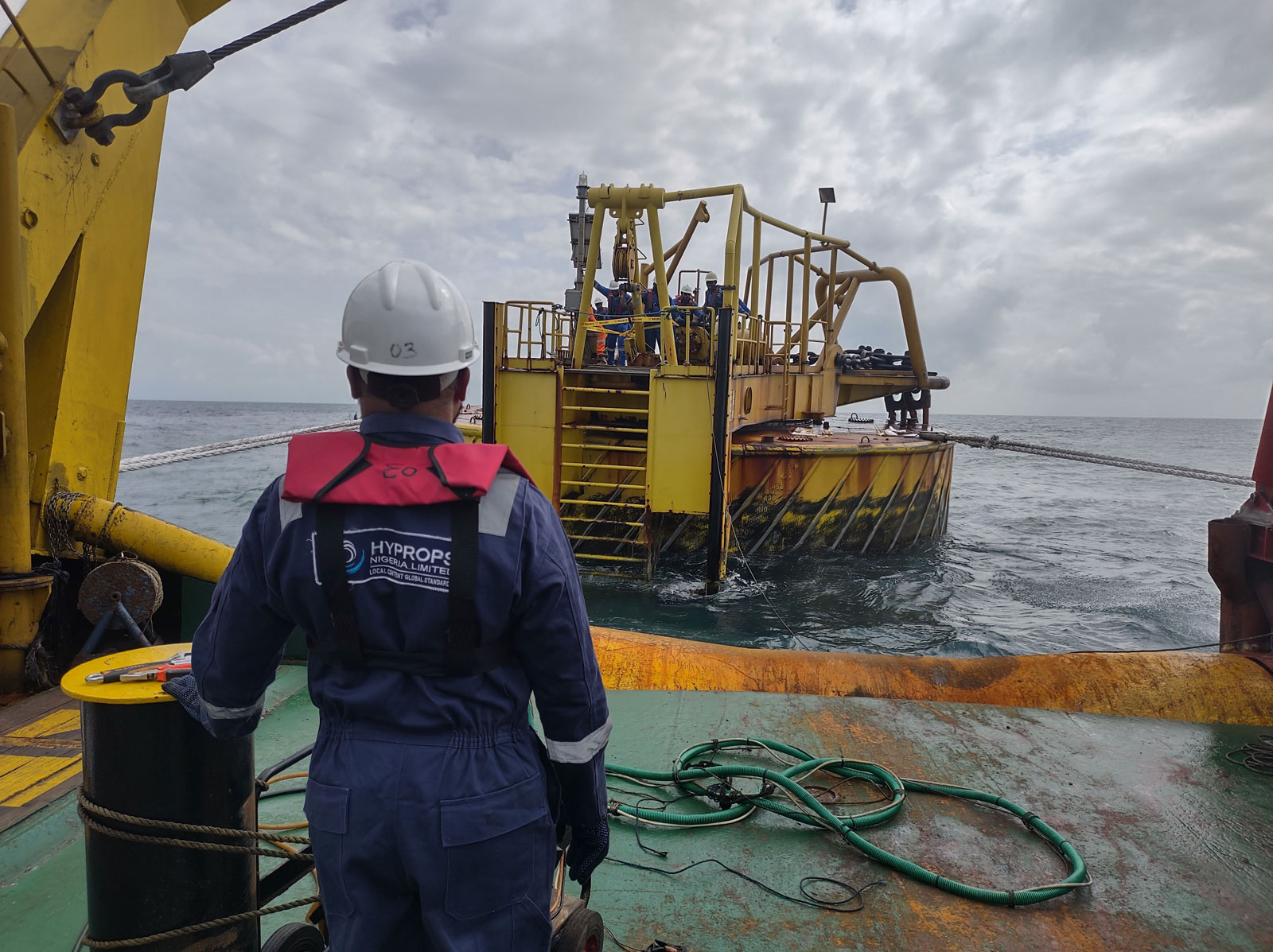
Hyprops Nigeria Limited provides a wide range of services to the Nigerian offshore oil and gas sector
Saab Seaeye is world leader in electric underwater robotics.
Hyprops Nigeria is a fully owned Nigerian company which has provided oilfield support services to the oil and gas industry in Nigeria since 1997 and is looking to expand into other markets.
For more information contact:
Matt Bates
Saab Seaeye Ltd
+44 (0)1489 898000
Email Matt Bates
www.saabseaeye.com
Mrs Chinweoke Okpalaji
Hyprops Nigeria Limited
+234 1 2717297
Email Mrs Chinweoke Okpalaji
www.hyprops.com
7 September 2022
SAAB SEAEYE PARTNERS MALDIVES MISSION
A Saab Seaeye Falcon underwater robotic vehicle will join a fleet of submersibles on the Nekton Maldives Mission to help the Maldives Government carry out the first systematic survey and sampling of the Maldives from the surface to 1000 metre depths.

The Nekton Maldives Mission will establish a ‘baseline health check’ on the status of Maldives ocean. (Photo credit: Saab Seaeye)
As an official partner, Saab Seaeye has donated the use of a Seaeye Falcon to work alongside human-occupied submersibles, autonomous systems and research technologies.
The Maldives state is 99% ocean and 1% land, sitting on average 1.5 metres above sea level. As a result, the nation faces a growing threat from rising seas.
For the first time, the mission will establish a ‘baseline health check’ on the status of the Maldives ocean and provide data to scientists and policy makers worldwide to enable the protection of critical nurseries, spawning habitats and related ecosystems.
The Nekton Maldives Mission, 4th September to 7th October, will help create extensive new protected marine areas and ensure the ocean continues to provide for the Maldivian people.
Nekton is a not-for-profit UK-based research foundation working with the University of Oxford and a wide range of partners to accelerate the scientific exploration and protection of the ocean.
The Falcon is the world’s top robot in its class with a reliability record covering over a million hours underwater.
Nekton Foundation is a not-for-profit research foundation and a registered charity that works with a wide range of partners to accelerate the scientific exploration and protection of the ocean.
Saab Seaeye is world leader in electric underwater robotics.
For more information contact:
Matt Bates
Saab Seaeye Ltd
+44 (0)1489 898000
Email Matt Bates
www.saabseaeye.com
Lisa Hynes
Nekton Foundation
+44 7966 272256
Email Lisa Hynes
www.nektonmission.org
25 August 2022
JAPAN GOES 3D WITH FALCON
Japan’s 3D survey company, Windy Network, has chosen a Saab Seaeye Falcon underwater robotic vehicle for its global operations.

Japanese submarine ‘Kairyu’ surveyed using 3D high-precision acoustic sonar.
They intend deploying the Falcon on a wide range of missions, including academic research, marine archaeology, fishery surveys and construction installation studies, such as offshore wind energy sites.
For such a variety of operational undertakings the versatile Falcon is an ideal choice, says Windy Network.
The Falcon can be fully loaded with cameras, sonars and tooling, yet will remain highly manoeuvrable and stay steady even in strong currents and turbulent waters.
Already the world’s top selling robot in its class, the Saab Seaeye Falcon’s success comes from being an easy to use, metre-sized, intelligent, powerful, five-thruster, multi-tasking vehicle with a reliability record covering over a million hours underwater.
It will join Windy Network’s fleet of remotely operated vehicles — a vital resource for an innovator in the research and development of 3D measurement systems and operator of Japan’s residential Ocean Research Training Facility.
As a marine survey 3D measurement company and developer, Windy Network aims to process huge amounts of acquired data with high accuracy and efficiency, corrected for ship vibration for a seamless display.
Supporting Windy Network in their acquisition was Saab Seaeye’s distributor in Japan, Marimex.
.jpg)
The Saab Seaeye Falcon’s reliability record covers over a million hours underwater working at a vast array of tasks using a variety of cameras, sonars and tooling.
Windy Network is a marine survey 3D measurement company and developer.
Saab Seaeye is world leader in electric underwater robotics.
For more information contact:
Matt Bates
Saab Seaeye Ltd
+44 (0)1489 898000
Email Matt Bates
www.saabseaeye.com
18 August 2022
FALCON AS EXPEDITION YACHT RESCUE ROBOT
For expedition yacht Dapple a Saab Seaeye deep-rated Falcon robot has been chosen as a standby rescue resource for emergency recovery of their manned submersible.
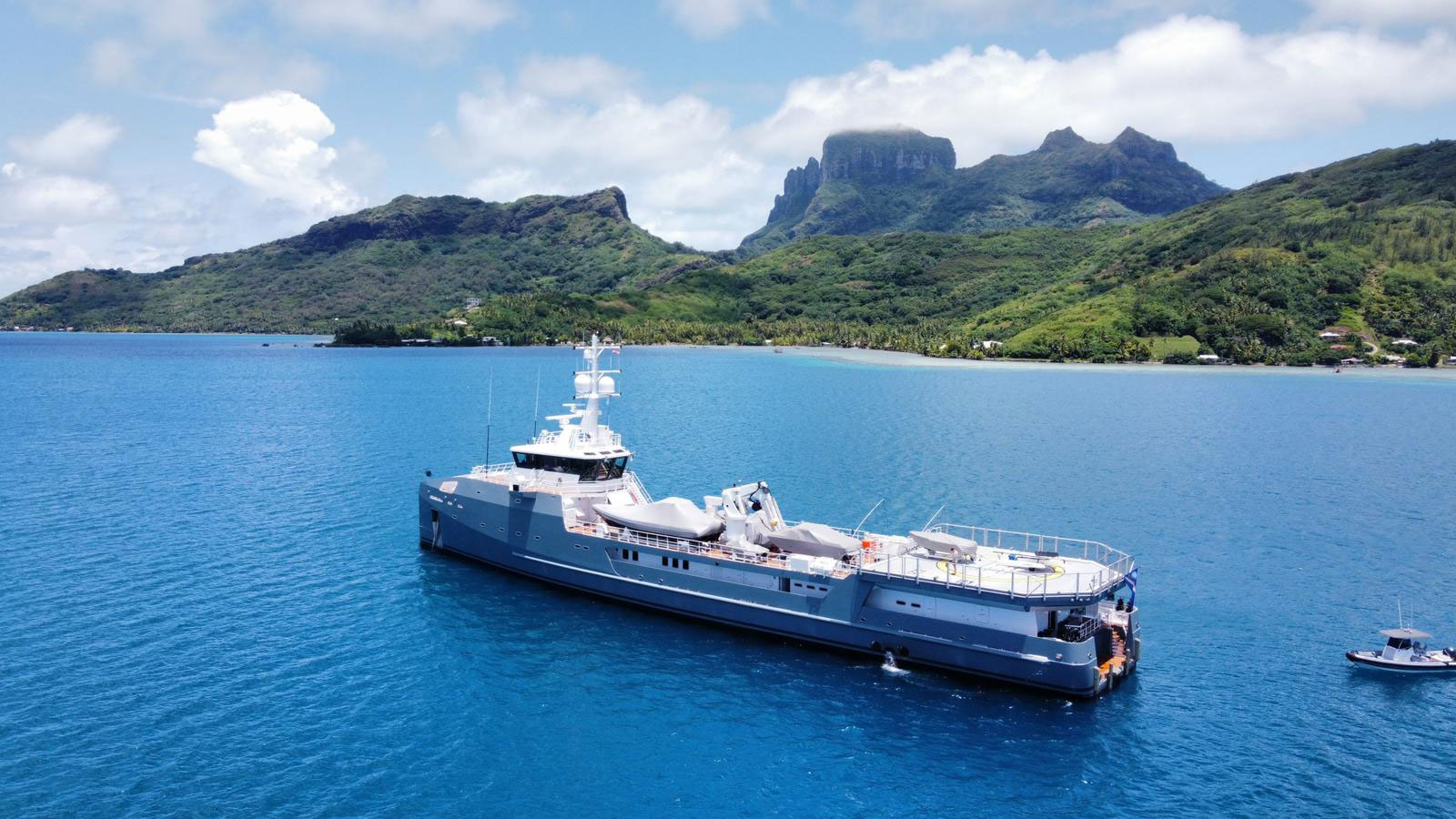
Expedition yacht Dapple in Bora Bora.
In addition, the 1000 metre-rated Falcon comes fully equipped for undertaking a wide range of scientific research and survey operations.
Dapple’s dive manager, Marc Taylor, says that the Falcon is a proven commercial choice, so fits their criteria, “and it makes sense because we already have a Falcon aboard another vessel in our fleet.”
Operators worldwide favour the Falcon, a small, intelligent robot with the power and task range typically found in much larger systems.
Not only can owners view underwater from aboard the yacht in high-definition images transmitted by the roaming Falcon, but the robot has many other uses.
It can examine the hull millimetre-by-millimetre, recover items from the seabed, cut ropes and cables, and clean critical fittings.
Specialist cameras, survey systems and manipulator arms can be fitted for research and survey missions.
For Dapple, the Falcon is equipped with an extensive range of technology including HDTV cameras, a multifrequency scanning sonar, multibeam sonar, laser system and an eventing suite. It also comes with both a three jaw and a five-function manipulator, each with rope cutters, along with hydraulic cable cutter and rotary cleaning brush.
Although the Falcon’s key role is recovery of Dapple’s submersible, for general diving safety the Falcon can survey a dive site beforehand, then watch over a diver when below and transport items back and forth during a dive.
The Falcon’s global success comes from being a small metre-sized, yet powerful, highly maneuverable, multi-tasking, easy to use vehicle, depth rated up to 1000 metres and enhanced with Saab Seaeye’s revolutionary iCON™ intelligent control system.
It has a trusted reliability record covering over a million hours of undersea operations, working in the most challenging environments, mastering turbulent waters and strong currents whilst remaining stable during filming, scanning and undertaking delicate tasks.
.jpg)
The world’s top selling robot with a million hours’ reliability record underwater, the Saab Seaeye Falcon can be fitted with a host of cameras, sonar and tooling for a wide variety of tasks.
Saab Seaeye is world leader in electric underwater robotics.
For more information contact:
Matt Bates
Saab Seaeye Ltd
+44 (0)1489 898000
Email Matt Bates
www.saabseaeye.com
Marc Taylor
M/Y DAPPLE
+689 877 986 56
Email M/Y DAPPLE
17 June 2022
SAAB SEAEYE AT GOODWOOD’S FESTIVAL OF SPEED
Future Lab, the innovation pavilion at Goodwood’s Festival of Speed, 23 – 26 June 2022, is featuring Saab Seaeye’s pioneering underwater robotic technology.
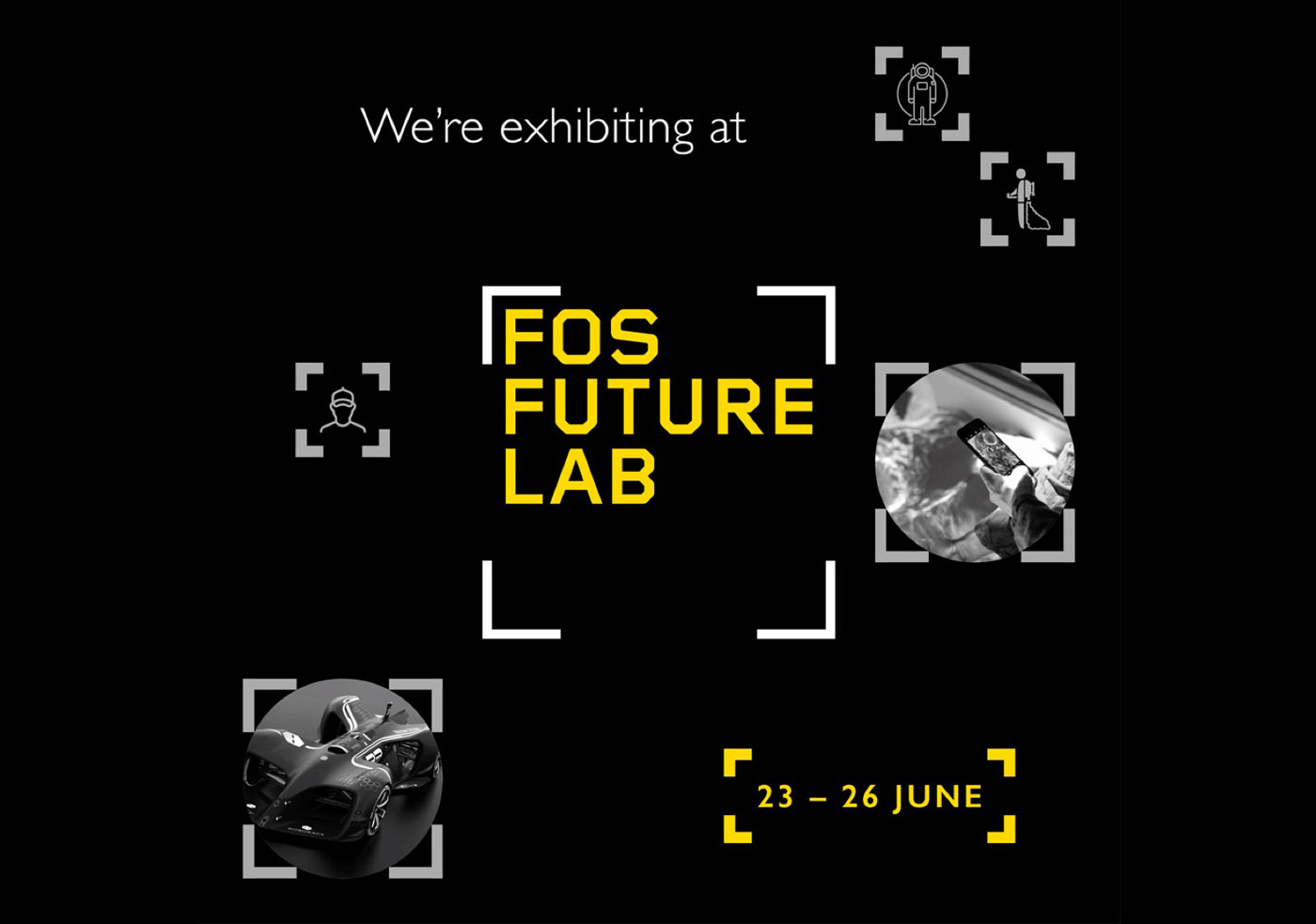
Goodwood says Future Lab presents “cutting edge new technologies that will change the way we live tomorrow”.
Visitors to the innovation pavilion can see visions of future and emerging technology set to inspire industry enthusiasts and the next generation of scientists, inventors and explorers.
Saab Seaeye is showcasing three revolutionary robotic systems highlighting the company’s inventive vision that has advanced and led underwater robotics for over 30 years.
On show will be Sabertooth, the world’s first deep-rated roaming and hovering robot that can operate in both autonomous and tethered modes, enabling fully flexible dual operations from a single platform whilst filming, surveying and operating tooling.
It was Sabertooth that successfully found the wreck of the Endurance, sunk 3000m below the Antarctic ice during Shackleton’s ill-fated expedition in 1915.
The new Seaeye eWROV, also on show, is a breakthrough in powerful electric work robotics. It is a considerably more environmentally friendly green alternative to the equivalent traditional hydraulic heavy work robotic systems.
Also featured is the Seaeye Falcon. Its innovative design has made it the world’s most popular underwater robot capable of undertaking a huge range of tasks. It is widely used by marine scientist for research and by innovators as a development platform.
The world leader in electric underwater robotics, Saab Seaeye has the largest range of electric robotic vehicles in the industry, operating across industrial, defence and scientific sectors.
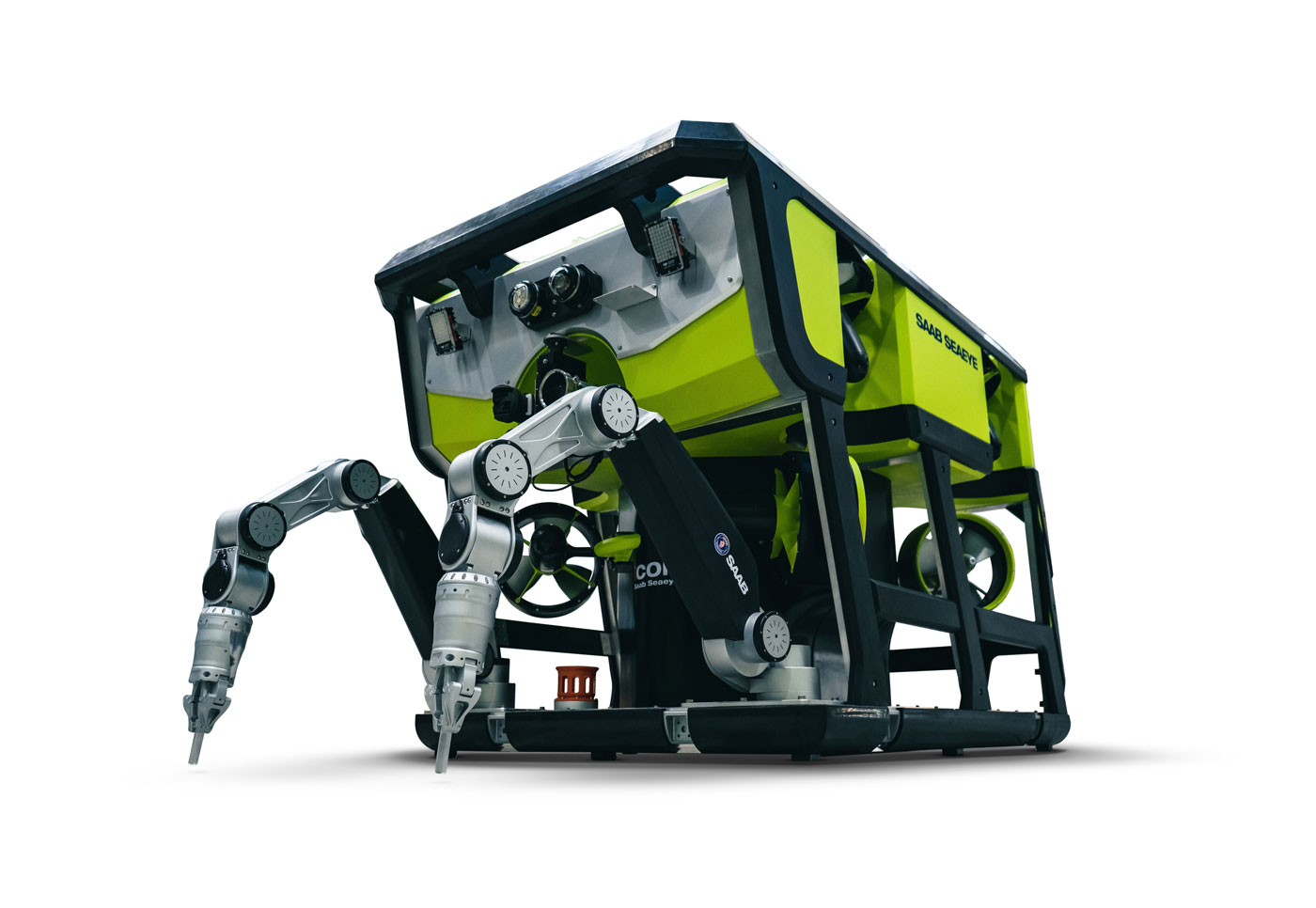
Innovative new electric work robot, eWROV, complete with pioneering new all-electric seven-function work-class Seaeye manipulators.
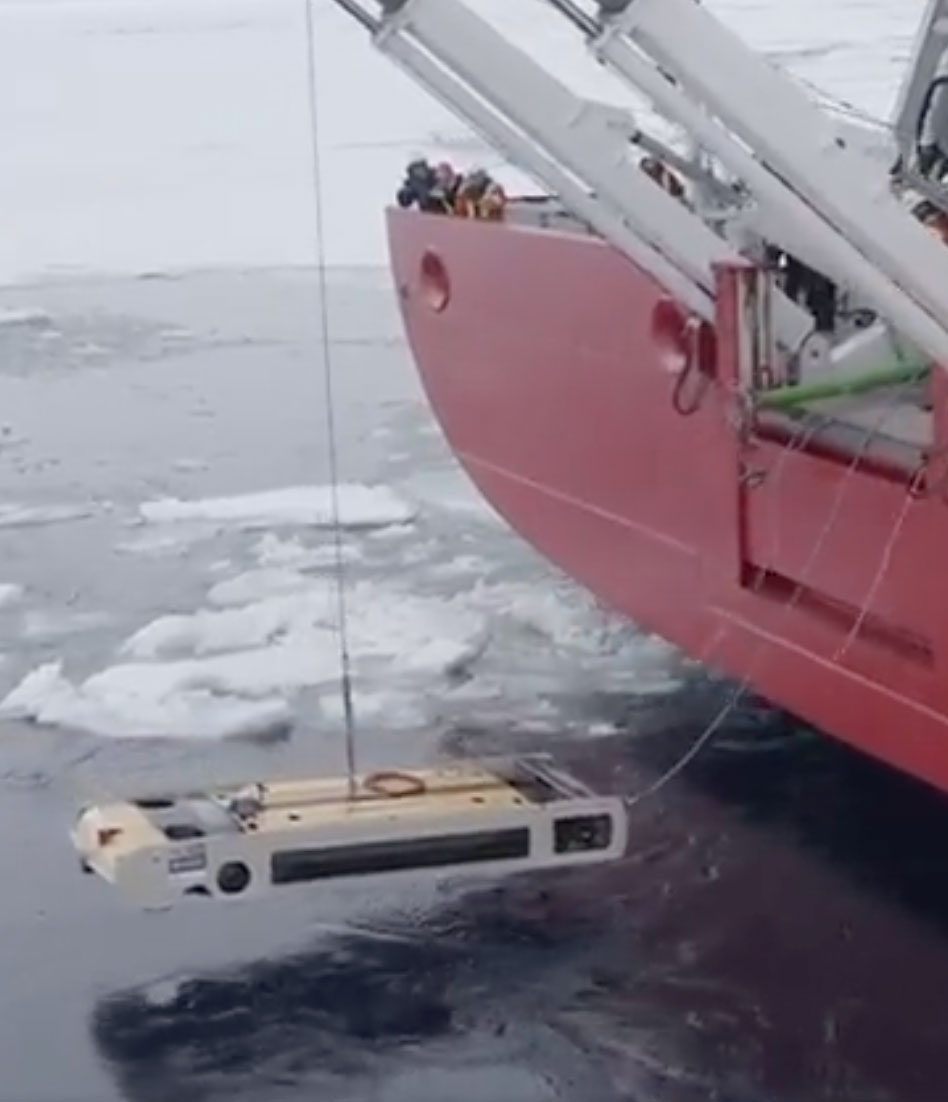
Sabertooth deployed into Antarctic waters in the successful search for the Endurance.
.jpg)
Sabertooth — the world’s first deep-rated roaming and hovering robot that can operate in both autonomous and tethered modes.
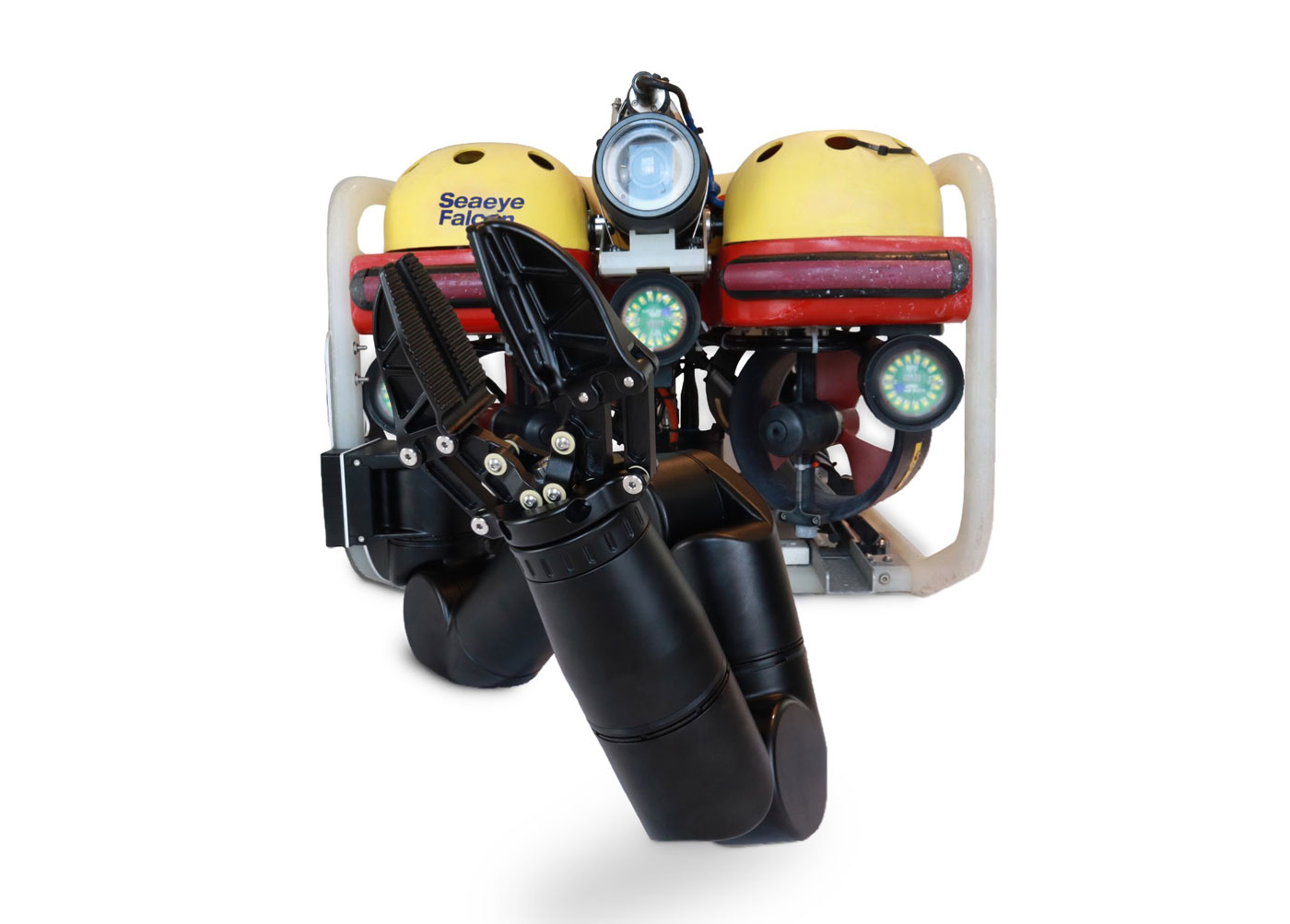
Falcon — the world’s most popular robot of its class and widely used by innovators as a development platform, shown here with a Blueprint Lab manipulator arm.
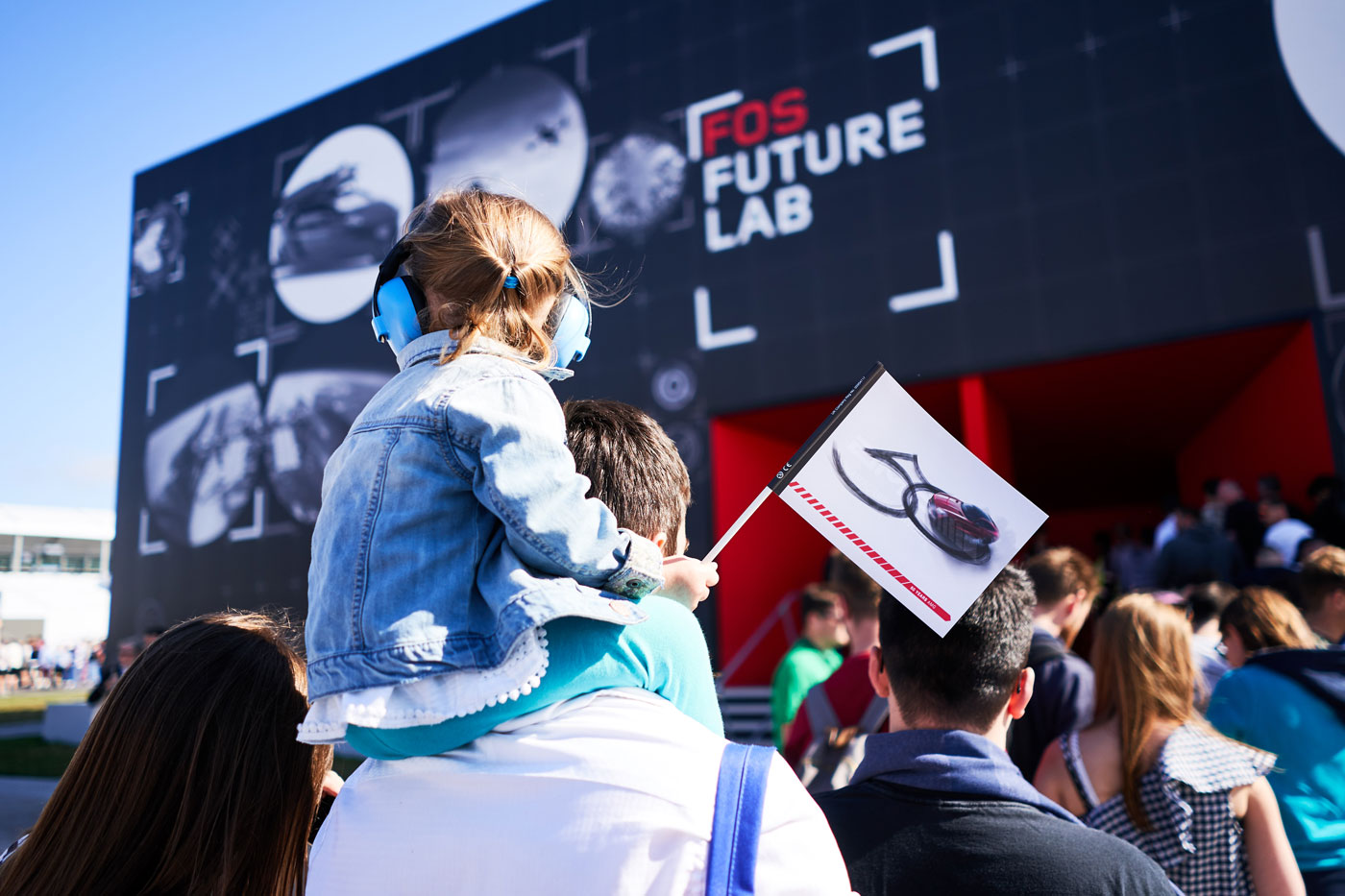
Photo courtesy Dominic James and Goodwood.
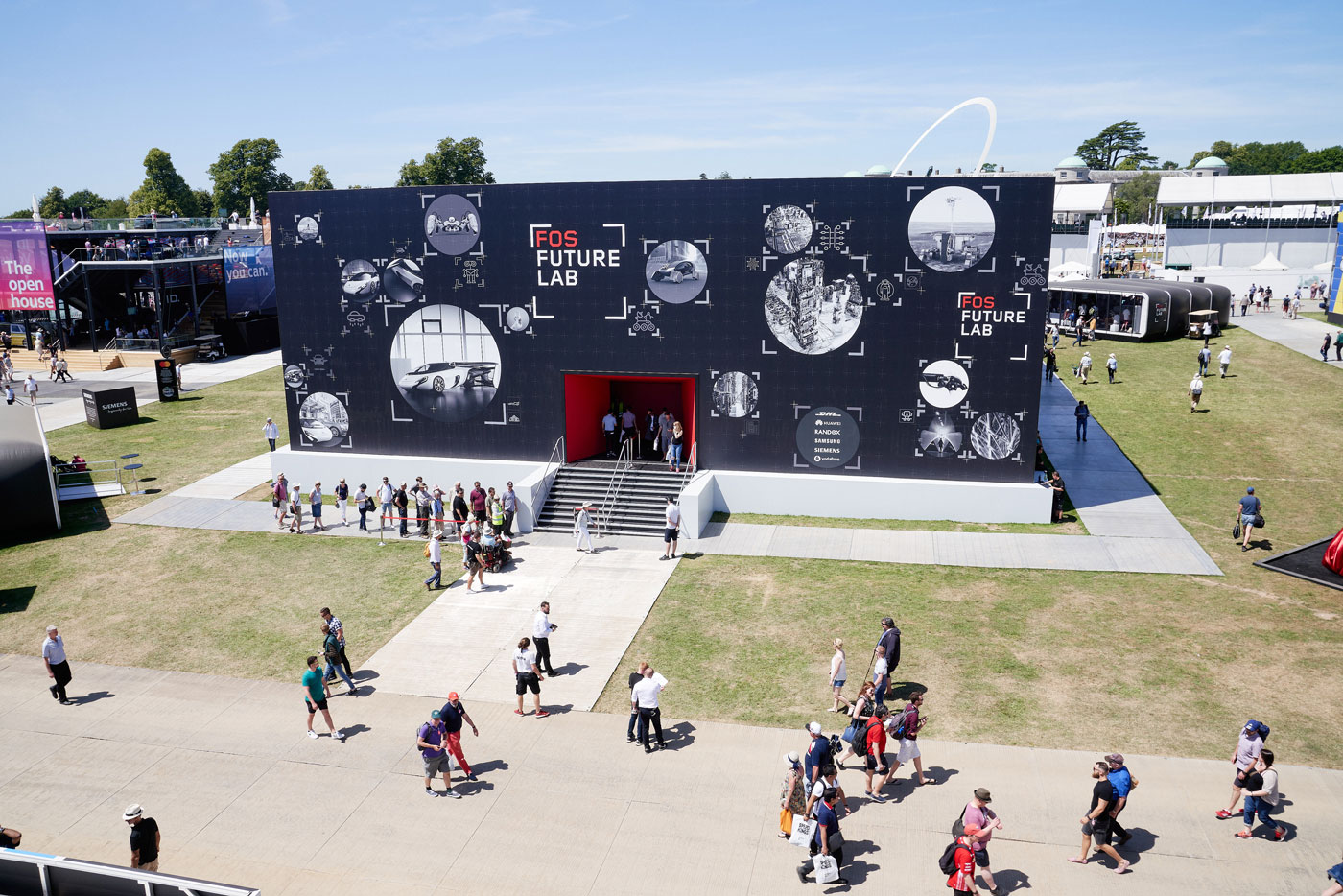
Photo courtesy Dominic James and Goodwood.
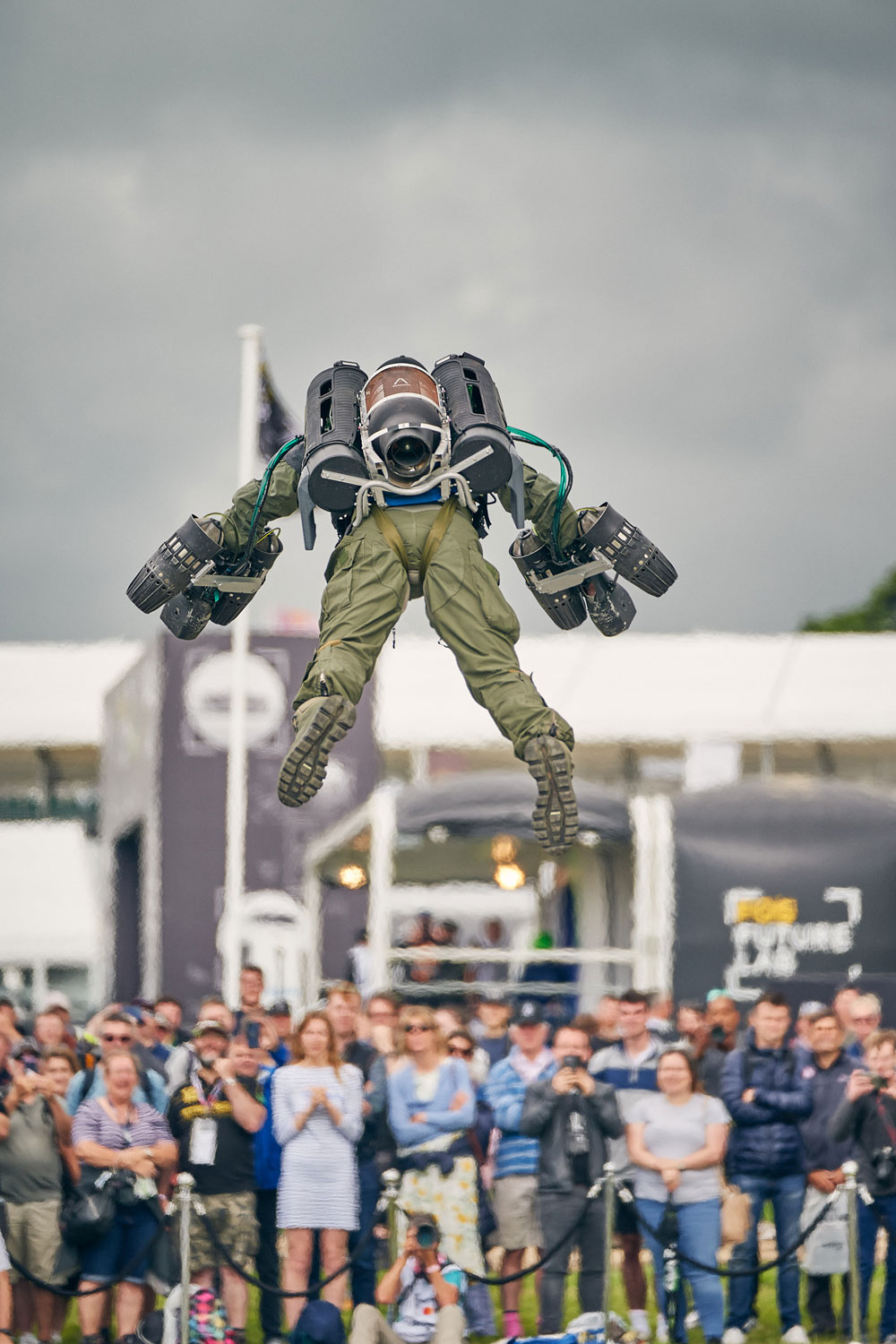
Photo courtesy Dominic James and Goodwood.
Saab Seaeye is world leader in electric underwater robotics.
For more information contact:
Matt Bates
Saab Seaeye Ltd
+44 (0)1489 898000
Email Matt Bates
www.saabseaeye.com
10 June 2022
FALCON BEST FOR JAPAN’S RENEWABLES SAYS SHIBUYA
For Japan’s growing offshore renewable sector, Shibuya Diving Industry Ltd (SDI), chose another Saab Seaeye Falcon for their Falcon fleet.

Shibuya chose the Seaeye Falcon as the best robot for supporting Japan’s floating wind turbine operations.
“As a diving company, an underwater robotic vehicle is a vital resource for extending our operational capability,” says Shibuya “and found the Falcon was the top choice globally amongst diving companies.”
“To find the best vehicle, we assessed the range on the market and found that the Seaeye Falcon is the most widely used robot in the offshore power generation business with the longest proven reliability record.”
Shibuya mainly deploy the Falcon for floating turbine work as, in a crowded and mountainous country, the search for sites in Japan is going offshore with floating turbines the favoured option in the deep waters off the rugged coast.
Experienced in renewables
Shibuya have 10 years’ experience in offshore wind power generation, being early to trial robots for the emerging use of floating turbines for power generation.
Shibuya recognises that robots are best placed to advance the use of floating turbines by confirming the stability of deep mooring anchorages and for carrying out periodic inspections of the floating structures.
Success in the floating offshore wind power generation business has extended Shibuya’s operations into tidal power generation and ocean current power generation.
For Shibuya, the Falcon’s multi-tasking capability with easy role change makes it an ideal choice. It is also easy to use, highly manoeuvrable and able to master turbulent waters and strong currents and remain stable whilst undertaking robust or precision tasks.
The reliability record of the Falcon, covering over a million hours of undersea operations, working in challenging environments at many different tasks, was particularly reassuring to Shibuya.
Diver safety
The Falcon plays a vital safety role by undertaking missions too hazardous for divers and where the depth of water and strength of current are dangerous for divers to operate, such as surveying fishing grounds and fishing reefs prior to turbine installation — and periodic inspection of mooring anchors and chains.
The addition of the Falcon to diving operations improves diver safety and increase efficiency, Shibuya says, by pinpointing and examining locations of interest before sending down divers.
Also, during the diving operation the Falcon robot can keep a watchful eye — and save dive time by transporting tools and parts back and forth.
Planting seaweed forests
Important in Japan’s development of offshore technologies for power generation is maintaining harmony with the natural environment and enabling marine ecosystems and floating turbines to co-exist and promote sustainable fishing.
To this extent, Shibuya is involved in the proliferation of seaweed forests in power generation areas by releasing seaweed seedlings to promote an increase in fishery resources.
They have conducted seaweed bed surveys and regeneration in more than 50 locations throughout Japan.
Shibuya’s Seaeye Falcons continue to play an important role in supporting this important sustainable enterprise as the renewable energy business continues to grow in Japan.
Supporting Shibuya in their acquisition of their additional Falcon was Saab Seaeye’s distributor in Japan, Marimex.
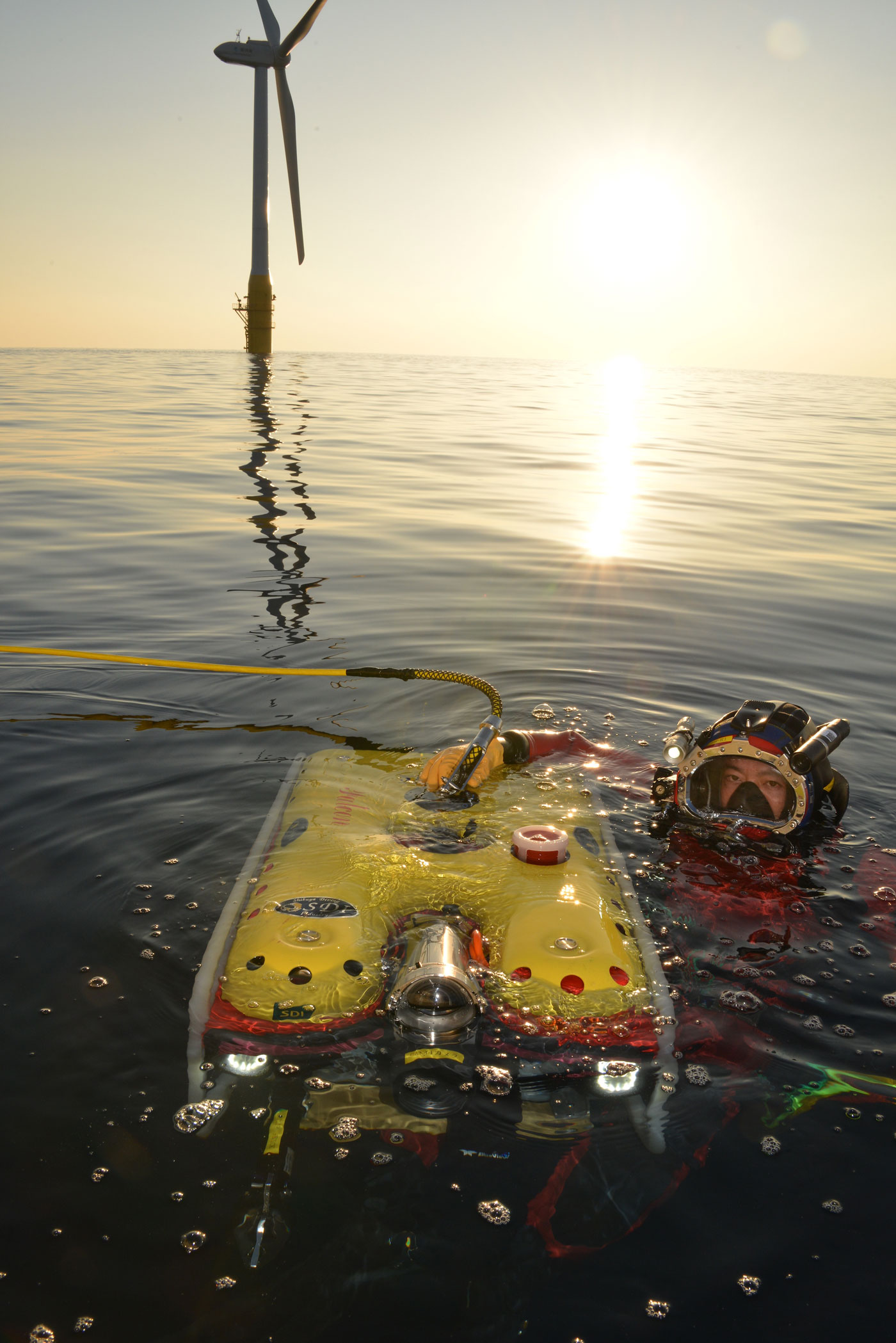
Shibuya chose the Seaeye Falcon as the best robot for supporting Japan’s floating wind turbine operations.
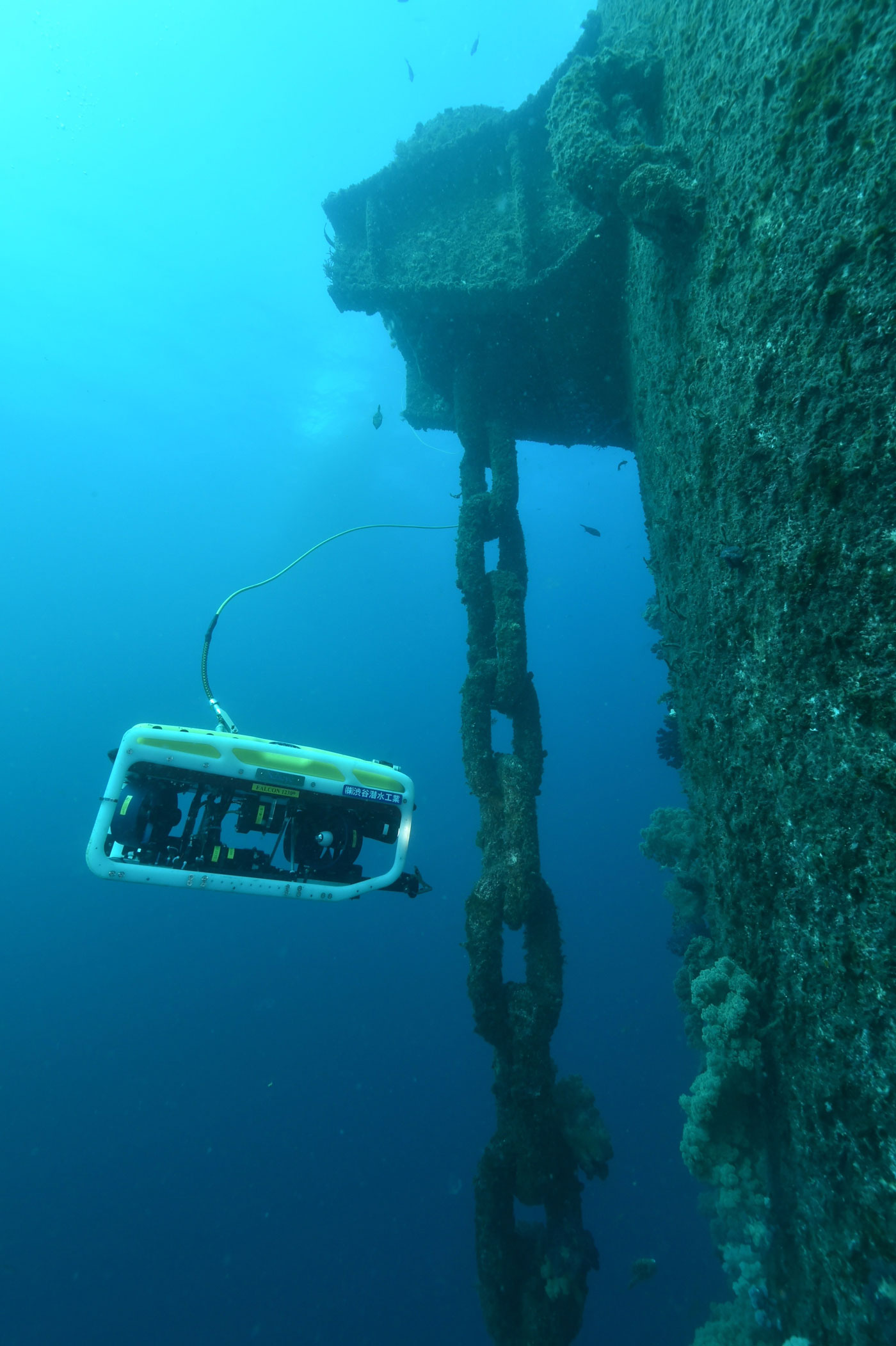
The Falcon’s ability to hold steady in turbulent waters and strong currents, makes it ideal for inspection of floating turbine chains and anchorages, says Japan’s Shibuya Diving company.
Saab Seaeye is world leader in electric underwater robotics.
Shibuya Diving Industry (SDI) is a leader in Japan’s offshore renewable energy sector.
For more information contact:
Matt Bates
Saab Seaeye Ltd
+44 (0)1489 898000
Email Matt Bates
www.saabseaeye.com
Akihiro Sugiuchi
Shibuya Diving Industry
+81 (0)463 50 3350
Email Akihiro Sugiuchi
shibuya-diving.co.jp
29 April 2022
PORTUGUESE NAVY HYDROGRAPHY TRAINING WITH EQS FALCON
Training exercises aboard a Portuguese Navy hydrographic vessel have been completed by EQS (Environment Quality Services) using their Saab Seaeye Falcon robot.
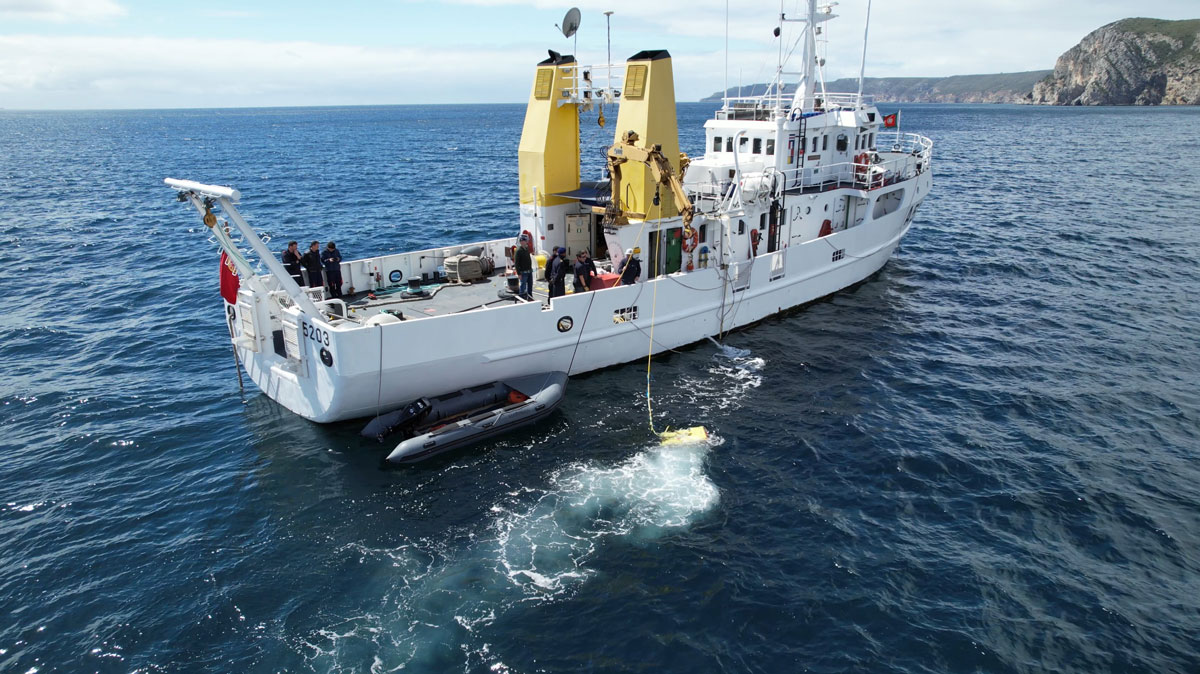
Saab Seaeye Falcon robot deployed during training exercises aboard a Portuguese Navy hydrographic vessel with EQS (Environment Quality Services).
Teams from the Portuguese Hydrographic Institute and EQS undertook several exercises over three days on board the Portuguese Navy vessel Andrómeda, commanded by First Lieutenant Ribeiro de Carvalho, off the coast of Portugal.
The main objective was to verify the operability and functionalities of the systems in their various configurations along with the spectrum of commitment, says Carlos Rodrigues of EQS.
This included basic navigation, object collection, integration of sonar systems and exercises with a USBL positioning system.
The Seaeye Falcon remotely controlled underwater vehicle allows for extended observation of the sea floor and underwater structures, explains Carlos Rodrigues, making it possible to increase the ship’s scientific research capabilities.
Chosen for its power and task range, typically found in much larger robotic vehicles, the Falcon’s module-focussed iCON™ intelligent distributed control architecture makes adding and changing systems easy and future-flexible for evolving technologies.
The world’s top selling robot of its class, with a reliability record covering over a million hours underwater, the Falcon’s proven success comes from being a reliable, easy to use, metre-sized, intelligent, powerful, five-thruster, highly manoeuvrable, multi-tasking, robot, depth rated to 1000 metres.
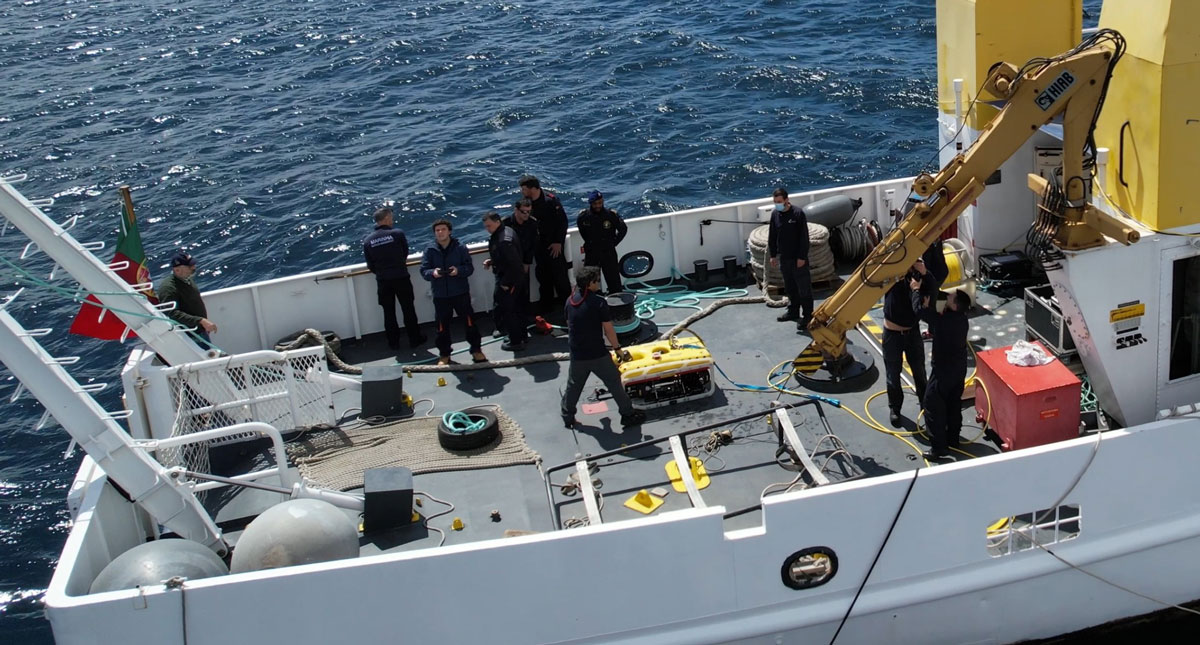
Teams from the Portuguese Hydrographic Institute and EQS undertook several exercises involving the Falcon, including basic navigation, object collection, integration of sonar systems and exercises with a USBL positioning system.
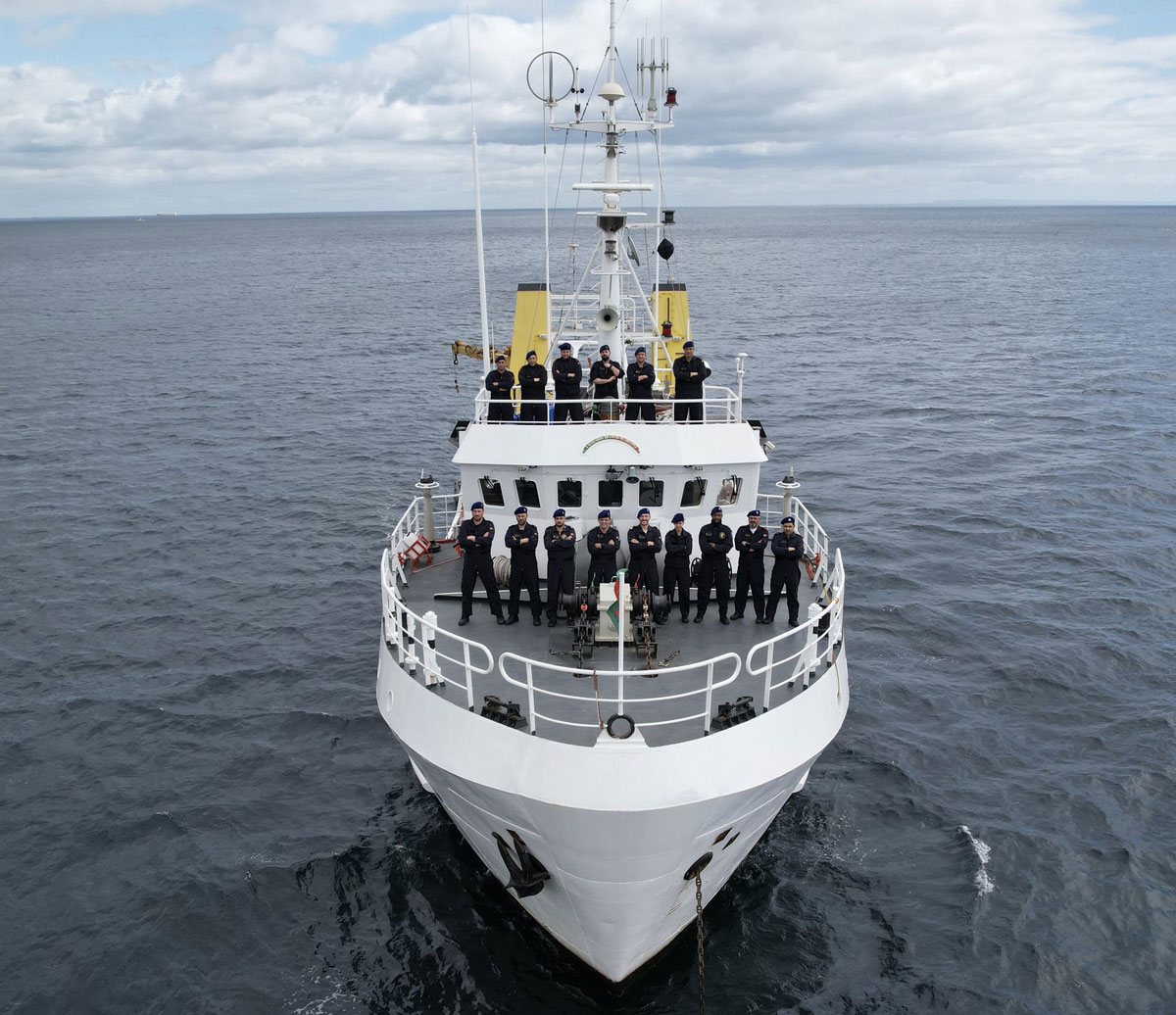
The crew aboard the Portuguese Navy vessel Andrómeda, off the coast of Portugal, commanded by First Lieutenant Ribeiro de Carvalho.
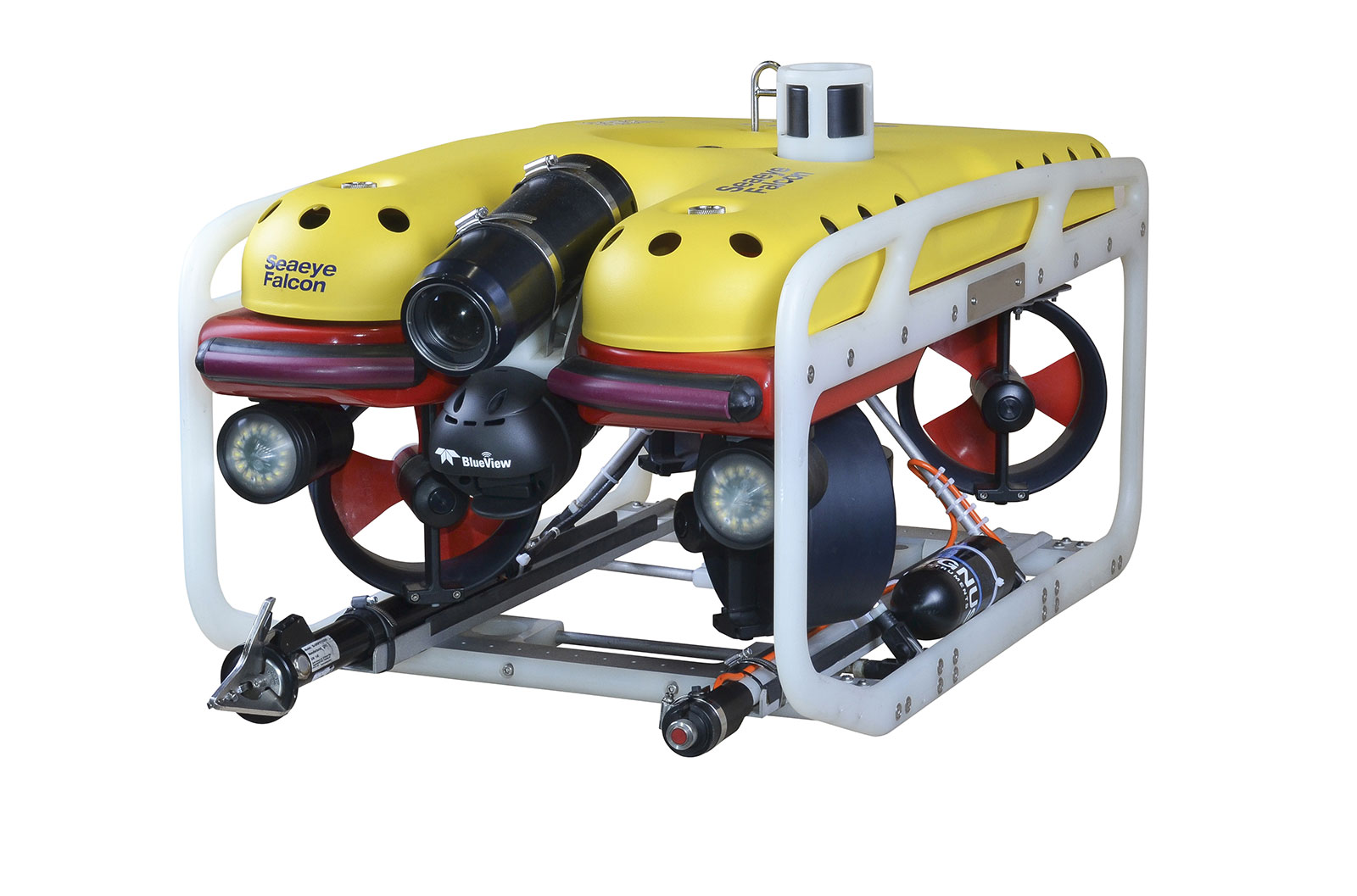
The world’s top-selling robotic vehicle in its class, performing thousands of hours of undersea operations, the Falcon offers the versatility, power and control intelligence needed to perform a vast array of tasks.
Saab Seaeye is world leader in electric underwater robotics.
EQS provides cost-effective solutions to complex and routine environmental projects.
For more information contact:
Matt Bates
Saab Seaeye Ltd
+44 (0)1489 898000
Email Matt Bates
www.saabseaeye.com
Carlos Rodrigues
EQS
+351 934 422 810
Email Carlos Rodrigues
www.eqs-fze.com
25 April 2022
INTELLIGENT MUSCLE AT OTC
A new extremely powerful and intelligent electric manipulator can be seen on Saab Seaeye’s Stand 1406 at the Ocean Technology Conference, Houston, 2 – 5 May 2022.
.png)
Intelligent muscle with Seaeye’s new work-class manipulator, eM1-7, as precise as it is strong.
The pioneering breakthrough is Saab Seaeye’s new eM1-7 seven-function all-electric work-class manipulator.
As powerful as a hydraulic equivalent, it is more reliable and more dexterous.
Seaeye eM1-7’s micrometre precision comes from each of its seven joints having extremely accurate force and position feedback coupled with their own smart distributed microprocessor for intelligent, intuitive and precision arm control.
Visitors to the exhibition stand can also hear more about other innovations that are changing the face of underwater enterprises.
Saab Seaeye’s innovative new environmentally friendly electric work vehicle, called eWROV, matches the power of a 250 hp hydraulic work class system, but is easier to operate, more precise, acoustically quieter, more reliable, needs less maintenance and has a much lower lifetime cost.
Already the world leader in electric underwater robotics, Saab Seaeye’s eWROV joins the largest range of electric robotic vehicles in the industry.
This includes the multi-role 3000m rated Sabertooth, the world leading roaming and hovering robot that can operate in both fully autonomous and tethered modes, enabling fully flexible dual operations from a single platform fitted with cameras, sonars and tooling.
Two Sabertooth robots have succeeded in finding the wreck of the Endurance, sunk 3000m below the Antarctic ice during Shackleton’s ill-fated expedition in 1915.
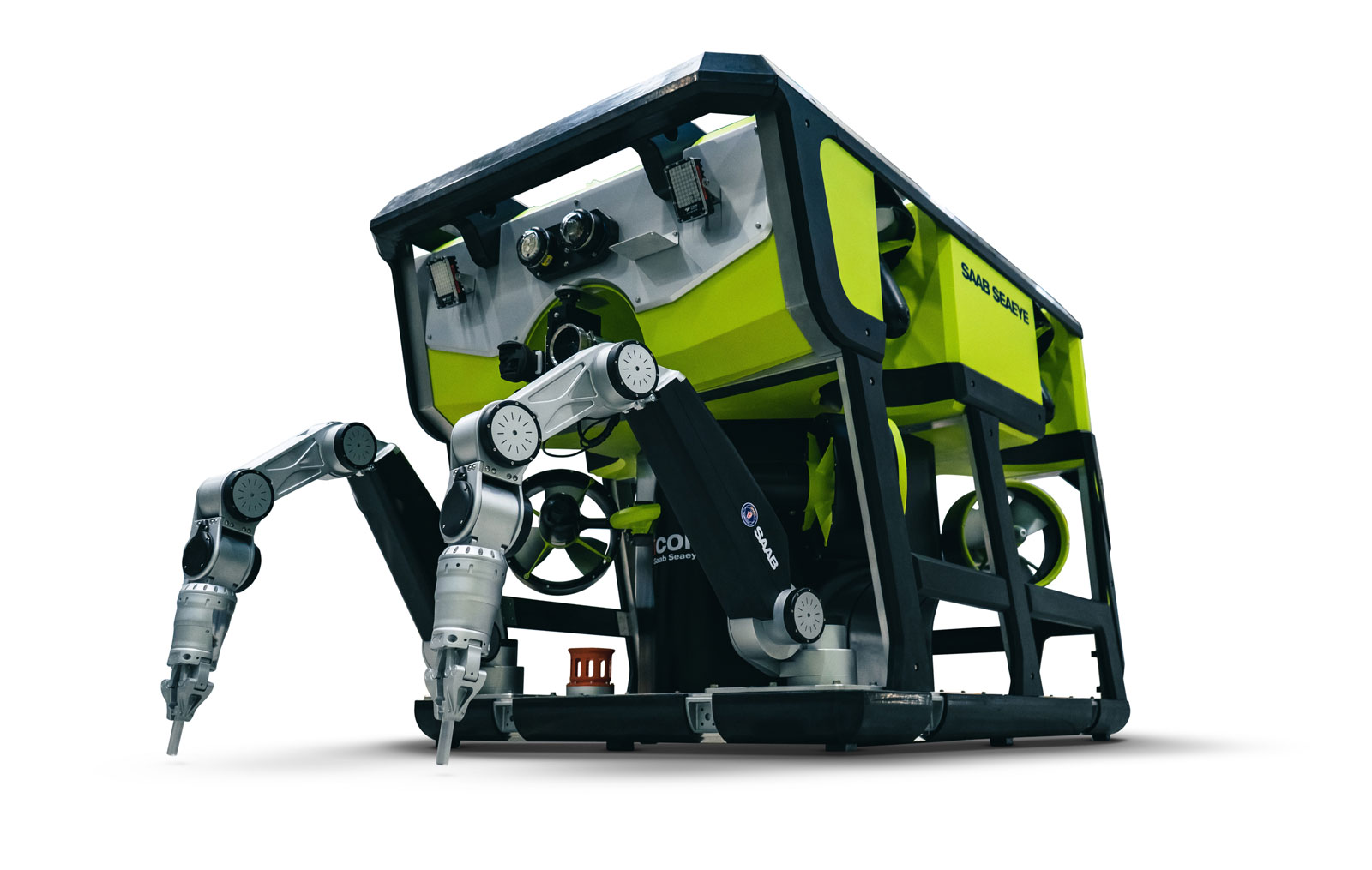
Innovative new electric work robot, eWROV, complete with pioneering new all-electric seven-function work-class Seaeye manipulators.
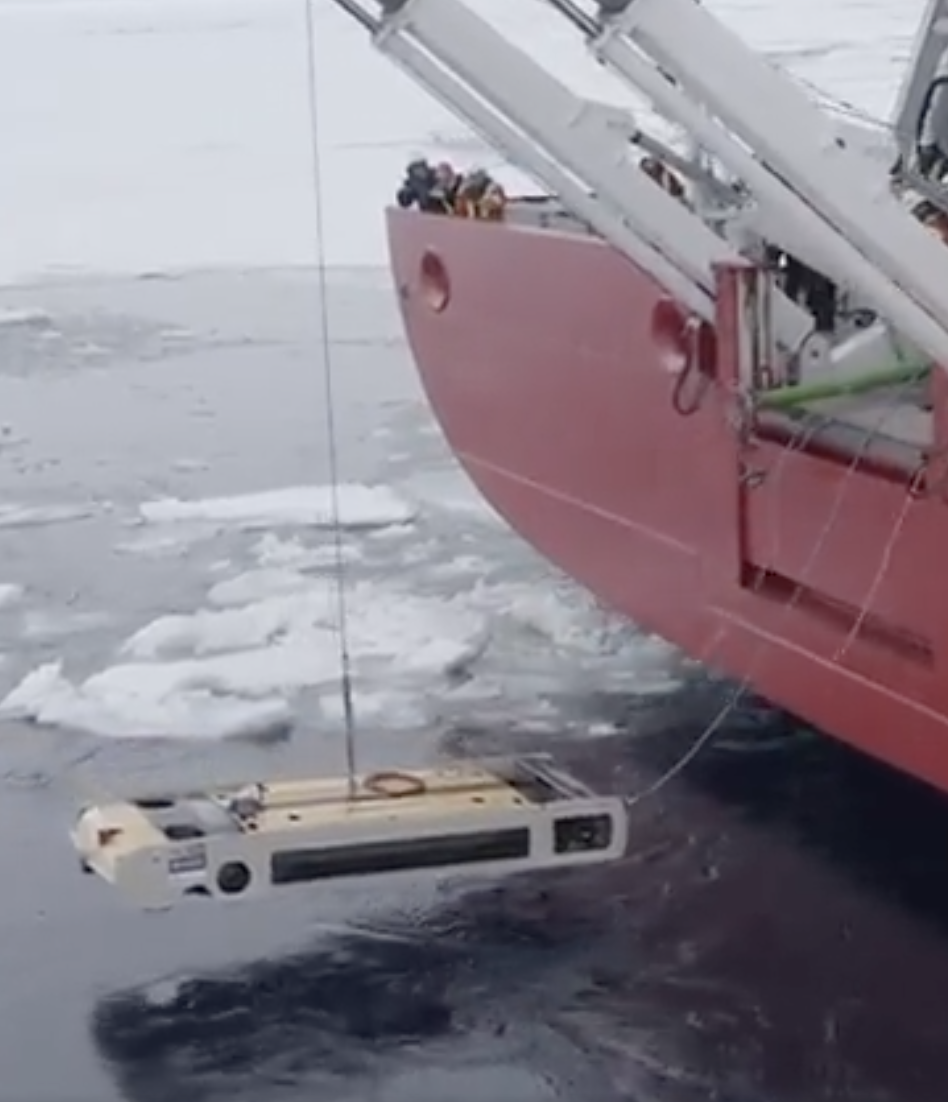
Sabertooth deployed into Antarctic waters in the successful search for the Endurance.
For more information contact:
Matt Bates
Saab Seaeye Ltd
+44 (0)1489 898000
Email Matt Bates
www.saabseaeye.com
10 March 2022
BREAKTHROUGH ROBOTICS AT OCEANOLOGY INTERNATIONAL
Highlighted at Oceanology International in March is Saab Seaeye’s new eco-responsible all-electric work-class robot, eWROV.

The all-electric eco-responsible Seaeye eWROV fitted with two all-electric Seaeye eManips — both on show at Oceanology International.
With the performance of a 250hp hydraulic work vehicle, eWROV is easier to operate, more precise, acoustically quieter, more reliable and needs less maintenance than hydraulic equivalents.
Empowering progress towards a sustainable future eWROV can be operated from onshore control centres, is resident-ready and will play an important role in future autonomous vessel fleets.
Also on show is eManip, Saab Seaeye’s all-electric seven-function work-class manipulator. As powerful as its hydraulic equivalent, eManip is more accurate, more reliable and more dexterous.
Each of eManip’s seven joints has its own inbuilt intelligence for intuitive millimetre precision control in addition to force and position feedback.
At the core of their robotics vision is Seaeye’s module-focussed iCON™ intelligent distributed control architecture that is future-flexible, enabling easy adoption of evolving technologies.
Visit us on Stand H100 and find out how Saab Seaeye is advancing robotics for a sustainable world.
For more information contact:
Matt Bates
Saab Seaeye Ltd
+44 (0)1489 898000
Email Matt Bates
www.saabseaeye.com
3 March 2022
Japan’s growing offshore wind industry is gaining a Saab Seaeye Cougar XTi underwater robotic vehicle for cable burial inspection and other roles.
.jpg)
The Saab Seaeye Cougar XTi for Kayo Engineering can operate precisely in strong currents whilst fitted with cameras, sonars and tools.
Kaiyo Engineering has acquired the 2000m rated Cougar, incorporating intelligent control architecture, for deployment from a 250ton mother ship, the Kaiyo Maru.
The ship is one of a fleet of vessels belonging to Kaiyo Engineering, the only privately owned research and observation company in Japan.
The Cougar XTi adds to Kaiyo’s portfolio of Saab Seaeye robots that include a Leopard and a Falcon.
In addition to its cable inspection role, the Cougar will also be used by Kaiyo Engineering to cover additional Leopard work.
Worldwide, Saab Seaeye robots play a dominant role in offshore renewables, as they are technologically suited for the challenges involved in building and maintaining structures and interconnections.
The Cougar XTi is a particular favourite. With its six powerful thrusters it can hold steady in cross currents and operate with precise manoeuvrability whilst fitted with a wide array of equipment.
Kaiyo’s Cougar comes with four Imenco cameras, a Tritech SeaKing sonar, Nortek DVL and station-keeping software, and a five-function heavy duty manipulator with camera.
Its intelligent iCON™ behaviour-based ecosystem endows each device with its own microprocessor for individual control and real-time feedback, in a modular future-flexible system that allows for further development and innovation.
The entire Kaiyo Cougar XTi operational configuration includes a launch and recovery system (LARS), tether management system (TMS) and 20ft control cabin and workshop.
Supporting the successful acquisition of the Cougar and other robotic systems is Saab Seaeye’s distributor in Japan, Marimex Japan K.K.
Saab Seaeye is world leader in electric underwater robotics.
Kaiyo Engineering is a long-established research and observation company that undertakes a variety of projects including collecting, analysing, evaluating and reporting data.
For more information contact:
Matt Bates
Saab Seaeye Ltd
+44 (0)1489 898000
Email Matt Bates
www.saabseaeye.com
Takeshi Kito
Kaiyo Engineering Co Ltd
+81 3 5846 0770
Email Takeshi Kito
www.kaiyoeng.com
17 February 2022
EMPOWERING IDEAS
To hear more about innovative technologies that are empowering the world’s underwater enterprises, visit Saab Seaeye on Stand 45 at Subsea Expo.
Discover more about the new breakthrough Seaeye eWROV electric work vehicle. Eco-responsible, it has the power of a 250 HP hydraulic work class system, yet it is easier to operate, more precise, acoustically quieter, more reliable, needs less maintenance and has a much lower lifetime cost.
Another pioneering breakthrough for discussion is Saab Seaeye’s new seven-function all-electric work-class manipulator. As powerful as a hydraulic equivalent, but more reliable and more dexterous with millimetre precision coming from each of its seven joints, each having their own smart distributed microprocessors for intelligent, intuitive and precise control.
Seaeye’s module-focussed iCON™ intelligent distributed control architecture, future-flexible for evolving technologies, is at the core of their robotics vision.
Whilst you will not be able to see the products until Oceanology, the team is ready to discuss them at Subsea Expo.
The iCON-enabled Falcon will be featured on the Stand. Most popular in its class globally, with over a million hours underwater, its enduring success comes from being a small, intelligent robot with the power and task range typically found in much larger systems, along with in-built future flexibility for adopting ever-evolving technologies.
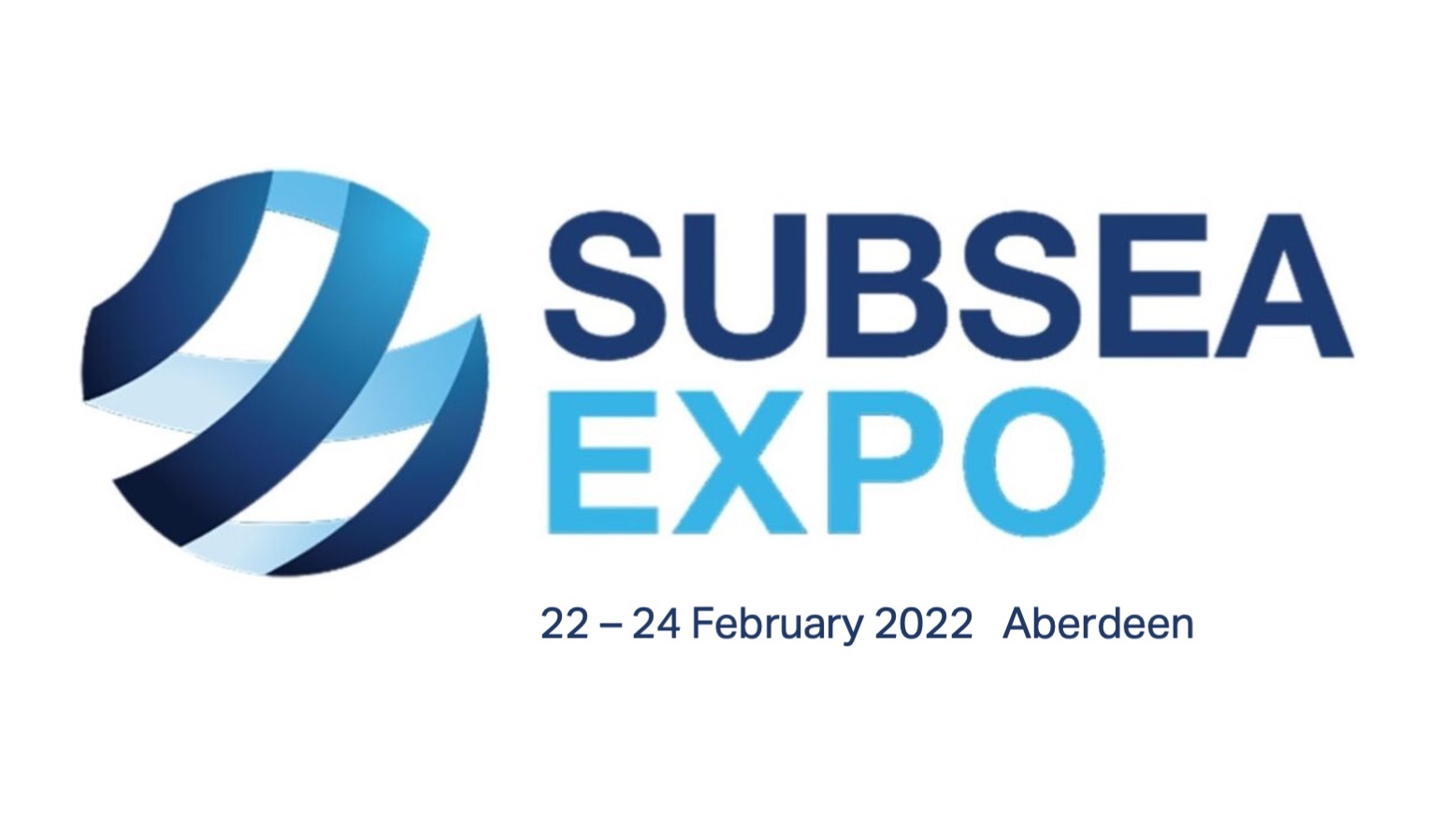
Saab Seaeye is world leader in electric underwater robotics.
For more information contact:
Matt Bates
Saab Seaeye Ltd
+44 (0)1489 898000
Email Matt Bates
9 February 2022
SABERTOOTH HUNTS SHACKLETON’S ENDURANCE
Two Saab Sabertooth robots will go under the Antarctic ice in the hunt for the wreck of the Endurance, sunk during Shackleton’s ill-fated expedition in 1915.
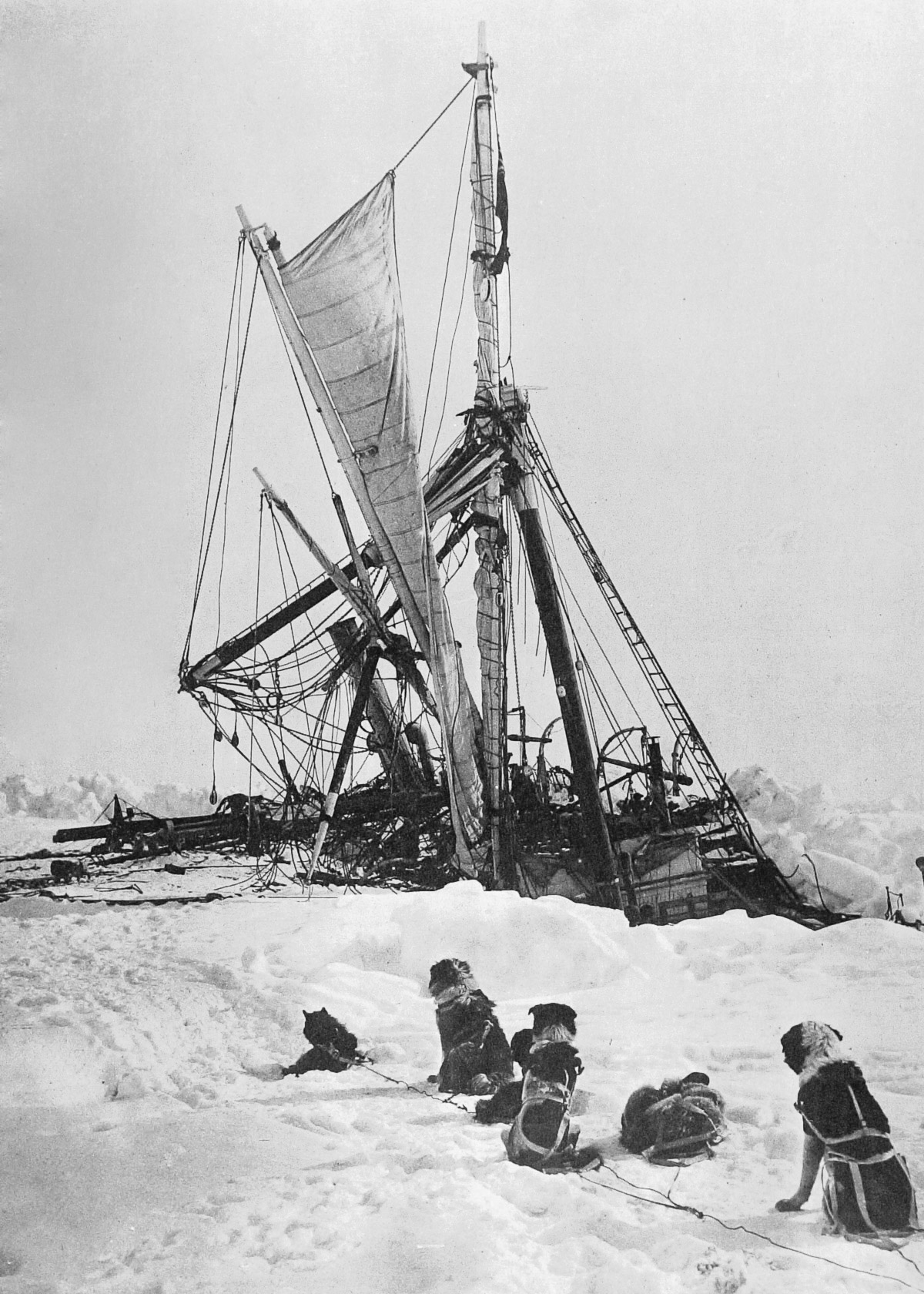
Endurance, crushed by ice before sinking.
Lowered by helicopter, the Sabertooths will be sent through a prepared hole cut in the ice to embark on a 160km search mission to find, survey and film the wreck, believed to be 3000m (nearly two miles) underwater, its precise location unknown.
Both Sabertooths are currently aboard an icebreaker with the research teams, heading for Antarctica.
The multi-role, 3000m rated, Saab Sabertooth is the world’s only roaming and hovering robot that can operate in both fully autonomous and tethered modes, enabling fully flexible dual operations from a single platform fitted with cameras, sonars and tooling.
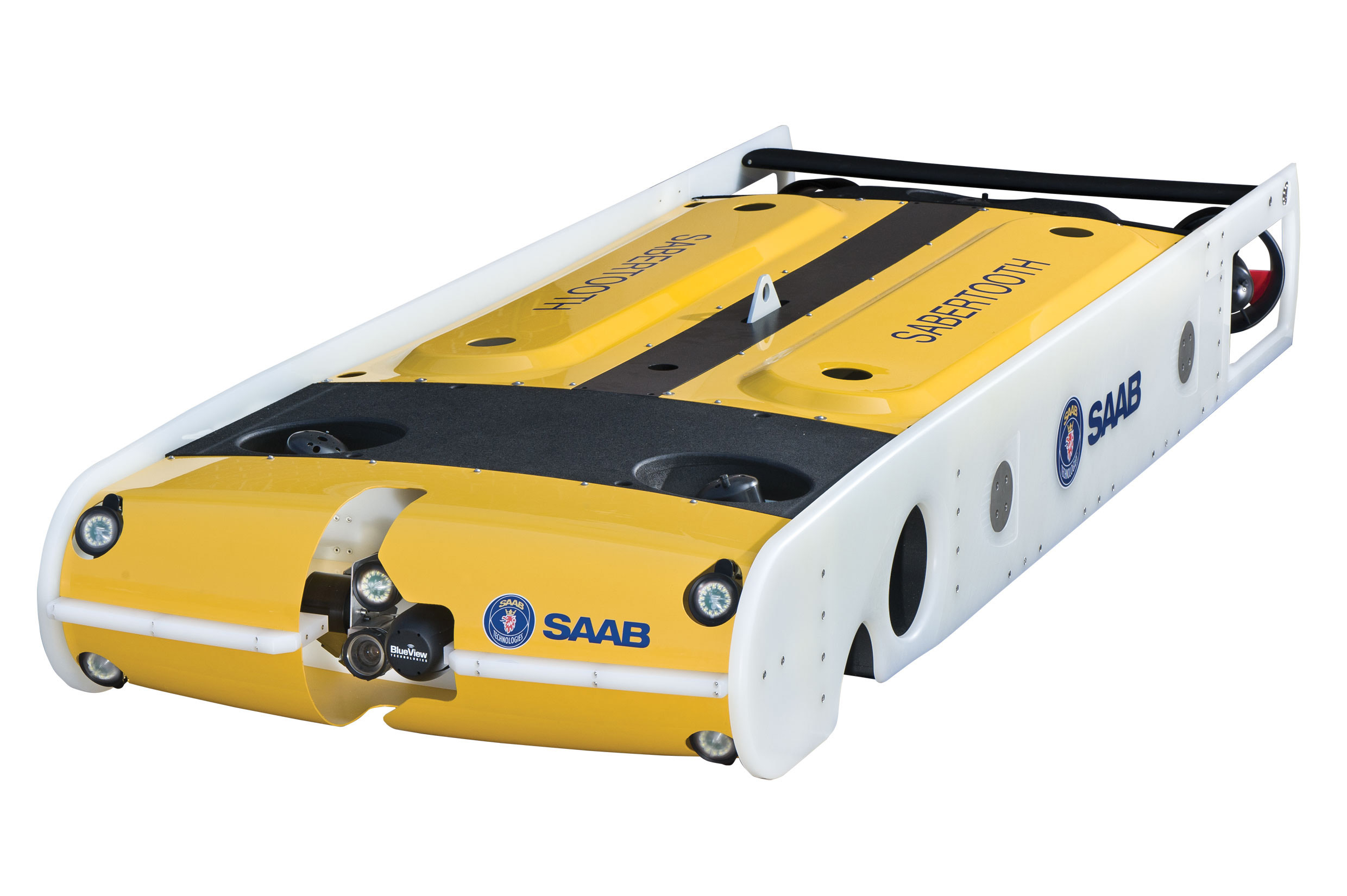
The Sabertooth is the world’s only hovering and roaming multi-role vehicle.
For more information contact:
Peter Erkers
Saab
+46 734 185540
Email Peter Erkers
www.saab.com
19 January 2022
ANOTHER TIGER GOES NUCLEAR
Built to survive in nuclear storage ponds, a sixth Saab Seaeye Tiger-N robot has been ordered for the Sellafield nuclear site.
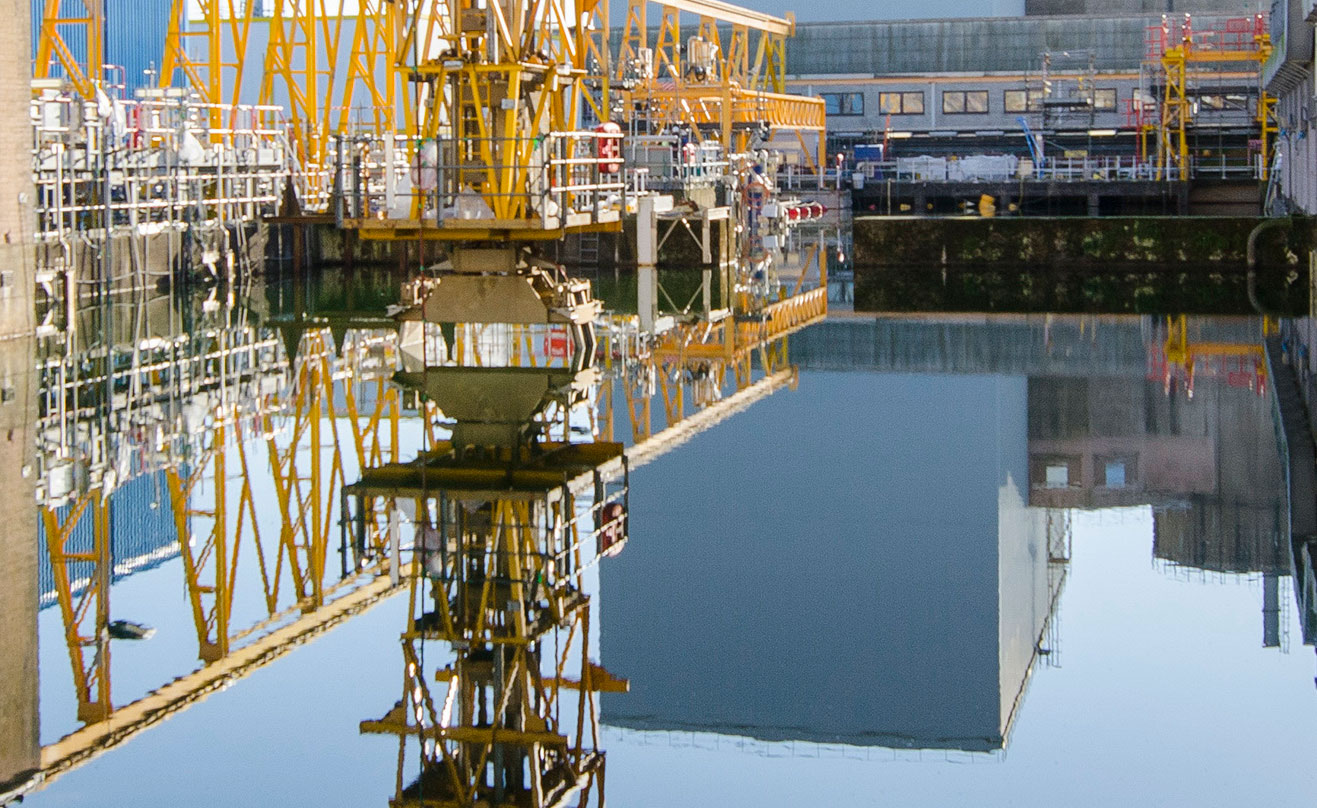
Sellafield nuclear waste ponds — a sixth Seaeye Tiger-N joins a fleet of nuclear-environment enabled Seaeye Tiger-Ns, deployed to remove radioactive material to long-term storage.
The sixth Seaeye Tiger-N joins a fleet of nuclear-environment enabled Seaeye Tiger-Ns, deployed to gather and sort, metre-long, 15kg radioactive fuel bars, for removal to long-term storage, among other roles.
Specially adapted by Seaeye and Sellafield engineers for work in one of the most highly corrosive environments on the planet, the proven Saab Seaeye Tiger design was chosen for its reliability in demanding conditions.
Such reliability is vital as it limits intervention by operators for maintenance purposes, thereby considerably reducing their exposure to the hazardous environment.
The new Tiger-N replaces the Tiger-N used for training and as an operational spare, which will be redeployed to the Pile Fuel Storage Pond for cobalt cutting operations, a key operational priority for the Tiger-N robots.
The robust Seaeye Tiger design has a 20-year record of working in challenging conditions around the world and has the thruster power and ability to manoeuvre in tight spaces with agility and precision.

Saab Seaeye’s nuclear-environment enabled Tiger-N with one of the seven skid tooling options needed to gather and sort radioactive nuclear fuel rods.
Saab Seaeye is world leader in electric underwater robotics.
For more information contact:
Matt Bates
Saab Seaeye Limited
+44 (0)1489 898000
Email Matt Bates
www.saabseaeye.com
Ruth Hutchison
Sellafield Ltd
+44 (0)1946 786227
Email Ruth Hutchison
6 December 2021
FIRST DECOMMISSIONING UNDERWAY IN AFRICA
Angola sees Africa’s first offshore oil platform decommissioning underway as EQS (Environment Quality Services) successfully deploys their Saab Seaeye Falcon for determining safer upcoming decommissioning operations.

Falcon deployed by environmental services company to assess Africa’s first offshore decommissioning project.
Dubai-based EQS assess the integrity of offshore structures using their Falcon for visual inspection and image gathering.
The range of offshore structures inspected to assess integrity includes platform (jacket), wellhead, protection dome, pipelines and umbilical.
EQS help offshore energy clients navigate the complex environmental regulatory landscape to achieve regulatory compliance, protecting employee health and safety, and managing business liabilities.
“The Falcon supports EQS in their aim to fulfil specific works in a safe and cost-effective manner by delivering accurate and relevant information,” says Carlos Rodrigues (CTO) of EQS.
He sees the Falcon as an ideal resource for their specialist work as it can handle an array of cameras, sensors, tooling and complex data gathering systems that can easily be added or changed thanks to the Falcon’s iCON™ intelligent module-focused distributed control architecture.
The world’s top selling robot of its class, the Falcon’s 20-year success comes from being a portable, metre-sized, intelligent, powerful, five-thruster, highly maneuverable, multi-tasking, easy to use vehicle, depth rated range to 1000 metres.
With a reliability record covering over a million hours underwater, including deep tunnel work, the Falcon can remain stable in turbulent waters and strong currents whilst undertaking both robust and precision tasks.
For EQS the Falcon supports their wide range of complex and routine environmental projects where solutions are created by combining the right people with the right technologies to meet each project’s unique challenges.
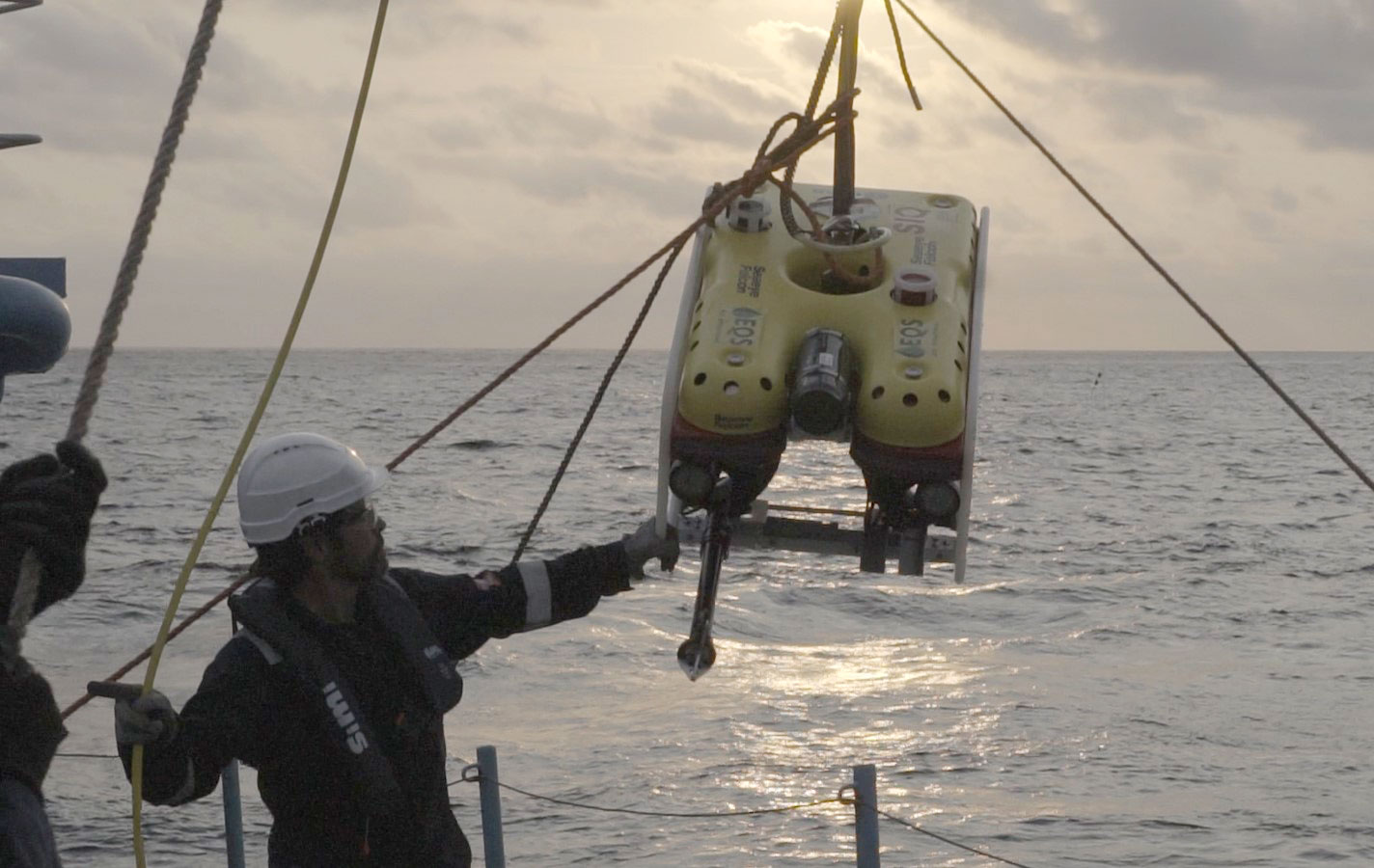
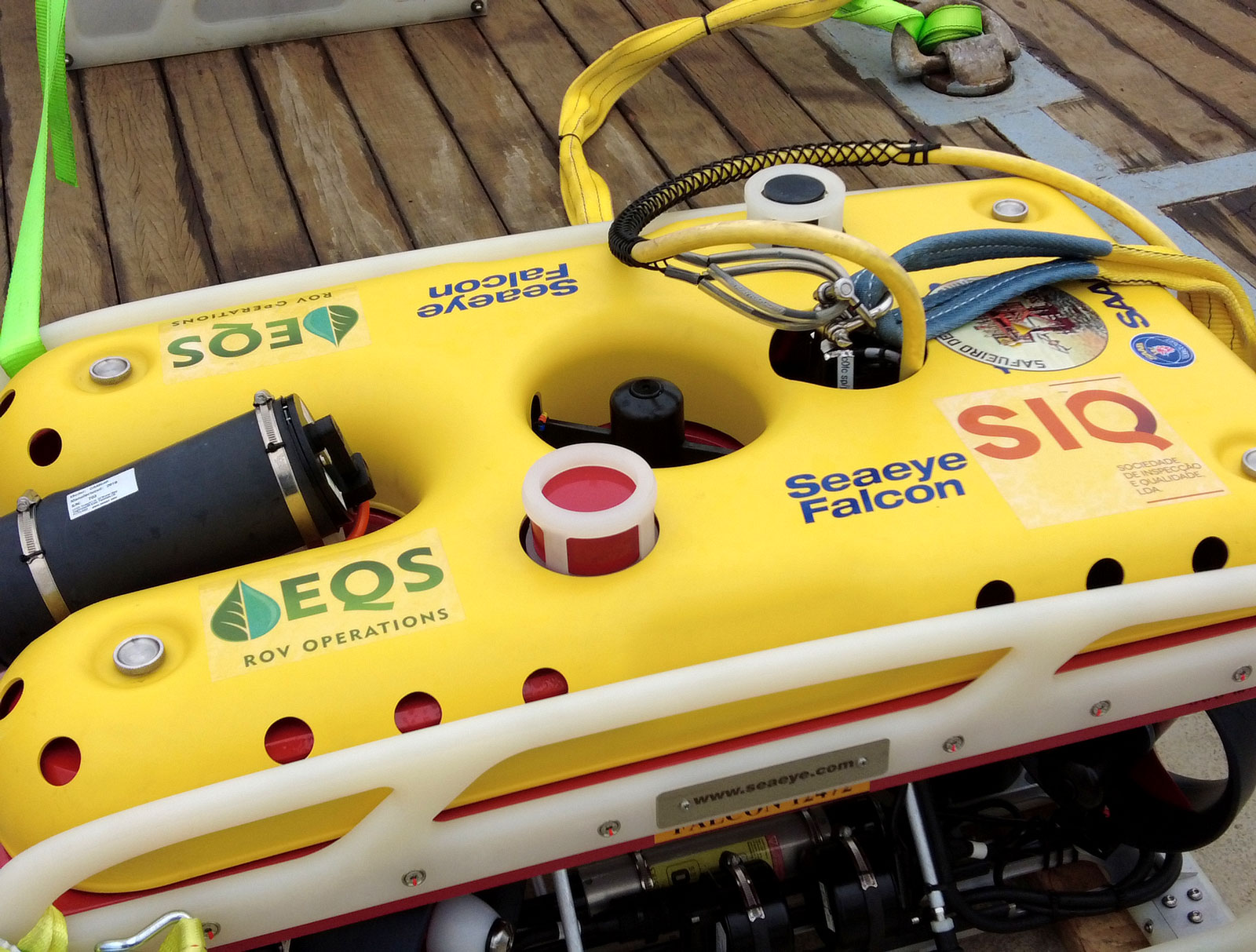
Saab Seaeye is world leader in electric underwater robotics.
EQS provides cost-effective solutions to complex and routine environmental projects.
For more information contact:
Matt Bates
Saab Seaeye Limited
+44 (0)1489 898000
Email Matt Bates
www.saabseaeye.com
Carlos Rodrigues
EQS
+351 934 422 810
Email Carlos Rodriques
www.eqs-fze.com
15 November 2021
SAAB SEAEYE’S NEW UNDERWATER ROBOT TO JOIN OCEAN INFINITY’S ARMADA
A contract has been signed with launch customer Ocean Infinity for 10 of the latest Saab Seaeye underwater robots, supporting new jobs and site expansion.
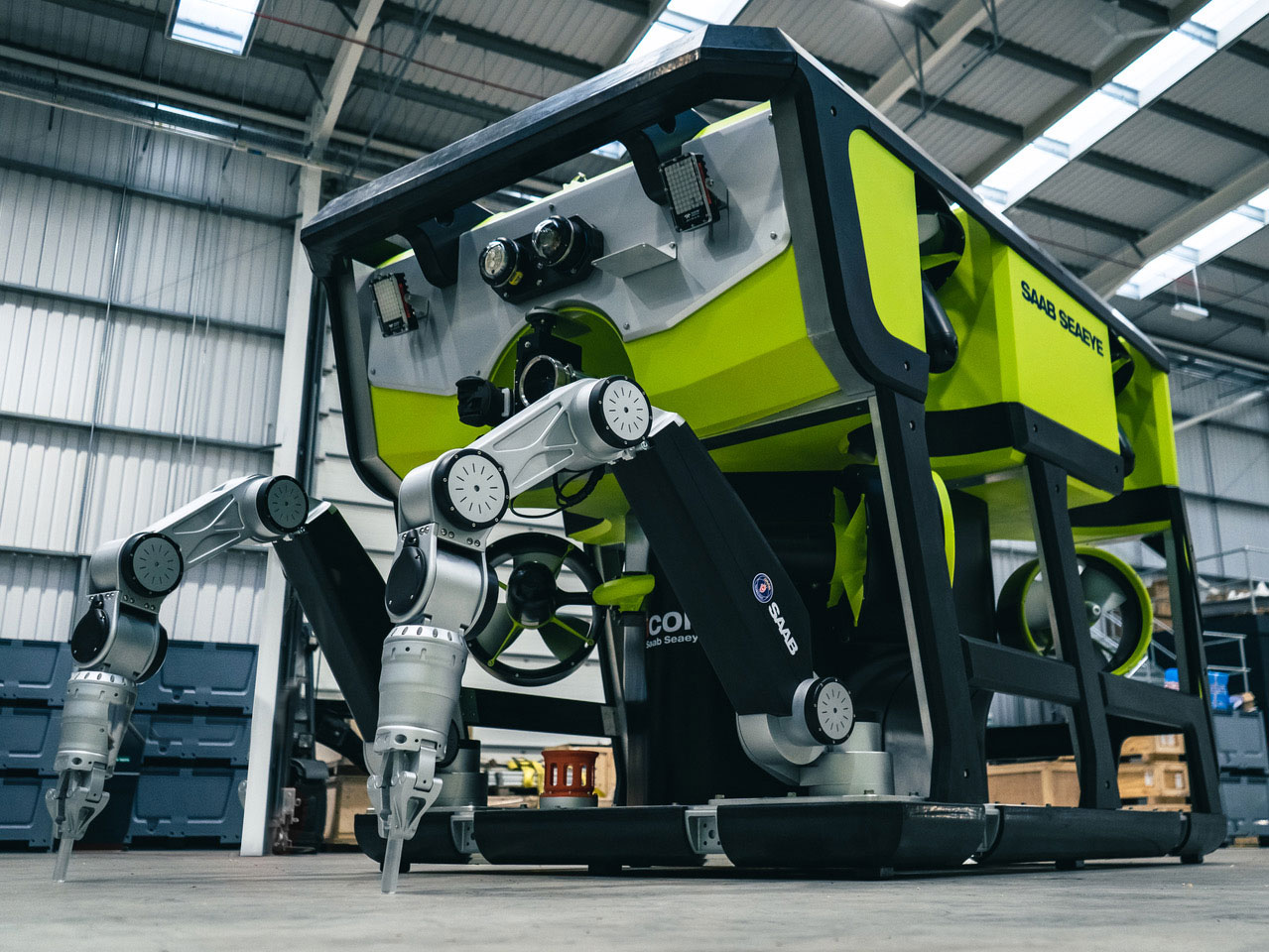
Saab Seaeye’s new eWROV is the world’s most capable and intelligent all-electric, work-class underwater robot.
Saab Seaeye, a world leader in underwater robotics, has agreed a deal to sell 10 of its new electric work remotely operated vehicles (eWROV), including further options, to leading marine robotics company, Ocean Infinity.
Due to this and further future contracts Saab Seaeye is also to expand by 70% to an additional 3,236m2 (34,832 ft2) site in Fareham, UK, by March 2022 and is currently recruiting.
The new eWROV product, is the world’s most capable and intelligent all-electric, work-class underwater robot, that will be built in Saab Seaeye’s new facility in Fareham within the Solent Freeport.
The eWROV is the latest addition to Saab Seaeye’s underwater portfolio used across a variety of offshore energy sectors, ocean science and defence. It is the culmination of four years of research and development, resulting in a larger and more powerful ROV compared to those designed for light work and observation tasks.
Saab Seaeye is among the first companies to produce a full-size electric work-class vehicle that can deliver the same overall performance as a 250 horsepower hydraulic vehicle, while offering a lower lifetime cost and reduced environmental impact.
Ocean Infinity is developing the world’s largest fleet of uncrewed robotic vessels and will be the eWROV’s launch customer. The eWROV will play its part in Ocean Infinity’s mission to use innovative technology to transform operations at sea, enabling people and the planet to thrive. Armada is set to revolutionise the maritime industry, delivering sustainable services that offer up to 90% emissions savings over a conventional vessel performing a similar offshore task.
The eWROV’s electrification is the key to its improved performance and sustainability-related attributes. As well as being more efficient, electric systems use little or no oil, making the eWROV significantly more environmentally friendly than equivalent hydraulic work-class systems.
Most important, eWROV benefits from Saab Seaeye’s iCON™ intelligent system architecture, making it capable of fully autonomous operation.
“Ocean Infinity’s order is the largest in Saab Seaeye’s history and highlights the need for intelligent, adaptable and flexible underwater robotics. The eWROV is more efficient and cleaner than the hydraulic alternatives and it also requires less human involvement and will play an important role in future autonomous vessel fleets. We are confident the eWROV will serve Ocean Infinity well,” says Magnus Lewis-Olsson, Chairman of Saab UK.
“Lessening the environmental impact of operations at sea is the main driver behind the development of Armada. The all-electric eWROV, in addition to our already low-emission vessels, will enable us to support our customers with infrastructure integrity projects in the most environmentally responsible way. The eWROVs will form an important part of our Armada architecture; through integration with our dynamic payload controller, we’ll be able to deploy and operate them anywhere in the world from our Remote Control Centres,” says Dan Hook, Chief Technology Officer, Ocean Infinity.
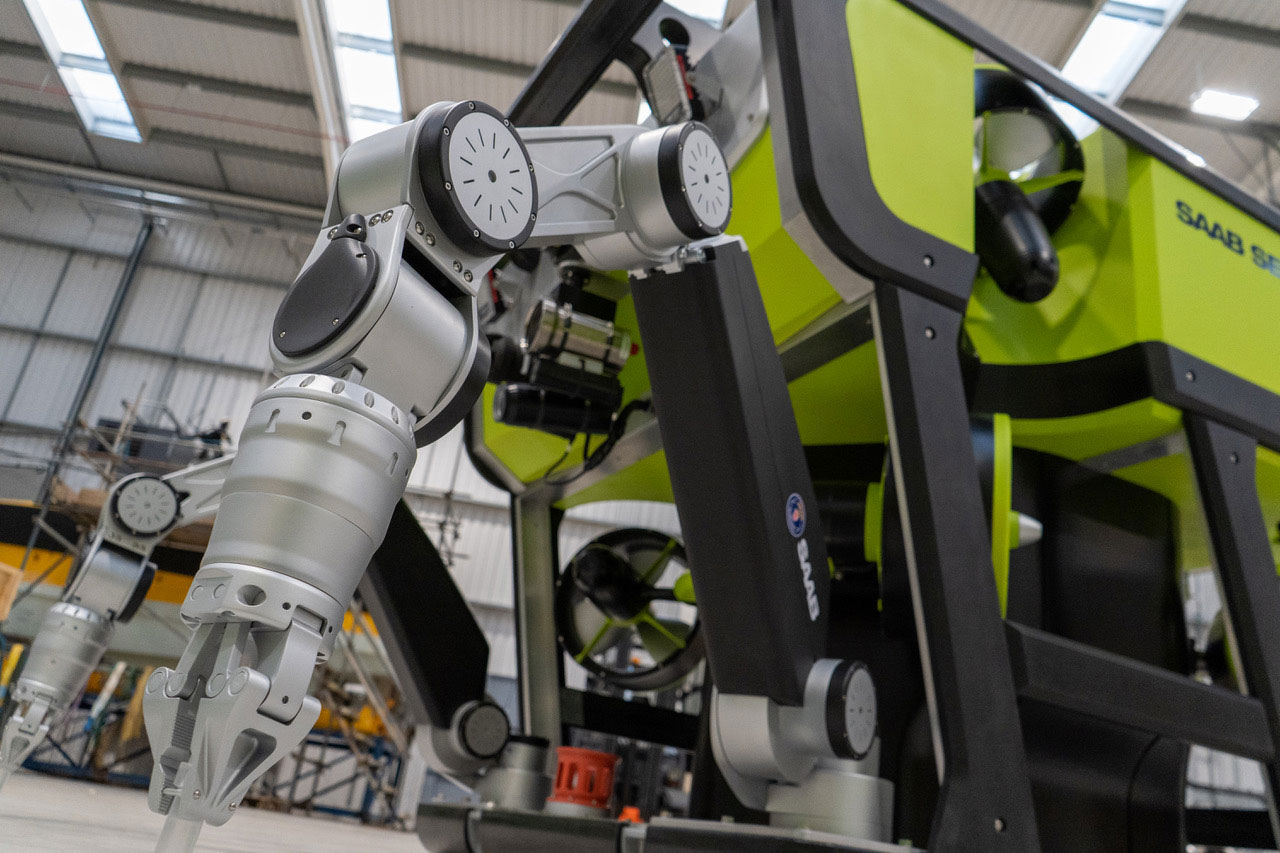
The new robot is fitted with Saab Seaeye’s all-electric seven-function high-precison manipulators.
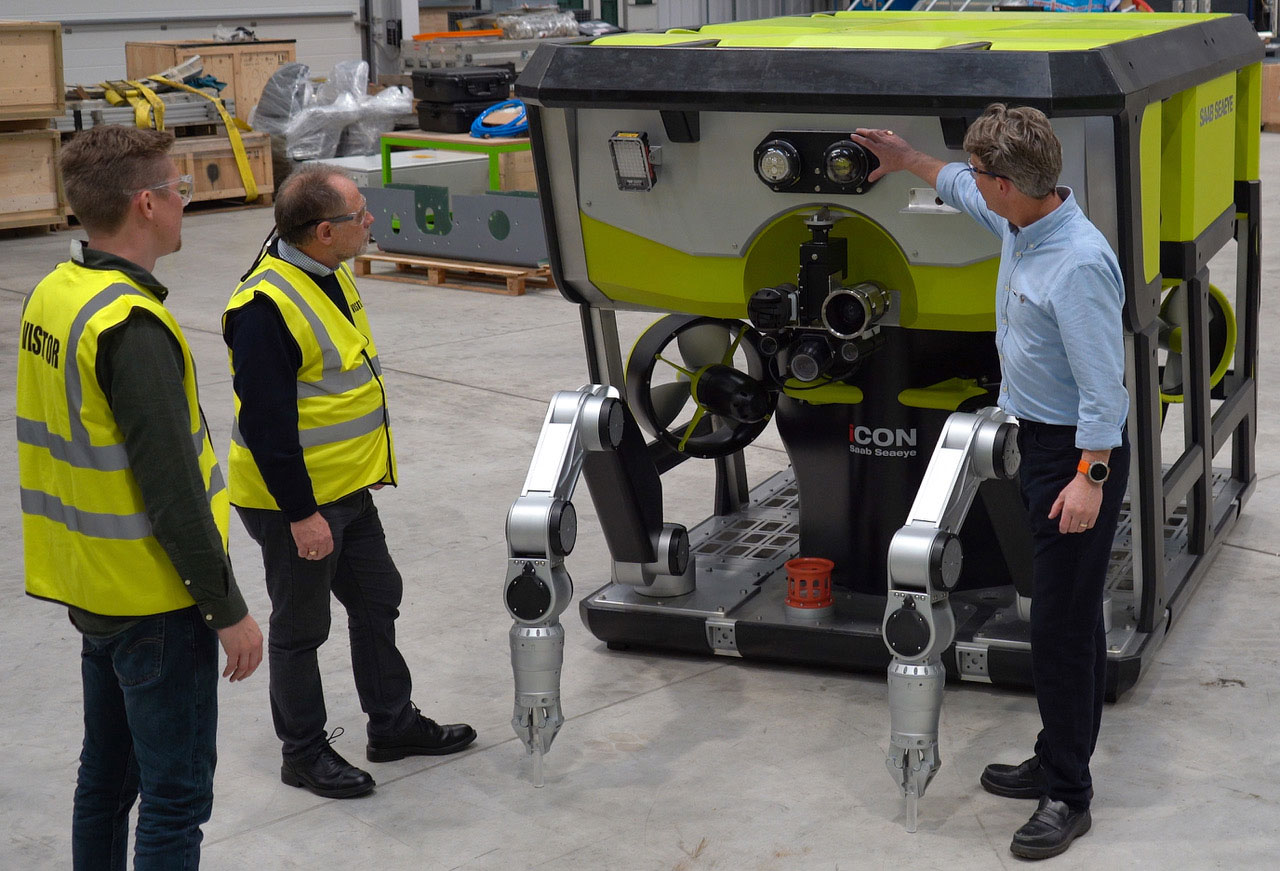
Jon Robertson, Managing Director Saab Seaeye, explaining features of the new electric work robot.
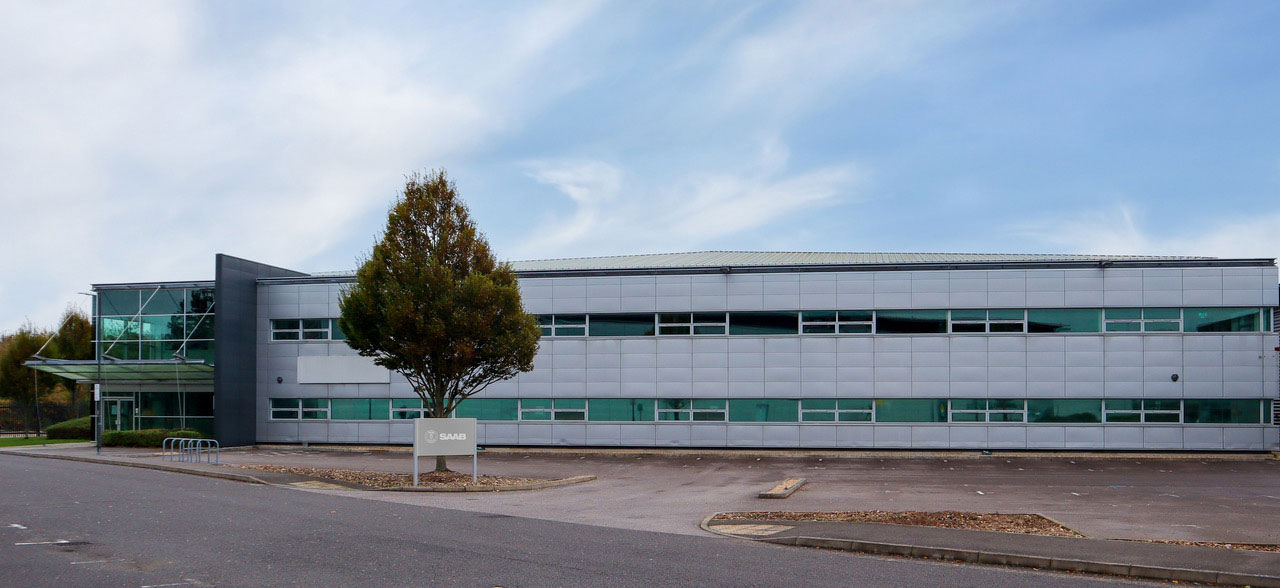
Saab Seaeye is expanding by 70% into an additional 3,236m2 (34,832 ft2) new facility.
For more information contact:
Nicolas Clark
Saab UK
+44 (0)7856 001 858
Email Nicolas Clark
www.saabseaeye.com
Mark Antelme
Ocean Infinity
+44 (0)20 8434 2643
Email Ocean Infinity
9 November 2021
HOUSTON UNIVERSITY’S FALCON IN PIPELINE LEAK SOLUTION
A breakthrough in leak risk detection at oil pipe flanges comes from research by the University of Houston using a Saab Seaeye Falcon robot as a development platform.
.jpg)
Called SmartTouch, the solution involves integrating innovative robotic manipulator controls into the Falcon that provide multiple stress wave sensors for touch-based inspection of bolted joints, along with the latest structural health monitoring and inspection technologies. Video cameras and scanning sonars are also integrated into the system.
Finding a time-efficient and cost-effective robotic solution to identifying flanges at risk was the University’s key objective as bolted flanges can loosen when ocean dynamics shift pipelines. The difficulty of locating flanges at risk makes their timely inspection key to the prevention of oil spills.
The research team led by Dr. Zheng Chen, assistant professor in Mechanical Engineering and director of bio-inspired robotics, together with Dr. Gangbing Song, professor in Mechanical Engineering, includes six PhD students.
“The testing results have demonstrated the reliability and performance of the Falcon in meeting the needs of the SmartTouch underwater pipeline inspection system,” says Dr Chen.
Totally automated inspection
For the University, the ease of systems integration comes from the Falcon’s iCON™ intelligent distributed control architecture. The module-focused iCON™ endows each device with its own microprocessor for individual control and offers a future-flexible concept that can readily adopt evolving technologies.
“The SmartTouch robotic system,” says Dr Chen, “can totally automate and dramatically reduce the cost and risk of subsea inspection, leading to safer operations of offshore oil and gas pipelines.”
Recording over a million hours of undersea operations, the Seaeye Falcon is the world’s top selling robot of its class. Its 20-year success comes from the creation of a portable, metre-sized, intelligent, powerful, five-thruster, highly manoeuvrable, multi-tasking, easy to use vehicle, depth rated to 1000 metres, that can hold steady in strong cross currents whilst packed with cameras, sensors and tools.

The team of professors and PhD students whose research created an innovative flange inspection system using a Seaeye Falcon as a development platform.
.jpg)


.jpg)
The most popular robot of its type in the world, the Seaeye Falcon can be fitted with a host of different cameras, sensors and tools — and stay steady in strong currents.
Saab Seaeye is world leader in electric underwater robotics.
For more information contact:
Matt Bates
Saab Seaeye Limited
+44 (0)1489 898000
Email Matt Bates
www.saabseaeye.com
Dr Zheng Chen
University of Houston
+1 713 743 6427
Email Dr Zheng Chen
www.me.uh.edu
www.uh.edu
14 October 2021
FALCON ACROSS TURKEY
Turkey’s marine operations company, ARAS Marine, has chosen for its expansive operations the deep-rated Saab Seaeye Falcon as a key underwater robotics resource.
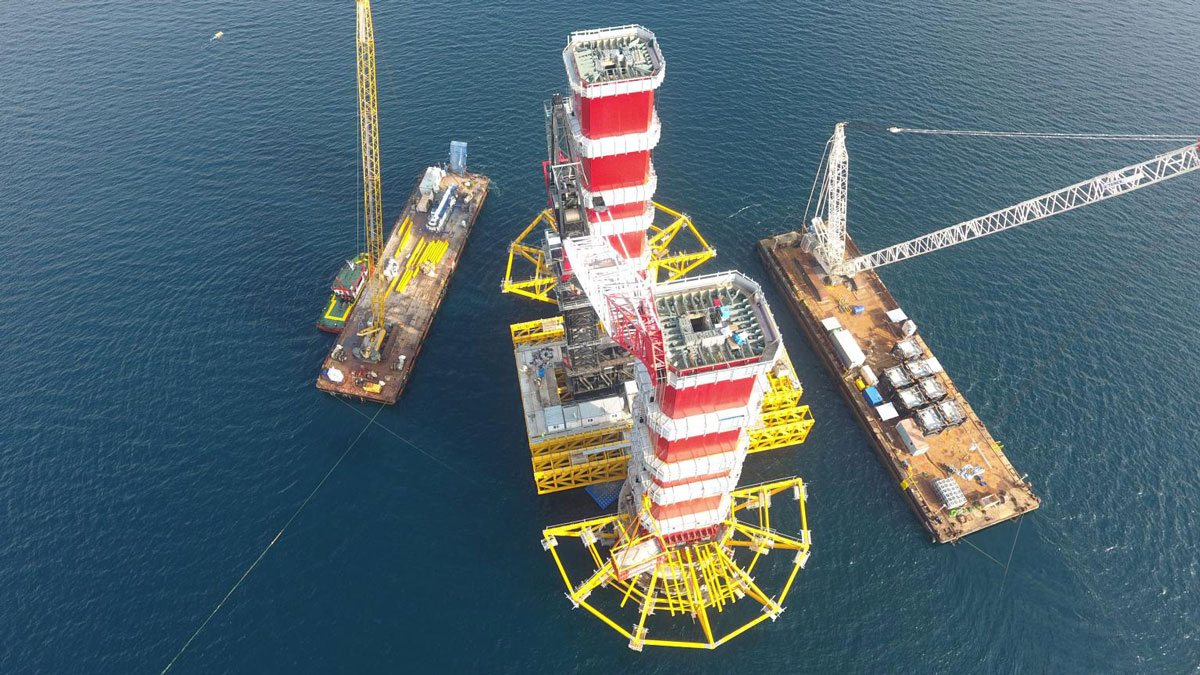
The versatility of the Falcon will support the wide range of projects undertaken by ARAS in both International and Turkish territorial waters.
These projects range from marine construction and offshore supply services, to seismic research support, emergency response and salvage and wreck removal.
Equipped for the wide array of tasks ahead, ARAS’s 1000m depth-rated Falcon comes complete with a fibre optic upgrade, manipulator, soft rope cutter, cameras, Tritech sonar and Applied Acoustics’ USBL system.
ARAS can add further systems any time as the Falcon can handle an array of cameras, sensors, tooling and complex systems typically found on much larger robotic vehicles.
The ease of adding systems comes from the Falcon’s iCON™ intelligent distributed control architecture. Module-focused iCON™ endows each device with its own microprocessor for individual control — a concept that also makes it future-flexible for evolving technologies.
As the world’s top selling robot of its class, the Falcon’s 20-year success comes from being a portable, metre-sized, intelligent, powerful, five-thruster, highly manoeuvrable, multi-tasking, easy to use vehicle, depth rated to 1000 metres.
With a reliability record covering over a million hours underwater, including deep tunnel work, the Falcon can remain stable in turbulent waters and strong currents whilst undertaking both robust and precision tasks.
ARAS see the Falcon as an ideally adaptable resource for their expanding future.
The contract was negotiated through Saab Seaeye’s Turkish distributor, Aspiro.
.jpg)
Falcon — the world’s top selling robotic vehicle can be equipped with a wide range of tools, cameras and sensors.
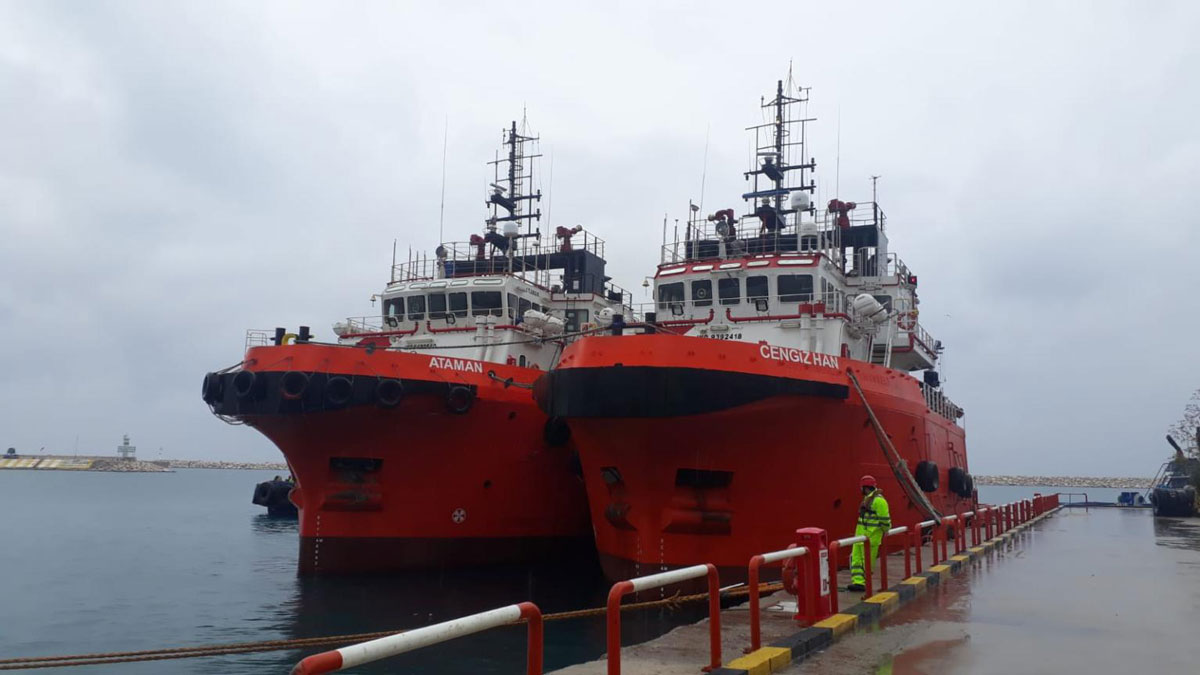
ARAS has a wide array of resources for an extensive range of projects.
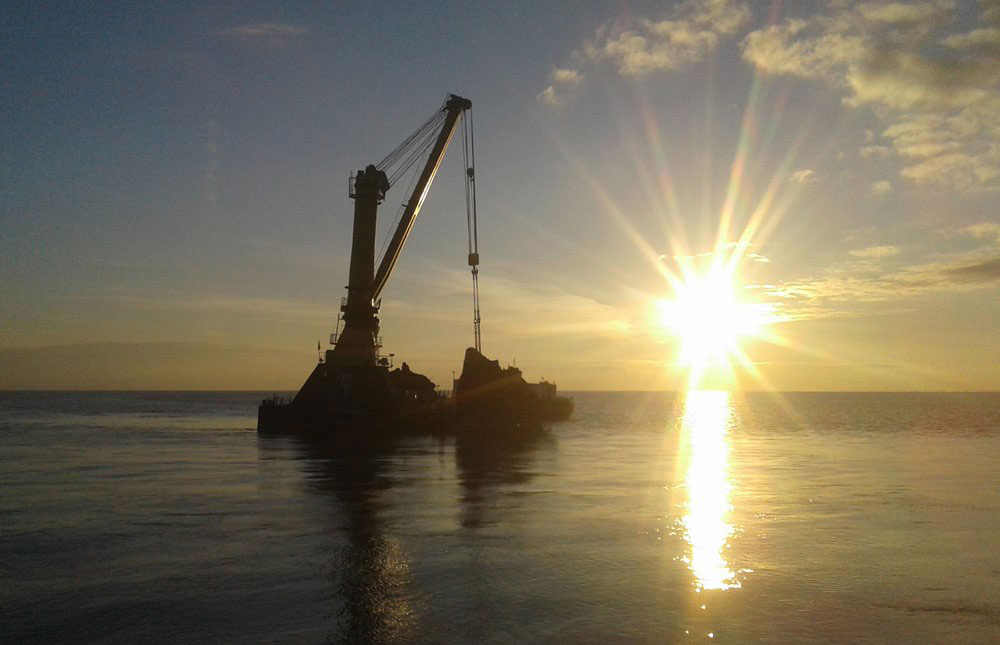
Saab Seaeye is world leader in electric underwater robotics.
ARAS, founded in 1995, serves marine construction, salvage and emergency response services, shipbuilding, towage operations, R&D and advanced engineering.
For more information contact:
Matt Bates
Saab Seaeye Limited
+44 (0)1489 898000
Email Matt Bates
www.saabseaeye.com
Naci Hoşcan
Aras Marine
+90 216 446 53 09
Email Naci Hoşcan
www.arasshipping.com
28 September 2021
‘TOUGH AND RELIABLE’ FALCON FOR GEO OCEANS
Further expanding their robotic vehicle fleet, Geo Oceans has chosen the Saab Seaeye Falcon for its “reliable and hard wearing” reputation.
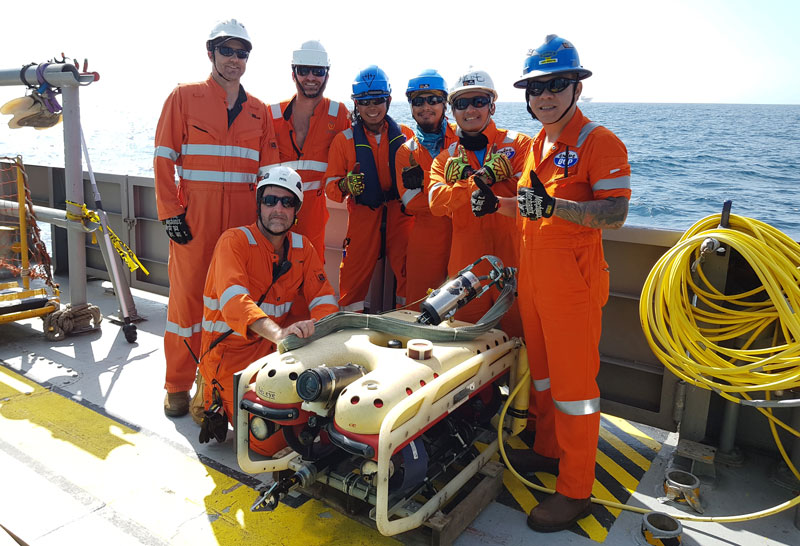
Falcon: ‘Tough and reliable’ vote Geo Oceans
“It can take a hammering and its tethers are very strong,” says Geo Oceans.
As a global underwater services company, Geo Oceans is committed to adding industry-leading robotic vehicles to their fleet for deployment over a wide range of tasks.
Such tasks include non-destructive testing, high-definition visual inspection, 3D modelling and photogrammetry, high pressure water blasting and numerous maintenance undertakings.
1000 Dives
Earlier experience with a loaned Falcon proved its worth, says Geo Oceans. The Falcon completed 1000 dives during a challenging seismic survey project in Southeast Asia, with zero incidents and no loss of productivity.
As the world’s top-selling robotic vehicle in its class, performing thousands of hours of undersea operations, the Falcon gives Geo Oceans the versatility, power and control intelligence to perform the vast array of tasks needed.
At the heart of the Falcon’s success is Saab Seaeye’s iCON™ future-flexible intelligent control architecture, a concept that pioneered distributed control technology.
Together with five powerful thrusters, the metre sized, 1000m rated Falcon, makes it a highly maneuverable, multi-tasking vehicle, that can be packed with cameras, sensors and tools, while holding steady in strong cross currents.
“We are impressed by how easy and intuitive the Falcon is to operate and how consistently it performs,” says Geo Oceans, adding, “It’s also easy to work on — with parts readily available and good support.”
Geo Oceans looks to bring innovative solutions to the subsea and environmental markets with the aim of reducing cost and time whilst increasing safety efficiency.
Supporting the sale was Saab Seaeye distributor, BlueZone.
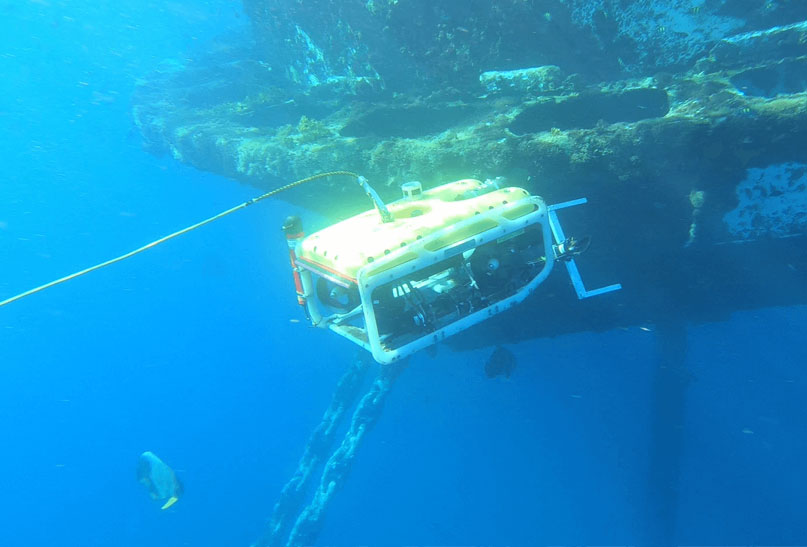
Falcon, set to undertake a wide variety of tasks
Saab Seaeye is world leader in electric underwater robotics.
Geo Oceans, part of the Vertech Group, is an industry-leading asset deployed mini-ROV technology and services company.
BlueZone Group, a Saab Seaeye distributor, brings together companies in a way that common understanding of technology can be shared with customers in varied markets.
For more information contact:
Matt Bates
Saab Seaeye Limited
+44 (0)1489 898000
Email Matt Bates
www.saabseaeye.com
Ben Brayford
Geo Oceans
+61 (8) 6168 7611
Email Ben Brayford
www.geooceans.com.au
31 August 2021
Saab Awarded Contract to Expand Capabilities of A26 Blekinge-class Submarines
Saab Awarded Contract To Expand Capabilities Of A26 Blekinge-Class Submarines
Saab has today received a further order from the Swedish Defence Material Administration (FMV) to continue the development and production, as well as expand the capabilities, of the two A26 Blekinge class submarines previously ordered by Sweden.
The order value is SEK 5.2 billion and the delivery of the two submarines will take place in 2027 and 2028.
“Saab is currently constructing the world’s most advanced conventional submarine. The new capabilities that are to be added to the A26 will give an additional edge within the weapon system and stealth technology among other things. With support from Saab’s skilled employees and investments, the important industrial submarine capability in Sweden has been restored,” says Micael Johansson, Saab’s President and CEO.
In June 2015, Sweden ordered the new A26 Blekinge class submarine, which is tailor-made for Swedish conditions. The capability to construct and build submarines places Sweden among the few countries in the world with the ability to develop advanced submarines. The Swedish submarine capability is among the most cost-efficient and modern in the market.
About A26/Blekinge-class submarines
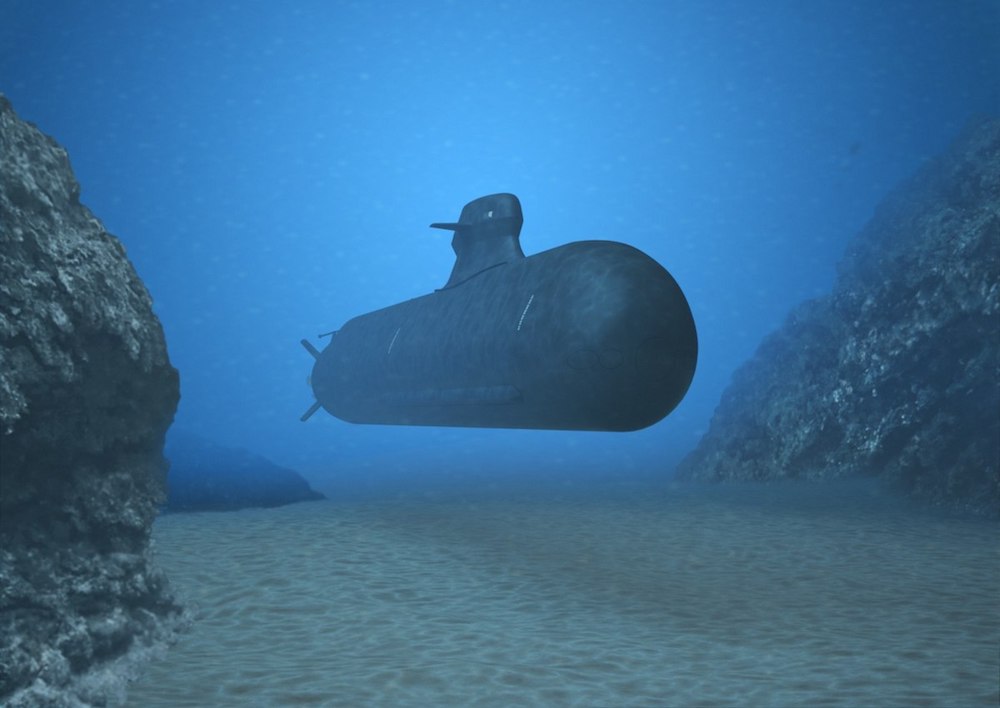
The A26 program was finally launched in 2015 after FMV (Swedish Defence Materiel Administration) placed an order for two new generation submarines for the Royal Swedish Navy. Based on the plans initially laid out under Kockums supervision, Saab’s engineers in Malmö and Karlskrona worked intensively on the boat’s design.
The Blekinge-class is a 65m long modern submarine with a surfaced displacement of 2,000 tonnes. Equipped with a Stirling AIP, it can dive for more than 18 days. Its standard complement consists in 26 sailors. The class can accommodate up to 35 sailors (commandos and passenger included).
For Saab, the Blekinge-class can be seen as the baseline A26, and is proposed in the international market as the A26 Oceanic. Slightly larger than the previous Gotland-class, the Blekinge will be able to navigate and fight in both coastal and blue waters. For navies with a focus on littoral operations, Saab proposes the A26 Pelagic, a smaller variant with a length of 50m and a surfaced displacement of 1,000 tonnes, which still features an AIP module. The A26 Oceanic Extended Range, on the other hand, is a stretched version of the Blekinge-class with a 3,000 tonnes displacement and capable to carry up to 50 persons.
23 July 2021
FALCON FOR FRENCH DAM AND BRIDGE INSPECTION
French dams and bridges inspection specialist, IDCBTP, has chosen a Saab Seaeye Falcon for detailed infrastructure examination.

Falcon inspecting bridge supports at Lake Vouglans
“We chose the Saab Seaeye Falcon because it’s a reliable system that’s simple to use and to upgrade,” says Clément Chaudouet of IDCBTP.
“It’s also a stable system, which is very important to us as we need perfect control of the ROV during a dam inspection.”
He adds that Saab Seaeye’s position as leader in the world of underwater robotics was important in their decision to choose the Falcon — and that the company “has a great support team.”
For a clear and accurate analysis of the condition of the structures, IDCBTP’s Falcon is fitted with a range of systems including lasers, multibeam sonar, profiler sonar and navigation and positioning systems.
Precision data collected in this way can identify repairs needed, help maintenance planning and spot trends in structure condition.
Two structures under inspection are the bridge supports for the Pont de la Pyle at Lake Vouglans and the upstream face of the dam structure of the Barrage de Thurins at Rhône.
The world’s top selling vehicle of its class for over 20 years, the Falcon’s success comes from being a small, metre-sized, intelligent, powerful, five-thruster-strong, highly manoeuvrable, multi-tasking and easy to use vehicle, depth rated to 1000 metres.
Enhanced with Saab Seaeye’s revolutionary iCON™ intelligent control system, the Falcon is a future-flexible package designed to adopt evolving technologies.
With a reliability record covering thousands of hours of operations globally, working in the most challenging environments, including long tunnel excursions, it can remain stable in turbulent waters and strong currents whilst recording and undertaking delicate tasks.
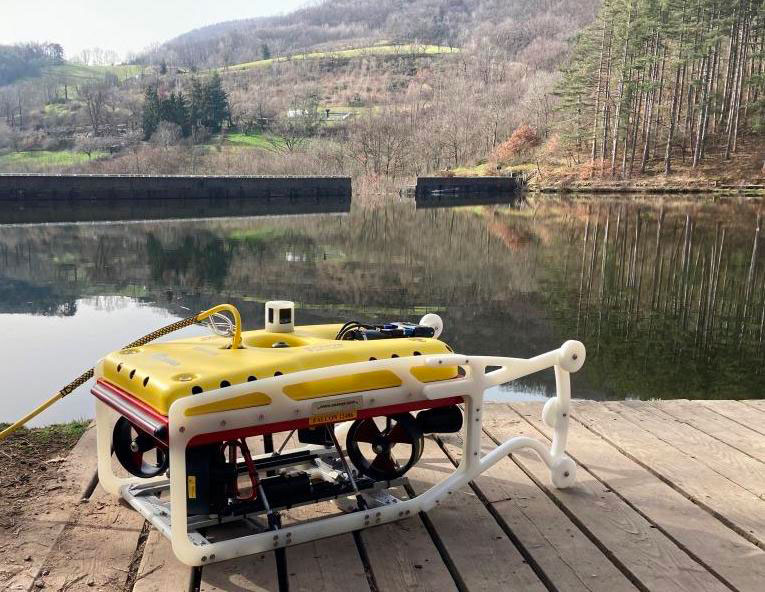
Falcon inspecting the dam structure at Barrage de Thurins
Saab Seaeye is world leader in electric underwater robotics.
IDCBTP specialises in the inspection of submerged structurers with extensive experience in concrete technology and civil engineering.
For more information contact:
Matt Bates
Saab Seaeye Limited
+44 (0)1489 898000
Email Matt Bates
www.saabseaeye.com
Clément Chaudouet
IDCBTP
+33 (0) 607 756 322
Email Clément Chaudouet
www.idcbtp.com
17 June 2021
FALCON EYES BRAZILIAN PIPELINES
Brazilian offshore IRM operator, SISTAC, has added another Falcon to their fleet of Saab Seaeye underwater robotic vehicles.
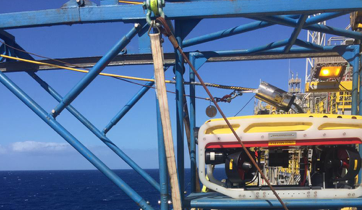
On-line fibre optic video surveillance of the ‘Pull in – Pull out’ pipeline connection process by the Falcon’s HD camera is the vehicle’s initial contracted task.
Operators on board will monitor the process throughout the operation.
SISTAC Sistemas de Acesso already has Seaeye Tigers and Falcons in their fleet, and long experience working with Seaeye over many years means they like to keep their fleet standardised.
They say their choice of Saab Seaeye comes because the company has more than 20 years’ experience of robotic vehicle manufacturing and SISTAC find their vehicles “very reliable in terms of operational perspective”.
They also like that Seaeye has a strong support team with a high degree of technical knowledge of the equipment and new technologies in the underwater robotics market.
An upgrade is also being made to another of the Falcons already in their fleet with the same fibre-optics system as the new vehicle.
In choosing the Falcon, SISTAC is getting the world’s top-selling underwater vehicle in its class with a reliability record covering thousands of hours of undersea operations during its 20 years of proven success.
A handy metre-sized, multi-tasking, easy to use vehicle, the Falcon is depth rated to 300m, with five powerful thrusters and intelligent control.
Saab Seaeye’s revolutionary iCON™ future-flexible intelligent control system, has created a highly manoeuvrable vehicle that can handle strong currents whilst fully loaded with a wide range of cameras, sensors and tools.
SISTAC say that for their pipeline contract, the Falcon was the vehicle most able to meet their customer’s expectations.

Saab Seaeye is world leader in electric underwater robotics.
SISTAC is a leader in inspection, maintenance and repair in the offshore oil and gas industry in Brazil, through access to offshore support vessels, divers, climbers, riggers and ROVs.
For more information contact:
Matt Bates
Saab Seaeye Limited
+44 (0)1489 898000
Email Matt Bates
www.saabseaeye.com
Wagner Abreu
SISTAC – Sistemas de Acesso
+55 21 99943 9691
Email Wagner Abreu
www.sistac.com.br
9 June 2021
BLUEPRINT LAB PICKS FALCON FOR MANIPULATOR TESTING
Electric robotic manipulator creator, Blueprint Lab, has chosen the Saab Seaeye Falcon as their lead in-house development platform for being a reliable, proven, and easily deployable vehicle.
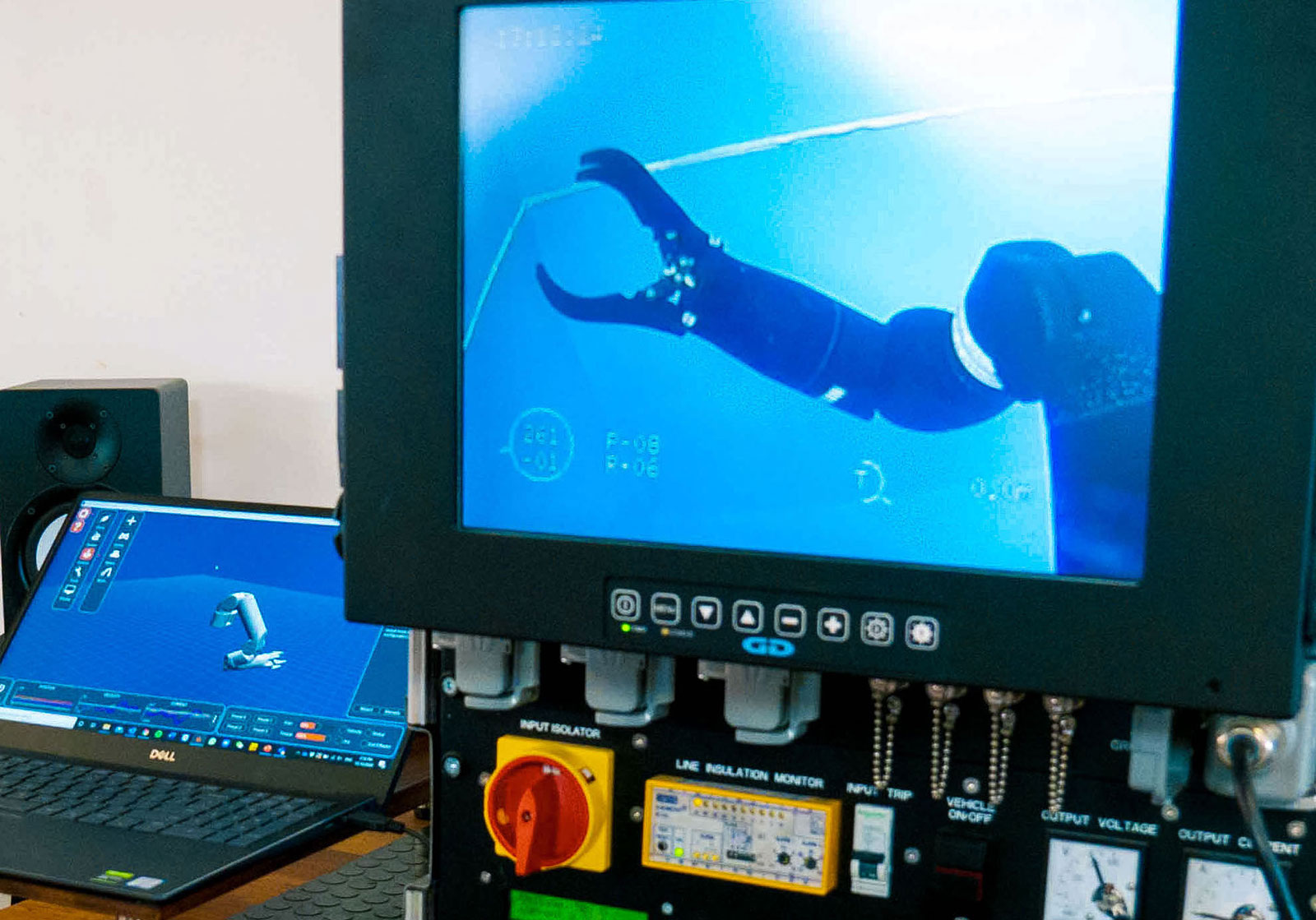
Blueprint Lab’s design concept means their all-electric manipulators can be easily integrated onto different manufacturer’s robotic vehicles, with the Falcon seen as a valuable resource for further manipulator testing in real-world scenarios.
Global interest comes as operators discover the dexterity of electric manipulator performance with its smooth, precise and controllable operation.
The modular technology design in Blueprint Lab’s manipulators, with a lift capacity exceeding 10kg, and over 1200N of grip force, allows multiple end-effector options to be fitted for a wide variety of applications.
The advancement of their integrated tooling technologies will be helped by utilising the Falcon’s iCON™ intelligent control system.
Blueprint Lab also say the Falcon’s compact size makes for easy deployment at test sites when trialling manipulator solutions to real-world problems.
“We’re excited to push the boundaries of what Falcon customers can do with their vehicle when fitted with our electric manipulators,” says Blueprint Lab’s Business Development Manager, Anders Ridley-Smith.
“Fitted with our Bravo manipulators and the Falcon Integration Kit, operators will have access to a new capability for use in visual and NDT inspection, construction and recovery operations, and other complex tasks,” he adds.
One key reason for choosing the Falcon is the match between the market sectors in which it is deployed and Blueprint Lab’s own markets, including defence, offshore energy and marine science.
With a reliability record covering over a million hours of undersea operations, the Falcon’s 20-year success comes from being a powerful, highly manoeuvrable, multi-tasking, easy to use, metre-sized vehicle, depth rated to 300 and 1000 metres and enhanced with Saab Seaeye’s revolutionary iCON™ future-flexible intelligent control system.
Blueprint Lab is supported in their development work by the Australian Government.
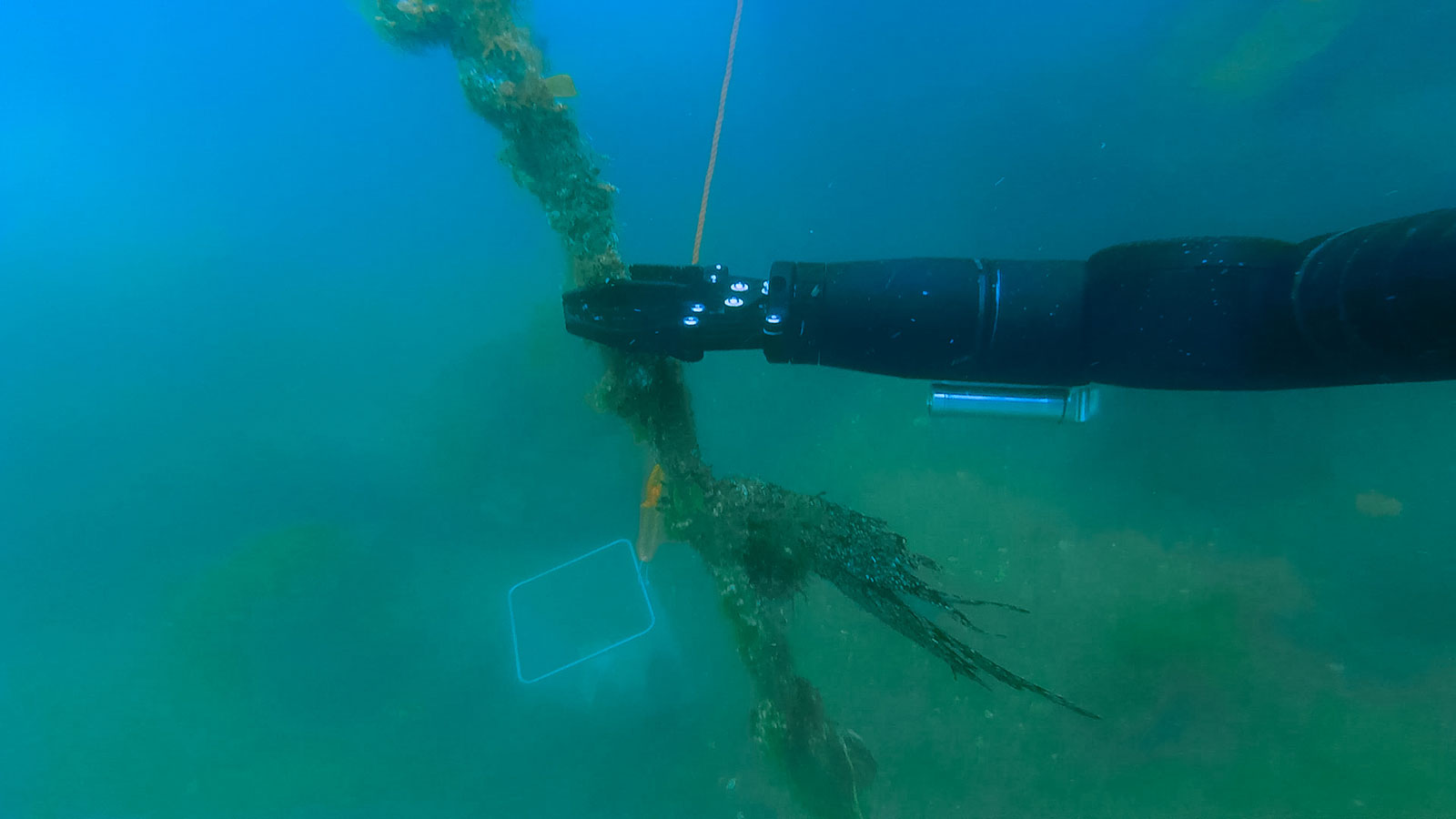

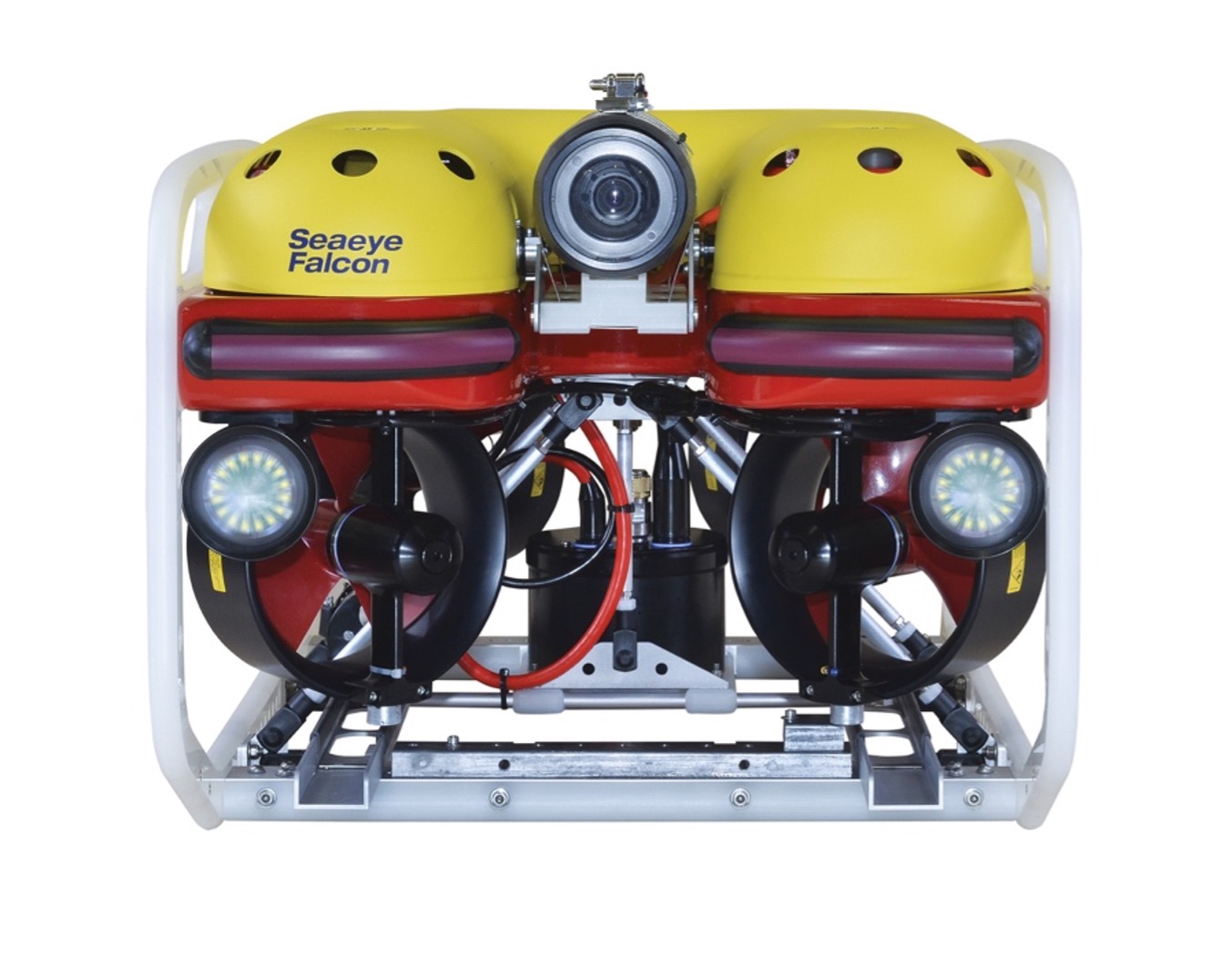
Saab Seaeye is world leader in electric underwater robotics — including ROV, AUV, hybrid systems and tooling — and creator of the revolutionary iCON™ ecosystem.
Blueprint Lab develops and manufactures compact, dexterous and tough subsea all-electric manipulators.
For more information contact:
Matt Bates
Saab Seaeye Limited
+44 (0)1489 898000
Email Matt Bates
www.saabseaeye.com
Anders Ridley-Smith
Blueprint Lab
+61 413 393 791
Email Anders Ridley-Smith
www.blueprintlab.com
20 April 2021
WATER POWERED SABERTOOTH CUTS CO2
Converted energy from waves powering a Saab Seaeye Sabertooth autonomous vehicle operating in seabed residency mode is a major renewable energy breakthrough.
Significant savings in support vessel costs and CO2 emissions will result.
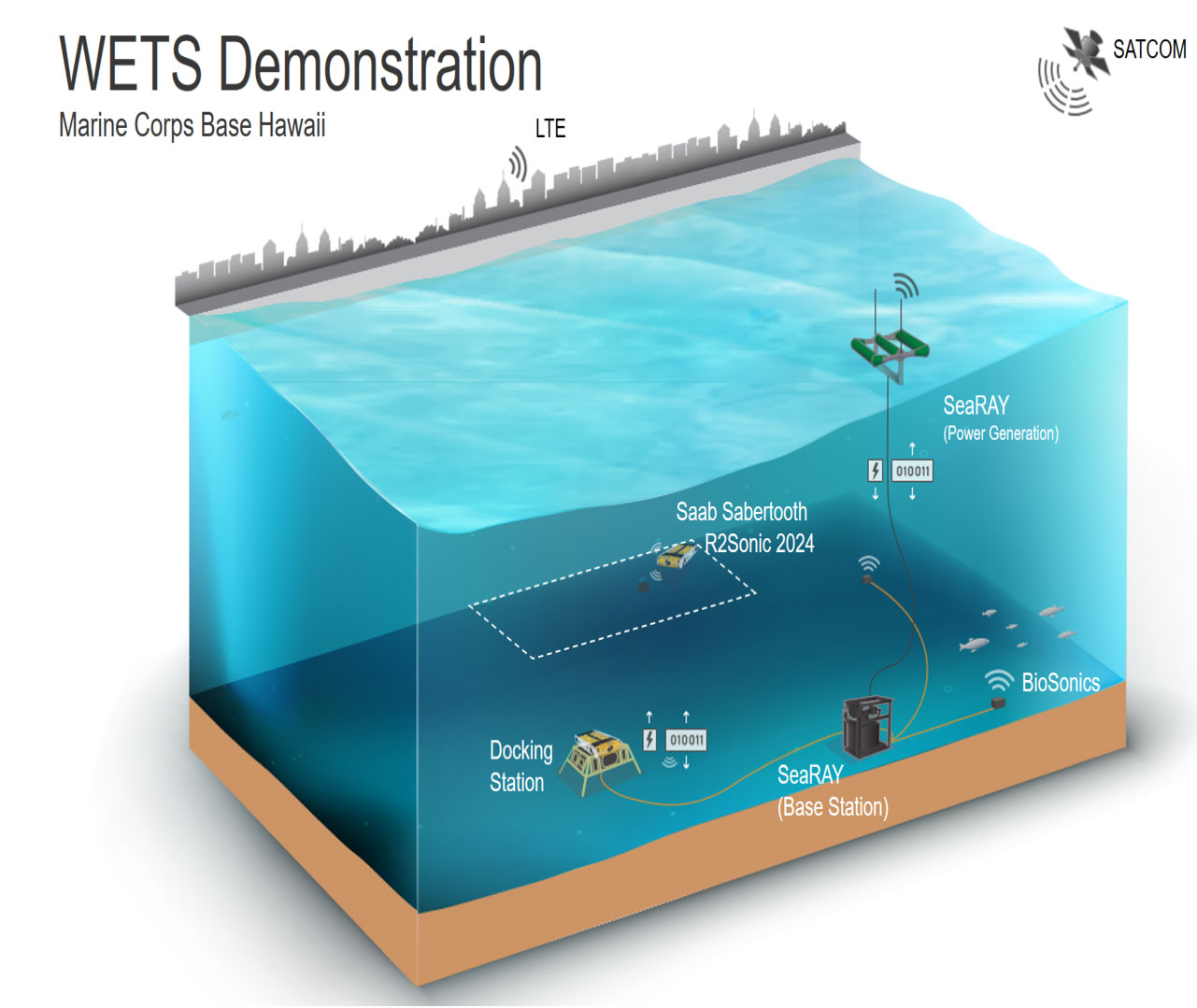
Hawaii Wave Energy Test Site (WETS).
Pioneering the concept is C-Power’s SeaRAY Autonomous Offshore Power System (AOPS), which provides offshore power, energy storage, and real-time data communications for resident marine systems.
Trials of the Sabertooth residency concept will take place at the U.S. Navy’s Wave Energy Test Site (WETS) in Hawaii and last 20 days. The SeaRAY AOPS and other static assets will remain deployed for six months.
The Sabertooth, owned by Hibbard Inshore, and operated on behalf of C-Power, will repeatedly patrol pre-programmed areas to collect data, before returning to an underwater docking station for cloud upload and battery recharge.
Included in the studies will be seabed analysis, fish densities, infrastructure monitoring and water-column data gathering.
Many sectors will benefit
Many underwater sectors are seen to benefit from this innovative emission-free concept, including marine science and research, defence and security, aquaculture, and offshore energy.
The trials come in partnership with the U.S. Department of Energy’s Water Power Technologies Office, together with the National Renewable Energy Laboratory and the U.S. Navy.
In particular, testing of the SeaRAY AOPS is included in the Navy’s Coastal Trident 2021 program, which is the largest port and maritime security undertaking in the nation.
For the Navy, the conventional difficulty in conducting underwater infrastructure surveys leaves critical infrastructure vulnerable to sabotage and intelligence gathering threats in this hidden environment. Frequently refreshed high-definition sensor data can alert remote operators to possible intruder activity.
Operating the Sabertooth will demonstrate that subsea residence enables a sustained presence to secure underwater port infrastructure and its ability to support efforts to protect shipping against underwater explosive devices.
For the trials, the Sabertooth will be equipped with an R2Sonic Sonic 2024 multibeam echosounder, 2G Robotics ULS-500 PRO Laser Scanner and camera, and the ASL AZFP 70,120 & 200 kHz Acoustic Zooplankton Fish Profiler.
Uniquely Hovering
The success of the multi-role, 3000m rated Saab Seaeye Sabertooth comes from it being the world’s only roaming and hovering system that can operate in both fully autonomous (AUV) and tethered (ROV) modes, enabling fully flexible dual operations from a single platform.
Hibbard will deploy the Sabertooth for other significant projects this year including research at Lake Michigan by the National Oceanic and Atmospheric Administration (NOAA) concerning the invasive zebra mussel that adversely impacts the U.S. Great Lakes Region at a cost of $500million a year.
.jpg)
The 3000m rated Saab Seaeye Sabertooth is the world’s only roaming and hovering multi-role vehicle that can operate in both fully autonomous (AUV) and tethered (ROV) modes.
Saab Seaeye is world leader in electric underwater robotics — including ROV, AUV, hybrid systems and tooling — and creator of the revolutionary iCON™ ecosystem.
Hibbard Inshore is a global engineering services company with a premier fleet of ROVs and the expertise and technology necessary to solve the complex challenges of the power, water, sewer, tunnelling and offshore industries.
C-Power is a world leader developing reliable, sustainable, cost- effective energy generation and storage solutions that are easy to transport and deployable anywhere in the world for a wide range of applications in the ocean economy.
For more information contact:
Matt Bates
Saab Seaeye Limited
+44 (0)1489 898000
Email Matt Bates
www.saabseaeye.com
Reenst Lesemann
Columbia Power Technologies Inc
+1 434 409 9125
Email Reenst Lesemann
www.columbiapwr.com
Dave Malak
Hibbard Inshore
+ 1 248 745 8456 x 13
Email Dave Malak
www.hibbardinshore.com
14 April 2021
TAIWAN WIND FARMS CHOOSE COUGAR
Especially suited for the offshore wind energy market, the Saab Seaeye Cougar XT Compact robotic vehicle has been chosen for Taiwan’s huge offshore wind farm development.
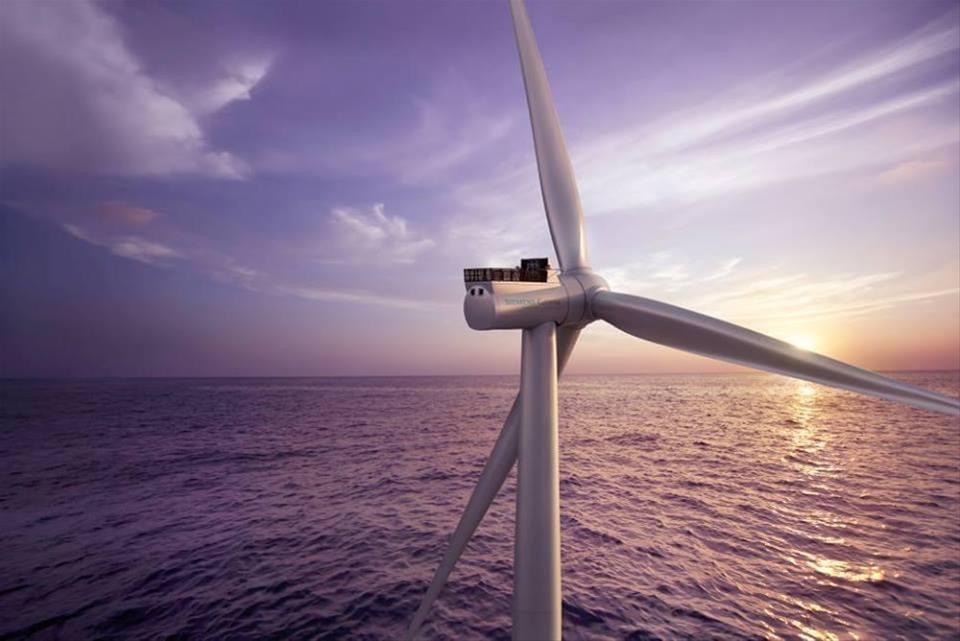
Taiwan is currently actively developing offshore wind energy to meet the goal of 5.7GW.
Taiwan’s Metal Industries Research and Development Centre (MIRDC) will train ROV pilots to assist in the development and maintenance of the turbines’ underwater structures.
The training will be undertaken by MIRDC at the Maritime Technology Innovation Centre created by the Bureau of Energy and the Ministry of Economic Affairs for the cultivation of national offshore wind energy talents.
Created for currents
Created for challenging environmental conditions inherent in shallow water operations the Seaeye low-profile 300m rated Cougar XT Compact is specially designed to minimise the effect of current, with a reduced frame size, buoyancy and weight — and a thinner 17mm tether cable that reduces the effect of drag.
Its six powerful thrusters hold the Cougar steady in strong cross currents and allow it to operate with precise manoeuvrability around structures whilst handling a wide array of equipment that can include cameras, sonar, tracking systems and manipulators.
MIRDC’s Cougar XT Compact comes with a Kongsberg colour zoom camera, Blueview multibeam sonar, Tritec SeaKing sidescan sonar, Cygnus ultrasonic thickness gauge, CP contact probe and a four-function manipulator. It also comes as a free-swimming option and has its own 16 ft control cabin.
At the Maritime Technology Innovation Centre, the offshore wind energy training courses organised by MIRDC will provide training and certification in Taiwan and for the Asia Pacific region.
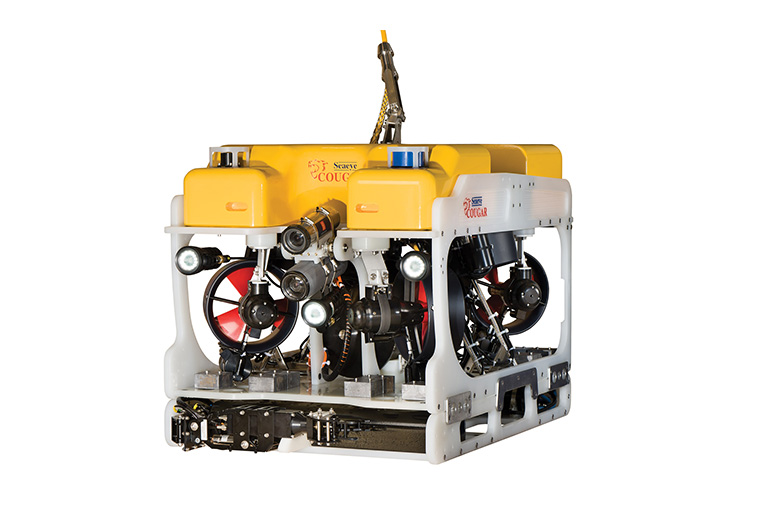
Especially suited for the offshore renewables market, the 300m rated Seaeye Cougar XT Compact has a low-profile configuration to meet the challenging environmental conditions inherent in shallow water operations.
Saab Seaeye is world leader in electric underwater robotics — including ROV, AUV, hybrid systems and tooling — and creator of the revolutionary iCON™ ecosystem.
For more information contact:
Matt Bates
Saab Seaeye Limited
+44 (0)1489 898000
Email Matt Bates
www.saabseaeye.com
22 March 2021
SUPERYACHT SUCCESS FOR MARINEGUARD AND FALCON
Another superyacht security contract win for MarineGuard, the global yacht security company, sees them order a further Saab Seaeye Falcon underwater robotic vehicle as part of their security resource package.

As superyachts become more technologically sophisticated, MarineGuard see the Falcon’s intelligent future-flexible control technology, playing an increasing role in the growing world of superyacht security.
Known for creating a ‘virtual security bubble’ around a yacht, MarineGuard, chose the Falcon as a resource for its reputation as the world’s top rated underwater robotic vehicle in its class.
Their superyacht client was also keen for a Falcon to be part of MarineGuard’s security system.
As superyachts become larger and more technologically sophisticated, MarineGuard see the Falcon, with its intelligent future-flexible control technology, playing an increasing role in the growing world of superyacht security.
For underwater surveillance the Falcon can be fully equipped with advanced video and sensor systems that can integrate into MarineGuard’s security network.
Proven in defence and marine science operations, the Falcon can examine a yacht’s hull, millimetre by millimetre, with its HD cameras, and descend down 1000 metres to explore the seabed below.
As an underwater workhorse the Falcon is fitted with a gripper for recovering items from the seabed, with other tools added as needed. Tools such as rope cutters for severing 15mm rope and 12mm steel wire rope, powerful manipulators and cleaning systems for keeping critical fittings clear.
As the ‘eyes underwater’ for superyacht owners, the Falcon is fitted with high definition cameras and can roam deep underwater transmitting live images direct to stateroom screens on board.
With a reliability record covering thousands of hours of undersea operations, the Falcon’s 20-year success comes from creating a powerful, highly manoeuvrable, multi-tasking, easy to use vehicle, depth rated to 300 and 1000 metres, enhanced with Saab Seaeye’s revolutionary iCON™ future-flexible intelligent control system, all in a handy metre-size package.
In addition to superyachts, MarineGuard’s integrated technology-based security solutions are also deployed for commercial shipping and at offshore installations.
Saab Seaeye is world leader in electric underwater robotics — including ROV, AUV, hybrid systems and tooling — and creator of the revolutionary iCON™ ecosystem.
MarineGuard is a recognised industry leader who Integrate technology-based security solutions and systems for the superyacht, commercial shipping and offshore markets.
For more information contact:
Matt Bates
Saab Seaeye Limited
+44 (0)1489 898000
Email Matt Bates
www.saabseaeye.com
Chris King
MarineGuard
+44 (0)23 8083 9011
Email Chris King
www.marineguard.com
26 February 2021
TURKEY GETS FALCON FOR EMERGENCY RESPONSE
The rapid detection of hazardous substances in Turkey’s offshore water is made possible with a Saab Seaeye Falcon operated by MOST Maritime and Environmental Services.
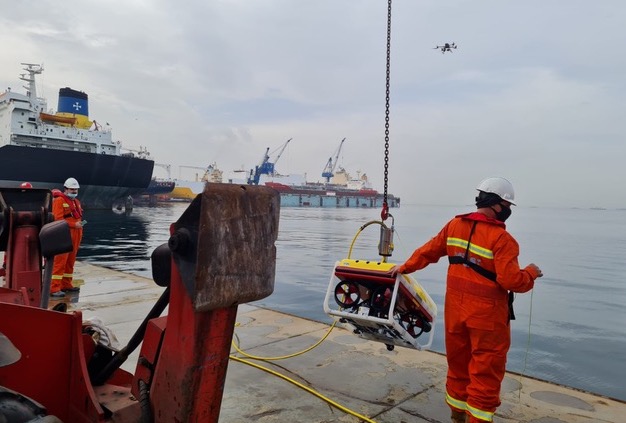
Easy to handle, the Falcon can be rapidly deployed for hydrocarbon leak detection.
MOST Maritime’s emergency response team chose the remotely operated vehicle for its speedy deployment complete with cameras and multi-sensor detectors, ready to locate the incident, observe, and secure the danger.
The company provides global emergency response services for petroleum and other harmful substance spills in the sea and inland waterways worldwide.
Easy to deploy, the Falcon’s rapid response capability makes it a vital resource for hydrocarbon leak detection where speed is essential to avoid the serious consequences of economic loss and environmental pollution.
Depth rated to 300m and 1000m, the Falcon is the world’s top-selling underwater vehicle in its class noted for its ability to handle a wide range of cameras, sensors and tools, and a reliability record covering thousands of hours of undersea operations.
The Seaeye Falcon’s success comes from its reputation as a versatile resource, with five powerful thrusters packed into a compact and easy-to-handle metre-sized vehicle enhanced by Saab Seaeye’s iCON™ intelligent control architecture. The resultant design is a highly manoeuvrable, multi-tasking vehicle that is easy to use and able to handle strong currents.
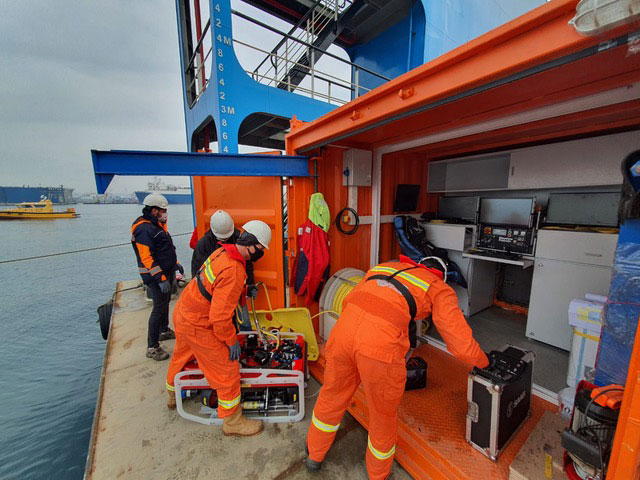
MOST Maritime’s emergency response team can speedily deploy the Falcon complete with cameras and multi-sensor detectors to locate an incident and secure the danger.


The Seaeye Falcon, to be deployed in Turkey for rapid response hydrocarbon leak detection.
Saab Seaeye is world leader in electric underwater robotics — including ROV, AUV, hybrid systems and tooling — and creator of the revolutionary iCON™ ecosystem.
MOST Maritime provides global emergency response services for petroleum and other harmful substance spills in the sea and inland waterways worldwide, along with training and operational planning to ensure compliance with national regulations.
For more information contact:
Matt Bates
Saab Seaeye Limited
+44 (0)1489 898000
Email Matt Bates
www.saabseaeye.com
Maharrem Eraslan
MOST Maritime and Environmental Services Company
+(90) 538 231 31 46
Email Maharrem Eraslan
www.mostdenizcilik.com
17 December 2020
Saab has today, on Wednesday 16th of December, delivered the second submarine of Gotland-class to the Swedish Defence Materiel Administration (FMV) after a Mid-life upgrade.
Saab has conducted a Mid-life upgrade of HMS Uppland. Taking all necessary measures to ensure the submarine’s operational availability, the upgrade includes new sensors and navigation systems, giving the vessel enhanced capabilities. The delivery of HMS Uppland was conducted today at a ceremony in Karlskrona, Sweden.
HMS Uppland is the second submarine in the Gotland-class to have gone through major changes and is now operational again.
“The Gotland-class submarines have an international reputation that many other submarines would wish for, with a stealthy ability and endurance beyond the ordinary. Sweden’s ability to develop world-class submarines is a result of the close cooperation between industry, the Swedish Defence Materiel Administration and the Swedish Royal Navy. We at Saab are proud that the latest cutting-edge underwater technology is now operational on-board both HMS Uppland and HMS Gotland.”
Lars Tossman, head of Saab business area Kockums.
HMS Uppland has had 50 new systems installed or modified, of which 20 are new systems that in the future will be used in the next generation of submarines, the Blekinge-class. This means, for example, new possibilities to analyse the boat’s surroundings with a so called Optronic Mast, replacing the traditional periscope and associated management system.
The Gotland-class submarines were built in 1990-1997. The submarine class consists of three submarines, all which have gone through minor modifications during the first part of their lifetime. HMS Gotland was the first boat to go through a Mid-life Upgrade. The submarine was split into two parts to be able to carry out larger changes.
-End-
About Gotland-class SSK

HSwMS Gotland is the first of a group of 3 Gotland-class submarines (also known as A19). It is a diesel electric submarine (SSK) of the Swedish Navy featuring an air independent propulsion system. HSwMS Gotland was designed and built by Kockums in Malmö in the early 1990’s and commissioned in 1996.
Mid-life upgrade

Two of the three Gotland-class submarines have now concluded comprehensive mid-life upgrades (MLU) and are equipped to face the challenges of tomorrow. There is an option for the modernization and upgrade of the third submarine of the class, HSwMS Halland.
The upgrade process entailed many important systems, such as the Stirling air independent propulsion (AIP) system upgraded from Mk2 to the new Mk3, a complete new mast suite by Safran, Kongsberg’s SA9510S sonar and Exelis’ ES-3701 electronic warfare systems as well as new management, sensor and communication systems.
The Gotland class is a 60.7 meters long submarine with a displacement of 1 380 tons, mainly designed for submarine missions such as antiship/antisubmarine warfare, collecting of intelligence, forward surveillance, special operations, and mine-laying tasks.
Upgraded Gotland-class Main specifications:
- Length: 62.7m
- Beam: 6.2m
- Draft: 5.6m
- Propulsion: Two diesel-elctric MTU engines; 2 × Kockums v4-275R Stirling AIP units
- Speed: 11 knots surfaced and 20 knots submerged
- Crew: 32 maximum
- Weapons: 4 × 533 mm Torpedo tubes; 2 × 400 mm Torpedo tubes; 48 × Externally Mounted Naval Mines
11 December 2020
SOUTH AMERICAN AQUACULTURE GETS THIRD FALCON
Ideal for their aquaculture work, a third Seaeye Falcon has been delivered to Chile-based Underdeep Solutions.
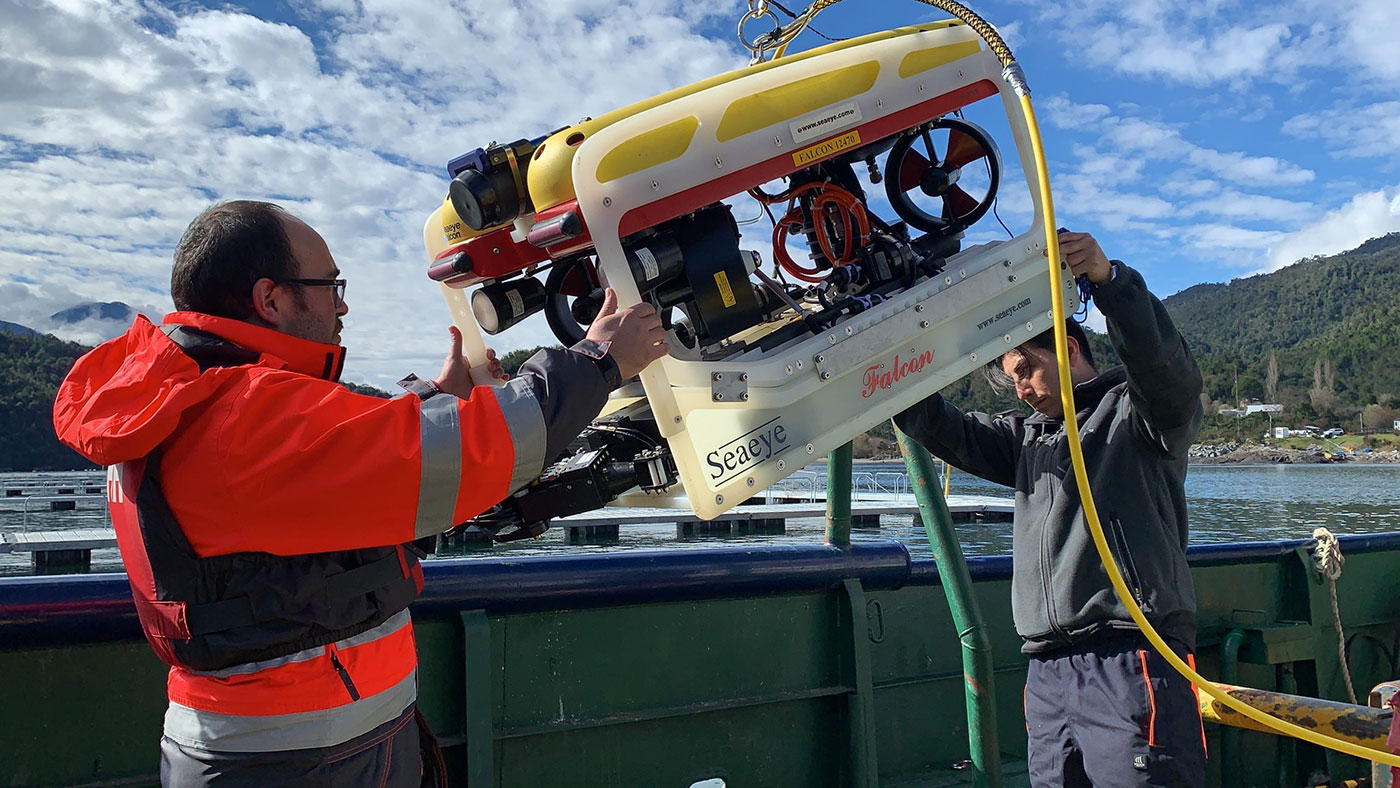
Underdeep operators readying the Falcon for inspection tasks.
Reliability when working in extremely remote locations is a key reason for adding another Falcon to their fleet, says Underdeep Solutions.
It is rated the top underwater robotic vehicle in class worldwide, and Underdeep’s latest Falcon is the second 1000m deep-rated version for the company, who specialise in fish farm inspection and support throughout Chile and the region.
Underdeep’s three Falcons are currently working at full capacity in the aquaculture facilities of the major aquaculture company, Salmones Camanchaca.
In addition, Underdeep Solutions has been working for several years in the removal of structures from the Salmones Camanchaca concessions, as requested by current local regulations, thus complying with the continuous plan for the removal of structures for the entire company
Along with inspecting nets and moorings, Underdeep deploy their Falcons, fitted with manipulators, to perform light work tasks around fastenings and buoys, as well as collecting and recovering items.
Their new Seaeye Falcon DR is fitted with a five-function manipulator and soft rope cutter, a Kongsberg HDTV camera, B&W reverse camera, a BlueView multi-beam sonar and an Applied Acoustic high-end USBL — that is now fitted to all Underdeep’s Falcons.
Pilots’ View
The success of the Falcon in Underdeep’s aquaculture work comes from its reassuring reliability, favoured by their pilots for working in isolated locations and its power, agility and steadiness in strong cross currents and harsh conditions whilst heavily loaded with equipment.
The Falcon’s world-winning concept comes from having created a highly reliable vehicle packed with five powerful thrusters and Saab Seaeye’s iCON™ intelligent power and distributed control architecture, all fitted into an easily handled metre-sized vehicle that can adopt different tools and sensors for undertaking numerous intricate and demanding tasks.
A Seaeye Cougar XTi is being considered as an addition to Underdeep’s vehicle fleet. The 3000m rated Cougar has six powerful SM7 thrusters and Seaeye’s iCON™ control system, making it ideal for handling robust equipment in strong currents whilst manoeuvring around complex structures.
Together with its aquaculture support operations, Underdeep also undertakes a range of other work across South America, including shipwreck recovery, tunnel inspection and offshore support.
Playing an important role in establishing Underdeep Solutions’ fleet is Spanish speaking Saab Seaeye distributor, Marine Vision, who have supplied three vehicles to Underdeep and assist in after sales technical support along with Saab Seaeye’s technical team.


Falcon DR with five function manipulator skid.
Saab Seaeye is world leader in electric underwater robotics — including ROV, AUV, hybrid systems and tooling — and creator of the revolutionary iCON™ ecosystem.
Underdeep Solutions is an established service provider for the South American region in support of the aquaculture sector and other underwater operations including tunnel inspection and offshore.
For more information contact:
Matt Bates
Saab Seaeye Limited
+44 (0)1489 898000
Email Matt Bates
www.saabseaeye.com
David Apparcel
Underdeep Solutions
+56 652 637671
Email David Apparcel
www.underdeep.cl
Robert Borjeson
Email Robert Borjeson
Pedro Argüello Aloza
Marine Vision
+34 952 473230
Email Pedro Argüello Aloza
www.marinevision.com
JOIN US ONLINE AT OCEANOLOGY INTERNATIONAL 2020 WHERE WE ARE HIGHLIGHTING OUR ‘INTELLIGENT’ MANIPULATOR
Saab Seaeye’s new electric work class manipulator is featured at Oceanology International 2020 Online virtual exhibition, 1st to 4th December.
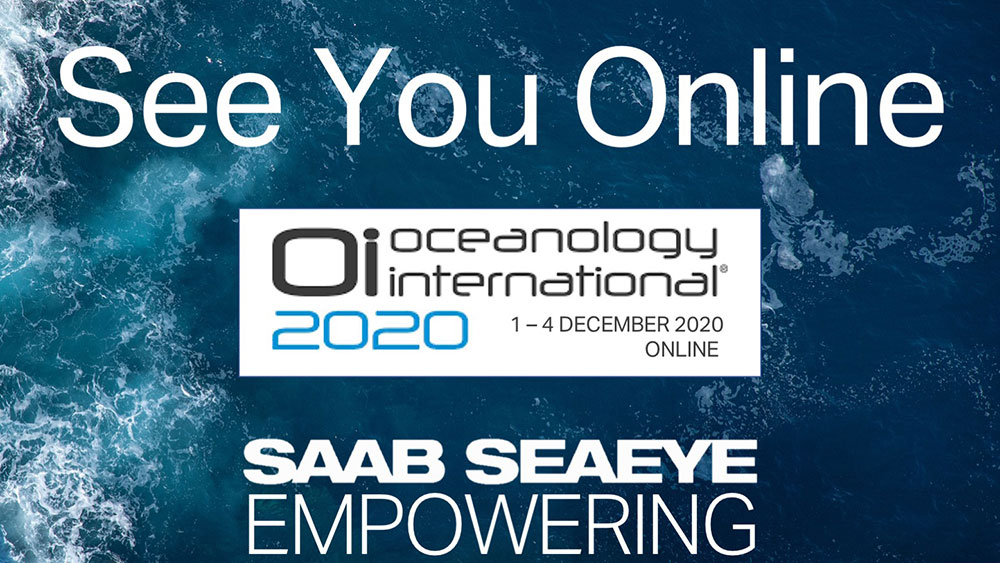
This breakthrough heralds a significant advance in underwater robotic technology in the growing electric tooling and vehicle market.
The all-electric work-class seven-function manipulator introduces an equally powerful, more precise and more intelligent manipulator than the hydraulic equivalent currently being used on work-class robotic vehicles today.
Its innovative control system enables both manual and automated control, with the potential for full autonomy in the future.
Featured alongside the new manipulator is the world’s largest range of electric underwater robotic vehicles.
Online visitors from across the global ocean technology community have a chance to browse, talk and draw upon Saab Seaeye’s 35 years’ experience of creating solutions for thousands of widely varying tasks, across a whole range of scientific, commercial and security applications.
It is also a chance for visitors to discover how Saab Seaeye has conceived a flexible future with their iCON™ intelligent control architecture that is designed to embrace emerging technologies and create innovative new concepts in underwater robotics.
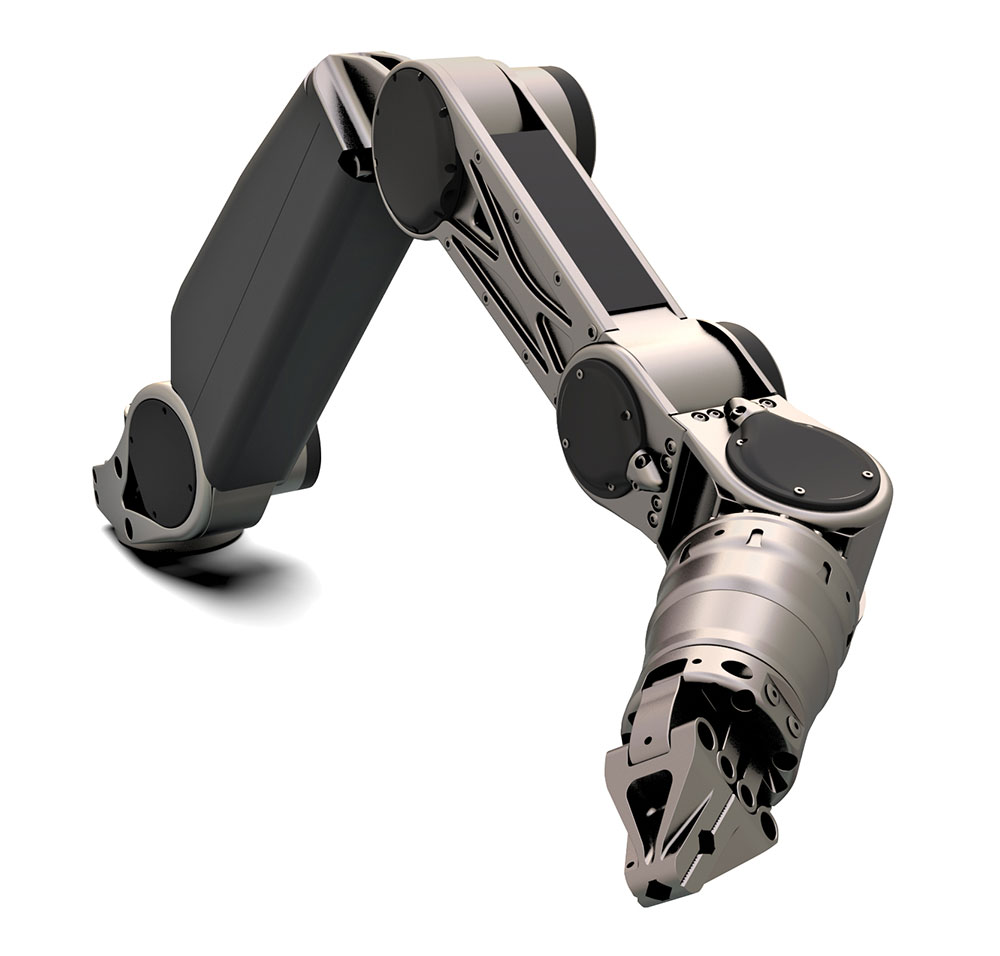
Seaeye eM1-7 — the world’s first intelligent electric work class manipulator
Saab Seaeye is world leader in electric underwater robotics — including ROV, AUV, hybrid systems and tooling — and creator of the revolutionary iCON™ ecosystem.
For more information contact:
Matt Bates
Saab Seaeye Limited
+44 (0)1489 898000
Email Matt Bates
www.saabseaeye.com
23/11/20
FALCON FOR SWEDISH SAFETY AND SURVEY
Peab Marin chose a Saab Seaeye Falcon as a multi-functional resource in support of the company’s marine survey, salvage and civil construction operations.
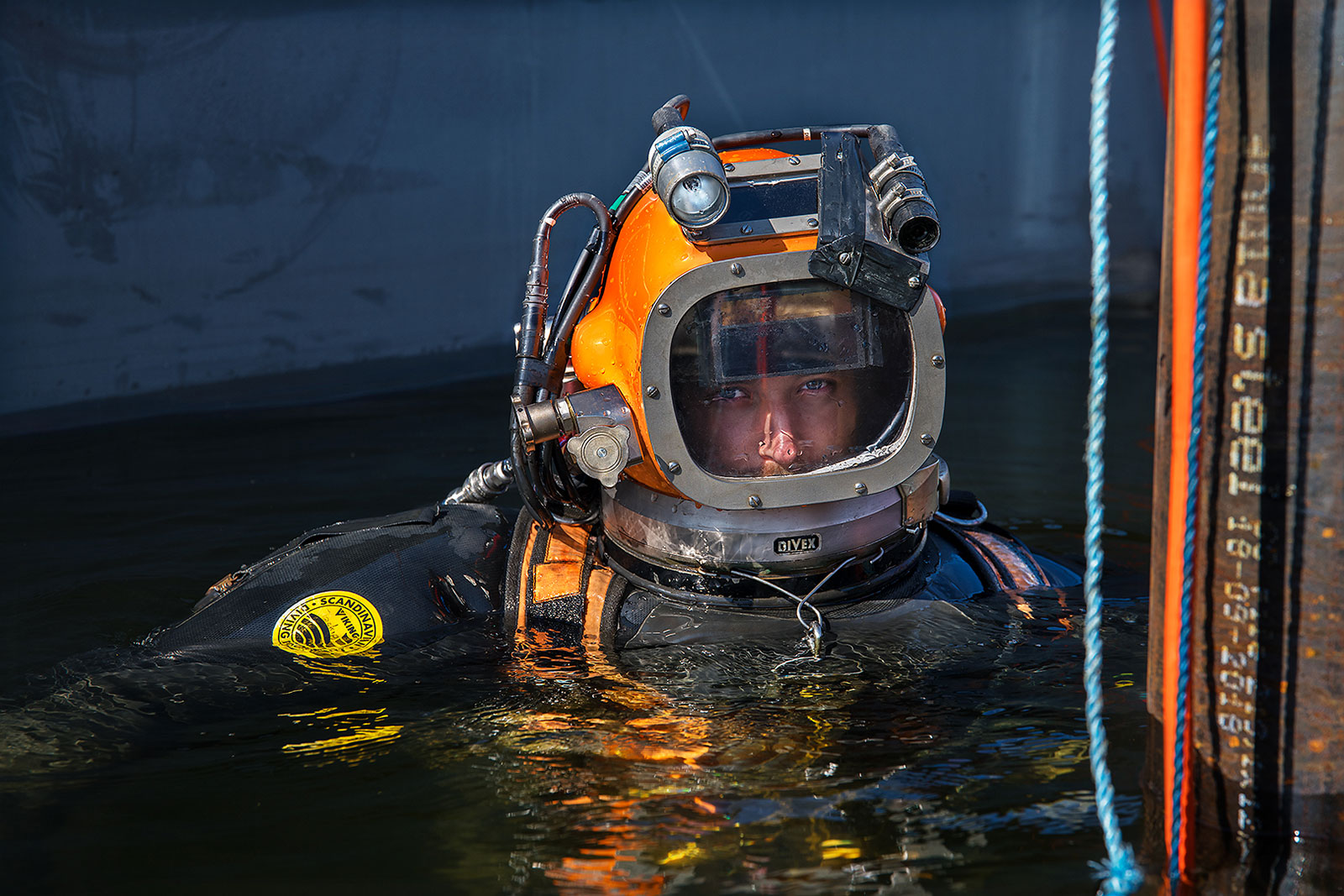
The Falcon can make a safety assessment before sending divers down.
Photo by Peter Steen
The Swedish marine services company says the Falcon will secure a safer working environment for its divers and will be an “excellent tool” for surveying.
Importantly for Peab Marin’s wide range of construction and maintenance work the Falcon’s quick and easy deployment with ready systems change and expandable systems options, make it a highly adaptable resource.
Diver Safety
Diver safety is paramount and in hazardous circumstances the Falcon can be deployed to work underwater endlessly and tirelessly.
Robert Hedin at Peab describes the important role the Falcon will play in diver safety.
“Some work can offer serious risk for a commercial diver, especially Delta-P situations when the differential pressure between two water columns attempts to equalize, creating tremendous pressure/suction.
It’s a hazard that cannot be downplayed, as in some cases it’s just impossible to reduce the suction in case of emergency.
In situations like this, we prefer to send down the Falcon to either completely replace the diver’s work or in order to make a proper safety assessment. It really helps us to create a safer work environment for our commercial divers.
This has been exclusive to the offshore industry for a long time, and we’re really glad to see the same application moving into the civil inshore industry in Sweden.”
Murky Water Working
With Swedish waters notorious for low visibility, typically 0.5m and less, and working in a wide variety of water states from open seas to waterway locks, fitting a Bluetooth multibeam sonar to the Falcon was essential, says Robert Hedin: “It is a must-have for operating an ROV in our underwater environment.”
Pilots’ Friend
With Peab Marin pilots typically working in challenging conditions, their pilots welcome the precise control, agility and stability of the Falcon when faced with complex environments in turbulent waters and strong currents.
The pilots particularly like the vehicle’s user-friendly interface with its advanced array of functions including customisable graphics and diagnostic pages.
The Falcon’s 20 year success — winning top-in-class world status — comes from its future-flexible, ever-evolving technology package that Saab Seaeye has designed around a compact, powerful, highly manoeuvrable, easy to use vehicle, enhanced with iCON™ intelligent control.
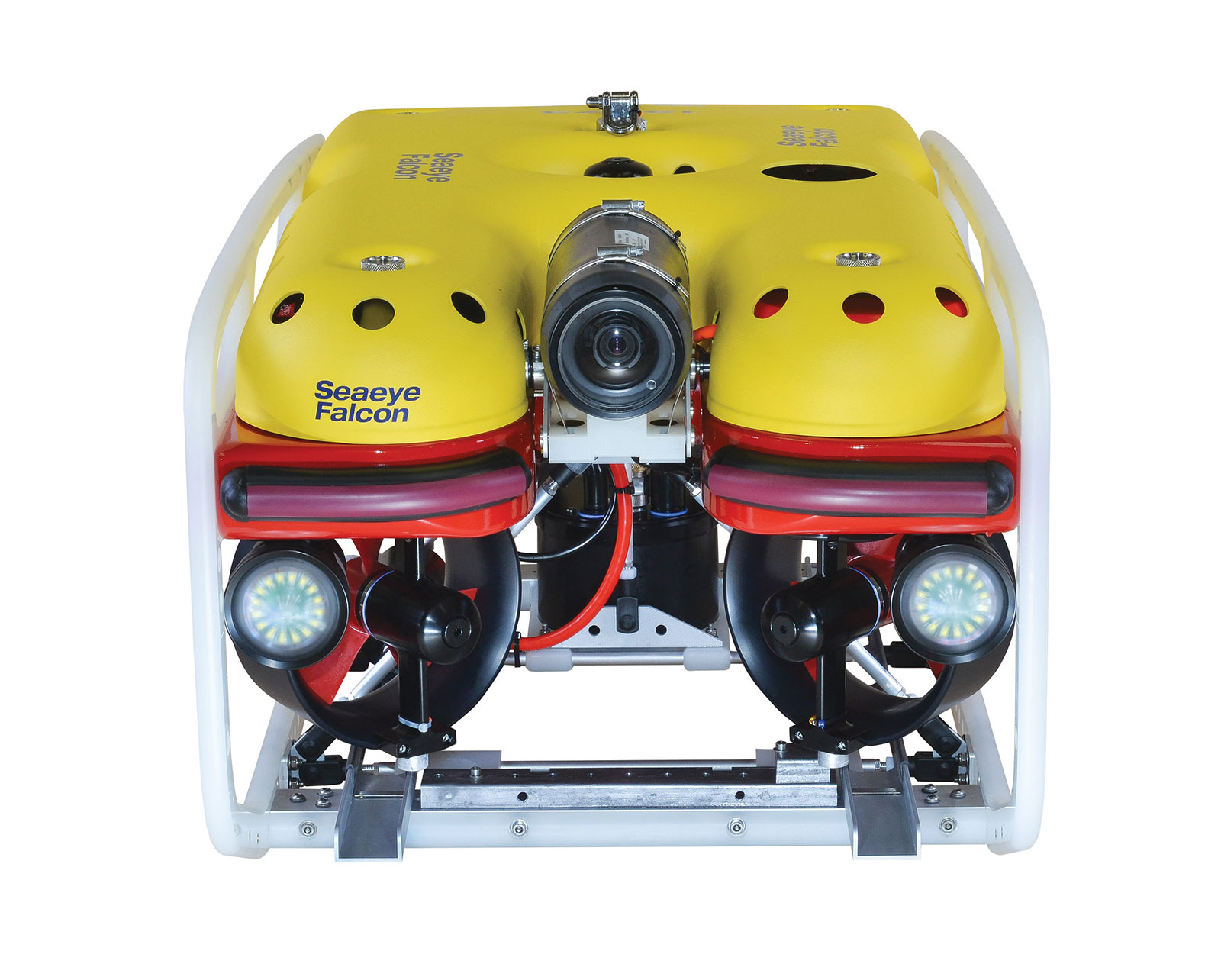
Saab Seaeye Falcon — A multi-functional resource in support of Peab Marin’s marine survey, salvage and civil construction operations.
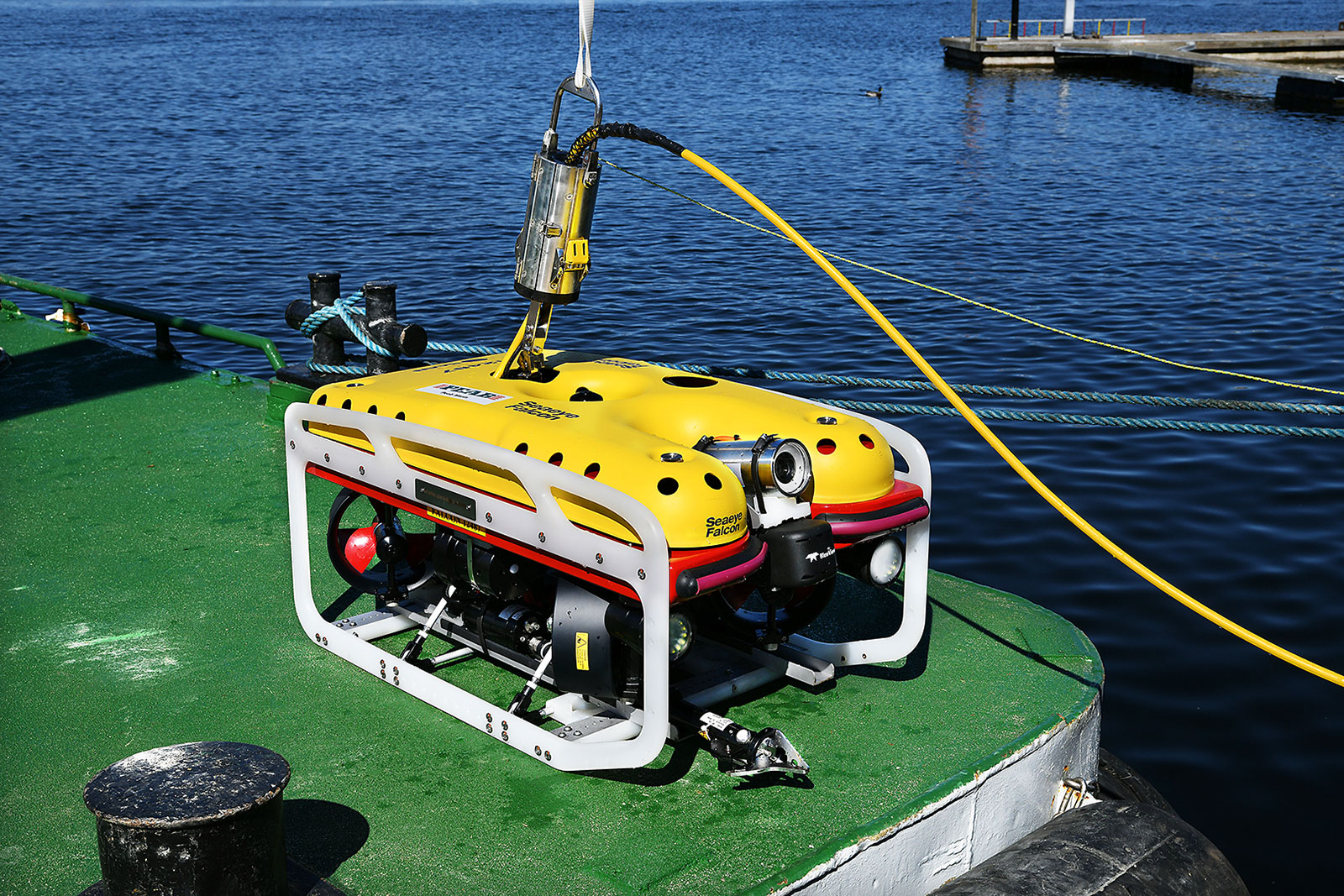
In visibility of 0.5m a Falcon is a “must-have”.
Photo: Peter Steen
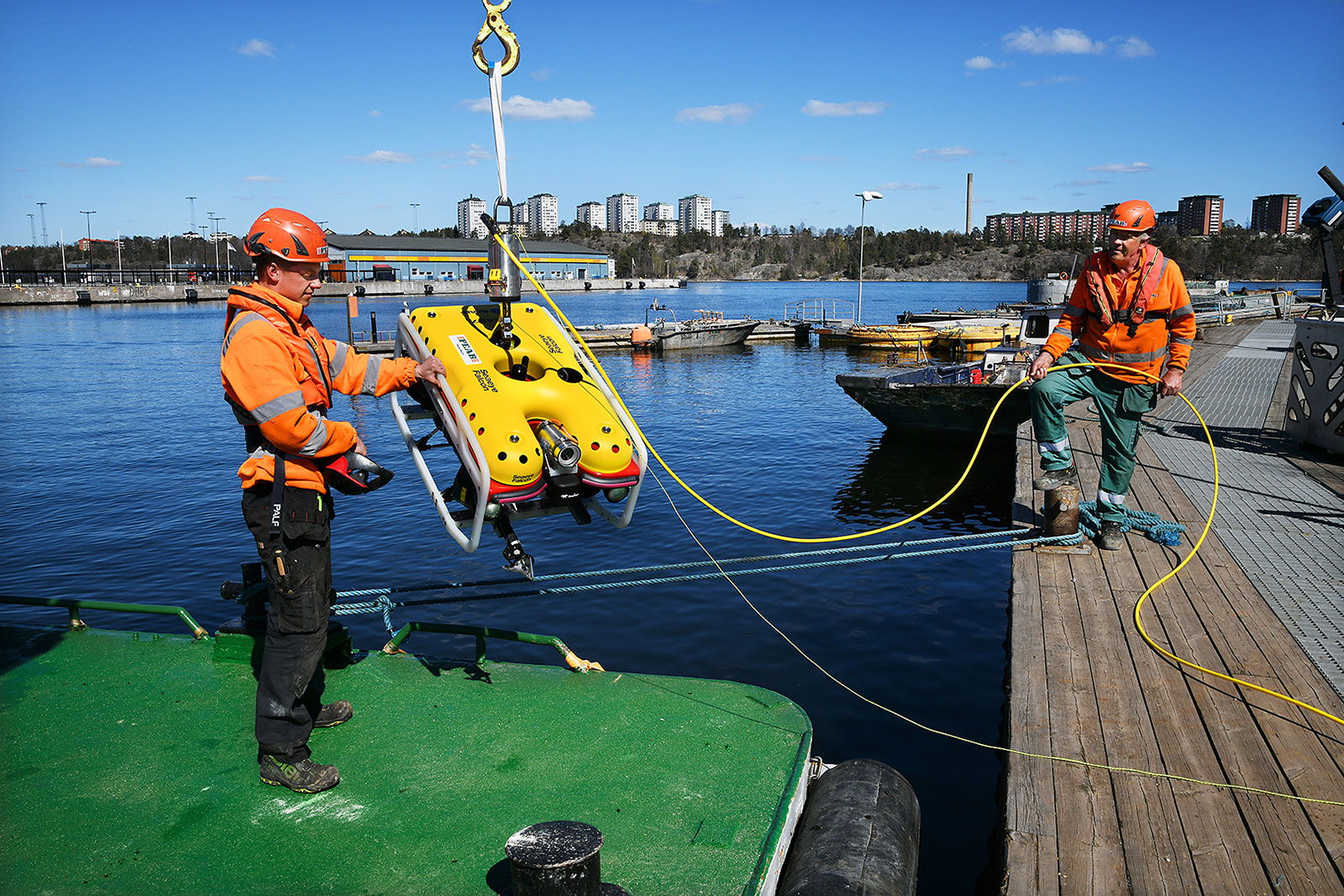
Photo: Peter Steen
Saab Seaeye is world leader in electric underwater robotics — including ROV, AUV, hybrid systems and tooling — and creator of the revolutionary iCON™ ecosystem.
Peab Marin is a Swedish marine services company specialising in survey, salvage and civil construction operations.
For more information contact:
Matt Bates
Saab Seaeye Limited
+44 (0)1489 898000
Email Matt Bates
www.saabseaeye.com
Robert Hedin
Peab Marin
+46 (0)707-70 73 30
Email Robert Hedin
www.peabmarin.se
7 October 2020
EYES UNDERWATER FOR SUPERYACHTS
For superyacht owners, eyes beneath the waves, provided by intelligent underwater robotic vehicles, is a valuable resource.
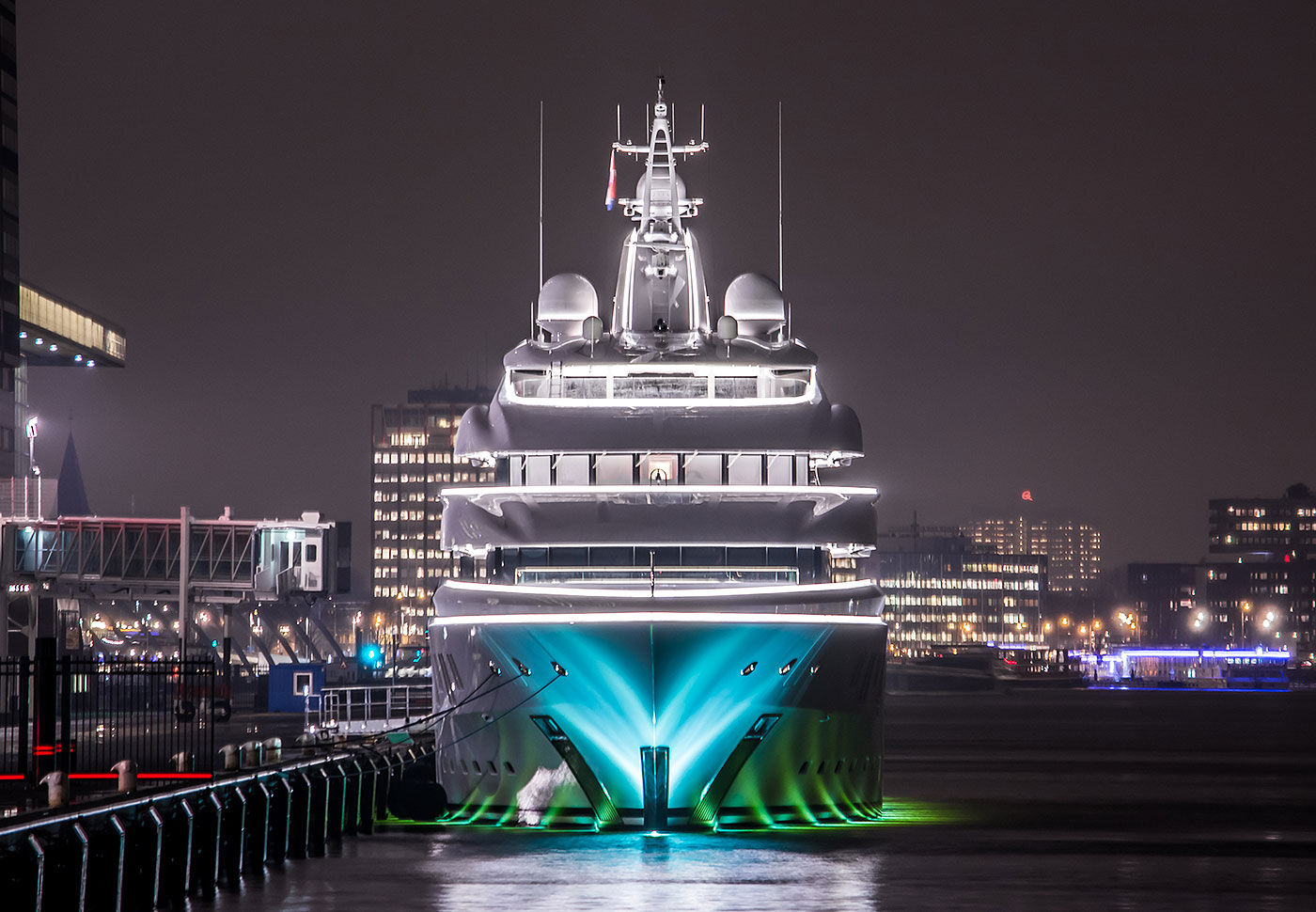
Putting eyes underwater the Falcon is a valuable resource for superyachts offered by MarineGuard.
Global yacht security company, MarineGuard, include the Saab Seaeye Falcon underwater robotic vehicle as part of their security system for superyachts.
Proven in defence and marine science operations, the Falcon can examine a yacht’s hull millimetre by millimetre with its HD cameras, and descend down 1000 metres to explore the seabed below.
Superyacht owners often view the underwater world live on stateroom large screens, from images transmitted by a roaming Falcon.
As an underwater workhorse the Falcon is fitted with a gripper for recovering items from the seabed, with other tools added as needed. Tools such as rope cutters for severing 15mm rope and 12mm steel wire rope, powerful manipulators and cleaning systems for keeping critical fittings clear.
Diver safety is a key benefit. As a dive buddy, a Falcon can survey a dive site and then watch over the diver when below. It can also transport items back and forth during a dive.
Security bubble
MarineGuard, known for creating a ‘virtual security bubble’ around a yacht, chose the Falcon as the world’s top selling underwater robotic vehicle in its class.
The Falcon’s 20-year success comes from having created a small metre-sized, powerful, highly maneuverable, multi-tasking, easy to use vehicle, depth rated to 300 and 1000 metres.
Enhanced with Saab Seaeye’s revolutionary iCON™ intelligent control system, the Falcon is a future-flexible package designed to adopt evolving technologies.
MarineGuard, who design and install security systems for ever larger and more technologically advanced superyachts, are keen to include proven and technologically-leading solutions in their choice of Falcon.
The Falcon has a trusted reliability record covering thousands of hours of undersea operations globally, working in the most challenging environments with the ability to master turbulent waters and strong currents whilst remaining stable during filming and undertaking delicate tasks.
Defence forces and marine scientists use the adaptable Falcon for a wide variety of missions and research projects. It is also used extensively in the robust offshore energy industry, amongst other sectors.
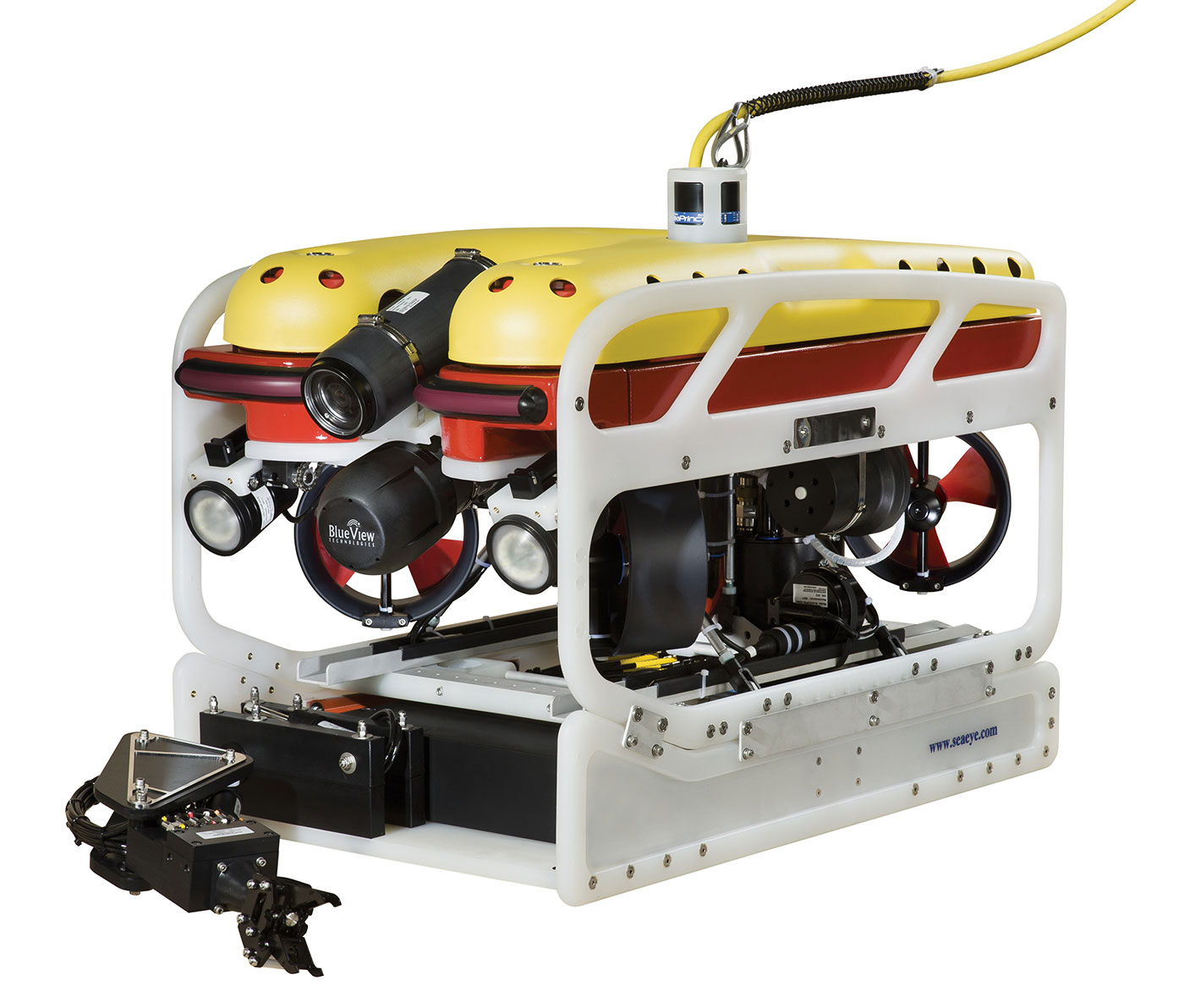
The Falcon can be fitted with a range of cameras for detailed hull inspection and deep seabed exploration, along with tools for handling items, rope cutting and cleaning.

A Falcon can watch over a diver and survey a site before a dive.
Saab Seaeye is world leader in electric underwater robotics — including ROV, AUV, hybrid systems and tooling — and creator of the revolutionary iCON™ ecosystem.
For more information contact:
Saab Seaeye Limited
+44 (0)1489 898000
Email Matt Bates
www.saabseaeye.com
28 September 2020
SAAB SEAEYE LEOPARDS JOIN OCEAN INFINITY ROBOT FLEET
Ocean Infinity have selected the Saab Seaeye Leopard to complement its pioneering ‘Armada’ fleet of unmanned surface robot vessels.
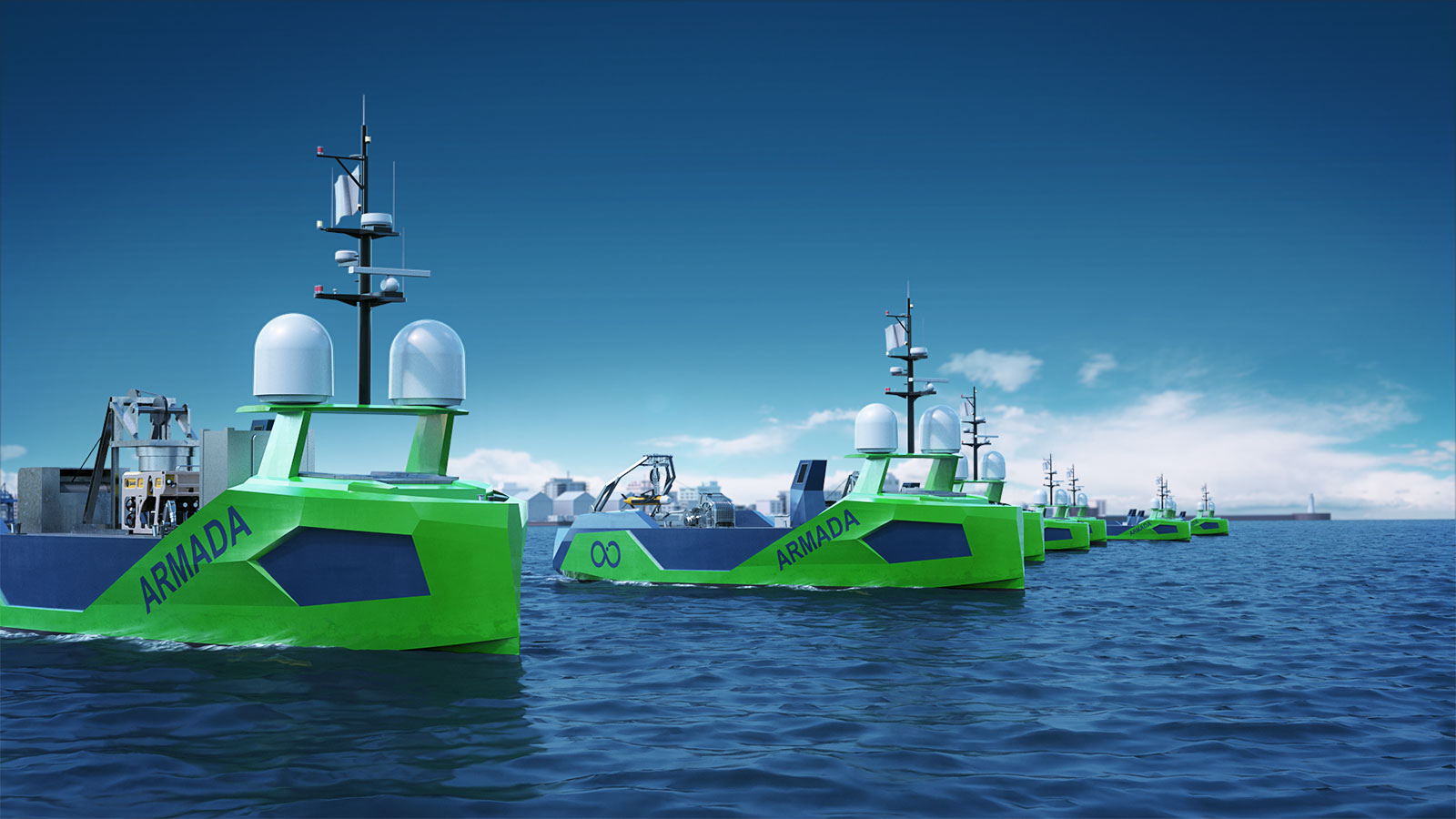
Saab Seaeye Leopards join ‘Armada’ fleet of unmanned surface robot vessels.
The Leopard work-class underwater vehicles will be deployed from Ocean Infinity’s initial 13 environmentally sustainable unmanned vessels for a variety of offshore and coastal services.
Dan Hook, Ocean Infinity, said, “The 3000 m Seaeye Leopard was chosen not only because it is well suited to USV applications but more specifically because of its comparable capabilities to a conventional hydraulic work class vehicle, but with considerably less input power, meaning materially reduced carbon emissions.”
“The Leopard has ready adaptability for ‘Over the Horizon’ operations as well as a clear reputation for reliability and its suitability for remote operations — crucial for maintenance or repairs as part of an unmanned fleet,” he continued.
Jon Robertson, Saab Seaeye said: “We’re proud to be chosen to be part of this revolutionary unmanned fleet. The Armada Fleet complete with the Leopard vehicle will dramatically reduce the impact of offshore operations by cutting CO2 emissions and at the same time increase safety at sea by reducing manpower deployed.”
Ocean Infinity’s Armada Fleet is a major advance in the global maritime industry, driving technology and sustainability to deliver a wide range of services including offshore and coastal survey data acquisition, geotechnical surveys, ROV and AUV operations, logistics and security in the safest, lowest impact and highest value way that exists today.
The fleet will be operated and monitored from onshore control centres based in Southampton UK, Austin Texas USA and a location soon to be finalised in Asia.
Construction of the fleet is underway and is expected to be operational early next year.
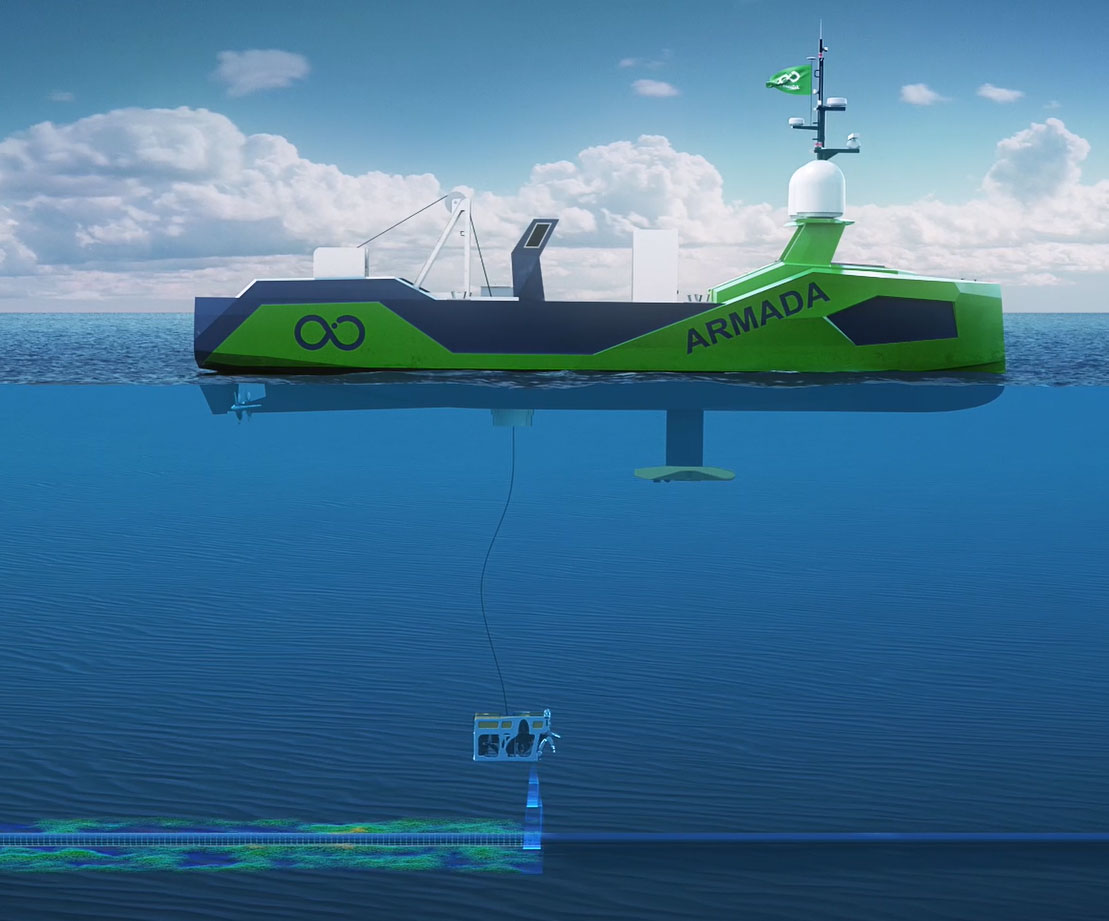
The Saab Seaeye Leopard is suited for unmanned service vessel applications.
hr_(2).jpg)
Saab Seaeye Leopards join ‘Armada’ fleet of multiple unmanned surface vessels.
Saab Seaeye is world leader in electric underwater robotics — including ROV, AUV, hybrid systems and tooling — and creator of the revolutionary iCON™ ecosystem.
For more information contact:
Matt Bates
Saab Seaeye Limited
+44 (0)1489 898000
Email Matt Bates
www.saabseaeye.com
1/9/19
Saab Seaeye: Doing It for Real
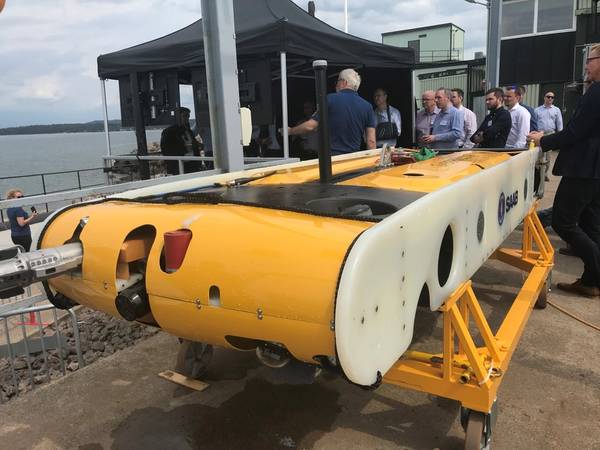
Saab Seaeye’s Sabertooth during a demo with Equinor’s subsea docking station (Photo: Saab Seaeye)
Sweden’s Saab Seaeye has been one of those driving the vehicle side of the subsea resident vehicle equation – for at least 10 years.
The firm has some 50% of the world market of electric remote operated vehicles (ROV) and it has delivered more than 1,000 electric autonomous underwater vehicle (AUV) and ROV and hybrid vehicles. Earlier this year, during its eRobotics Spring Campaign, Saab Seaeye demonstrated its Sabertooth AUV’s ability to dock in a safe and controlled manner at a remote sub-resident docking station, where it could access tooling packages, be recharged and transfer data, including new mission plans, using Blue Logic inductive connectors. It could do this automatically, without the need for human control.
In June, the firm performed docking, charging and communications on Equinor’s SDS, in Lake Vattern, Sweden. While the final part of the docking during this exercise was via semi-automated controls, with a bit of programming the vehicle would be able to dock autonomously, says Jan Siesjö, Chief Engineer, at Saab Seaeye.
The firm has been working on this concept for more than 10 years, developing the 3,000-meter-rated Sabertooth’s now advanced capability and control systems. The idea has since been supported by the likes of ENI, while parallel developments in inductive underwater charging and data transmission technology, and underwater video capable communications, and the development of standardized docking stations, have helped see the market start to catch up.
“It is the only hovering autonomous system that can operate in both AUV and ROV modes and handle connections in both the horizontal and vertical plane,” says Peter Erkers, sales director at Saab Seaeye. “And it is the only vehicle currently on the market capable of undertaking long-term residency in difficult to access locations.”
Saab Seaeye has also been working on other systems, such as remote operability of its light world class Leopard ROV. It’s been working with Boeing doing trials over a satellite link across the US, controlling the ROV to do manipulator work, mating connectors, flying missions and way point control. Even when the latency was pushed to up to three seconds and data rates “messed with”, the system still performed, says Siesjö.
Meanwhile, Saab Seaeye is also working on a full work class electrical manipulator. Testing work is ongoing with plans to reveal more to the market next year. The company has also been developing and trailing 3D simultaneous localisation and mapping technologies based on an in-stereo camera system developed in Saab some time ago.
28 June 2019
Saab Seaeye: A New Future in Underwater Technology has Arrived
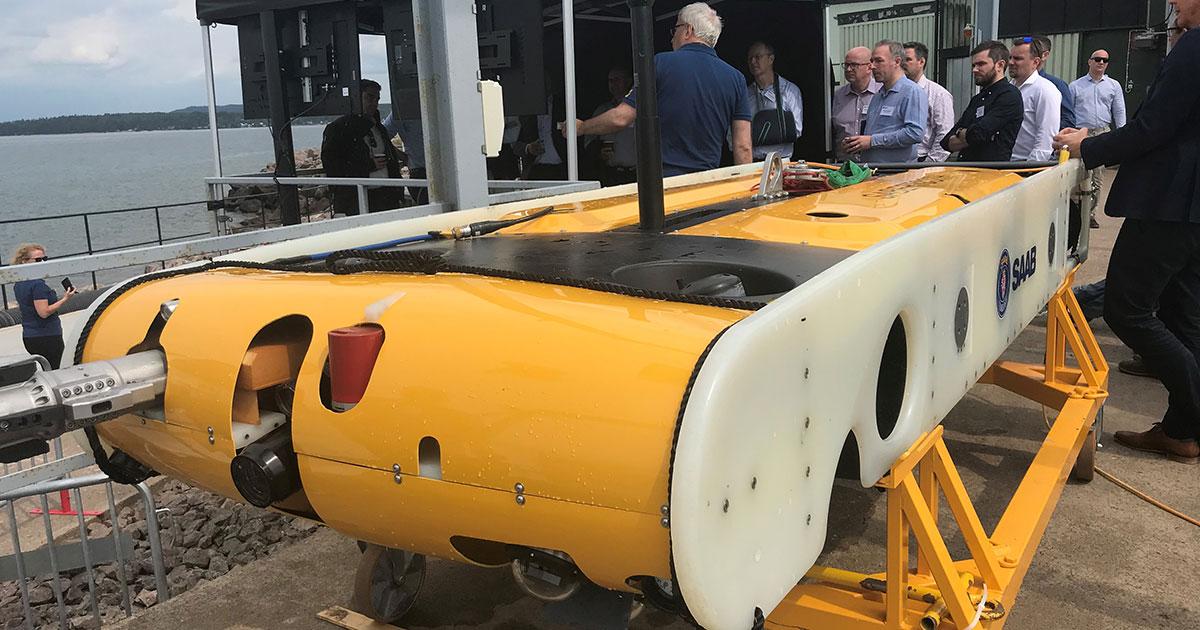
In a world first, Saab Seaeye successfully docked an autonomous vehicle to an Equinor subsea docking station to recharge its batteries and download data, demonstrating that a new future in underwater technology has arrived.
It is a breakthrough that positions Saab Seaeye as leader in subsea resident robotics.
Representatives from across the offshore energy industries gathered at Sweden’s Lake Vättern to witness the successful docking of the Saab Seaeye Sabertooth autonomous vehicle, at Norwegian energy firm, Equinor’s, open-standard subsea docking station (SDS).
From the docking station the Sabertooth was sent on various autonomous transits to undertake mock inspection tasks that included returning to the station for recharging and video data download.

Control panel view with Sabertooth in pioneering docking manoeuvre
Commenting on this pioneering achievement, Jon Robertson, managing director of Saab Seaeye Ltd, said: “For 30 years we have been in the forefront of developments and it’s brilliant to see a major advance in the future of the industry come to fruition.”
He adds that residency is now a deliverable option that will reduce operational expenditure and remove humans from offshore, and reduce environmental impact.
Representatives at the event saw a clear business case for safe operations, lower cost and lower carbon, by reducing the need for humans and vessels offshore and allowing fields to be designed in different ways to increase production efficiency and be profitable in remote areas.
The docking station at the demonstration was produced by Blue Logic and includes their inductive power and data connectors. Whilst docked the vehicle was charged and data uploaded and downloaded via the connectors.
Live video and vehicle control were made possible with Sonardyne’s BlueComm free-space optical modem.
Much of the demonstration was run with pre-programmed autonomous route plans. Also advanced motion controls via the BlueComm system, enabled operators to move the vehicle from an automatically held position by set amounts using a touchscreen user interface. The mating of a TMT electric torque tool to a valve panel was also performed with control and video relayed via the BlueComm system.
Also demonstrated was an underwater simultaneous localization and mapping (UWSLAM) that allows a pilot to ‘see’ the environment as a 3D map in real time whilst flying around – and by leaving a ‘snail trail’ the system can determine precise vehicle positioning relative to the map and provide effective station-keeping and augmented navigation functions. As the 3D point cloud generated by the system has a resolution of one millimetre, precise measurement of the size and position of objects is possible.
3D simulation was on show, providing a real-time software interface for custom-development and viewing of Sabertooth functionality, including debugging new operations and algorithms.
In addition to Equinor, who has driven the open-standard SDS and is working with industry via the Subsea Wireless Interest Group (SWIG), other representatives from major operators were at the event, along with other companies who may use SDS, including Saipem, Oceaneering, IKM Subsea and Eelume. Also present were those who could supply power to these vehicles, such as Ocean Power Technologies, along with service suppliers like Modus, ROVOP and DeepOcean.
The potential revealed at the demonstration would not be possible but for Equinor’s development of the open-standard subsea docking station concept and Saab Seaeye’s Sabertooth which is the only hovering autonomous system that can operate in both AUV and ROV modes and handle connections in both the horizontal and vertical plane – and the only vehicle currently on the market capable of undertaking long-term residency in difficult to access locations.
28 September
SMART TORQUE TOOL TAKES OFF
Considerable savings in major torque intervention projects are reported by five subsea operators who were early to adopt the new smart electric torque tool from TMT and Saab Seaeye and is now available as a rental option.

The new small self-calibrating class 1-4 torque tool is bringing considerable savings to torque tool tasks.
Offshore operator, McDermott, found they could get a rapid configuration change to their electric tool with accurate torque operations and speeds up to 30 rpm, operating eight valves requiring 90 to 107 turns each. At an optimum time of 10 minutes per valve, considerable vessel time was saved.
Sold in the northern hemisphere by Saab Seaeye, the world’s largest manufacturer of electric underwater e-robotic systems, and in the southern hemisphere by Australia-based Total Marine Technology (TMT) its market reach has now been extended to the rental option.
The early success of the electric torque tool concept comes from being a self-calibrating, highly accurate torque control system set in a small, fast to set-up package.
A key benefit for subsea operators is the tool’s ability to adapt automatically to Class 1 to 4 fittings and torques whilst performing the integrity-critical task of opening and closing seabed valves and other torque tensioning tasks.
As a software-managed system, it is possible to achieve far more accurate and finer control and feedback than with a hydraulic system.
At half the weight of its hydraulic equivalent, it can be operated from an electric robotic vehicle of a much smaller size than is normally required for hydraulic systems, allowing smaller support vessels to be used.
Saab Seaeye is the world’s leading underwater e-robotics company, with the most advanced range of tethered, autonomous and hybrid electric robotic systems, engineered to address the diverse range of tasks found across commercial, defence and scientific markets.
Total Marine Technology is a leading engineering and manufacturing company which produces the only Australian designed and built Work Class ROVs. They also operate a fleet of ROVs, manufacture innovative tooling designs, and provides offshore surveying for the global offshore drilling and production industry from bases in Perth and Kuala Lumpur.
For more information contact:
Matt Bates
Saab Seaeye Limited
+44 (0)1489 898000
Email Matt Bates
www.saabseaeye.com
Mark Harris
Total Marine Technology
+61 (8) 9411 6500
Email Mark Harris
www.tmtrov.com.au
7 August 2018
COST OF ANODE REPAIR CUT WITH COUGAR
An advanced anode repair concept has been launched with the help of Saab Seaeye’s Cougar XT electric e-robotic underwater vehicle as a development platform.

The Saab Seaeye Cougar XT is the only system with the power to operate the SubC anode replacement tool, and also operate in strong shallow water currents. (Images courtesy of SubC Partner)
The new concept, created by SubC Partner, is said to save up to 75% in costs compared to hydraulic delivered anode repair systems.
It can be adapted for any size and shape of sacrificial anode, whether surface mounted or welded.
It offers a very fast anode exchange procedure that avoids diver intervention and can be undertaken in extreme weather conditions.
The system comes as a skid, and is a resource targeted at offshore wind installations, oil and gas fields and a range of maritime facilities.
This includes anode repair at monopiles, jackets, ships and semi-submersibles.
After considering all vehicles on the market as a development platform for their new concept, the Saab Seaeye Cougar XT was considered the best choice, says SubC’s sales manager, Klaus Brix.
“The Cougar was the best choice, as it has more power to handle heavy tooling for its size than any other company’s system.
“It has a reputation amongst engineers across the industry as a known, trusted and proven system.
“Importantly it has a proven capability to operate in the shallow waters around windfarms.
“And choosing the Cougar meant we had an electric system with the power to operate the anode replacement tool that avoided having to resort to the size and cost of a workclass vehicle.”
The Cougar’s power and maneuverability meant that SubC were able to create an anode replacement system capable of handling anodes weighing up to 40 kg and in lengths up to 1100 mm — and can be adapted for any size of anode.
“It not only saves diving operations and increases personnel safety significantly, but a Cougar electric system substitutes very expensive alternative technology solutions based on hydraulics,” concludes Klaus Brix.
Saab Seaeye is the world’s leading underwater e-robotics company, with the most advanced range of tethered, autonomous and hybrid electric robotic systems, engineered to address the diverse range of tasks found across commercial, defence and scientific markets.
SubC Partner A/S provides asset integrity solutions to the offshore renewable and oil and gas industries, including engineering, fabrication, and maintenance solutions from the seabed and upwards.
For more information contact:
Matt Bates
Saab Seaeye Limited
+44 (0)1489 898000
Email Matt Bates
www.saabseaeye.com
Klaus Brix
SubC Partner A/S
+45 4024 7583
Email Klaus Brix
www.subcpartner.com
08 June 2018
SAAB SEAEYE TAKES MORE CONTROL VIA SATELLITE LINK
Saab Seaeye has further enhanced their system for global remote control of their electric underwater robotic vehicles via satellite link and 4G networks.
 |
| Saab Seaeye’s system for remotely controlling their underwater robotic vehicles worldwide via satellite link and 4G networks has been enhanced with an intelligent tether management system. |
Remote control of their Leopard electric robotic work vehicle has now been upgraded to include control of the Tether Management System.
Such remote operations will bring considerable savings to the oil and gas industry by reducing the need for offshore piloting personnel and advancing the potential for long-distance control of remote resident systems, says Saab Seaeye.
Earlier successful trials of the concept proved that their iCON intelligent control architecture can overcome the poor signal problems of low bandwidth and high latency challenges, typical of satellite communications, including coping with a 20 per cent data drop out.
 |
| Satellite linked operations have seen the Leopard undertake complex tasks whilst under the direct remote control of a pilot located at a shore base several thousand miles away. |
Rigorous, satellite-linked operational testing has seen the Leopard undertake complex tasks whilst under the direct remote control of a pilot located at a shore base several thousand miles away.
Fingertip remote control of the Leopard by the pilot enabled him to perform a step-by-step operation of mating and un-mating underwater connectors.
At the same time, the piloting operation was deliberately challenged by a 20 per cent data drop-out to prove the capability of Saab Seaeye’s advanced iCON intelligent control architecture over a satellite link.
Other robotic work and inspection vehicles can be controlled in this way, says the company, including their Sabertooth AUV, a hybrid system that can operate as both a roaming AUV and an ROV that can perform light work tasks – and is an ideal system for long term residency operations in remote locations.
The financial and operational benefits to offshore operators will come from needing fewer technicians offshore – none in the case of remote resident locations – along with increased effectiveness as the control and management of complex tasks can be performed remotely by highly experienced pilots together with technical support staff and computer aided control systems located at onshore locations across the globe.
The advanced communications capability, an integral option within iCON, offers operation via a low bandwidth link of 1.6 megabytes per second and high latency of up to 3 seconds.
An important future role for iCON, says Saab Seaeye, will be in the distant management of resident robotic systems that remain on station for a year at remote locations ready to be deployed on maintenance and inspection missions.
Saab Seaeye is the world’s leading underwater e‐robotics company, with the most advanced range of tethered, autonomous and hybrid electric robotic systems, engineered to address the diverse range of tasks found across commercial, defence and scientific markets.
For more information contact:
| Matt Bates Saab Seaeye Limited +44 (0)1489 898 000 Matt.Bates@saabgroup.com www.seaeye.com |
DEEP SCIENCE
UNDERWATER ROBOTICS FOR DEEP OCEAN RESEARCH
Marine scientists worldwide are discovering that Saab Seaeye’s range of underwater e-robotic vehicles and Hydro-Lek subsea tooling is particularly suited for complex and varied research projects. These projects include environmental monitoring, marine archaeology, and biodiversity research.
Many of the world’s deep sea eco-systems can now be accessed and examined in-situ thanks to technological advances made in Saab Seaeye’s range of underwater robotic systems and subsea tooling. New ground-breaking designs and control architecture ensure that these solutions can not only master strong currents and tides and harsh conditions but can also be geared to perform delicate analytical tasks where accuracy and minimum intervention is of utmost importance.
Further developments made in transformative robotics and tooling as found in Saab Seaeye’s Falcon and Leopard vehicles are making a wider range of marine science tasks more possible.
Kaiyo Engineering, Japan
Studies in Japan by Kaiyo Engineering are using the Leopard to examine biodiversity surrounding hydrothermal vent activity in order to protect the inter-connecting ecosystems around mineral extraction sites. Other tasks will further exploit the advanced capabilities of the Leopard and Falcon. One such task is to enhance the tsunami early warning seismographic monitoring system on the sea floor and install 45 kilometers of new sensors and transponders.
The 3000m rated Leopard uses iCON, a highly advanced plug and play system of distributed control developed by Saab Seaeye, which allows more interchangeable tooling and survey sensors to be installed than ever before on a vehicle of its size.
 |
 |
|
| The 3000m rated Leopard is the most powerful electric underwater e?robotic system in its class, making it ideal for complex and demanding scientific tasks. |
||
Each device on the vehicle has its own microprocessor which allows scientists, when faced with the risk of multiple equipment damage during remote location operations, to remain on task as iCON will independently manage each intelligent device on the vehicle to keep the vehicle working with minimum disruption. Maintenance and general condition of the vehicle can also be monitored through remote diagnostics to anywhere onshore.
University of Haifa, Israel
In Israel, The Saab Seaeye Leopard is being used by the University of Haifa as a key resource for a new deep sea research centre. The Leopard’s 11-strong thruster power and iCON intelligent control architecture allows scientists to handle a variety of systems of heavy and variable loads by providing flight stability, including pitch and roll stabilisation even in strong cross currents and also gives them precise manoeuvrability inside complex structures.
In addition, the Leopard’s iCON building-block capability and large open payload bay with sliding trays for rapid reconfiguration and easy maintenance allows more interchangeable tooling and survey sensors to be fitted than ever before possible in a vehicle of its size.
“We opted for the Leopard, not just because of its technological excellence and Saab Seaeye being the largest manufacturer of electric ROVs in the world, but because universities and scientific users we contacted gave Saab Seaeye the best and most positive feedback.”
| Ben Herzberg, Chief Engineer The Helmsley Charitable Trust Mediterranean Sea Research Center Leon H Charney School of Marine Sciences at the University of Haifa. |
Saab Seaeye’s smaller e-robotic vehicle, the Falcon, is globally renowned for its performance, reliability and compact footprint and is an ideal platform for intricate and demanding marine science applications.
Northwestern Michigan College, USA
In the USA, a Saab Seaeye Falcon is being deployed by Northwestern Michigan College to evaluate systems integration for the marine industry and the effect on underwater performance when different equipment is added. The distributed intelligent control architecture makes it straightforward to add and change a variety of systems including manipulators, cutters and cameras – many of which are included in Saab Seaeye’s Hydro-Lek range of tooling.
 |
 |
University of Stanford
Recent research undertaken by the University of Stanford for biological sampling on deep reefs deployed a Saab Seaeye Falcon with a Hydro-Lek arm and valve packs. By adapting the metal gripper on a Hydro-Lek 5 function arm with a soft robotic gripper, scientists were able to delicately manipulate and collect fragile biological specimens on the deep reef without destroying benthic fauna.
Many marine science applications deploy Saab Seaeye’s range of Hydro-Lek subsea tooling such as cutters, water jetters, and camera booms as well as ROV power components including valve packs, HPUs and telemetry systems.
National Oceanographic Centre, UK
Hydro-lek’s 6000m rated robotic underwater vehicle, HyBIS has been kitted out with a range of these tooling options and deployed by the UK’s National Oceanographic Centre on various research expeditions to the Mid-Atlantic ridge to explore ocean floors mineral deposits. HyBIS was originally deployed in 2009 when it was used to discover, film and sample the world’s deepest hydrothermal vents – some 6000m deep – in the Cayman Trench. These vents are considered to be the highest pressure, hottest and most copper-rich seafloor hydrothermal systems known to date.
 |
Geomar Helmholtz Centre for Ocean Research, Germany
HyBIS has also been adopted by leading institute in marine science, Geomar Helmholtz Centre for Ocean Research Kiel, to successfully deploy Ocean Bottom Seismometers (OBS) and Ocean Bottom Eletromagnetometers (OBEM) off the west coast of Svalbard in Norway to measure the widespread nature of gas hydrates and free gas accumulations.
In addition to designing and producing standard tooling for marine research, Saab Seaeye also designs bespoke tooling skids for a wide range of underwater vehicles on the market, along with a comprehensive range of subsea hydraulic components.
 |
 |
|
| Example of Hydro-Lek tooling skids (left) and range of tooling components (right) | ||
Hydro-Lek became a business line within Saab Seaeye in January 2016
Saab Seaeye is the world’s leading underwater e‐robotics company, with the most advanced range of tethered, autonomous and hybrid electric robotic systems, engineered to address the diverse range of tasks found across commercial, defence and scientific markets.
For more information contact:
| Matt Bates Saab Seaeye Limited +44 (0)1489 898 000 Matt.Bates@saabgroup.com www.seaeye.com |
10 April 2018
FALCON TO HUNT OCEAN TRACKERS
A Saab Seaeye Falcon underwater robotic vehicle is helping find lost aquatic animal tracking stations in oceans around the world.
 |
| Blue Shark – tagged species. Courtesy of OTN. |
The Ocean Tracking Network (OTN) based at Dalhousie University, will deploy the Falcon to recover acoustic tracking receivers missing from deployment sites on the seabed, principally in the waters of the Northwest Atlantic, the test hub of OTN and a hotspot for Atlantic ocean tracking research.
OTN is the world’s aquatic animal tracking network with over 2,000 acoustic tracking stations located across five oceans, spanning seven continents, and in freshwater systems that serve as highways to the oceans for species that migrate between fresh and salt waters.
During their time underwater, up to 5% of receivers may pose recovery problems, either due to equipment failure, biofouling, or extreme environmental conditions that move the stations away from their deployment coordinates. This leaves valuable equipment and extremely valuable data stranded on the ocean floor. On these occasions, the Falcon can be sent anywhere in the world to try and find the missing equipment.
OTN selected the Saab Seaeye Falcon through a public tendering process which chose the Falcon because, in OTN’s view, it is the most powerful and capable ROV of its size, class and depth rating.
Falcon can serve the broader ocean science community
Primarily, the Falcon will be used as a means to recover the lost stations but it is also expected to serve the broader Dalhousie ocean science community as part of the Dalhousie Glider Group.
The field technical staff at OTN directly service and maintain the program’s acoustic receiver arrays and in some cases oceanographic sensors, on the Canadian east and west coasts.
Beyond this, the team collaborates with researchers around the globe on best practices and problem resolutions regarding the scientific moorings which they deploy as part of their studies. This includes the Canadian Arctic, and other inaccessible or remote locations.
OTN has developed a global infrastructure to collect comprehensive data on sea animals in relation to the ocean’s changing physical properties. Despite its sophisticated technology, the tracking is conceptually quite simple: scientists tag a wide range of aquatic species – salmon, tuna, whales, sharks, penguins, crabs, and seals, to name a few – with small electronic transmitters (primarily acoustic tags, but also satellite and data archival tags). Acoustic receivers pick up coded signals from acoustic tags, which identify individual tagged creatures that pass within the receiver’s range (typically about half a kilometre). By contrast, externally attached satellite and archival tags typically release at a preprogrammed interval and transmit their data via satellite communication. Tags and receivers can also be outfitted with sophisticated sensors that measure temperature, depth, salinity, currents, chemistry, and other properties.
OTN expect their Falcon to be very busy. There will be many missions beyond tending equipment. For example, the Falcon’s camera systems will provide underwater film footage that will play an important role in engaging the public and communicating OTN’s research activities and results.
The Falcon is the most successful underwater electric robotic system of its class in the world and has been proven over many years in numerous intricate and demanding missions whilst working in some of the most hostile environments on the planet.
Its winning concept comes from having five powerful thrusters and an intelligent distributed control system arranged in a small, easily manhandled metre-long versatile chassis.
Depth rated to 300 and 1000 metres, its power and control make it highly manoeuverable and able to remain stable in strong crosscurrents whilst undertaking precision tasks.
Its advanced iCON intelligent control offers precise station-keeping to allow the operator to concentrate on the task at hand, and its system architecture makes for easy role change and ready customisation.
click image to enlarge |
| Dalhousie team with newly delivered Falcon. |
Saab Seaeye is the world’s leading underwater e‐robotics company, with the most advanced range of tethered, autonomous and hybrid electric robotic systems, engineered to address the diverse range of tasks found across commercial, defence and scientific markets.
For more information contact:
| Matt Bates Saab Seaeye Limited +44 (0)1489 898 000 Matt.Bates@saabgroup.com www.seaeye.com |
30 March 2018
SAAB SIGNS CONTRACT FOR FLEET OF SABERTOOTHS
The first in a planned fleet of Saab Seaeye Sabertooth underwater electric robotic vehicles has been ordered by a leading company in the sector.
The major investment signals a recognition by the oil and gas industry that Sabertooth’s unique design concept offers considerable benefits and cost savings to the sector.
 |
| Sabertooth is uniquely the only system that can operate in both fully autonomous (AUV) and tethered (ROV) modes. |
Sabertooth is the only roaming and hovering system that can operate in both fully autonomous (AUV) and tethered (ROV) modes, enabling fully flexible dual operations from a single platform.
This means it can undertake a wide range of tasks including inspection, maintenance and repair, across a wide range of subsea operations to include site investigation surveys through to decommissioning support.
Saab Seaeye will work with their customer, who must remain unnamed at this time, in making significant further advances in the capability of Sabertooth in order to meet new demands from end-users. Their customer also sees the Sabertooth concept as significantly decreasing their own operating costs.
A suite of advanced survey sensors will come with each Sabertooth which will be configured to allow additional sensors to be quickly integrated for a range of project specific applications.
Helping make this, and further advances possible is Sabertooth’s iCON intelligent behaviour-based control architecture, which comprises hardware and software building blocks that allow harmonious integration of systems and accelerate future developments.
Saab Seaeye is the world’s leading underwater e‐robotics company, with the most advanced range of tethered, autonomous and hybrid electric robotic systems, engineered to address the diverse range of tasks found across commercial, defence and scientific markets.
For more information contact:
| Matt Bates Saab Seaeye Limited +44 (0)1489 898 000 Matt.Bates@saabgroup.com www.seaeye.com |
14 March 2018
SUBSEA TECHNOLOGY AND RENTALS (STR) EXPANDS FALCON FLEET
At the Saab Seaeye stand at Oceanology International 2018, STR’s Managing Director, Scott Johnstone announces plans to expand Falcon fleet
Subsea Technology & Rentals Ltd (STR) adds an additional Saab Seaeye Falcon robotic vehicle to their global rental fleet of inspection class vehicles, with planned investment for more Falcons in the near future.
Growing demand over the last 12 months for the Falcon from their clients in the Oil and Gas and Renewable sectors has led STR to expand their rental resource, as their existing Falcons are currently on long term rental.
The Falcon is the most successful electric underwater robotic system of its class in the world and has been proven over many years in numerous intricate and demanding missions and for working in high current waters.
click image to enlarge |
| Matt Bates Director Saab Seaeye and Scott Johnstone Managing Director Subsea Technology & Rentals with a Falcon on Saab Seaeye’s Stand H100 at Oceanology International 2018. |
Announcing his decision, STR’s managing director, Scott Johnstone says, “STR firmly believe that the investment of the new Saab Seaeye Falcon remotely operated vehicle system demonstrates our commitment to our clients and to improving market conditions. As an innovative company STR understands the importance of investing and delivering class-leading technology to give our clients the very best solutions for their operations.”
The Falcon’s winning concept comes from having five powerful thrusters and an intelligent distributed control system arranged in a small, easily manhandled metre-long versatile chassis.
Its power and control make it highly manoeuvrable and able to remain stable in strong crosscurrents whilst undertaking precision tasks.
Advanced iCON intelligent control offers precise station-keeping to allow the operator to concentrate on the task at hand, whilst the iCON system architecture makes for easy role change and ready customisation.
Saab Seaeye is the world’s leading underwater e‐robotics company, with the most advanced range of tethered, autonomous and hybrid electric robotic systems, engineered to address the diverse range of tasks found across commercial, defence and scientific markets.
Subsea Technology & Rentals specialise in the design and manufacture of advanced subsea technology for the offshore energy industry. STR is also a global leader in the rental of marine equipment to support the offshore survey, IRM, subsea construction and renewable sectors.
For more information contact:
| Matt Bates Saab Seaeye Limited +44 (0)1489 898 000 Matt.Bates@saabgroup.com www.seaeye.com |
Ka Henney-Cant Subsea Technology and Rentals Ltd +44 (0) 845 3886 384 ka.henney-cant@str-subsea.com www.str-subsea.com |
06 February 2018
BLUESTREAM ORDERS COMPACT COUGARS FOR CENTRAL AND NORTHERN NORTH SEA OPERATIONS
Bluestream, who dominate platform inspection in the Dutch sector, aims to offer their experienced services to the UK Central and Northern North Sea Sectors with a Saab Seaeye-based, full scope inspection package.
By adding two new gravity-based Saab Seaeye Cougar XT Compact Zone II ROV systems to their fleet – a low-profile design of vehicle especially suited for fixed or floating platform inspections – Bluestream expect to assist their clients by bringing their experience and potential cost saving solutions to the UK offshore market.
The Cougar XT Compact version of the proven Cougar concept was chosen for its regulatory compliance in the Central and Northern North Sea Sectors and for its special compact design that makes it ideal for operating in and around platform structures.
Bluestream sees the platform-based inspection package offering considerable cost saving benefits, when compared to inspections carried out from ROV vessels.
 |
| Powerful low profile Cougar XT Compact: ideal for manoeuvring in and around platforms. |
Adding the two Cougar XT Compacts to their current fleet, brings Bluestream’s total of Saab Seaeye vehicles to 22 systems.
The compact version of the Cougar design was chosen because its slimmed-down profile makes it easily manoeuvrable inside complex platform structures, whilst its powerful thruster pack helps cope with strong currents and turbulent waters.
Its low-profile design was specially conceived to minimise the effect of current by creating a reduced frame size, buoyancy and weight – and a thinner 17mm tether cable that reduces the effect of drag on the vehicle.
Whilst holding the Cougar Compact steady in cross currents and operating with precise manoeuvrability, its six powerful thrusters allow it to handle a wide array of equipment, despite its size.
Bluestream required a flexible equipment plan for their Cougars which, like all Saab Seaeye robotic vehicles, are designed for easy customisation and enhancement with third-party systems.
The two Bluestream Cougar Compacts will be equipped with a Seaprince sonar, Kongsberg cameras and an underslung hydraulic skid ready for fitting an array of third-party equipment which includes, but not confined to, the FlexiClean tooling, subsea water jetting, shear-cutter, subsea excavation pumps, subsea sensors and an array of CP systems.
The ease of configuration and integration is a key advantage of Saab Seaeye’s design architecture says Bluestream who chose Saab Seaeye because they are the largest manufacturer of electric systems in the world with reliable and trusted technology that is familiar to their engineers.
 |
| The two Cougar Compacts join Bluestream’s fleet of 22 Saab Seaeye underwater robotic systems, a selection of which is shown here. |
Saab Seaeye is the world’s leading underwater e‐robotics company, with the most advanced range of tethered, autonomous and hybrid electric robotic systems, engineered to address the diverse range of tasks found across commercial, defence and scientific markets.
For more information contact:
| Matt Bates Saab Seaeye Limited +44 (0)1489 898 000 Matt.Bates@saabgroup.com www.seaeye.com |
Chris Bryant Bluestream Offshore B.V. +31 (0)223 637784 C.Bryant@bluestreamoffshore.com www.bluestreamoffshore.com |
24 January 2018
SMART TORQUE TOOL ADVANCES AN ALL ELECTRIC FUTURE
A breakthrough in electric torque tool technology is set to further advance the capability of electric underwater
robotic vehicles.
A new lightweight electric torque tool is being launched globally in a collaboration agreement between Saab Seaeye, the world leader in electric underwater e-robotic systems, and Australia-based Total Marine Technology (TMT).
 |
| New small self-calibrating class 1-4 torque tool to bring considerable savings to torque tool tasks with the use of smaller electric work vehicles. |
The tool is smart, light, simple to fit, fast to set-up, has an advanced, high accuracy torque control system and can operate across the Saab Seaeye range of e-robotic vehicles, opening up new market opportunities.
Considerable savings will come from using compact electric e-robotic vehicles and electric tooling for tasks
normally performed by much larger hydraulic vehicles.
No smaller electric class 1-4 torque tool exists on the market and with a singlehanded weight of just 24 kilos, it is around half the weight of a typical hydraulic torque tool, reducing the risk of manual handling injuries.
A major benefit for subsea operators is the tool’s ability to adapt automatically to Class 1 to 4 fittings and torques whilst performing the integrity-critical task of opening and closing seabed valves and other torque tensioning tasks.
Torque accuracy is vital for operators needing to trust a system not to damage a valve when opening and closing. Electric torque systems are far more accurate over the whole torque range when compared to hydraulic systems and deck calibration is quick, repeatable and simpler, saving setup cost.
Helps avoid risk to older valves
An electric system can provide highly accurate small torque values so is extremely useful where there is an inherent risk of damage to older valves when turned, as they may be in poor condition.
The electric torque tool with its built-in drive and torque measurement is effectively self-calibrating across its full torque range, saving considerable operation and vessel time – and significant costs.
Current hydraulic torque tools operated by hydraulic vehicles are typically set and checked multiple times for a particular torque range before each dive, using a tested and certified calibration unit. Whereas in future the electric torque tool need only be calibrated by an independent body on an annual basis.
Accuracy and control are standout features with the TMT torque tool as the software-managed system allows much finer control and feedback than hydraulic systems. Operators control torque pressures by dialing in torque limits, speed, and number of turns and watch the response on screen immediately. Pitch and roll sensors in the tool aid rapid alignment during critical tasks.
 |
The lightweight torque tool can operate in an underslung skid from small electric robotic vehicles such as the Saab Seaeye Tiger. |
In addition to opening and closing valves the tool can be used in a wide range of tasks including installation and recovery of control leads and hoses, and closing and tensioning of connectors and bolts.
A typical hydraulic torque tool weighing around 50 kilos is generally held out in front of a vehicle by a heavy-duty manipulator, so needs a large vehicle.
As the TMT tool is half the weight it can be fitted to a smaller robotic work vehicle such as the Saab Seaeye Leopard – and can even be underslung to operate from an even smaller robotic system such as the Tiger.
Whilst on an inspection mission a compact electric vehicle can intervene to operate a valve, thereby avoiding follow-up intervention and reducing the number of excursions.
This pioneering development demonstrates how electric underwater e-robotics are increasingly undertaking serious intervention work as the market trends towards an all-electric future.
Subsea operators worldwide are expected to welcome a new electric torque tool that will enable electric underwater robotic systems to undertake an even wider range of subsea tasks and bring considerable cost savings.
Both Saab Seaeye and TMT see their collaboration as the start of a jointly beneficial relationship, with Saab Seaeye marketing the tool exclusively in the Northern Hemisphere and TMT in the Southern Hemisphere.
Saab Seaeye is the world’s leading underwater e‐robotics company, with the most advanced range of tethered, autonomous and hybrid electric robotic systems, engineered to address the diverse range of tasks found across commercial, defence and scientific markets.
Total Marine Technology is a leading engineering and manufacturing company which produces the only Australian designed and built Work Class ROVs. They also operate a fleet of ROVs, manufacture innovative tooling designs, and provides offshore surveying for the global offshore drilling and production industry from bases in Perth and Kuala Lumpur.
For more information contact:
| Matt Bates Saab Seaeye Limited +44 (0)1489 898 000 Matt.Bates@saabgroup.com www.seaeye.com |
Mark Harris Total Marine Technology +61 (8) 9411 6500 Mark@tmtrov.com.au www.tmtrov.com.au |
30 November 2017
KOREAN COAST GUARD ORDERS FALCON
The Korean Coast Guard has ordered a Saab Seaeye Falcon for undersea investigations and research.
This follows the sinking of the ferry MV Sewol in 2014, resulting in the deaths of 304 passengers, mostly schoolchildren, that generated a need for more response resources including underwater robotic vehicles.
The Korean Coast Guard agency saw the advantage of a robotic system not only for maritime search and rescue, but also as a valuable resource in their role at the forefront of security, and to preserve and protect the maritime environment.
The Falcon was chosen for its renown reliability and Saab Seaeye’s international reputation, say the Coast Guard.
As the most popular underwater vehicle of its size in the world, the Falcon’s success comes from its five powerful thrusters and an intelligent distributed control system configured in a small, easily manhandled 1 x 0.5 x 0.6 metre versatile chassis.
Its power and control makes it able to master strong crosscurrents whilst undertaking precision tasks with steadiness and extreme maneuverability.
The Coast Guard’s 300 metre-rated version of the Falcon comes complete with advanced iCON behaviour-based intelligent control architecture that makes station-keeping possible and enables fine position adjustment to reduce the operator’s workload allowing them to concentrate on the task at hand.
Its surface control console display is translated into Korean and features a wide, high-resolution touchscreen monitor, customisable graphic user interface and an ability to record video and still images. It also offers user-friendly system configuration and diagnostic pages.
Saab Seaeye is the world’s leading underwater e‐robotics company, with the most advanced range of tethered, autonomous and hybrid electric robotic systems, engineered to address the diverse range of tasks found across commercial, defence and scientific markets.
For more information contact:
| Matt Bates Saab Seaeye Limited +44 (0)1489 898 000 Matt.Bates@saabgroup.com www.seaeye.com |
06 October 2017
FLYING SUBMARINE ENVISAGED BY SAAB SEAEYE ENGINEER
A futuristic flying fish-styled defence system for the Royal Navy, was envisaged by Saab Seaeye systems engineer, Ali Roy.
With defence dangers acute at the waterline, she designed an organic shaped concept with the nimble agility to both fly and swim – to avoid detection or pursue a quarry.
 |
Joining a team of the UK’s brightest and most talented young engineers and scientists Ali was tasked by the Royal Navy, along with the rest of the group, to imagine submarines of the future.
The young British scientists and engineers were gathered together under FutureNest, an offset of UKNEST, a not-for-profit forum that promotes the engineering, science and technology interests of UK Naval Defence.
 |
Through an interactive partnership with the best minds in UK Industry and academia the Royal Navy aims to remain a leading global maritime force.
The futuristic submarine concepts, that emerged from the FutureNest group and unveiled by the Royal Navy, mimicked living marine lifeforms and radically changes the way underwater warfare could look in 50 years.
Along with Ali Roy’s flying concept, there was a crewed mothership shaped like a manta ray, unmanned eel-like vessels equipped with sensor pods which dissolve on demand to avoid enemy detection, and fish-shaped torpedoes sent to swarm against enemy targets.
Commander Peter Pipkin, the Royal Navy’s Fleet Robotics Officer, said: “With more than 70 per cent of the planet’s surface covered by water, the oceans remain one of the world’s great mysteries and untapped resources.
“It’s predicted that in 50 years’ time there will be more competition between nations to live and work at sea or under it. So it’s with this in mind that the Royal Navy is looking at its future role, and how it will be best equipped to protect Britain’s interests around the globe.”
Defence Minister Harriett Baldwin said: “These remarkable designs display the great promise of our young engineers and scientists and the great ambition of the Royal Navy.
“This kind of innovation is at the heart of defence and the UK’s world-leading capability. That’s why we are using our rising budget to invest in high-tech capability to keep our Armed Forces at the cutting-edge, and our £800 million Innovation Fund aims to take advantage of exactly these kinds of futuristic ideas.”
 |
| Secretary of State, Michael Fallon, and Ali Roy from Saab Seaeye (centre) along with some of the young scientists and engineers from FutureNest. |
Secretary of State Michael Fallon said that the ideas proposed were the most important he had seen.
When the Royal Navy were asked about the biggest technological constraints they faced, they declared that there are two major technological hurdles to overcome.
Firstly, the sea is still the best place on the planet to hide and submarines will continue to be the ultimate stealth weapons of war.
Second, it is still tough to communicate underwater in terms of range and bandwidth. A lot of work is being done on this area, and the RN continues to be world leaders in this research and is looking at the commercial sector to help solve these problems.
The Navy point out that the inventor of the modern submarine, John Philip Holland, was inspired by the Jules Verne science fiction novel “20,000 Leagues Under the Sea” published in 1870. And technology used in Star Trek 30 years ago is now embedded into our phones and watches.
Ali Roy’s contribution was acknowledged by Saab’s director of business development and strategy, Bo Rydell who sent his congratulations and thanks to her for her commitment to the underwater world.
Saab Seaeye is the world’s leading underwater e‐robotics company, with the most advanced range of tethered, autonomous and hybrid electric robotic systems, engineered to address the diverse range of tasks found across commercial, defence and scientific markets.
For more information contact:
| Matt Bates Saab Seaeye Limited +44 (0)1489 898 000 Matt.Bates@saabgroup.com www.seaeye.com |
02 October 2017
TIGERS CLEAR NUCLEAR WASTE
 |
| Legacy ponds at Sellafield |
Two Saab Seaeye Tiger robotic vehicles are to work in the radioactive ponds at the Sellafield nuclear site.
They were chosen because their proven thruster reliability is vitally important in a highly corrosive environment where maintenance intervention is hazardous to humans.
“Reliability is key for the health of operators,” explains Phil Toomey, Technical Manager at Sellafield Ltd. “They must wash down the Tigers during maintenance checks as exposure to radiation for operators is carefully limited, so unplanned downtime will quickly exhaust their safe working period in any one year.”
Sellafield Ltd intends the Tigers to work continuously for six months at a time between scheduled maintenance periods.
The Tiger’s thruster working life of 10,000 hours was a major appeal. Phil Toomey describes how the Tiger’s role is to help clean up and empty the legacy storage ponds by picking up and sorting nuclear material, including radioactive fuel bars. The nuclear waste can often be buried in about 30 cms of sludge, which is also highly radioactive and hazardous.
Each fuel bar is around one metre long, weighs 15 kilos and is gripped in the middle by the Tiger’s under-slung manipulator, monitored and identified, then transferred to a skip which can be removed from the pond for safer storage in a more modern facility.
Rob Smith, Retrievals Manager for Legacy Ponds, said: “It’s a shift into a ‘production line mentality’ for waste retrievals. These machines will be at the nuclear coalface for longer than our existing fleet can manage. They will be our new workhorses for hazard and risk reduction.”
Sellafield Ltd plans to have removed all bulk fuel and sludge from its legacy ponds by 2022.
Saab Seaeye is the world’s leading underwater e‐robotics company, with the most advanced range of tethered, autonomous and hybrid electric robotic systems, engineered to address the diverse range of tasks found across commercial, defence and scientific markets.
For more information contact:
| Matt Bates Saab Seaeye Limited +44 (0)1489 898 000 Matt.Bates@saabgroup.com www.seaeye.com |
Ruth Hutchison Sellafield Ltd +44 (0) 1946 786227 ruth.hutchison@sellafieldsites.com |
11 September 2017
FEMALE AMERICAN STUDENTS EXPLORE FUTURE OF ROBOTICS
Female marine-study students are showing a particular interest in electric underwater robotics says Northwestern Michigan College, the first in America to offer a Bachelor of Science in Maritime Technology.
 |
| Taking the Falcon offshore allows students to explore the potential of underwater robotic systems in a practical environment. |
This chimes with studies by America’s National Science Foundation who report that more women are becoming involved in all areas of water science.
Saab Seaeye, makers of the college’s new Falcon robotic vehicle, agrees. They too find increased interest in women wanting to follow a career in electric underwater robotics.
 |
| Ali Roy, Systems Engineer at Saab Seaeye, standing alongside another much larger robotic vehicle she helped design: the Leopard – the most powerful of its class in the world. |
Ali Roy is a systems engineer at Saab Seaeye where many female engineers and technicians work in departments throughout the company.
“We also have an increasing number of female students coming to us for work experience,” she says. “It’s gratifying to see young female engineers excelling here at Seaeye, and as a designer it’s great that the college is using our robotic system to teach a new generation of female marine professionals.”
Hans VanSumeren, Director of the Great Lakes Water Studies Institute at the college has found that female students have a growing interest in the underwater world with a particular enthusiasm for underwater robotics.
“Our female students have a keen interest in the expanding role of electric underwater robotics and the Falcon has been a vital element of their studies,” he declares.
 |
| Students get first hand experience piloting the Falcon under International Marine Contractors Association guidelines. |
Students involved in marine studies come from universities and colleges across America for the opportunity to interact with the real underwater world – including operating the Saab Seaeye Falcon underwater robotic vehicle.
Their course covers the calibration, deployment, operation, maintenance, and management of marine technology assets, including data collection, processing and mapping.
Part of the course involves examining shipwrecks at depths of around 150 metres whilst operating the Falcon which is fitted with an advanced sonar system to help students study underwater robotics as a multicomponent resource used across a wide range of subsea activities.
Having such an advanced sonar system enables students to experience a range of imaging and profiling data collection options that include bathymetric measurement, seafloor imaging, obstacle avoidance, structural inspection and vessel hull inspection.
Students benefit from first-hand experience by piloting the Falcon under International Marine Contractors Association guidelines.
 |
|
Hans VanSumeren chose the Falcon because, “It is highly reliable and never breaks down,” and says the Falcon is, “the most widely used ROV in the industry and therefore the one students are most likely to come across in their working life.”
The Bachelor of Science in Maritime Technology at Northwestern Michigan College provides an interdisciplinary education in targeted areas of marine technology. The curriculum is a blend of several technical competencies common to the marine industry.
 |
| Northwestern Michigan College has it own large docking facility – which can be used for dockside launching of the Falcon. |
Saab Seaeye is the world’s leading underwater e‐robotics company, with the most advanced range of tethered, autonomous and hybrid electric robotic systems, engineered to address the diverse range of tasks found across commercial, defence and scientific markets.
For more information contact:
| Matt Bates Saab Seaeye Limited +44 (0)1489 898 000 Matt.Bates@saabgroup.com www.seaeye.com |
04 September 2017
HOUSTON SEES SAAB SEAEYE EXPAND
The world’s largest manufacturer of e-robotic underwater systems, Saab Seaeye is further expanding its operations in Houston, USA.
This comes as interest grows in the region for Saab Seaeye’s advanced smart robotic systems.
Offshore operators and other users of underwater vehicles are seeing considerable savings coming from Saab Seaeye’s latest innovative robotic technology.
Miniaturisation and other technological developments make the new generation of vehicles smaller and more powerful, with intelligent control systems. They are ready and able to undertake a wide range of tasks whilst mastering turbulent waters such as the strong Gulf Loop Current – and stay on task much longer than other systems.
 |
| Chris Roper North America Sales Manager Commercial Underwater Systems Saab Seaeye |
Operators report that the smaller size and lower overall cost of the company’s work system is bringing savings of up to 40% over comparable hydraulic systems.
Houston-based sales manager, Chris Roper, says growing interest has led the company to expand their operations to include engineering support ready to provide a strong local resource for the growing number of systems and customers in the region.
Saab Seaeye is the world’s leading underwater e‐robotics company, with the most advanced range of tethered, autonomous and hybrid electric robotic systems, engineered to address the diverse range of tasks found across commercial, defence and scientific markets.
For more information contact:
| Matt Bates Saab Seaeye Limited +44 (0)1489 898 000 Matt.Bates@saabgroup.com www.seaeye.com |
Chris Roper Saab North America Inc 001 (713) 993 7733 Chris.Roper@saabgroup.com www.seaeye.com |
 |
SAAB SEAEYE JOINS WITH NOC MARINE ROBOTICS INNOVATION CENTRE
World leading underwater robotics company, Saab Seaeye, has joined the National Oceanography Centre’s (NOC) Marine Robotics Innovation Centre, as an Associate Member.
Since its foundation in 1986, Saab Seaeye has pioneered many innovations that have revolutionised the underwater systems industry and helped establish its lead position in the world of electric underwater robotics
For Saab Seaeye, the NOC is an important hub in the development of underwater autonomous and robotic systems, and this new membership will further enable Saab Seaeye to collaborate with other strategic partners in the advancement of underwater robotic systems.
Jon Robertson, Managing Director at Saab Seaeye said “Our association with the NOC will allow us to advance the emergence of transformative robotics by continuing to integrate AUV and ROV technologies into electric robotic systems that are smaller, lighter, smarter and more versatile than current operational vehicles.”
Driving the rise of transformative systems is the advancement of intelligent, behaviour-based control systems architecture, such as Saab Seaeye’s iCON. This concept comprises hardware and software building blocks that allow the rapid and harmonious migration of options across different systems, resulting in accelerated development and innovation.
Adam Schink, Marine Robotics Innovation Centre Manager at the NOC added,
“The concept of transformative technology is already creating a future where readily adaptable systems are able to resolve varied and complex tasks at a much lower cost than ever before. We are delighted to welcome Saab Seaeye to the Innovation Centre – forging links with industry and academia is vital in expanding these frontiers of science and technology.”
Saab Seaeye is the world’s leading underwater e‐robotics company, with the most advanced range of tethered, autonomous and hybrid electric robotic systems, engineered to address the diverse range of tasks found across commercial, defence and scientific markets.
The National Oceanography Centre (NOC) is the UK’s leading institution for integrated coastal and deep ocean research. NOC undertakes and facilitates world-class agenda-setting scientific research to understand the global ocean by solving challenging multidisciplinary, large scale, long-term marine science problems to underpin international and UK public policy, business and wider society outcomes.
NOC operates the Royal Research Ships James Cook and Discovery and develops technology for coastal and deep ocean research. Working with its partners, NOC provides long-term marine science capability including: sustained ocean observing, mapping and surveying; data management and scientific advice.
The National Oceanography Centre is wholly owned by the Natural Environment Research Council (NERC).
For more information contact:
| Matt Bates Saab Seaeye Limited +44 (0)1489 898 000 Matt.Bates@saabgroup.com www.seaeye.com |
Dr Leigh Marsh National Oceanography Centre +44 (0) 23 8059 6170 leigh.marsh@noc.ac.uk www.noc.ac.uk |
AUSTRALIAN SALMON FARMING GETS NEW FALCON TECHNOLOGY
The largest majority privately owned producer of fresh salmon in Australia, Huon Aquaculture, has ordered a second Saab Seaeye Falcon underwater e-robotic vehicle.
Their newest Falcon is now enhanced with Saab Seaeye’s iCON behaviour-based intelligent control architecture.
This is an important new resource for Huon as iCON makes possible the option of intelligent station-keeping and precise positioning that helps reduce operator workload by allowing them to concentrate on the task in hand.
Huon’s main use of the Falcons is to inspect the nets, rigging and moorings in their aquaculture pens.
“The key reason we decided to purchase a second Falcon is its reliability and Saab Seaeye’s excellent after sales support,” says Huon’s business development manager, James Bender.
Shea Cameron, Huon’s subsea manager adds that the first Falcon has worked tirelessly for 1000s of hours. “We like the low height of the machine because we can deploy it sideways between a walkway and the net,” he says. “The SIMCT thrusters are also ideal for aquaculture use with no shaft seals to service or inspect. None of the other machines we own at the moment have this advantage. We also like the ease of servicing the machine so feel comfortable ordering a new one with iCON that is compatible with our current machine.”
Introducing advanced underwater robotic vehicle systems to their aquaculture operation aligns with Huon’s continued introduction of new technologies and developments at their three locations, including adding well-boats and larger pens.
| “ | The key reason we decided to purchase a second Falcon is its reliability and Saab Seaeye’s excellent after sales support |
| James Bender Business Development Manager, Huon |
|
The Falcon will help Huon continue leading the way in environmental and business standards, says the company, which was founded in 1986 and prides itself on being first to take the process from whole fresh fish to smoked packaged product as well as creating some of the freshest salmon products in the world.
By picking the Falcon concept, Huon has chosen the most popular vehicle of its class in the world with a success record in the global aquaculture sector for over 12 years.
For aquaculture work, the Falcon’s winning design has the power and manoeuvrability to operate with precision amongst large and deep nets and in strong crosscurrents.
The design also allows a wide range of equipment for many different tasks to be easily added and changed on a system that is simple and easy to operate.
The Falcon’s global success comes from having packed five powerful thrusters and an intelligent distributed control system in a compact 1 x 0.5 x 0.6 metre versatile system that has been proven worldwide since 2002.
 |
 |
|
| Falcon is at the leading edge of Huon’s developments in advancing the use of technology in aquaculture. | ||
Saab Seaeye is the world’s leading underwater e‐robotics company, with the most advanced range of tethered, autonomous and hybrid electric robotic systems, engineered to address the diverse range of tasks found across commercial, defence and scientific markets.
Huon Aquaculture, founded in 1986 is the largest privately owned producer of salmon in Australia and a leader in environmental and business standards aimed at creating the freshest salmon products in the world.
For more information contact:
| Matt Bates Saab Seaeye Limited +44 (0)1489 898 000 Matt.Bates@saabgroup.com www.seaeye.com |
James Bender Huon Aquaculture Group Ltd + 61 (0) 3 6295 8111 jbender@huonaqua.com.au www.huonaqua.com.au |
30 June 2017
IMAGINATIVE DIVE WORKS WINS BIG SAVINGS WITH LEOPARD
Unprecedented savings have been won by Australia’s innovative subsea services company, Dive Works, for their oil and gas clients through the imaginative deployment of their Saab Seaeye Leopard electric robotic vehicle.
The Saab Seaeye Leopard performed seemingly impossible IRM work scope in Bass Strait, says Dive Works, which previously could only be achieved by large and expensive hydraulic systems and divers.
 Andrew Ford and his crew preparing the lift bag ready to be manoeuvred by the Leopard inside a platform structure with the Diamond Wire Cutting Saw. |
 Diamond Wire Cutting Saw in action. |
Millions of dollars were saved for their client, says Dive Works, by utilising the Leopard’s size, power, agility and manoeuvrability to its best advantage.
It was their innovative adaptation of the Leopard to perform the complex task that made a quick and cost effective solution possible, suggests the company.
Saab Seaeye says Dive Works is showing the world how big savings can be made in the oil and gas industry from technological advances in electric underwater robotics, as smaller, smarter and more powerful vehicles are adapted to undertake much larger tasks.
Dive Works’ managing director Andrew Ford applauds the Saab Seaeye Leopard’s overall design: “Our Leopard has completed over 750 dives, it is the most powerful ROV of its size in the world and we continue to maximise its capacity in extreme conditions and on extreme tasks with on-going success.”
Owning and operating such a powerful, smart-sized system has allowed Dive Works to employ a new 34m, specialist, high speed, smaller-than-usual support vessel, that is custom-configured and ideal for emergency response.
“We now have a vessel with a speed of 19 knots which can be mobilised and reach a job 400 miles away within 24 hours – and go places big vessels can’t go. We can access ports nearer the work site, move closer inshore and get closer to the job – and a speedy vessel means we can stay out longer, thus extending the weather window and saving the client money,” says Andrew Ford.
Dive Works has also successfully installed a live video feed from their Leopard where clients can log on from anywhere in the world and view the work being done subsea. This advanced technical application allows clients to make real time decisions, which saves significant time and money.
There is a lot to like about the Saab Seaeye Leopard, Andrew Ford says. “The 30 tonne complete package has a much smaller footprint, faster mobilisation time, lower maintenance costs, and needs far fewer staff at the worksite.”
He goes on to list the tasks successfully completed by the Leopard:
- Penetrated deep inside a complex platform structure to perform heavy-duty repair work and deploy underwater rigging to locations larger vehicles could not access.
- Performed a 490 km long PNG pipeline survey fitted with camera booms and wheeled skid.
- Operated a crawler to inspect welds on a number of platforms in extremely shallow water.
- Worked a 36,000psi water blaster for cleaning platform legs to bright metal.
- Inspected platform risers whilst handling 200 kilos of sensor equipment.
Important for Andrew Ford is the Leopard’s ability to maintain a stable work platform whilst working with heavy tooling in adverse conditions – made possible by its iCON intelligent control architecture and 11 powerful thrusters.
“For a vehicle of its size, I also like the iCON intelligent control architecture that allows even more interchangeable tooling and survey sensors to be installed,” said Andrew Ford.
 Complete Leopard package aboard Dive Works’ fast, long-range, low-draft support and emergency response vessel. |
 Leopard caged in its TMS. |
This is helped by the Leopard’s new large open payload bay that allows for ample systems to be installed on sliding trays for rapid reconfiguration and easy maintenance.
Should the Leopard suffer multiple equipment damage, it has a chance of remaining on task, as iCON allows the vehicle to ‘think for itself’ and independently manage each intelligent device on the vehicle to create a state of auto redundancy.
On a regular basis, the Leopard’s state of health can be monitored through remote diagnostics to anywhere onshore.
Saab Seaeye is the world’s leading underwater e‐robotics company, with the most advanced range of tethered, autonomous and hybrid electric robotic systems, engineered to address the diverse range of tasks found across commercial, defence and scientific markets.
Dive Works is an Australian based commercial diving and ROV services company, specialising in innovative subsea solutions to the oil and gas industry, government and water authorities, and the marine and aquaculture industries.
For more information contact:
| Matt Bates Saab Seaeye Limited +44 (0)1489 898 000 Matt.Bates@saabgroup.com www.seaeye.com |
Andrew Ford Dive Works + 61 408 881 616 info@diveworks.com.au www.diveworks.com.au |
16 June 2017
ROYAL MOROCCAN GENDARMERIE PICKS FALCON FOR EMERGENCIES
 |
For their search, rescue and recovery operations The Royal Moroccan Gendarmerie has chosen a Saab Seaeye Falcon underwater robotic vehicle.
They choose the Falcon as a small, yet powerful resource for rapid deployment from a small boat or RIB and which can accommodate an array of search and recovery systems.
Its proven virtues have appealed to other emergency and law enforcement services around the world, including operating reliably in some of the most demanding environments on the planet, from extreme heat to under ice, and from deep tunnel investigations to overcoming strong currents and tides.
The Falcon will be deployed along Morocco’s 2000 km coastline and in the country’s many inland lakes.
The Gendarmerie liked that in strong currents the Falcon can manoeuvre with precision and remain steady on task, whilst also fitted with a variety of tooling, cameras and sonar equipment.
They particularly like that that it can work in confined spaces, in darkness and tirelessly for hours at a time.
This capability comes from having five powerful thrusters and an intelligent distributed control system that helps maintain stability in turbulent waters.
Rapid mission change
The distributed control system allows equipment to be changed rapidly for different missions
The equipment provided for the Falcon was arranged by Saab Seaeye’s Spanish distributor, Casco Antiguo, and includes: high definition video camera, scanning sonar, MicronNav system for tracking in very shallow water, a sample scoop, five-function manipulator and rope cutter.
 |
The Gendarmerie also appreciate that their Falcon can go places too hazardous for diving operations and where the depth of water and strength of current are too dangerous for divers to operate.
But when divers are necessary, hazardous searches can be avoided and dive time reduced by first sending down the Falcon with its camera and high intensity lights to pinpoint what the diver cannot see and direct them to the location of interest.
Once the diver is at work, the Falcon can keep a watchful eye over them for added safety, along with saving dive time by transporting tools back and forth.
The unique character of the Falcon, that measures just 1 x 0.5 x 0.6 metres, has made it the most successful robotic vehicle of its size in the world since its launch over 15 years ago.
Saab Seaeye is the world’s leading underwater e‐robotics company, with the most advanced range of tethered, autonomous and hybrid electric robotic systems, engineered to address the diverse range of tasks found across commercial, defence and scientific markets.
For more information contact:
| Matt Bates Saab Seaeye Limited +44 (0)1489 898 000 Matt.Bates@saabgroup.com www.seaeye.com |
31 May 2017
LITTLE MOTHERSHIP SOLVES BIG DECOMMISSIONING PROBLEM
An ingenious idea from Saab Seaeye customer, Stinger Technology, has found a way to penetrate the labyrinth inside offshore production tanks in search of environmental contaminates prior to decommissioning.
They managed to squeeze a unique underwater robotic systems configuration loaded with sampling technology through a 150 cm square hatch to search the tank’s internal maze of baffles, and navigate along 25.5 cm diameter pipe-runs of curves and bends.
Stinger’s idea turned the already compact Saab Seaeye Falcon into a ‘mother ship’ from which is launched an even smaller fly-out VideoRay and tiny fly-out Stinger Nano.
The Norwegian company dubbed the trio, Mother, Daughter and Little Sister.
The full mother, daughter and little sister configuration comprising:
Saab Seaeye Falcon
VideoRay Pro4
Stinger Nano Fly-out TMS with 120m tether
Docking station
Subsea toolbox
Tailor-made interchangeable tools
Docking cleaning device in tool basket
With the market expecting 1800 wells to be decommissioned over the next 10 years, in Norway and the UK alone, the new ‘little family’ is set to be busy.
Importantly for offshore operators, is that sampling investigations on installations still in production, but planned for decommissioning, are not interrupted.
Saab Seaeye were pleased to collaborate with Stinger who are known for finding innovative ways to work in confined underwater spaces and chose the Falcon as the smallest and most powerful option on the market.
The Falcon’s five-thruster strong precise manoeuvrability, and the plug and play configurability of its intelligent distributed control system, meant Stinger were confident it would be an ideal mothership for the two fly-off resources.
Measuring just 1 x 0.5 x 0.6 metres in size, Stinger knew the Falcon could pass through the 150cm hatch and into the ‘nose tank’, even when fully configured, ready for launching the daughter and sister from their integrated tether management system on their extended sampling missions.
 |
| Saab Seaeye Falcon, loaded with the VideoRay and showing the docking station and under-slung tether management system |
 VideoRay fitted with one of the various sampling tools developed by Stinger |
 Stinger Nano, developed as the smallest and most powerful plug-in fly-away, can include HD camera, still and video and is depth rated to 500m |
|
 Tank layout showing entrance for mothership |
 Fly-out systems from the Falcon had to negotiate various 25.5cm pipe runs |
The entire Falcon mother ship configuration, with its fly-out 120m TMS, its docking station for fly-out daughter and sister, a subsea toolbox, tailor-made subsea interchangeable tools using manipulator, and docking-inclusive cleaning device in its tool basket – all fitted into a total system dimension of 1000x1000x850mm.
Saab Seaeye engineers were keen to assist in Stinger’s technological achievement, which included Stinger developing their own miniature robotic system in the form of the Nano – the smallest and most advanced plugin fly-out on the market.
Once into the tank and embarking upon the data-gathering mission, two operators work in tandem – one, piloting the Falcon, the other piloting the daughter and sister.
The environmental sampling strategy involved seeking out various residues expected within the tank from a lifetime of production cycles. These included oil, oil and water emulsion, wax, scale, sediment and sludge, sand, and possibly smaller gas pockets.
The VideoRay and Stinger Nano were fitted out with a range of tools including a deposit depth rule tool for measuring sediment and deposits on base and walls, a scraper tool for measuring the thin layer of hydrocarbon wax deposits on the tank wall and a scoop sampler. Included was a water quality sensor for measuring dissolved oxygen, temperature, conductivity, salinity, specific conductance, resistivity, pH and ORP. A bottle sampler with a manipulator operated release mechanism was also included and a camera to verify successful sample taking.
Saab Seaeye is the world’s leading underwater e-robotics company, with the most advanced range of tethered, autonomous and hybrid electric robotic systems, engineered to address the diverse range of tasks found across commercial, defence and scientific markets.
Stinger Technology specialise in finding tailored solutions to problems posed by working in confined spaces. As systems integrators they create a product or service from design to implementation.
For more information contact:
| Matt Bates Saab Seaeye Limited +44 (0)1489 898 000 Matt.Bates@saabgroup.com www.seaeye.com |
Bjarte Langeland Stinger Technology AS +47 5297 3245 bjarte@stinger.no www.stinger.no |
19 May 2017
GULF OF MEXICO A BLAST FOR FALCON
Cavitation blasting 68 intake screens in six days at a drill ship, whilst working in eight-foot waves and 2.5 knot currents using the small Saab Seaeye Falcon, won a competitive advantage for Inquest Services in the Gulf of Mexico.
Despite its diminutive one metre size the Falcon held steady and stable against the 3000psi force of the CaviBlaster, a feat achieved by the Falcon’s intelligent control system and its five powerful thrusters – a design concept from Saab Seaeye that has made it a worldwide success.
“Using the Falcon was a sophisticated solution that gave us a competitive advantage over commercial divers,” declares Chris Walker, dive supervisor at Inquest, who undertake both diving and ROV services. “The Falcon was faster, safer and kept working for as long as needed.”
He describes how they removed up to three inches of hard growth on the 68 screens during the six days and up to two inches of soft growth in the vessel’s moonpool.
 Intake screen – before |
 Intake screen – after |
Another saving for the customer, explains Chris Walker, came from inspecting and cleaning the ship’s thrusters, as only the thruster the Falcon was working on needed to be shut down, rather than having to stop all thrusters in the quadrant, necessary for safety when work is undertaken by a diver.
His customers also liked that the extremely small footprint of the Falcon system had no impact on other operations on board the ship.
Prior to the start of the cleaning operation, Inquest sent the Falcon to visually examine the drill ship’s lower hull and side shell, along with the moonpool inside the vessel.
For the cleaning mission, Inquest created a modified tray to house the CaviBlaster on board the Falcon in a complex but effective configuration, says Chris Walker.
He says the Falcon was the ideal choice for the undertaking:
“We needed a more sophisticated and effective solution to compete with commercial divers, which is why we chose the Falcon.
“There are lots of ROVs on the market but both Saab Seaeye and Falcon have a good track record.
“The Falcon has proven reliability and a simple plug and play intelligent control system that makes configuration easy – and it can perform a large assortment of tasks whilst maintaining stability in turbulent waters and strong currents.”
 |
| The Falcon can go places too dangerous for diving operations. |
The unique character of the Falcon, that measures just 1 x 0.5 x 0.6 metres, has made it the most successful electric underwater robotic vehicle of its size in the world since its launch over 15 years ago.
Inquest is an independent marine asset management company that offers survey, inspection and repair solutions for the energy sector.
In their role, that also provides diving services, they see the Falcon going places too hazardous for diving operations and where the depth of water and strength of current are too dangerous for divers to operate.
But when divers are necessary dive time can be reduced by sending the Falcon down first to pinpoint the location of interest and, once the diver is at work, the Falcon can keep a watchful eye for added safety, along with saving dive time by transporting tools back and forth.
Saab Seaeye is the world’s leading underwater e‐robotics company, with the most advanced range of tethered, autonomous and hybrid electric robotic systems, engineered to address the diverse range of tasks found across commercial, defence and scientific markets.
Inquest Services is an independent marine asset management company, specialising in integrity management, compliance, remediation, and preservation support for the offshore drilling industry. They also offer in house rope access and commercial diving services.
For more information contact:
| Matt Bates Saab Seaeye Limited +44 (0)1489 898 000 Matt.Bates@saabgroup.com www.seaeye.com |
Chris Walker Inquest Services + 1 281 579 6200 cwalker@inquest-services.com www.inquest-services.com |
13 April 2017
COUGAR CUTS COSTS IN CANADA
Dominion Diving made big cost savings by customising their Saab Seaeye Cougar XT light work electric robotic vehicle and boosting its performance.
The resulting Cougar XT custom version could handle a tooling package normally possible only on a much larger hydraulic system – and take on three demanding tasks in one hit.
 |
| The Cougar XT custom version, in Dominion Diving livery, complete with its three-fold 100hp equivalent tooling package. |
Founded 50 years ago, Dominion Diving, based on Canada’s Atlantic coast, provide subsea services and have a reputation for finding imaginative ways to fulfil demanding tasks.
Matthew Lohnes, president of Dominion, explains how the Cougar XT’s power and design flexibility allowed them to readily enhance and boost the system.
“We effectively turned the Cougar into a work class system that could undertake tasks typically needing 100hp hydraulic tooling and perform three roles in one tooling package.”
| We effectively turned the Cougar into a work class system | ||
| Matthew Lohnes President, Dominion Diving |
He explains how the subsea intervention was to profile a manifold site using multibeam sonar; then operate a trash pump to excavate and clear sand and debris from the valve row, before engaging a torque tool to isolate the manifold and then operate a manipulator to turn paddle valves.
“In building the package we added extra channels to control different survey equipment, and built an enlarged skid to accommodate the tooling which included a Kraft Predator seven-function force feedback manipulator and a torque tool.”
 |
| The Cougar XT is a proven compact 2000 metre rated e-robotic system able to handle a variety of task-specific skids with different tooling options that can be easily bolted on and changed as needed. |
Faced with a new one-ton payload, they added an additional thruster to the Cougar XT’s six-strong thruster pack.
The result was a very compact system that undertook all three tasks whilst operating successfully in currents of 2.5 knots and working with exceptional manoeuvrability in a confined space.
The Cougar XT is a proven compact 2000 metre rated electric vehicle that is able to handle a variety of task-specific skids with different tooling options that can be easily bolted on and changed as needed.
Matthew Lohnes concluded by stating that the flexibility and performance of the customised Cougar XT meant the job was completed on time and to budget.
Saab Seaeye is the world’s leading underwater e‐robotics company, with the most advanced range of tethered, autonomous and hybrid electric robotic systems, engineered to address the diverse range of tasks found across commercial, defence and scientific markets.
Dominion Diving was founded in 1969 as a small salvage based business operating out of Halifax Harbour. It has grown to become Canada’s leading diving, ROV and marine service contractor for the Eastern Canada’s offshore oil and gas industry and with a strong presence in the inshore marine construction, ship repair/support, and scientific research industries.
For more information contact:
| Matt Bates Saab Seaeye Limited +44 (0)1489 898 000 Matt.Bates@saabgroup.com www.seaeye.com |
Matthew Lohnes Dominion Diving Ltd +1 (902) 434 5120 mlohnes@dominiondiving.com http://www.dominiondiving.com |
30 March 2017
SCIENTISTS DISCOVER ELECTRIC LEOPARD
Marine scientists are discovering that the Leopard electric underwater robotic vehicle from Saab Seaeye is particularly suited for complex and varied research projects.
These projects range from cold‐water coral studies to environmental monitoring, biodiversity research and tsunami warning systems.
 |
| The 3000m rated Leopard is the most powerful electric underwater e‐robotic system in the world, making it ideal for complex and demanding scientific tasks. |
Tokyo University says that technological advances in underwater robotics systems, as found in the Leopard, are making a wider range of tasks more possible.
Studies in Japan are using the Leopard to examine the biodiversity surrounding hydrothermal vent activity in order to protect the inter-connecting ecosystems around mineral extraction sites.
They are also using the Leopard to help enhance the tsunami early warning seismographic monitoring system on the sea floor with the installation of 45 kilometres of new sensors and transponders.
At Israel’s University of Haifa, chief engineer, Ben Herzberg, says they chose their 3000m-rated Leopard after evaluating a range of systems from different manufacturers.
“We opted for the Leopard, not just because of its technological excellence and because Saab Seaeye is the largest manufacturer of electric robotic systems in the world, but also because the universities and scientific users we contacted gave Saab Seaeye the best and most positive feedback.”
He added that Saab Seaeye had a trusted reputation for robust and reliable systems as well as offering the best service when compared with other ROV manufacturers.
 The Leopard inside its tether management system, ready for studies offshore Japan. |
 The service boat resources offered by The service boat resources offered byAbyss Aqua supports aquaculture and sea work assignments in Norway. |
Scientists around the world welcome a resource that is compact enough to fit onto a small research vessel yet has the power of a work vehicle.
Even when loaded with research equipment, the 3000m rated Leopard can maintain unmatched flight stability in strong currents for precise recording and sampling tasks.
Making this possible is the Leopard’s advanced iCON distributed control architecture and its 11 powerful thrusters, setting it as the most powerful system of its size in the world.
The Leopard’s precise multi-directional maneuverability has allowed scientists to accurately film along straight lines in turbulent high current seas whilst keeping steady to within 10cm of navigational accuracy.
Apart from supreme directional control, scientists particularly like iCON’s building-block concept that allows more interchangeable tooling and survey sensors to be installed than ever before possible in a vehicle of the Leopard’s size.
In addition to cameras, sensors and manipulators, samples can be gathered and stored in a recovery skid mounted beneath the Leopard where a sample box with several discrete compartments for samples can be opened and closed hydraulically and a two‐line laser on the pan and tilt unit used for size calibration of objects on the seafloor.
When scientists operating in remote locations are faced with the risk of multiple equipment damage, they have a better chance of remaining on task as iCON will independently manage each intelligent device on the vehicle to keep the vehicle working.
In addition, operators get greater information through iCON, making maintenance simpler and providing remote internet access for upgrades and support.
Saab Seaeye is the world’s leading underwater e‐robotics company, with the most advanced range of tethered, autonomous and hybrid electric robotic systems, engineered to address the diverse range of tasks found across commercial, defence and scientific markets.
For more information contact:
| Matt Bates Saab Seaeye Limited +44 (0)1489 898 000 Matt.Bates@saabgroup.com www.seaeye.com |
20 March 2017
NORWAY’S AQUACULTURE GETS TOP‐RATED FALCON
Abyss Aqua, a key provider of services to the Norwegian aquaculture industry, has bought a second Saab Seaeye Falcon, the world’s most successful electric underwater robotic system of its class.
 |
| Abyss Aqua provides diving and ROV services to the aquaculture industry. |
They have added the deeper-rated 1000 metre version of the Falcon to their extensive fleet of underwater vehicles.
“We decided to go for the Falcon DR, not only because of its reliability, but also its price,” says ROV manager, Hans Christian Myhre. “We already have one Falcon ROV and we are very pleased with the performance and ease of maintenance.”
He explains that the Falcon will support them in the wide range of services they provide for the Norwegian aquaculture industry.
“This includes installing, changing, inspecting and cleaning nets. Also mooring work, towing and transport, along with cleaning and disinfecting fish breeding equipment.”
 For the aquaculture industry the Falcon is a winning concept with the power and precise control to operate around large and deep nets in high currents and carry a wide range of equipment for many different tasks. |
 The service boat resources offered by Abyss Aqua supports aquaculture and sea work assignments in Norway. |
The Falcon has been successfully deployed in the aquaculture sector internationally for over 12 years.
Its winning concept comes from having the power and precise control to operate around large and deep nets in high currents.
A wide range of equipment for many different tasks can be easily added and changed and the system is simple and easy to operate.
The Falcon’s success comes from having packed five powerful thrusters and an intelligent distributed control system into a small, easily manhandled 1 x 0.5 x 0.6 metre versatile system that has been proven worldwide since 2002.
Abyss Aqua is a member of the Abyss Group, one of Norway’s leading inshore subsea corporations. Abyss Aqua specialises in underwater and service boat operations that include ROV and diving work for the aquaculture industry and sea works assignments
Saab Seaeye is the world’s leading underwater e‐robotics company, with the most advanced range of tethered, autonomous and hybrid electric robotic systems, engineered to address the diverse range of tasks found across commercial, defence and scientific markets.
For more information contact:
| Matt Bates Saab Seaeye Limited +44 (0)1489 898 000 Matt.Bates@saabgroup.com www.seaeye.com |
Hans Christian Myhre Abyss AS +47 920 12 107 h.c.myhre@abyss.no www.abyss.no |
24 February 2017
SAAB SEAEYE INVESTING IN ENGINEERS
Investment in new technologies sees Saab Seaeye, the world’s largest manufacturer of electric underwater robotic systems, launch a recruitment drive to find software and electrical engineers at all levels, including senior engineering management, for their Fareham, Portsmouth, Head Office and manufacturing base.
With markets in oil and gas, renewables, hydro engineering and marine science, amongst others, Saab Seaeye has been established for over 30 years and has offices in Sweden, America and the UK, and is part of the Saab Group.
Increased investment comes as rapid advances in miniaturisation and control architecture are creating smaller, smarter robotic systems that are more agile, more powerful and are bringing advanced technology and efficiencies to an ever widening range of complex tasks across many different market sectors.
Saab Seaeye says engineers will join a company with a worldwide reputation for pioneering engineering that has long led the industry with cutting edge designs and technologies.
 |
|
Engineers at Saab Seaeye continue to create pioneering electric robotic systems for a wide variety of tasks across many different market sectors. Here, the company’s smallest vehicle is seen undertaking scientific research into the ocean’s ecosystems at depths of 1000m. Larger systems can operate down to 6000m. |
Saab Seaeye is the world’s leading underwater e‐robotics company, with the most advanced range of tethered, autonomous and hybrid electric robotic systems, engineered to address the diverse range of tasks found across commercial, defence and scientific markets.
For more information contact:
| Saab Seaeye Limited +44 (0)1489 898 000 seaeyehr@saabgroup.com www.seaeye.com |
20 February 2017
FALCON MODERN ICON
On permanent display at the Offshore Experience Exhibition in Rotterdam is the most successful underwater robotic vehicle of its class in the world, the iconic Saab Seaeye Falcon.
The exhibition is the first in Europe to offer an insight into the current state‐of‐art technology used in the oil, gas and wind energy sectors at sea, and provides a setting for innovative courses, research and education.
Visitors experience life on board an offshore platform and in the undersea world below, through exhibits, film and simulation.
 The Undersea World Experience. |
 Falcon on permanent display at the Offshore Experience Exhibition, Maritime Museum, Rotterdam. |
“Discovering how technology can master the most hostile environment on the planet is a valuable and inspiring experience,” says Saab Seaeye’s managing director, Jon Robertson.
“When we introduced the Falcon over 15 years ago its pioneering technology changed the industry and it is still our top selling system,” he says. “This year its winning formula is further enhanced with our advanced iCON behaviour‐based intelligent control architecture.”
 |
| Saab Seaeye Falcon The world’s most successful underwater electric robotic vehicle of its class now boosted with the highly advanced iCON behaviour-based intelligent control architecture. |
Saab Seaeye is the world’s leading underwater e‐robotics company, with the most advanced range of tethered, autonomous and hybrid electric robotic systems, engineered to address the diverse range of tasks found across commercial, defence and scientific markets.
For more information contact:
| Matt Bates Saab Seaeye Limited +44 (0)1489 898 000 Matt.Bates@saabgroup.com www.seaeye.com |
The Offshore Experience:https://www.maritiemmuseum.nl/ exhibitions/offshore-experience |
11 February 2017
FALCON EVEN SMARTER
 |
| Falcon ‐ the world’s most successful underwater electric robotic vehicle of its class now boosted with the highly advanced iCON behaviour‐based intelligent control architecture. |
The winning formula of the Falcon ‐ the most successful underwater electric robotic vehicle of its class in the world ‐ has received a considerable boost.
Saab Seaeye has enhanced the Falcon’s already smart intelligent control system with their advanced iCON behaviour-based intelligent control architecture.
It means the Falcon can now host many new features, making it an advanced platform for further automation and behaviour-based software development.
Station‐keeping and fine position adjustment is an important new attribute that reduces the operator’s workload by allowing them to concentrate on the task at hand. Fitting a Doppler Velocity Log (DVL) and interface node has made this possible.
It is also now possible to add higher accuracy sensors for heading, depth and altitude.
The iCON enhancement is available on all new Falcons, or as an upgrade to existing vehicles. It comes as a new design surface control consul that incorporates the iCON software – already a feature of Saab Seaeye’s successful Leopard work system.
The new control consul features a wide, high-resolution touchscreen monitor, customisable graphic user interface and an ability to record video and still images. It also offers user-friendly system configuration and diagnostic pages.
 |
| The new surface control consul incorporates Saab Seaeye’s iCON behaviour-based intelligent control software. |
iCON’s building block simplicity is key to the company’s ongoing success as it allows harmonious migration of technology throughout Saab Seaeye’s range and is currently accelerating new systems development.
The Falcon’s winning concept comes from a careful balance of five powerful thrusters and an intelligent distributed control system in a small, easily manhandled 1 x 0.5 x 0.6 metre size versatile chassis.
Its power and control make it highly manoeuvrable and able to master strong crosscurrents whilst undertaking precision tasks with steadiness and precise manoeuvrability.
Proven since introduced in 2002, the Falcon’s pioneering distributed intelligence provides each device on the vehicle with its own microprocessor, thereby allowing tools and sensors to be easily added or changed, and custom options to be integrated – making it an ideal platform for numerous intricate and demanding applications.
Now the building block characteristic of iCON offers a ready platform for future enhancements to the Falcon range, which, coming in 300 and 1000 metre depth ratings and can undertake a vast range of widely varying tasks across all key market sectors.
Saab Seaeye is the world’s leading underwater e‐robotics company, with the most advanced range of tethered, autonomous and hybrid electric robotic systems, engineered to address the diverse range of tasks found across commercial, defence and scientific markets.
For more information contact:
| Matt Bates Saab Seaeye Limited +44 (0)1489 898 000 Matt.Bates@saabgroup.com www.seaeye.com |
14 January 2017
SAAB SEAEYE SEE AN ALL-ELECTRIC FUTURE
Electric robotic systems will perform all tasks in the underwater domain, including those now undertaken by hydraulic systems, says Saab Seaeye.
They see a future where ROVs and AUVs in their present form will cease to exist and are replaced by transformative e‐robotics that can roam, hover, reside and perform all underwater tasks.
It is a future where task resolution is key, not class of vehicle, says the company.
Such tasks will include the heaviest in the subsea industry, tasks that electric systems and tools on the market today cannot yet undertake, but where the company sees rapidly advancing technology, innovative design and operational methods opening up an all-electric underwater world.
| |
| . . . a future where task resolution is key |
This will bring further significant savings, says director, Matt Bates, savings that are already here today as electric technologies bring considerable through‐life cost economies.
Electric is also more effective, he contends, as an all‐electric robotic system is up to 50% more efficient, and typically has double the power density of an electro-hydraulic system.
Miniaturisation
Rapid advances in miniaturisation ‐ a key benefit of electric technology ‐ are accelerating advances, says Matt Bates, and are creating electric robotic systems that are smaller, lighter, smarter, more agile and more powerful.
Electric actuators and tools have the added benefit of a simplified, reliable interface which, when complemented with an internal processor and suitable micro-sensors, extracts valuable data, enhances control options and increases total system reliability through continuous internal monitoring. Having more data available from a device assists with pre‐emptive maintenance planning and, coupled with an electric‐only interface, allows for more remote long‐term deployment underwater.
Lower costs
Matt Bates says technology breakthroughs are already bringing savings, with reductions in vehicle size, weight, cable diameters, winch size and other elements, leading to more compact systems that make considerable economies for operators.
He points to the Leopard work vehicle as an example of how technology breakthroughs are opening up a lower cost future.
Compared to a 60 ton hydraulic equivalent, the Leopard’s 30 ton complete package has a much smaller footprint, faster mobilisation time, lower maintenance costs, and needs fewer staff at the worksite, Matt Bates says. In addition, the Leopard’s unprecedented ratio of thrust to volume and speed through water provides the payload, power and control stability needed to carry the range of tooling and sensors usually associated with much larger systems.
 |
Leopard – the most powerful electric work system of its size in the world incorporates many of the features that are shaping the future of transformative underwater e‐robotics. |
Transformation
A foretaste of transformative technology can be seen in the emergence of the hovering autonomous vehicle capable of being controlled remotely through low bandwidth links whilst accurately performing long excursion inspections, surveys and environmental monitoring tasks. An example is the Sabertooth which has merged AUV and ROV technology into a single system that can, through wireless communication, roam, hover and perform tetherless light intervention tasks such as valve operations with an integrated electric torque tool.
 |
Sabertooth – pioneering transformative technology that has created a system that can roam autonomously, hover, perform light tasks and remain resident. |
Intelligent control
Common to the future of all robotic systems is intelligent, behaviour-based control systems architecture, such as the iCON system, which comprises a set of hardware and software building blocks that allow harmonious migration of concepts across different systems and accelerates future development innovation.
Saab Seaeye is the world’s leading underwater e‐robotics company with the most advanced range of tethered, autonomous and hybrid robotic systems engineered to address the diverse range of tasks found across commercial, defence and scientific markets.
For more information contact:
| Matt Bates Saab Seaeye Limited +44 (0)1489 898 000 Matt.Bates@saabgroup.com www.seaeye.com |
10 January 2017
STUDENTS FLY FALCON FOR ENVIRONMENTAL STUDIES
 |
| Students with the Saab Seaeye Falcon on board research ship. |
Students get hands-on experience operating a Saab Seaeye Falcon ROV in the Gulf of Maine on the eastern seaboard of the USA where they explore the undersea world and develop their environmental awareness.
The project brings students, scientists, teachers and marine professionals together and is run by OceansWide, a non-profit organisation, and is an outreach programme that supports the outreach requirements of the National Science Foundation and other granting agencies.
Young people are encouraged to participate in real life scientific research and write reports on their findings.
The activities are run both in class and on board OceansWide’s research ship – from where the Falcon is deployed.
In addition to encouraging understanding through research, Buzz Scott, president of OceansWide, explains that the project aims to support industry and marine science by creating innovative programmes that use ROVs to inspire young people to expand their horizons and teach them about the world’s oceans through first hand shipboard experience.
 |
| Students inside the research ship exploring the undersea world with the Falcon’s live feed HD quality video. |
Buzz Scott says they opted for the Falcon, “After a lot of research into the best robotic system and found the Falcon kept coming out top for the smaller research projects.”
He says the Falcon allows them to dive deeper than any other small ROV and manoeuvres more efficiently, and has an overall better quality of video capture underwater.
“The controlled power of its five thrusters is so much better for precise manoeuvrability and holding steady in currents whilst filming, and the fibre system means we get HD quality video coming up the tether to the support vessel.”
He concludes by extolling the value of undersea exploration for young people: “We like to get the kids involved no matter what their interests, because once you get them out on the water to see what’s down there ‐ it’s in a way like sailing with Jacques Cousteau or Bob Ballard ‐ you get the bug.”
 Preparing the Saab Seaeye Falcon for a dive. |
 Research ship with the Saab Seaeye Falcon on board. |
Saab Seaeye is the world’s leading underwater e‐robotics company with the most advanced range of tethered, autonomous and hybrid robotic systems engineered to address the diverse range of tasks found across commercial, defence and scientific markets.
OceansWide is a non‐profit organisation that brings students and scientists together at sea in the Gulf of Maine. Our dedicated group of scientists, teachers and marine professionals work with students to determine research goals, participate in research and report on their findings ‐ all from the back deck of our research vessel.
For more information contact:
| Matt Bates Saab Seaeye Limited +44 (0)1489 898 000 Matt.Bates@saabgroup.com www.seaeye.com |
Campbell “Buzz” Scott OceansWide +1 207 620 6037 buzz@oceanswide.org www.orkneyrovspecialist.co.uk |
28 November 2016
LEOPARD RULES THE WAVES
 |
| The 3000m rated Leopard is the most powerful electric underwater robotic work system in the world, making it ideal for complex and demanding tasks. |
In a bid to master mountainous seas the Saab Seaeye Leopard ROV system recently delivered to Japan’s Kaiyo Engineering has added an active heave compensator (AHC) to its launch and recovery system.
Kaiyo Engineering, a specialist marine science company, is undertaking seabed research for Tokyo University and is using the Leopard to explore the feasibility of seabed mining.
Adding AHC means Kaiyo can work offshore more easily in high sea states, as the AHC system will accurately maintain the exact relative depth of the tether management system from which the Leopard is deployed by compensating for wave movement and effectively creating a motionless state between them. This significantly increases the ease of ROV operations in high sea states.
The highly advanced AHC system from Scantrol is designed to maintain accurate position control at the winch in real time by calculating and compensating for any displacement of the vessel caused by wave movement. Increased operational time, safety, ease of use and efficient commissioning is the main focus of Scantrol AHC.
 |
| Log file of winch response during tests in Japan. The green curve shows the vessel heave at the LARS and the orange curve the actual response of the winch. The harmonious relationship between both curves illustrates how the AHC’s millisecond response to displacement achieves accurate compensation. |
With the knowledge from simulations and tests performed prior to the commissioning, the LARS system was upgraded on board the vessel by Hydramec and Scantrol in only three days.
In Japan the system was tested to record winch response and winch speed, by simulating 3m vessel displacement down to the Leopard’s 3000 metre rated depth.
Saab Seaeye is the world’s leading underwater e‐robotics company with the most advanced range of tethered, autonomous and hybrid robotic systems engineered to address the diverse range of tasks found across commercial, defence and scientific markets.
Scantrol is an independent supplier of monitoring and control systems to the modern marine and offshore industries. The control systems range from simple winch control systems to the most advanced controls for offshore support vessels, seismic vessels, marine research vessels, fishing vessels, semi subs and barges.
Hydramec, founded in 1990, manufacture ROV launch and recovery systems and also maintain a considerable fleet of offshore vessels on behalf of their clients.
For more information contact:
| Matt Bates Saab Seaeye Limited +44 (0)1489 898000 matt.bates@saabgroup.com www.seaeye.com |
Rolf Krogh Hjelmeland Scantrol AS +47 5555 30 15 15 rolf@scantrol.com www.scantrol.com |
Danny Church Hydramec Offshore Hydraulic Systems Ltd +44 (0) 1493 441000 danny@hydramec.com www.hydramec.com |
21 November 2016
PANTHER IS DIVING SUPPORT VESSEL RESOURCE
Flash Tekk Engineering has chosen the Saab Seaeye Panther XT Plus ROV as a key diving support vessel resource.
Flash Tekk is a major diving equipment supplier for the international offshore industry worldwide and supplies diving systems and ROVs for Ultra Deep Solutions who are leaders in making and operating ultra‐deep diving and heavy construction vessels.
 |
| Flash Tekk’s diving support vessel, Van Gogh. |
Saab Seaeye say they are delighted that the Panther has been chosen to play an important resource role on this new generation of diving support vessels.
Operators will benefit from the Panther’s proven experience in diver support and also its ability to perform a wide range of work and survey tasks.
With its 10‐strong thruster power and advanced system design it can accommodate a multiplicity of tooling in a compact light-weight package that will remain stable and highly manoeuvrable, even in strong cross currents.
 |
Panther XT Plus ‐ a key diver support resource that is also able to perform a wide range of work survey tasks. |
Saab Seaeye is the world’s leading underwater e‐robotics company with the most advanced range of tethered, autonomous and hybrid robotic systems engineered to address the diverse range of tasks found across commercial, defence and scientific markets.
Flash Tekk Engineering specialises in the design, supply and manufacture of diving and subsea equipment for the international offshore industry.
For more information contact:
| Matt Bates Saab Seaeye Limited +44 (0)1489 898 000 Matt.Bates@saabgroup.com www.seaeye.com |
CP Teo Flash Tekk Engineering Pte Ltd +65 6384 3080 cp.teo@@flashtekk.com www.flashtekk.com |
15 November 2016
COUGAR PICKED FOR NEW SUPPLY SHIP
Shipbuilding and offshore services company, Timsah’s new multi-purpose supply vessel, built for hire, is to be launched complete with a Saab Seaeye Cougar XTi underwater vehicle as a key on-board resource package.
 |
| Timsah’s newest multi‐purpose supply vessel. |
The A1 class 2441 ton ship is rated for towing, fire‐fighting and offshore support and includes a helicopter pad and accommodation for 60 crew.
Founded in 1961, Timsah operates globally and in particular throughout the Middle East.
The new vessel will continue to expand Timsah’s activities and has been conceived to meet future demands, says the company.
The Cougar XTi was chosen over other systems for its superior technology and proven capability across the wide range of tasks likely to be encountered by hire operators, say Saab Seaeye’s distributor, Zone Offshore, who will fully support the system.
With six powerful SM7 thrusters, an intelligent iCON control system and rated to 3000 metres, the Cougar is a versatile, proven and reliable concept designed to undertake light work tasks together with observation and survey missions. It can carry a wide variety of sensors, ancillary equipment, tooling and a skid option ‐ all in a small footprint that saves deck space.
 |
| The new ship comes with a Saab Seaeye Cougar XTi as a key on‐board resource package. |
Operators hiring the ship will find the Cougar package has the power to handle strong currents and the manoeuvrability to easily fly inside and around complex structures and undertake both precision and robust tasks as needed.
The diagnostic nature of the intuitive iCON control system includes smart fault diagnostics that eliminate the need for the pilot to interpret fault data and will automatically isolate a failed component to keep the vehicle working.
The new full Cougar XTi configuration package to be provided by Timsah for potential hirers includes a tether management system (TMS), an ‘A’ frame launch and recovery system (LARS) and a 16 foot long purpose‐built safe area control cabin. Rated to 3000 metres the Cougar provides maximum operating flexibility.
The Cougar comes complete with three cameras including a high definition CCD monochrome camera, a Kongsberg colour zoom camera and a mini camera for the TMS. Also included is a Tritech Super SeaKing sonar, a five‐function heavy‐duty manipulator and a bare tool skid.
Saab Seaeye is the world’s leading underwater e‐robotics company with the most advanced range of tethered, autonomous and hybrid robotic systems engineered to address the diverse range of tasks found across commercial, defence and scientific markets.
Timsah Shipbuilding Company specialise in shipbuilding, repairs and offshore services along with providing support vessels for hire.
For more information contact:
| Matt Bates Saab Seaeye Limited +44 (0)1489 898 000 matt.bates@saabgroup.com www.seaeye.com |
14 September 2016
SMALL COUGAR EATS BIG WORK TASK
Cutting off 194 grouting hoses from 97 structures in 24 days, DCN Diving deployed a compact version of a Saab Seaeye Cougar XT, measuring just 1.3m x 0.78m, for a work task typically undertaken by much larger systems ‐ with considerable savings in costs.
The success of the project came from incorporating a tooling package created by DCN Diving into their Cougar XT Compact, a robotic system specially designed for handling strong currents around wind farms with its six thruster power and low profile structure.
 |
 Cougar XT Compact |
Netherlands-based DCN’s low cost solution for removing the grouting hoses following installation of transition pieces on top of the mono‐piles at the Godewind 1 & 2 Windfarms, came from combining a Seaeye hydraulic power pack with a miniBOOSTER and a TNT Rescue ‘Jaws of Life’ hydraulic rescue cutter to create a uniquely powerful and effective system.
 |
 |
|
| ‘Jaws of Life’ cutter at work and on skid | ||
The task for the compact Cougar also included offloading 58 tons of the grouting hose into containers.
The result was a task completed on time, within budget, and to the full satisfaction of the customer, says Fred Bosman, ROV operations manager at DCN Diving who explained the technique used:
“We first attached an hydraulic clamp on the upper part of the grouting hose, which was connected to both Cougar and vessel crane. Once the clamp was secured to the grouting hose the ROV was pulled back from the clamp so the hose was no longer connected to the ROV but only to the vessel crane.
 |
 |
|
| Cougar XT Compact in its Tether Management System (TMS) | ||
“Our next step was to cut the hose as close as possible to the lower side of the hose, and the last highest cut just underneath the coupling. At this time the hose was no longer connected to the structure and the vessel crane recovered the hose to the deck where it was stored in an open‐top container until off‐loaded in port.
“Depending on how close we could position the cutter to the couplings, the remaining hose lengths were about 6m long and weighed about 300kg each.”
 |
 |
|
| Lengths of grouting hose 6m long and weighing 300kg each | ||
From the start, DCN Diving were confident they could creatively exploit the Cougar’s technological architecture and windfarm-relevant design for their needs by harnessing the vehicle’s exceptional power, precise control and low‐profile design that minimises the effect of current and a small diameter tether that reduces the effect of drag ‐ all of which enable the Cougar XT Compact to handle strong currents whilst undertaking a wide range of tasks.
Saab Seaeye is the world’s leading underwater e‐robotics company with the most advanced range of tethered, autonomous and hybrid robotic systems engineered to address the diverse range of tasks found across commercial, defence and scientific markets.
DCN is an international operating contractor that provides innovative subsea and hyperbaric services. These services include engineering, diving, ROV operations and hyperbaric testing.
For more information contact:
| Matt Bates Saab Seaeye Limited +44 (0)1489 898 000 Matt.Bates@saabgroup.com www.seaeye.com |
Fred Bosman ROV Operations Manager DCN Diving The Netherlands 0031 (0)164 214 343 f.bosman@@dcnbv.nl www.dcndiving.com |
BATTLESHIP SUNK ON SECRET RUSSIAN MISSION SURVEYED
A secret mission to persuade Tsar Nicholas II of Russia to stay in the First World War failed when Britain’s Secretary of State for War Lord Kitchener and over 700 sailors died in the sinking of the warship HMS Hampshire after it hit a mine off the Orkney Isles.
 |
||
| A battleship marks the point where HMS Hampshire sank 100 years ago and the tower that commemorates the lives lost can be seen on Marwick Head, Orkney. (Courtesy Keith Bichan, Roving Eye Enterprises.) |
100 years later a Saab Seaeye Falcon underwater robotic system operated by Roving Eye Enterprises examined the wreck in a collaborative project that includes the University of the Highlands and Islands Archaeology Institute, with licensed permission from the Ministry of Defence.
Sandra Henry, a marine archaeologist from the Institute said that the remote survey has provided many new insights into the sinking and wreck of the HMS Hampshire, adding that ongoing work will continue to develop the knowledge base, revealing new information as they continue to gather and process data.
Although there have been two previous surveys of the ship, this is the first extensive mapping of the wreck site since it sank.
 |
| Keith Bichan (centre) and some members of the survey team. (Courtesy Keith Bichan, Roving Eye Enterprises.) |
Roving Eye Enterprises, based in the Orkney Isles in the far North of Scotland, were chosen for the project because of their long experience at working in demanding sea conditions whilst undertaking precision filming and survey tasks.
During the mission they deployed the Falcon with its low‐light camera and a Nexus advanced ultra short baseline position and tracking system designed to locate subsea targets through acoustic signals.
The tracking system was provided and operated by Triscom Marine, a specialist survey company who, together with Roving Eye, provided their services free for the commemorative project.
The survey confirmed previous findings that the ship capsized and sank following an explosion between the bow and the bridge, and lies upturned on the seabed in approximately 60m of water. The hull is also damaged in places throughout the length of the vessel, exposing parts of the interior.
 |
 |
|
| A breech loading 6‐inch MK VII gun protruding from its casemate, part of the Hampshire’s secondary armament, with a possible three‐pounder gun to the left. (Courtesy Keith Bichan, Roving Eye Enterprises.) |
Stern of the vessel showing the portside bronze propeller. (Courtesy Keith Bichan, Roving Eye Enterprises.) |
Guns from the ship’s secondary armament were identified at a distance of up to 30m from the main body of the wreck. The location of these breech‐loading 6‐inch MK VII guns may be related to the sinking event or salvage activity.
“Having operated the Falcon for over 10 years now,” says Keith Bichan of Roving Eye; “the survey of the Hampshire reinforces my belief that I made the right choice when I purchased my first Falcon. Power, versatility and reliability are still the key factors that make it the leader in its class.”
A ceremony marking the loss of lives was held at the Kitchener memorial located on the headland point off where the Hampshire sank a century ago.
Saab Seaeye is the world’s leading underwater e‐robotics company with the most advanced range of tethered, autonomous and hybrid robotic systems engineered to address the diverse range of tasks found across commercial, defence and scientific markets.
Roving Eye Enterprises, established 1997, provide ROV services to many industries including oil and gas and renewable energy. Their particular expertise is undertaking surveys and inspection in challenging locations.
For more information contact:
| Matt Bates Saab Seaeye Limited +44 (0)1489 898 000 Matt.Bates@saabgroup.com www.seaeye.com |
Keith Bichan Roving Eye Enterprises Ltd + 44 (0)1856 811360 info@orkneyrovspecialist.co.uk www.orkneyrovspecialist.co.uk |
23 July 2016
MEMBER OF PARLIAMENT VISITS WORLD LEADER SAAB SEAEYE
The Member of Parliament for Fareham, Suella Fernandes, visited Saab Seaeye, the world’s largest electric underwater robotic systems manufacturer.
During her tour of the facilities at Fareham with Saab Seaeye’s managing director, Jon Robertson, the MP met the staff and saw advanced underwater robotic systems with exceptional technological capabilities including an ability to descend three miles deep under the ocean, manoeuvre precisely in strong currents and grasp things using enormous strength or fingertip delicacy.
 |
||
| Jon Robertson, managing director and Suella Fernandes, MP for Fareham, alongside the Seaeye Leopard – the most powerfully advanced deep sea robotic system in the world. |
Speaking to technicians and apprentices on her tour, Ms Fernandes saw many examples of the way the company’s high standards of technological excellence and customer service have secured its lead position in the market and built a world–renown reputation for trusted technology and support.
Along with viewing the range of robotic systems and engineering processes, the MP discovered how they are widely used across different markets, including oil and gas, marine science, defence forces, hydro engineering and aquaculture. She heard about the variety of tasks undertaken, ranging from gathering seabed samples to swimming down deep tunnels and rescuing submariners.
Ms Fernandes said how very impressed she was with everything she had seen and with the high level of professionalism shown by everyone she met, saying:
“Saab Seaeye is a large and valuable part of the local economy and we are pleased that such an important leader in the field of underwater robotics is based here in Fareham.”
Ms Fernandes was particularly interested in talking to several apprentices and seeing their projects, saying how pleased she was to witness Saab Seaeye’s investment in apprenticeships and to meet the engineers of the future.
Jon Robertson explained that the company is continuously investing in people skills and technology for the future:
“Having led the market for the last 30 years with innovations that have changed the industry we remain at the cutting edge in our field as we see ever more growth opportunities in existing and new markets for our pioneering underwater technology.”
 |
 |
|
| Suella Fernandes meets Saab Seaeye’s youngest employee, Jade Coleman, who assembles printed circuit boards. | Zach Coates, apprentice, explains to Suella Fernandes his ingeniously created electronic glove that allows the operator to virtually operate the manipulator. | |
 |
 Suella Fernandes asks Ben Morgan about the Falcon he is working on, having just completed his apprenticeship. |
|
| Apprentice Jack Arnott shows Suella Fernandes his inventive idea for the world’s smallest and lowest cost depth measurement system using a sensor the size of a finger nail and explains that he also wrote the associated software code. | ||
Saab Seaeye is the world’s leading underwater e-robotics company with the most advanced range of tethered, autonomous and hybrid robotic systems engineered to address the diverse range of tasks found across commercial, defence and scientific markets.
For more information contact:
| Matt Bates Saab Seaeye Limited +44 (0)1489 898 000 Matt.Bates@saabgroup.com www.seaeye.com |
UNIVERSITY OF HAIFA ORDERS SAAB SEAEYE’S MOST POWERFUL ROV
Israel’s University of Haifa has ordered a Saab Seaeye Leopard, the most powerful electric ROV of its size in the world.
The University says that having no other technological platform like it in Israel, the Leopard will be a key resource for a new deep-sea research centre, which opened recently.
The purchase was enabled thanks to the generous support of The Leona M. and Harry B. Helmsley Charitable Trust to the University of Haifa. The ROV will serve the entire marine research community in Israel through the national consortium of universities, colleges and government research institutes called the “Mediterranean–Sea Research Center of Israel” (MERCI).
 |
| The Seaeye Leopard A powerful resource for a wide range of tasks. |
The 3000 metre–rated Leopard will make the consortium the first entity in Israel to offer such a resource to anyone looking to work in both shallow and deep water.
The focus will be on scientific study, education and research including environmental monitoring, marine archaeology and other types of marine research, says Ben Herzberg, Chief Engineer from The Helmsley Charitable Trust Mediterranean Sea Research Center, Leon H. Charney School of Marine Sciences at the University of Haifa.
He also sees it being of interest to operators in Israel’s relatively new oil and gas sector, along with other collaborative projects.
In choosing the Leopard, says Ben Herzberg, they evaluated a range of ROVs from different manufacturers.
“We opted for the Leopard, not just because of its technological excellence and Saab Seaeye being the largest manufacturer of electric ROVs in the world, but also because universities and scientific users we contacted gave Saab Seaeye the best and most positive feedback.”
Adding, “They had a more trusted reputation for robust and reliable systems, compared with other ROV manufacturers, and they offered the best service”.
For the University of Haifa, the Leopard’s 11–strong thruster power and iCON intelligent control architecture allows them to handle a variety of systems of heavy and variable loads by providing flight stability, including pitch and roll stabilisation, even whilst working in strong cross-currents and also gives them precise manoeuvrability inside complex structures.
To offer the University of Haifa a variety of user options, the Leopard’s iCON building–block capability and large open payload bay with sliding trays for rapid reconfiguration and easy maintenance, allows more interchangeable tooling and survey sensors to be fitted than ever before possible in a vehicle of its size.
As iCON independently manages each intelligent device on the vehicle, including auto redundancy, it will help keep the ROV working, even with multiple equipment damage.
The operator also has greater information through iCON, making maintenance simpler and providing remote internet access for upgrades and support.
Saab Seaeye is the world’s leading underwater e–robotics company with the most advanced range of tethered, autonomous and hybrid robotic systems engineered to address the diverse range of tasks found across commercial, defence and scientific markets.
The University of Haifa has a world–renowned reputation in many different fields of research, and it is the leading University in Israel in the fields of the Humanities, Social Sciences, Law, Welfare and Health Sciences, Natural Sciences, Education and Management. Council for Higher Education selected the University to lead the field of Marine Research in Israel.
For more information contact:
| Matt Bates Saab Seaeye Limited +44 (0)1489 898 000 Matt.Bates@saabgroup.com www.seaeye.com |
Ben Herzberg University of Haifa +972 58 463 0660 bherzberg@haifa.ac.il www.haifa.ac.il |
FALCON IS WORLD’S FAVOURITE
Seven orders from seven organisations in seven weeks confirms the status of Saab Seaeye’s Falcon as the world’s favourite and most successful ROV of its class, says the company, citing orders from a span of sectors including oil & gas, renewables, scientific, security, hydro and aquaculture.
Its success comes from a design measuring just 1 x 0.5 x 0.6 metres that has the power and versatility to undertake many remarkable tasks with unprecedented reliability, say customers.
They quote examples where the Falcon has worked 1000 hours virtually non-stop on a salvage operation, swum five kilometres along a tunnel, carried a 4.3 metre latex shark on its back, filmed under Antarctic sea ice and carried its own weight in bolt-on equipment.
 |
| Falcon – the world’s most successful ROV of its class. |
The Falcon’s winning concept comes from having packed five powerful thrusters and an intelligent distributed control system into a small, easily manhandled size.
Its power and control means it can master strong crosscurrents whilst undertaking precision tasks with steadiness and precise manoeuvrability.
Distributed intelligence means that each device on the vehicle has its own microprocessor allowing tools and sensors to be easily added or changed and custom options to be integrated – making it an ideal platform for numerous intricate and demanding applications.
The intelligent, module-focussed concept also generates automatic diagnostics on power-up that ensures each device is fully interfaced and working correctly – which increases system reliability and greatly simplifies operation & maintenance.
Here is what some owners say about their Falcon:
“We keep finding ways of making the Falcon do the work of larger ROVs, and save money for our customers.”
Dive Works
“The Falcon is the most widely used ROV in the industry and is therefore the one students are most likely to come across in their working life.”
Northwestern Michigan College
“The Falcon performed tirelessly underwater for over two years, working three to four hours, virtually every day, including a stretch of 12 days, for 24 hours a day.”
AUS Diving
“In thousands of hours of dive time Falcon thruster technology has proved to be the most reliable in the ROV world.”
Jifmar Offshore Services
“Its creative design means we can push the limits.”
City University of New York
“The Falcon was picked as the best of all compact ROVs.”
Los Angeles Sheriff’s Department
“Whilst filming the movie ‘LUCK’ the Falcon was powerful enough to manoeuvre a 400Kg 4.2 metre long replica of a tiger shark strapped above it.”
Marine Solutions
“For me the Falcon is the best tool for our operations . . . it’s a small, yet highly efficient ROV.”
Perenco Oil and Gas
“We chose the Falcon for its versatility and reliability – and for its power to cope with currents.”
DCNS
“In choosing the Falcon world-proven reliability and performance was a vital factor.”
Oceanica
“The Falcon has a delicate touch that can carefully remove artefacts from wrecks.”
Nautilus
“Deploying the Falcon [in strong currents] for hundreds of hours of filming has enabled us to gather essential scientific data.”
Oceana
“I’ve found the Falcon can be adapted to do just about anything.”
HPR ROV
Saab Seaeye is the world’s leading underwater e–robotics company with the most advanced range of tethered, autonomous and hybrid robotic systems engineered to address the diverse range of tasks found across commercial, defence and scientific markets.
For more information contact:
| Matt Bates Saab Seaeye Limited +44 (0)1489 898 000 matt.bates@saabgroup.com www.seaeye.com |
30 June 2016
THE ISLAND OF GOLD, THE LEOPARD AND THE FALCON
Marco Polo described Japan as the Island of Gold for its vast natural gold deposits, long since mined out.
But in the oceans offshore the seabed still holds a wealth of gold and other valuable mineral reserves created by hydrothermal activity from hot water venting at 300°C which contains dissolved metals that form ore deposits when cooled.
Seeing the potential for extracting these minerals, Tokyo University has engaged Kaiyo Engineering, a specialist marine science company, to undertake seabed research using two Saab Seaeye robotic systems, the Leopard and the Falcon, to explore the feasibility of mining the gold, cobalt and the copper‐rich manganese crust.
 |
| Kaiyo operates its own ships for scientific research. |
The University’s program is a quest to establish world‐leading exploration technologies that can be made available for commercial enterprise.
Alongside mineral exploration is research into protecting the ecosystems around extraction sites. The Leopard and the Falcon will be used to examine the biodiversity surrounding the hydrothermal vent activity in order that methods to protect the inter‐connecting ecosystems at and above target sites can be developed.
 |
 |
|
| The 3000m rated Leopard is the most powerful electric underwater robotic work system in the world, making it ideal for complex and demanding tasks. | The Falcon is Saab Seaeye’s most widely used robotic system, prized for its small size yet five-strong thruster power and intelligent systems architecture. |
It is only recent technological advances in underwater robotics systems, like the Leopard, that make these tasks possible, says the University.
Other tasks undertaken by Kaiyo Engineering will further exploit the advanced capabilities of the Leopard and Falcon.
One such task is to enhance the tsunami early warning seismographic monitoring system on the sea floor and install 45 kilometres of new sensors and transponders.
With 40 years’ experience in marine biological research, now to include mineral extraction evaluation, Kaiyo Engineering is the only private company in Japan using its own ships to undertake scientific tasks.
These ships first survey the oceans using sonar to identify hydrothermal vent activity and then send down the Leopard, supported by the Falcon, to survey, then film and gather samples.
“A lot of potential”
Kaiyo chose the 3000 metre rated Leopard for the project because they say, its advanced technology offers “a lot of potential” for achieving the wide range of tasks to be undertaken now and in the future.
With its 11 thrusters and advanced iCON intelligent control architecture, the Leopard is the most powerful electric underwater robotic system of its size in the world.
It has the power and capability to undertake most work tasks, including such tasks as the removal and re-laying of the seismographic units, at a fraction of the cost of ownership of an equivalent hydraulic work vehicle.
The combination of thruster power and iCON intelligent control also means the Leopard can hold station whilst working in strong currents and undertaking precision tasks.
This control allows it to remain stable both in flight and on task whilst fitted with a range of large and heavy systems and tooling.
 |
 |
|
| Preparing the Leopard inside its adapted TMS ready for launch from the LARS. | The Leopard launched inside its TMS ready for studies into hydrothermal reef formations and ecological research ‐ and laying seismographic monitors. |
Kaiyo’s Leopard was fitted with an oversize skid, specially designed by Saab Seaeye engineers to accommodate the range of scientific equipment needed for the missions planned.
Other enhancements to the Leopard system included an extra tilt platform for an additional camera and extra fibre muxes and power supplies for multibeam systems.
Four Kongsberg cameras were fitted including a low light mono camera and a high definition HDTV camera with zoom. A Kongsberg multibeam sonar was also fitted, along with two Schilling Orion work class manipulators and an EdgeTech side scan sonar.
The complete Leopard package came with a Seaeye TMS, Safe Area A-frame Launch and Recovery System (LARS) and a purpose built safe area container with control cabin.
The supporting Falcon was chosen by Kaiyo because it is small and easily manhandled yet has five powerful thrusters and an intelligent systems architecture that can handle a wide range of large and sophisticated equipment – as well as being highly manoeuvrable, and like the Leopard can handle strong currents.
 |
| Inside the custom-built control cabin. |
In addition to the standard camera fitted, the Falcon came with an extra Kongsberg colour zoom camera along with an Imagenex multi frequency imaging sonar and a three‐jaw single function manipulator with rope cutter.
The Falcon’s main roles are to monitor anchorage security, examine corals and monitor the metal hydrate activity. It will also be used for monitoring fish behaviour at eelgrass beds, which are an important habitat for nurturing fish stocks.
After completing this current project for evaluating the feasibility of extracting metals from around hydrothermal vents, Kaiyo is planning to undertake further sea bottom mapping and deploy sensors to establish the thickness of the of the cobalt-rich reef crust.
Helping achieve and support the successful acquisition of the two robotic systems is Saab Seaeye’s distributor in Japan, Marimex Japan K.K.
Saab Seaeye is the world’s leading underwater e‐robotics company with the most advanced range of tethered, autonomous and hybrid robotic systems engineered to address the diverse range of tasks found across commercial, defence and scientific markets.
Kaiyo Engineering is a long‐established scientific research company. Their experienced researchers are able to undertake a variety of projects including surveys of the oceanic environment and fishery resources using the latest systems. The company also undertakes advanced projects that include collecting, analysing, evaluating and reporting data.
For more information contact:
| Matt Bates Saab Seaeye Limited +44 (0)1489 898 000 matt.bates@saabgroup.com www.seaeye.com |
Ryuzaburo Iida Kaiyo Engineering Co Ltd +81 3 5846 0770 riida@kaiyoeng.com www.kaiyoeng.com |
| Shuzo Matsubara Marimex Japan K.K. +81 3 5674 5527 mjkid@marimex.co.jp www.marimex.co.jp |
Tatsuo Yamashita Kaiyo Engineering Co Ltd +81 3 5846 0770 tyamashi@kaiyoeng.com www.kaiyoeng.com |
01 June 2016
SHIPWRECKS BEAMED ASHORE
Live images of significant historical shipwrecks are being filmed by a Saab Seaeye Falcon ROV and beamed directly to educational and public audiences ashore in a live telepresence-enabled exploration project.
click image to enlarge |
| Historical photo of U-853 (courtesy njscuba.net) |
The University of Rhode Island’s research vessel, Endeavor, is exploring the remains of two shipwrecks located off the coast of Rhode Island – the smallest state in America. They include the German U-Boat U-853, sunk at the very end of World War Two.
Also aboard Endeavor, a scientific team is a conducting an acoustic tracking experiment for tracking fish using newly developed technology.
Schools, colleges and the general public are able to view live programs over the Internet – broadcast in high bandwidth – using the ship-to-shore satellite telepresence system and the video streaming facilities at the Inner Space Center.
TV channel, Rhode Island PBS is also simulcasting the live webcasts.
Named Deep Reef by the exploration team, their Saab Seaeye Falcon is equipped with the most advanced filming equipment including Hollywood-grade camera technology used in movies like ‘Avatar’, and low-light cameras that can see in the dark, along with single-mode fibre optics and a gigabyte Ethernet for the fastest, highest grade images possible.
| click image to enlarge |
 |
| Named ‘Deep Reef’ by the exploration team The Saab Seaeye Falcon (courtesy David Gruber) |
Prior to the Falcon’s exploration a side-scan sonar system surveyed the shipwreck sites ready to construct a dive plan for navigating the ROV safely around each wreck.
In addition to exploring shipwrecks, Dr David Gruber, associate professor of biology at City University New York, says the Falcon will image the seabed sedimentary geological formations and the marine biological habitat associated with the wreck sites and surrounding region.
He adds that the scientific team will also conduct an acoustic tracking experiment with newly developed technology that includes a miniature archival tag for long-range fish tracking.
The team’s plan is to transit south of the shipwreck sites and deploy an acoustic source attached to a float. This will then transit prescribed distances from the source and collect data from the experimental receivers used for the fish tagging.
Dr Gruber is highly familiar with the Falcon, having deployed it in the search for cures for Alzheimer’s disease and cancer by studying bioluminescent and fluorescent proteins found in marine life that, when attached to human cells, become light-emitting markers that could help trace otherwise invisible nerve damage.
 |
| ‘Deep Reef’ Falcon complete with the most advanced filming equipment possible (courtesy David Gruber) |
The small and easily manhandled Falcon, the most popular ROV of its class in the world, has five powerful thrusters for extreme manoeuvrability and for mastering strong currents whilst filming and on tasks, together with an intelligent distributed control system that makes it easy to add and change systems, along with an ability to handle highly sophisticated technology.
The programme is aimed at raising public awareness and for educating students about significant historical and natural resources located off the coast of Rhode Island. The investment in the programme ensures that the infrastructure both at the Inner Space Center and onboard the R/V Endeavor is used to its full potential.
Dr Dwight Coleman, director at the Inner Space Centre and a marine research scientist, spearheaded the exploration team of scientists, engineers, archaeologists, students, teachers, and video producers from the University of Rhode Island, along with contributors from the Ocean Exploration Trust, and the US Coast Guard Academy.
Historical note
During World War II, German U-Boats were sent to America’s coastline to disrupt shipping lanes across the Atlantic Ocean. The submarine U-853 operated off America’s shore from 1944-1945. When it sank the 368-foot steam ship SS Black Point, four American warships set out to hunt the U-Boat and after a 16-hour chase they tracked it down and sank it.
 |
 |
|
| Map shows the cruise area with location of shipwreck and fish tag acoustic experiment | The Falcon, displayed at the American Museum of Natural History for its role in the discovery of bioluminescent fish and invertebrates for medical applications. With the Falcon is the Exosuit, also used on the project |
Saab Seaeye is the world’s leading underwater e-robotics company with the most advanced range of tethered, autonomous and hybrid robotic systems engineered to address the diverse range of tasks found across commercial, defence and scientific markets.
For more information contact:
| Matt Bates Saab Seaeye Limited +44 (0)1489 898 000 Matt.Bates@saabgroup.com www.seaeye.com |
Dr David Gruber City University of New York +01 646 660 6236 david.gruber@baruch.cuny.edu http://faculty.baruch.cuny.edu/dgruber |
07 April 2016
CAMPER COMFORT FOR FREEZING FALCON TEAM
Working in minus ten degrees centigrade high up in the French Alps, the Jifmar team found that the most comfortable and convenient way to inspect the Tignes Dam was to load their Saab Seaeye Falcon ROV system and themselves into a recreational camper.
Jean-Baptiste Loiselet, ROV Operations Manager at Jifmar, the offshore service and dam inspection company explains why the camper makes an ideal mobile base station.
 |
| The Jifmar camper vehicle that serves as a complete Falcon base station, ready to head for the French Alps. |
“The Falcon is small enough to easily mobilise and we can contain the whole system and ourselves on board the camper for working in remote locations without facilities, and at the end of the day just stow-up and head to a nearby hotel for the night.”
The mission, just completed by the Jifmar team, was to assess the integrity of the dam wall and structures such as water inlets, and measure the amount of sedimentation at the bottom of the wall.
To achieve the tasks they integrated a wide range of equipment onto the Falcon system. This included an ARIS Explorer 3000 sonar for extra fine 2D imaging and crack detection, an acoustic positioner and an ethernet HD camera with integrated lasers for scale reference.
Jean-Baptiste Loiselet says the Falcon is small but its intelligent systems architecture and five powerful thrusters can handle a wide range of large and sophisticated equipment.
“Its fibre optic capability gives us unlimited connection possibilities. We built a small interface pod with a 24V power supply and two Ethernet bulkheads, one for the ARIS or Blueview, and one for the camera and other equipment – and we still had spare power and spare RS232 bi-directional channels and ethernet connections.”
Jifmar, with support from Saab Seaeye, also designed and created added buoyancy in the shape of an enhanced faring to provide extra payload ready for fitting a skid beneath the Falcon to carry the ARIS Explorer with its tilt and roll assembly – along with any other systems needed.
Freezing temperatures could have been a problem, as every time the ROV was pulled from the water ice froze over it, but Jean-Baptiste Loiselet knew the thrusters would keep working as they have magnetic couplings rather than moving seals.
“In thousands of hours of dive time,” he says, “Seaeye thruster technology has proved to be the most reliable in the ROV world.”
He went on to praise the versatility of the Falcon for its easy deployment, both offshore and in the dam and hydro industry for inspection and survey operations, including long tunnel work.
“Along with all its capabilities it’s still small enough to launch from a hand operated winch, and be sent into difficult-to-access locations, down small pipes and along 1100 metres of tunnel.”
The leader in the hydro market in France, Jifmar is expanding its activities worldwide, providing full inspection packages offering a range of services including 3D modelling of structures, sedimentation and lake volumes using Blueview BV5000 sonars, R2Sonic multibeams and sub-bottom profilers.
Jifmar’s extensive expertise in dam inspection comes alongside their global offshore services experience where, in addition to their fleet of vessels, they have a fleet of Saab Seaeye ROVs including three Cougars and two Falcons.
 |
 |
||
| Lowering the Falcon. | The hand operated winch set for lowering the Falcon. | ||
 |
 |
||
| The Falcon complete with skid. | Falcon, showing skid with ARIS Explorer 3000 sonar and its AR2 rotator unit. |
||
 |
 |
||
| The Jifmar support vehicle and boat at the dam. | Part of the control centre inside the camper. | ||
Saab Seaeye is the world’s largest electric underwater vehicle manufacturer and technology leader with the most advanced range of tethered, autonomous and hybrid vehicle systems. Vehicles, tooling and robotic solutions are engineered to address the diverse range of underwater tasks found across commercial, defence and scientific markets.
Jifmar Offshore Services, offer turnkey solutions for the energy, defence and hydro industry on a worldwide basis. They have expertise in ship ownership and management, ROV operations and marine engineering services.
For more information contact:
| Matt Bates Saab Seaeye Limited +44 (0)1489 898 000 Matt.Bates@saabgroup.com www.seaeye.com |
Jean-Baptiste Loiselet Jifmar Offshore Services +33 628 04 04 19 jbl@jifmar.net www.jifmar.fr |
CORPORATE EXCELLENCE AWARD FOR SAAB SEAEYE
Saab Seaeye has won the Corporate Excellence Award from the Washington–based Marine Technology Society.
The award is given in recognition of an organisation’s considerable contribution to the industry and to ROV technology.
Chair of the Marine ROV Committee, Chuck Richards, presented the award at the Underwater Intervention show in New Orleans to James Douglas of Saab Seaeye.
The Marine Technology Society exists to promote awareness and advancement of marine technology in the fields of global issues, education and technological development.
The Society’s Marine ROV Committee promotes the exchange of technical information concerning ROVs, robotics and artificial intelligence across industry, defence, academia and other organisations, on an international basis.
Saab Seaeye is the world’s largest manufacturer of electric underwater vehicles and is responsible for creating many industry leading technological innovations in its 30 year history.
It has many vehicles of all sizes and capabilities operating with numerous clients in North America at tasks across a range of defence operations and commercial enterprises including oil and gas, hydro resources and marine science.
 |
| James Douglas of Saab Seaeye received the Corporate Excellence Award from The Marine Technology Society at the Underwater Intervention show in New Orleans. |
Saab Seaeye is the world’s largest electric underwater vehicle manufacturer and technology leader with the most advanced range of tethered, autonomous and hybrid vehicle systems. Vehicles, tooling and robotic solutions are engineered to address the diverse range of underwater tasks found across commercial, defence and scientific markets.
For more information contact:
| Matt Bates Saab Seaeye Limited +44 (0)1489 898 000 Matt.Bates@saabgroup.com www.seaeye.com |
Chris Roper North America Sales Manager Saab Seaeye Saab North America, Inc. 001 713 993 7733 Chris.Roper@saabgroup.com www.seaeye.com |
NEW HYDRO–LEK FITTINGS OFFER COMPACT CONNECTIVITY AND UNIVERSAL COMPATIBILITY
Port fittings on all Hydro–Lek products are being replaced with fittings using readily available stainless steel Dowty seals. The new fittings, which can be seen on the Saab Seaeye Stand H100 at Oceanology International 2016, provide reliable, leak–free sealing and are easy to install and service.
The comprehensive range of new Hydro–Lek fittings offer much greater flexibility and compatibility and enable customers quick connectivity to not just their own product range but also to other manufacturers’ products.
The new fittings are also very compact and can be easily configured. Right angle elbow versions allow hose direction to be adjusted, which was not previously possible with NPT fittings.
 |
| A selection from the Hydro–Lek range of banjo fittings |
“These new fittings act as building blocks in an ongoing program of developing greater connectivity, swifter changeover times, and versatility of our growing product range. They offer customers a high level of compatibility and allow us to continue to support existing equipment in the field,” says Saab Seaeye Operations Director, Mark Exeter.
The Hydro–Lek product range includes a well–established and widely used brand of remote handling systems for the subsea, nuclear and defence industries.
The Hydro–Lek operation moved to Fareham in December 2015 and became a business line within Saab Seaeye Ltd, effective from January 2016.
Saab Seaeye is the world’s largest electric underwater vehicle manufacturer and technology leader with the most advanced range of tethered, autonomous and hybrid vehicle systems. Vehicles, tooling and robotic solutions are engineered to address the diverse range of underwater tasks found across commercial, defence and scientific markets.
For more information contact:
| Matt Bates Saab Seaeye Limited +44 (0)1489 898 000 Matt.Bates@saabgroup.com www.seaeye.com |
2 March 2016
ARMY, NAVY AND AIR FORCE GATHER AT SAAB SEAEYE
Officers from an international group representing the army, navy and air force gathered at Saab Seaeye in Fareham, Hampshire.
All 40 officers and defence staff were participants in the premier Advanced Command and Staff Course held at HMS Collingwood.
The visit to Saab Seaeye was integral to the course and gave delegates a chance to consider the opportunities and technology available from a global defence company.
The company gave presentations to officers at Collingwood before their tour of Saab Seaeye that included issues surrounding defence procurement.
Whilst touring the company’s manufacturing and engineering facilities the officers were able to see and hear how remotely operated robotic vehicles are designed and manufactured.
Saab Seaeye has long experience in providing underwater vehicles using advanced technology for defence forces around the world.
Recently, the company hosted an international group of maritime mine threat experts that included the Deputy Director of the NATO Underwater Research Centre, who examined a wide range of mine counter-measure underwater vehicles, including one for the disposal of underwater IEDs.
Saab Seaeye is the world’s largest electric underwater vehicle manufacturer with the most advanced range of tethered, autonomous and hybrid vehicle systems and operates in the commercial, defence and scientific markets.
 |
||
| Students and staff from ACSC on the steps of Saab Seaeye. | ||
 |
 |
|
| Operations Director Mark Exeter explains to the ACSC the challenges of managing supply of parts. | Production Manager Simon Unwin points out the capabilities of the Seaeye Leopard. | |
 |
 |
|
| A group of students from ACSC are demonstrated the intricacies of ROV wiring. |
James Hruby, Mechanical Engineering Supervisor, briefs students on the development of Saab Seaeye’s new Tether Management System, TMS9. | |
Saab Seaeye is the world’s largest electric underwater vehicle manufacturer and technology leader with the most advanced range of tethered, autonomous and hybrid vehicle systems. Vehicles, tooling and robotic solutions are engineered to address the diverse range of underwater tasks found across commercial, defence and scientific markets.
For more information contact:
| Matt Bates Saab Seaeye Limited +44 (0)1489 898 000 Matt.Bates@saabgroup.com www.seaeye.com |
19 February 2016
LEOPARD BEATS THE HEAT
In the Arabian Gulf, Saab Seaeye’s pioneering new Leopard electric work ROV has survived its most challenging test yet.
After spending two continuous months working 24 hours a day, seven days a week, often in scorching 40°C heat, their newly delivered Saab Seaeye Leopard ROV has survived its first real test, report Abu Dhabi-based, CCC Underwater Engineering.
“It was a baptism of fire,” admits CCC’s ROV Manager, Tavis Letherby, having launched the Leopard straight into a 570 kilometre pipeline inspection.
“We wanted to tease out teething problems and in the end we only needed to boost the cooling system to beat the heat. I trusted Saab Seaeye technology and the Leopard proved to be an excellent performing vehicle.”
Having a large fleet of Saab Seaeye vehicles, he was keen to experience the innovative new Leopard concept, particularly as its 11 thrusters and new iCON control architecture make it the most powerful ROV of its size in the world.
“I am very impressed by its work capabilities, which in many respects are comparable to an hydraulic work vehicle.” he said.
As a rule electric scores higher than hydraulic when it comes to working in strong currents and at high temperatures – it also produces higher quality survey data. Not least are the considerable savings made in lower operating costs, ownership costs and environmental costs.
“The Leopard has a work class way of thinking.”
Having experienced the collective capability of the ROV’s new iCON control architecture and its potent tooling resource, Tavis Letherby concludes with: “The Leopard has a work class way of thinking.”
The inspiration behind the concept, according to Saab Seaeye, was to produce a vehicle able to undertake the widest possible range of work tasks, in the most diverse environments, at the lowest cost of ownership.
Tavis Letherby explains why he is impressed:
“The Leopard can take larger tools than is usual for an electric ROV – and its third vertical thruster gives it an advantage over other ROVs.”
Turning to iCON, he says:
“An important benefit of iCON is the added functionality of station keeping, allowing the operators to concentrate on the task at hand – thereby reducing the workload on the operator and ensuring the task is performed in an efficient manner.”
Having 11 powerful thrusters also helps the Leopard stay on station when working in high current areas.
With iCON the Leopard effectively thinks for itself, leaving the operator free to concentrate on the task at hand. This comes from having refined the main electronics pod into an intelligent power distribution and data hub with the brains of the system relocated into sensors and actuators around the vehicle.
“I also like that iCON improves redundancy,” says Tavis Letherby. “It will isolate a problem in the water and find ways around the issue to keep the vehicle working.”
The operator also gets greater information to make maintenance simpler and quicker, along with remote internet access for upgrades and support.
Equipment changes are also easier, as distributed intelligence and building–block simplicity avoids the need to partially dismantle the ROV to reach a central electronic heart.
“The Leopard is a valuable option for cost savings.”
“Although the Leopard can’t do everything an hydraulic work vehicle can, it will take on most missions, including drill support, and with a 3000 metre rating, it can be a valuable option when looking for cost savings.”
For the Middle East it has a good footprint he says. “I find hydraulic work class vehicles too large and too heavy. The Leopard has a big advantage with its 25 ton complete package and small footprint, when compared with the 66 tons of a comparable hydraulic system which has a much larger footprint, takes longer to mobilise, has a higher maintenance cost, needs more staff and needs a larger service vessel – when there aren’t many large service vessels currently operating in the Middle East.”
With CCC operating right across the region, Tavis Letherby says he uses hydraulic work vehicles alongside his fleet of Saab Seaeye ROVs that range from observation to electric work options, but is always looking for vehicles that are smarter and which lower the cost of working.
 |
| The Seaeye Leopard, proven in the heat. |
“I like that Saab Seaeye has a core construct of thought in their system design with a continuity that helps our people familiarise themselves across the range. For instance we own a Panther XT Plus light work vehicle, and are pleased to discover that the Leopard, whilst being a completely new pioneering concept has incorporated into its design some of the proven features of the excellent Panther.”
There are other new ideas he likes in the Leopard including its large open payload bay that allows for ample tooling and survey sensors to be installed on sliding trays for rapid reconfiguration and easy maintenance.
The combination of its new chassis design together with iCON and its building-block capability means that more interchangeable equipment can be fitted than ever before in a vehicle of this size.
More demanding payloads can also be added, as the Leopard has a one tonne through–frame–lift capability and a four point docking system for tooling skids.
Throughout the trialling process in the Gulf, Tavis Letherby praised Saab Seaeye support.
“It’s easy to buy an ROV system, but to operate and maintain it is something else, and I know I can rely upon Saab Seaeye’s after sales care, which succeeds where others fail.”
He concludes by saying that the Leopard will be a very good match for CCC Underwater Engineering’s ROV operations across its wide range of tasks.
Saab Seaeye is the world’s largest electric underwater vehicle manufacturer and technology leader with the most advanced range of tethered, autonomous and hybrid vehicle systems. Vehicles, tooling and robotic solutions are engineered to address the diverse range of underwater tasks found across commercial, defence and scientific markets.
CCC (Underwater Engineering) S.A.C., established in 1976, is a leading provider of offshore construction and subsea services to the oil and gas industry in the Middle East and Indian regions.
For more information contact:
| Matt Bates Saab Seaeye Limited +44 (0)1489 898 000 Matt.Bates@saabgroup.com www.seaeye.com |
Tavis Letherby CCC (Underwater Engineering) S.A.L. + 971 2 555 3656 tletherby@ccc.ae www.cccuwe.ae |
9 February 2016
MARITIME MINE THREAT EXPERTS VISIT SAAB SEAEYE
With threats from underwater mines and waterborne improvised explosive devices (IEDs) ever present, an international group of defence and civilian specialists in mine countermeasures visited Saab Seaeye’s UK facility.
The group, that included the Deputy Director of The NATO Underwater Research Centre, saw a range of existing and newly developed underwater robotic vehicles used in searching for, disarming and neutralising mines and waterborne IEDs.
The robotic vehicles are designed to work remotely to reduce the risk towards mine disposal personnel at sea and in waterways.
“It was an opportunity for specialists in the field to share the company’s vision for mine countermeasures and the challenging aspects of maritime defence” says Agneta Kammeby, Head of Saab Underwater Systems.
The visitors saw the highly specialised technology needed for these vehicles to perform in difficult environmental conditions and strong sea currents.
The range of vehicles on view included the Sea Wasp, designed for disposal of underwater IEDs; MuMNS, a multi-shot mine neutralisation system; the AUV 62 MR, a mine reconnaissance AUV; SAROV, a mine-countermeasure AUV/ROV; and the Leopard – the world’s most powerful compact electric work ROV. These leading solutions have been created by combining technology from both, Saab Seaeye’s commercial and defence underwater systems.
 |
 |
|
| Designed to disarm waterborne improvised explosive devices (IEDs), the SeaWasp is small enough for fast and easy deployment. | The new multi-shot mine neutralisation system, MuMNS, is a pioneering concept designed to speed mission advance. | |
 |
 |
|
| The visiting military and civilian specialists in mine countermeasures toured in groups to examine the technology on view. | The Leopard is the most powerful electric work ROV in the world for its size. | |
Saab Seaeye is the world’s largest electric underwater vehicle manufacturer and technology leader with the most advanced range of tethered, autonomous and hybrid vehicle systems. Their robotic systems and tooling solutions are engineered to address the diverse range of underwater tasks found across commercial, defence and scientific markets.
For more information contact:
| Matt Bates Saab Seaeye Limited +44 (0)1489 898 000 Matt.Bates@saabgroup.com www.seaeye.com |
28 January 2016
LOUIS DREYFUS TRAVOCEAN ORDER TWO SAAB SEAEYE LEOPARDS
Specialist submarine cable installation company, Louis Dreyfus TravOcean, has ordered two Saab Seaeye Leopards for touchdown monitoring and support.
Long established experts in laying and protecting submarine cable, Louis Dreyfus TravOcean provide turnkey installations worldwide and are specialists in the design and construction of trenching equipment.
The pioneering Leopard work vehicle, with its eleven thrusters and iCON intelligent control system will provide TravOcean with a stable work platform that is unrivalled amongst ROVs – particularly in strong currents.
Greater flight stability under variable loads is delivered by the iCON system – including pitch and roll stabilisation – to give stable flight even with large tools and sensors deployed.
ICON independently manages each device on the vehicle, including auto redundancy to keep the ROV working even with multiple equipment damage.
Effectively, the Leopard thinks for itself, leaving the operator free to concentrate on the task at hand.
click image to enlarge |
click image to enlarge |
|
| The Leopard is ideal for touchdown monitoring operations. | ||
This independent control comes from relocating the brains of the system into sensors and actuators around the vehicle – having refined the main electronics into an intelligent power distribution and data hub. The user also gets greater information and maintenance is far simpler and quicker.
Free from centralised electronics, the Leopard’s distributed intelligence allows for systems to be changed or added without the need to partially dismantle the vehicle. It also offers building–block simplicity for system reconfiguration, along with remote internet access for upgrades and support.
The chassis has been designed with rapid reconfiguration and easy maintenance in mind. A large open payload bay within the vehicle allows for ample tooling and survey sensors to be installed rapidly on sliding trays.
Its one tonne through–frame lift capability and four point docking system for tooling skids allows more demanding payloads to be added.
Users of the Leopard work ROV report being impressed by its work capabilities and compare it favourably to hydraulic work vehicles. The inspiration behind the concept, says Saab Seaeye, was to produce a vehicle able to undertake the widest possible range of work tasks, in the most diverse environments, at the lowest cost of ownership.
Saab Seaeye is the world’s largest manufacturer of electric ROVs, and now includes Saab’s underwater vehicle range of tethered, autonomous and hybrid underwater vehicle systems for the defence industry.
Louis Dreyfus TravOcean, founded in Marseilles has acquired years of unique expertise in the fields of submarine installation and protection in all types of seabed – very soft to very hard – in shallow waters and with all cable types.
For more information contact:
| Matt Bates Saab Seaeye Limited +44 (0)1489 898 000 Matt.Bates@saabgroup.com www.seaeye.com |
Olivier Le Nagard Louis Dreyfus TravOcean +33 (0)442 18 34 12 olenagard@ldtravocean.com www.ldtravocean.com |
15 December 2015
SAAB SEAEYE CONSOLIDATE HYDRO-LEK
 |
| Jon Robertson Managing Director Saab Seaeye |
Following their acquisition of tooling maker, Hydro–Lek, Saab Seaeye is now consolidating the business into their own facilities at Fareham.
“There is a strong technology synergy,” says Saab Seaeye’s managing director Jon Robertson. “Manipulators and tools are key elements in the design and function of underwater vehicles and integrating Hydro–Lek into our operation at Fareham means we can fully direct our technological expertise, operational resources and service support towards advancing the Hydro–Lek technology.”
He sees the move bringing greater product content to Saab Seaeye and an important step in the company’s growth strategy.
“The decision to create a central technology hub allows us to grow and develop tool and manipulator technology and strengthen our position as a complete underwater robotic solutions provider,” says Jon Robertson. “It will also accelerate developments within our product portfolio and expand tooling options for our new range of Seaeye electric work class ROVs and hybrid AUVs, along with developing further opportunities to create more bespoke systems.”
The Hydro–Lek operation moves to Fareham 14 December 2015 from its site at Finchampstead and will become a business line within Saab Seaeye Ltd, effective 1 January 2016.
Saab Seaeye is the world’s largest manufacturer of electric ROVs, and now includes Saab’s underwater vehicle range of tethered, autonomous and hybrid underwater vehicle systems for the defence industry.
For more information contact:
| Matt Bates Saab Seaeye Limited +44 (0)1489 898 000 Matt.Bates@saabgroup.com www.seaeye.com |
14 September 2015
GHOST BUSTERS
‘Ghost catching’ is the term used to describe the indiscriminate netting of fish by derelict fishing nets that have snagged on bottom features or been torn off. They remain on the bottom harming fish and marine life as they never degrade.
 |
| Sea turtle trapped in abandoned driftnet. Photo by Eric Leong/Marine Photobank. |
The Northwest Straits Foundation, based in Bellingham, Washington, has already removed over 5,600 of these derelict fishing nets from the Puget Sound.
Normally their Derelict Fishing Gear Program employs skilled divers whose work is restricted to shallow areas of up to 105 feet in depth. Now nets lodged in deeper waters need to be removed.
A key consideration for the Foundation, explains Programs Director, Joan Drinkwin, is that their protocol dictates that any method used to remove these nets should not damage the habitat.
 |
| Derelict fishing nets cause great harm to marine life. |
This led to a pilot study to determine whether a Saab Seaeye Cougar XT ROV and supporting Falcon ROV could undertake the difficult and delicate task of removing the deeper nets without adversely affecting the habitat.
The project, run by the Foundation in conjunction with Global Diving & Salvage, Inc. who supplied and operated the ROVs, involved the design and fabrication of special tooling and the development of procedures and protocols to remove the nets.
Early in 2015, Global Diving and the Foundation’s field operations manager, Natural Resource Consultants, conducted a series of trials where the Cougar, supported by the Falcon, tested various procedures and tools necessary for working in diverse habitat conditions.
They found that recovery from the seabed was fully successful, whereas disentangling nets and gear from rocks is a challenging task.
In particular it is difficult to work in a sediment-disturbed environment where visibility is poor and where there is a risk of loose strands and segments of netting getting tangled with the Cougar – although using the Falcon to observe the task helps considerably.
Whilst it is possible to remove a whole net using the Cougar to secure lifting straps and winching it up to a vessel, this technique is not favoured as the net could rip apart into multiple pieces and need extended recovery.
 |
 |
|
| The Cougar XT can be readily launched for the search and recovery of derelict nets across a wide area of deep waters. It has six powerful thrusters and various tooling options making it ideally suited for the difficult task. |
The best solution found was to replicate the technique successfully used by divers in shallow waters: cut or untangle the net into manageable pieces before removal to the surface.
The recovery procedure starts with topside pilots using the Cougar’s navigational software and ultra-short baseline tracking to guide the ROV to a pre-determined derelict net site where a careful survey of the area is undertaken.
Then, using the various tools designed and fabricated by Global, the recovery team manoeuvres the Cougar into a safe position to utilise the two manipulators mounted on the vehicle ready to cut or untangle the nets before attaching a surface retrieval line, one section at a time.
 |
| The Falcon is an important support vehicle for the task. |
During the procedure the Falcon provides video coverage, giving the Cougar operator an additional vantage point and an awareness of the surroundings, and is ready to assist the Cougar during recovery as needed.
Together with Global Diving and Natural Resource Consultants, the Foundation plans more tests to evaluate the feasibility of this method and determine the best tools and method needed for the task.
Both the Cougar and the Falcon are proven ROV designs, successfully used around the world for a host of tasks in different industries.
The Cougar XT is a compact 2000 metre rated vehicle with the power to handle bolt-on skids with different tooling options for a wide range of tasks. Its six thrusters give exceptional manoeuvrability in tight conditions whist working in currents.
The same is said for the smaller Falcon whose five powerful thrusters make precise manoeuvrability possible and also hold the vehicle steady in strong currents whilst filming or on other tasks. Its intelligent architecture allows a host of advanced systems, such video and the high definition cameras to be fitted as needed.
Saab Seaeye is the world’s largest manufacturer of electric ROVs, and now includes Saab’s underwater vehicle range of tethered, autonomous and hybrid underwater vehicle systems for the defence industry.
Global Diving & Salvage is the largest diving contractor on the west coast of the United States and a leading provider of marine construction, casualty response and offshore support services worldwide.
For more information contact:
| Matt Bates Saab Seaeye Limited +44 (0)1489 898 000 Matt.Bates@saabgroup.com www.seaeye.com |
Frank Immel Marketing Manager Global Diving & Salvage Inc. 001 206 623 0621 fimmel@gdiving.com www.gdiving.com |
19 August 2015
VENEZUELA PICKS FALCON FOR ONE OF EARTH’S LARGEST DAMS
The Venezuelan Government has chosen a Saab Seaeye Falcon ROV fitted with a special survey system for inspection of its vast Guri Dam and associated turbines.
Built in the 1960s and one of the largest reservoirs on earth, work is underway to extend the life of the dam by 30 years.
 |
| Guri Dam, Venezuela At over 4,000 square kilometres, it is one of the largest reservoirs on Earth. |
For their vital inspection work, the Venezuelan Government chose the Falcon after reading favourable reports of its exceptional technological capability and the range of work undertaken by the ROV for the hydro industry.
Typically these reports included a Falcon modified to swim five kilometres through a tunnel in Canada; a Falcon fitted with a full sonar system on a retractable device to inspect inlets and outlets, grids and tunnels at a major Italian dam; a Falcon sent to inspect 96 kilometres of tunnels under the city of Buenos Aires; and a Falcon employed to help position a 75 ton inlet structure to millimetre accuracy at a lake in Nevada USA.
For a detailed survey of their infrastructure at Guri Dam, the authorities have chosen to fit a sonar and navigation system on their Falcon formulated by California-based underwater systems supplier Symphotic TII Corporation along with MB Services in Miami that incorporates an Imagenex 881A-GS sonar with an Applied Acoustic’s Easytrak positional location system.
Explaining the concept, Jack Roberts at Symphotic describes how, by combining both systems on board the Falcon, scanned images remain stable whilst the ROV swims around in any rotation.
 |
| The Falcon’s intelligent architecture can adopt a wide range of systems and its five powerful thrusters can cope with strong currents. |
“This particular set-up has never before been adopted for a Falcon and has the added advantage of being simple to integrate in the field at the kind of remote location found at a hydro installation.”
He describes how the multi-frequency programmable sonar makes it easier for the operator by providing a more stable view of the environment, whilst the ultra short baseline positioning system readily allows the vehicle to return to points of particular interest.
Also, by fitting the Falcon with a Lyyn real-time video enhancement system that self-optimises the image at 25 times a second, clearer pictures can be captured than would otherwise be possible.
It is the Falcon’s intelligent control architecture that makes it feasible to readily integrate a variety of complex systems onto the ROV. This, together with its five powerful thrusters for precise manoeuvrability and steadiness in moving water, has made the Falcon a worldwide success.
The small size of the Falcon makes it easy to manhandle, and the system for the Guri Dam will come with a special trailer and winch for working at difficult to access locations, all arranged by MB Services for the Venezuelan Government.
Saab Seaeye is the world’s largest manufacturer of electric ROVs, and now includes Saab’s underwater vehicle range of tethered, autonomous and hybrid underwater vehicle systems for the defence industry.
For more information contact:
| Matt Bates Saab Seaeye Limited +44 (0)1489 898 000 Matt.Bates@saabgroup.com www.seaeye.com |
|
| Jack Roberts Symphotic TII Corporation +1 805 484 6639 operations@symphotic.com www.symphotic.com |
Juan Barredo MB Services & Exporting +1 305 513 2621 juanb@mbservicesexporting.com www.mbservicesexporting.com |
11 August 2015
OCEANICA’S PETROBRAS OPERATIONS GET ENHANCED LYNX ROVS
Brazilian subsea engineering company, Oceanica, is expanding its Saab Seaeye ROV fleet with two new Lynx vehicles extensively fitted with cameras and tools.
Each Lynx will be used in conjunction with two new vessels being built for Oceanica’s growing Petrobras activities in the vast Brazilian oil fields.
Head of ROV operations, Manoel Teixeira Lopes Filho, says, “I am really happy with the two Falcons we bought and believe the two Lynx will be equal in reliability and performance.”
 |
| The Lynx can accommodate a wide array of cameras. |
Both of the 1500 metre rated, six thruster strong Lynx, will be used primarily for observation and inspection of pipelines and Automatic Mode Function systems on wells.
Each comes with an exceptionally wide range of cameras, comprising Seaeye wide-angle low-light colour camera, a rear-facing mini colour camera, a monochrome high-definition enhanced CCD camera and a Kongsberg high-definition HDTV camera with fibre optic output.
Also fitted is a Super SeaKing dual frequency sonar head and a Fibre Optic Gyro System.
In addition each comes with a four-function manipulator, a water jetting system and hydraulic 25mm cable cutter.
Each Lynx has a Tether Management System and A-Frame Launch and Recovery System.
| “I am really happy with the two Falcons we bought and believe the two Lynx will be equal in reliability and performance.”Manoel Teixeira Lopes Filho Head of ROV operations Oceanica Engenharia E Consultoria Ltda |
With over 30 years’ experience, Oceanica is a key subsea engineering company in Brazil’s oil industry and recognises the important role played by intelligent, multi-functional ROVs that are easy to operate and maintain, and will work reliably in demanding conditions.
Oceanica was established in 1978 and provides underwater engineering resources that include construction and assembly, repair and testing, and commissioning and decommissioning.
Saab Seaeye is the world’s largest manufacturer of electric ROVs, and now includes Saab’s underwater vehicle range of tethered, autonomous and hybrid underwater vehicle systems for the defence industry.
For more information contact:
| Manoel Teixeira Lopes Filho Oceanica Engenharia E Consultoria Ltda +51 21 21394250 manoel.lopes@oceanicasub.com.br www.oceanicasub.com.br |
Matt Bates Saab Seaeye Limited +44 (0)1489 898 000 Matt.Bates@saabgroup.com www.seaeye.com |
31 July 2015
AMERICAN GRADUATES TO FLY PIONEERING FALCON
America’s very first Bachelor of Science in Maritime Technology, offered by Northwestern Michigan College, is to get a special Falcon ROV.
In what the college says is a pioneering new capability the Falcon will be fitted with an advanced sonar system that will help graduates study ROVs as a multicomponent resource used across a wide range of subsea activities.
 |
| Northwestern Michigan College has it own large docking facility which can be used for dockside launching of the Falcon. |
The aim of the BSc program is for graduates to be proficient in applied technology for the marine industry onshore and offshore.
Their studies cover the calibration, deployment, operation, maintenance, and management of marine technology assets, including data collection, processing and mapping.
Students will employ the Falcon to evaluate systems integration and the effect on underwater performance when different equipment is added.
They will also benefit from first‐hand experience in piloting the ROV under International Marine Contractors Association guidelines.
 |
| The Falcon’s intelligent architecture makes it an ideal research vehicle for handling a wide array of sophisticated systems. |
In choosing the Falcon, Hans VanSumeren, Director of the Great Lakes Water Studies Institute at the college, says that the Falcon’s intelligent architecture and its five powerful thrusters, offers the flexibility, versatility and power to allow students to fit and study an array of sophisticated equipment.
The distributed intelligent control architecture makes it straightforward to add and change a variety of systems, including manipulators, cutters, cameras and survey and sonar systems.
It has enabled the college to develop their pioneering concept that for the first time incorporates a Kongsberg M3 multi-beam sonar and a Greensea station-keeping system onto an ROV the size of a Falcon.
The college believe this capability will significantly enhance the experience of the students in exploring and extending technological capabilities of ROV operations and management.
Having such an advanced sonar system will enable students to experience a range of imaging and profiling data collection options that include bathymetric measurement, seafloor imaging, obstacle avoidance, structural inspection and vessel hull inspection.
 |
| The Kongsberg M3 sonar offers a range of imaging and profiling options in a single head. This example shows pipeline profiling. |
“It will be a truly unique vehicle,” declares Hans VanSumeren.
He originally chose the Falcon, he says, because, in his past experience, “It is highly reliable and never breaks down.” He also likes that its small size makes it easy to manhandle into the water, yet it has the thruster power to work both in strong currents and be highly manoeuvrable ‐ even when fitted with an array of tools and imaging systems.
Students will have the opportunity to operate the Falcon in the Great Lakes from a research vessel or dockside, and in a newly built test tank facility with a 260,000 litre capacity.
 |
| The College has two research vessels from which students can deploy the Falcon in support of their studies and research projects. |
The tank has considerably extended the operating and development opportunities for students, says VanSumeren. “We encourage students to build their own systems and ready access to the tank allows them to be more creative.”
He concludes by adding another reason for choosing the Falcon: “The Falcon is the most widely used ROV in the industry and therefore the one students are most likely to come across in their working life.”
Northwestern Michigan College is a unique institution for teaching, research, and public service with respect to marine and maritime studies. It is also the home of the Great Lakes Water Studies Institute and the Great Lakes Maritime Academy.
Saab Seaeye is the world’s largest manufacturer of electric ROVs, and now includes Saab’s underwater vehicle range of tethered, autonomous and hybrid underwater vehicle systems for the defence industry.
For more information contact:
| Hans Van Sumeren Director of Great Lakes Water Studies Institute Northwestern Michigan College +1 (231) 995 1793 hvansumeren@nmc.edu www.nmc.edu |
Matt Bates Saab Seaeye Limited +44 (0)1489 898 000 Matt.Bates@saabgroup.com www.seaeye.com |
3 June 2015
FRANCE’S DCNS PICKS TIGER AND FALCON FOR ASIA
DCNS Group, the French leader in naval defence and an innovator in marine renewable energy, has enhanced its ROV capability with a Saab Seaeye Tiger and Saab Seaeye Falcon.
Both ROVs will be deployed by DCNS Far East – DCNS’ Singapore-based subsidiary across Asia – as the company extends its operations in the region.
DCNS Far East chose the two ROVs for their versatility and reliability – and for their power to cope with currents.
Nicolas Leluan, DCNS Far East’s managing director, says they will be used extensively in a wide range of large and complex projects.
These include inspection of platforms, pipelines and moorings – together with salvage work and for the support of work-class ROV and diving operations.
In addition, the Falcon will be deployed on infrastructure assessment projects across Asia for life extension evaluation that will involve bridge piling, jetties and harbours. The ROV will also be used for seabed surveys.
The compact size of both vehicles and their precise manoeuvrability makes them ideal for working inside and around structures, particularly as the thruster power on both ROVs is renown for its ability to master strong currents and hold steady whilst working or observing.
Each vehicle has the systems architecture and chassis capacity to house a variety of observation and inspection devices, with additional tooling skids easily fitted as needed.
Both vehicles have a proven record of reliability and operational performance working at a diverse range of tasks across the world under demanding conditions.
 |
 |
|
| The Tiger and Falcon – both highly versatile and manoeuvrable observation ROVs. Each can be fitted with a skid if needed, as shown on the Tiger. |
||
DCNS designs and builds submarines and surface combatants, develops associated systems and infrastructure, and offers a full range of services to naval bases and shipyards. The group has also expanded its focus into marine renewable energy.
Saab Seaeye is the world’s largest manufacturer of electric ROVs, and now includes Saab’s underwater vehicle range of tethered, autonomous and hybrid underwater vehicle systems for the defence industry.
For more information contact:
| Philippe Marc DCNS Far East + 65 6745 1618 pmarc@dcns-fe.com www.dcnsgroup.com |
Matt Bates Saab Seaeye Limited +44 (0)1489 898 000 Matt.Bates@saabgroup.com www.seaeye.com |
05 May 2015
MILLENNIUM FALCON LAUNCHES X-WING INTO MARINE WORLD
 |
| ‘Millennium Falcon’ Saab Seaeye Falcon with Adaptable Monitoring Package created by the University of Washington. |
The long-term effect of renewable energy installations on marine animals is to be investigated by researchers at Washington University.
The instrumentation package to achieve this comes in a specially designed underwater monitoring system deployed by a Saab Seaeye Falcon ROV.
The launch and delivery platform was dubbed the ‘Millennium Falcon’ by the researchers who saw the detachable instrument pod – called an Adaptable Monitoring Package or AMP – as reminiscent of an X-Wing Starfighter from the Star Wars epic.
 |
| Dr Brian Polagye Assistant Professor of Mechanical Engineering at the University of Washington. |
“The Adaptable Monitoring Package can gather information in unprecedented detail about how marine life interacts with equipment used to harvest wave and tidal energy,” explains Dr Brian Polagye, assistant professor of mechanical engineering at the university.
“This is a first attempt at a ‘plug-and-socket’ instrumentation package in the marine energy field that could change the way industry views environmental research and development,” he suggests.
“The breadth of sensors and various conditions that the Adaptable Monitoring Package can observe is unprecedented,” adds Dr Polagye.
Sights and sounds underwater can be tracked and measured through a variety of instrumentation options.
The AMP has hydrophones to hear marine mammal activity, a click detector to listen for whales, dolphins and porpoises, and even a device to detect fish tags. It also has a sonar system, sensors to gauge water quality and speed, and a stereo camera to collect photos and video. A fibre optic cable connection allows for real-time monitoring and control.
Attached to tidal turbines and offshore rigs
Dr Polagye says the system is unique for its ability to attach to most types of underwater infrastructure, ranging from tidal turbines to offshore oil and gas rigs. This allows researchers to easily deploy the instrumentation far offshore and recover it quickly at a relatively low cost compared with other approaches.
 |
 |
|
| Adaptable Monitoring Package detached from Falcon delivery system in University research laboratory. |
Control centre aboard research vessel. |
Speedy deployment and recovery is possible because the instrument pod attaches to the Falcon for delivery to a docking station, either integrated onto a turbine or other existing subsea infrastructures.
Despite the monitoring package being “about the size of a desk”, the researchers were able to fit an off-the-shelf Falcon with five extra thrusters on an external frame for more power to move the mass of the instrumentation package against turbulent currents. Actuators on the vehicle latch the monitoring instruments onto a subsea docking station before the Millennium Falcon disengages, leaving the instruments in place and travelling back to the water’s surface.
 |
| Launch of ‘Millennium Falcon’ from research vessel. |
“This could be a first step toward a standardised ‘science port’ for marine energy projects,” declares Dr Polagye.
He sees it as a key technology for the future of monitoring for tidal energy systems that will increase the rate of progress in environmental studies, including research around these and other structures that form artificial reefs like oil and gas rigs.
The enterprise is a collaboration project between researchers in Mechanical Engineering and the Applied Physics Laboratory within the Northwest National Marine Renewable Energy Center, a multi-institution organisation that develops marine renewable energy technologies. The centre and the Applied Physics Laboratory recently received $8 million from the U.S. Navy to develop marine renewable energy for use at its own facilities worldwide. The project leads include Dr Polagye (Mechanical Engineering), Dr Andy Stewart (Applied Physics Laboratory), and James Joslin (Mechanical Engineering).
The worldwide success of the Falcon comes from its intelligent control architecture, which provides this kind of exceptional task flexibility, along with the capability to operate in strong currents.
Saab Seaeye is the world’s largest manufacturer of electric ROVs, and now includes Saab’s underwater vehicle range of tethered, autonomous and hybrid underwater vehicle systems for the defence industry.
For more information contact:
| Dr Brian Polagye University of Washington +1 206 909 1771 bpolagye@uw.edu www.washington.edu |
Matt Bates Saab Seaeye Limited +44 (0)1489 898 000 Matt.Bates@saabgroup.com www.seaeye.com |
15 April 2015
BLUESTREAM PICKS PANTHER TO CUT CONSTRUCTION COSTS
With the subsea industry looking to cut costs, Bluestream Offshore has ordered a fourth Saab Seaeye Panther XT Plus ROV to undertake tasks normally performed by hydraulic vehicles.
“Our clients want high-spec equipment to take on more complex construction work at a lower cost,” says Bluestream’s managing director, Rolf de Vries.
“For instance, we have proved that many construction tasks can be undertaken by a Seaeye Panther XT Plus fitted with Schilling manipulators combined with hydraulic powered ROV tooling, rather than an complex capital intensive hydraulic ROV system.”
An electric work ROV system also needs less space, fewer staff and is much faster to deploy, he says, which bring considerable savings in operational costs when compared to a large hydraulic work class ROV. The mobilisation window of 12 hours and wide variation of tasks increases the utilization of the systems and so the economics, he adds.
“We chose another Panther because it’s a high level system with the technical capability that allows us to develop complex work scopes through integrating more work-class tooling to meet the needs of our clients for subsea intervention tasks.”
He explains that the Saab Seaeye system architecture offers a solid base for adding more system options as well as enabling his engineers to further integrate his company’s own developed technology for subsea intervention tooling into the system development. “We believe in evolution, step by step, project by project, to develop us further instead of revolution.”
Bluestream engineers also benefit from the Panther’s 10-strong thruster power and design architecture that allows it to accommodate a wide range of tooling, yet remain manoeuvrable and able to work in strong currents.
The addition of another Panther now brings Bluestream’s fleet of ROVs to 17 Saab Seaeye vehicles.
Bluestream is investing heavily in expanding its field of operations and has recently worked in Russia and the Gulf of Mexico where Rolf de Vries says he could rely upon the Saab Seaeye vehicles to provide a stable platform for whatever task was required.
 |
 |
|
| Saab Seaeye Panther XT Plus work ROV | New Panther adds to Bluestream’s 17-strong Saab Seaeye ROV fleet |
Bluestream Offshore provide a wide range of services to the international oil and gas industry, along with the renewable and maritime sectors.
Saab Seaeye is the world’s largest manufacturer of electric ROVs, and now includes Saab’s underwater vehicle range of tethered, autonomous and hybrid underwater vehicle systems for the defence industry.
For more information contact:
| Rolf de Vries Bluestream Offshore +31 (0)223 637784 r.devries@bluestreamoffshore.com www.bluestreamoffshore.com |
Matt Bates Saab Seaeye Limited +44 (0)1489 898 000 Matt.Bates@saabgroup.com www.seaeye.com |
31 March 2015
GRASSHOPPER RIDES FALCON FOR 3D VIEW OF DAM
A retractable sonar system has been specially designed by underwater engineering services company Subsea Fenix to set atop a Saab Seaeye Falcon ROV.
Nicknamed ‘The Grasshopper’ the concept has made possible a more detailed inspection of a reservoir dam in central Italy than could otherwise be achieved.
Faced with the problem of mounting a BlueView 3D Sonar system high enough above the ROV to gather all‐round images and avoid the vehicle’s chassis obstructing the scan, Subsea Fenix knew it would be impossible to swim any distance top‐loaded in this way.
Their inspired solution was to create a retractable structure that lowers the topside mass whilst the Falcon is swimming, then remotely raises it when needed.
With a full inspection package aboard the ROV it has been possible to provide accurate visual 2D and 3D sonar data of inlets and outlets, grids, tunnels and ramps ‐ whilst also identifying the presence of debris and sediment.
The clarity of both the high‐resolution cameras and advanced sonar has given the inspection team a clear and accurate view of the condition of the dam and its operational components.
Critical discoveries
The Falcon helped uncover critical problems such as rock fall damage to the rail used to lower the massive outflow closure gate, and rock debris blocking the cable wheels that lower the gate.
Scans also revealed that a third of the grids clearing the water flow were obstructed by sediment.
Divers were used for much of the remedial work with the Falcon in support. The 2D sonar aboard the ROV was used to view the underwater horizon and monitor diver activity, whilst at the same time observing crane movement of a dredging pump.
In addition to the top‐mounted BlueView sonar system, the total inspection package for the Subsea Fenix Falcon includes a Tritech Super Seaprince scanning sonar, a high‐resolution colour video camera with 180‐degree tilt platform and low‐light mono camera.
The Falcon’s intelligent control architecture makes it easy to add and change such systems as needed.
Although small enough to be manhandled, even from a small boat, its five powerful thrusters make the Falcon highly manoeuvrable and able to hold steady in moving water whilst filming or undertaking various missions.
Subsea Fenix’s future plans include using the Falcon at the same Lake for a deep tunnel inspection to an interconnected lake.
| click image to enlarge |
 |
| Dam in central Italy |
 |
| Subsea Fenix team with their ‘Grasshopper’ – the Falcon with the retractable system lowered. |
 |
 |
|
| High resolution cameras give clear view of anchorage for grids. |
Outflow closure gate rail mechanism damaged by rock-fall. |
 |
 |
|
| 3D portion of turbine inlet channel deep inside dam wall. |
3D image discovers 30% of grids obstructed by sediment. |
 |
 |
|
| Drawings show the retractable structure that lowers the topside mass whilst swimming. | ||
Subsea Fenix is an underwater engineering services company that undertakes surveys, inspections, maintenance and repair of subsea assets and hydro engineering resources.
Saab Seaeye is the world’s largest manufacturer of electric ROVs, and now includes Saab’s underwater vehicle range of tethered, autonomous and hybrid underwater vehicle systems for the defence industry.
For more information contact:
| Federico Morello Subsea Fenix +39 0544 523280 info@subseafenix.com www.subseafenix.com |
Matt Bates Saab Seaeye Limited +44 (0)1489 898 000 Matt.Bates@saabgroup.com www.seaeye.com |
12 March 2015
SABERTOOTH GOES 4D IN LAKE VÄTTERN
For offshore operators, a 4D geo-spatial data acquisition system with data visualisation in real-time is now available for the Seaeye Sabertooth AUV.
Its full capabilities were demonstrated to representatives of twelve companies from seven countries, together with the Danish Navy, in Saab’s exclusive underwater test centre at Lake Vättern, Sweden.
This advanced system has been configured for the Sabertooth by Saab QPS, a Saab Seaeye partner and leading developer of hydrographic survey and mapping software.
Operators get a complete hydrographic data acquisition, navigation and processing software package that is fully integrated into the Sabertooth.
 |
| Autonomous mission plan in Lake Vättern. |
The development unifies the QINSy and Fledermaus systems developed by Saab QPS into a single enhanced option for the Sabertooth.
QINSy is a data interface and acquisition software package that consolidates data acquired from different sensors in real-time. All acquired data can be viewed in various dedicated displays, which is ideal for real-time QA/QC of the data.
Fledermaus analyses and provides 4D visualisation of the acquired data, such as synchronised video, water column analysis, multi-beam sonars and pipe detection sensors.
For the demonstration the Sabertooth was equipped with a high-end sensor suite including side scan sonar, sub bottom profilers, high frequency imaging sonar, multibeam echo sounder and cameras, along with GPS, DVL and inertial measurement unit (IMU) supporting the navigation. Processing of the trajectory data was achieved with an algorithm developed by Saab Dynamics and renown for its navigational accuracy.
 |
| Images from the Sabertooth entering the docking station autonomously. |
One demonstration included an extended autonomous survey mission performed to show the extent of the navigation accuracy and trajectory performance, as well as the quality of the high-resolution sonar images captured.
Another involved a range of autonomous missions in the lake including seabed survey, structure inspection, obstacle avoidance and a docking manoeuvre into an underwater docking station. A fibre link was used to allow live viewing of the data being gathered.
 |
| Visitors examining live survey data transmitted from the Sabertooth. |
Visitors had an opportunity to examine the Sabertooth, a breakthrough hybrid concept that combines the autonomy and range of an AUV with the manoeuvrability and hovering capability of a light-work ROV – making it an ideal vehicle for long-range missions where there is a need to stop and conduct a detailed task.
Three operational modes are possible: autonomous roaming, attached fibre-optic cable, and umbilical for power and communications.
Fitted with the advanced Saab Seaeye iCON intelligent control system, its behaviour-based architecture offers a decision-making capability that can, in survey mode, react to unexpected data by deviating from a programmed mission to gather data or perform a task before resuming its mission plan.
 |
| Seabed docking station. |
It is intended that the Sabertooth can be left at deep and distant locations where it can operate from a remote subsea docking station ready to be launched on routine inspection, repair and maintenance work, and deal with emergencies.
At such a remote location, where it might remain for a year, tooling packages can be stored at its docking station where batteries can be re-charged, data and video downloaded and fresh instructions uploaded over the internet.
As offshore operators go deeper and into more difficult to access areas, the Sabertooth Hybrid AUV/ROV concept is attracting interest from those looking for a reliable and versatile underwater vehicle that can accommodate a wide range of data acquisition systems and tooling onto a single platform.
The strategic alliance between Saab Seaeye and Saab QPS bridges the gap between hardware and software development that is bringing innovative technology opportunities to the industry and setting new standards.
 |
 |
|
| Sabertooth single hull. | Sabertooth double hull. |
Saab QPS is a software design company specialised in Hydrographic and Maritime applications. The main activity of QPS is focused on system integration and the development of software systems that are used for hydrographic surveys and seafloor mapping.
Saab Seaeye is the world’s largest manufacturer of electric ROVs, and now includes Saab’s underwater vehicle range of tethered, autonomous and hybrid underwater vehicle systems for the defence industry.
For more information contact:
| Richard Hill Saab QPS 31 (0) 30 6941 220 sales@qps.nl www.qps.nl |
Matt Bates Saab Seaeye Limited +44 (0)1489 898 000 Matt.Bates@saabgroup.com www.seaeye.com |
09 January 2015
FALCON KEY TO DIVER SAFETY IN CONCORDIA SALVAGE
With Concordia finally in dock, Italian marine contractor Micoperi reports that the Saab Seaeye Falcon ROV played a vital role in diver safety during the largest maritime salvage operation in history.
Fabio Bartolotti of Micoperi, the contractor responsible for the project, says that the Falcon worked every day of the salvage operation, spending over 1000 hours in the water.
He says that every single time a diver entered the water the Falcon was deployed in their support and for their safety.
The ROV was sent into places too dangerous for divers, and on examination and survey missions without the need for divers.
In addition the Falcon was employed for tasks including the scanning procedure needed to measure the distance between the legs of the support platform built below the ship ready for the raising of the vessel.
 |
| A main objective was to minimise the environmental impact and protect the local economy and tourism industry. |
For salvage operations such as this, the Falcon has the advantage of being small enough to be easily manhandled into the water, yet has the thruster power to work in strong currents and the intelligent architecture to handle a range of tools including manipulator, cutters, cameras and survey and sonar systems.
This special blend of muscular intelligence makes it a vehicle of choice for salvage tasks where investigation, search and recovery are involved.
Powerful cutters can be fitted to clear debris and entanglements – including polypropylene rope up to 19mm thick and steel rope up to 12mm diameter.
Its sophisticated manipulator has both a powerful grip and a light touch for handling hefty or delicate items.
Cameras, along with variable intensity lighting, can be employed to view places too difficult or too confined for divers to access safely.
If a diver must be deployed, the ROV can preview the area, identify hazards and pinpoint the site of interest. It can then take down a safety line, if needed, ready for the diver to decend safely to the location.
Tools and equipment can be transported back and forth to the diver, as necessary, saving valuable dive time.
Time limits for the Falcon are not a consideration as it can work tirelessly in virtually any location, for however long it takes.
 |
 |
|
| The Falcon provides ideal diver support and can be fitted with a range of systems for undertaking a variety of tasks. |
The largest marine salvage operation in history. |
The salvage contract was won by Micoperi in partnership with the American company, Titan Salvage, as best able to fulfil the main objectives set out in the tender specifications: removal of the wreck in one piece, minimal risk, minimal environmental impact, protection of the local economy and tourism industry, and maximum working safety.
Micoperi is a long-established and leading offshore contractor specialising in underwater construction and engineering.
Saab Seaeye is the world’s largest manufacturer of electric ROVs, and now includes Saab’s underwater vehicle range of tethered, autonomous and hybrid underwater vehicle systems for the defence industry.
For more information contact:
| Fabio Bartolotti Micoperi SRL +39 0544 422252 Fabio.bartolotti@micoperi.com www.micoperi.com |
Matt Bates Saab Seaeye Limited +44 (0)1489 898 000 Matt.Bates@saabgroup.com www.seaeye.com |
17 November 2014
ICEBERG WARNING FOR RIGS
 |
| Small experimental unmanned surface craft conducting experiments near an iceberg. |
Rigs at risk from drifting icebergs can expect an early warning following research by the Memorial University of Newfoundland.
The Autonomous Ocean Systems Laboratory (AOSL) at the University is undertaking a long-term study into modelling the behaviour of icebergs that includes acquiring real-world data that will increase the accuracy of predicting the rate and direction of their drift.
They are also finding ways to identify exceptionally deep icebergs that might drag across the seabed in shallow water and damage pipelines.
Specially designed autonomous vehicles are being developed for the role. Fitted with ice profiling sonar they will stay with an iceberg for 28 days at a time gathering data on ice thickness and volume – as well as direction and drift.
To help evaluate systems planned for use on the unmanned autonomous vehicles, AOSL is using a Saab Seaeye Falcon ROV as a development platform.
Neil Riggs, senior project manager at AOSL, says the Falcon is a valuable development tool for helping understand how various payloads will behave when attached to autonomous vehicle systems.
“It was recognised at an early stage that in order to be effective in performing R&D for autonomous systems we needed an ROV tool. The acquisition of the Falcon resulted from a careful examination of the available alternatives. It was judged the Falcon suited our needs extremely well. It is a very good R&D support system for us.”
The University already deploys the Falcon for a range of tasks that include utility search and recovery and for training pilots in ROV operating.
 |
| Laboratory Director Dr. Ralf Bachmayer (right) and PhD student Brain Claus preparing the Falcon for an AUV retrieval mission – one of its roles at AOSL. |
The largest selling ROV in Saab Seaeye’s range of underwater vehicles, the Falcon’s winning formula comes from its intelligent control concept and from being small enough to be manhandled into the water, yet having five powerful thrusters that can handle strong currents with precise control.
This combination of intelligence, power and manoeuvrability means it can operate sensors, tooling and complex systems typically found on much larger ROVs.
The AOSL project has an historical perspective that started with the sinking of the Titanic, which highlighted the need for detailed tracking of icebergs. They are now monitored worldwide by the US National Iceberg Center, and the University’s work will add to this resource by significantly advancing knowledge and safety concerning the predictability of their movement.
The current AOSL project will significantly increase observational capabilities of the underwater environment in harsh ice-covered and iceberg infested environments offshore eastern Canada and in the Arctic. The range of real time data gathered will be extensive as it identifies above and below water shapes of icebergs; maximum keel shape, depth and ocean surface current field; surface to bottom current profiles; and weather in the vicinity of icebergs.
Saab Seaeye is the world’s largest manufacturer of electric ROVs, and now includes Saab’s underwater vehicle range of tethered, autonomous and hybrid underwater vehicle systems for the defence industry.
For more information contact:
| Neil Riggs AOSL Memorial University of Newfoundland +01 709 864 4371 nriggs@mun.ca www.mun.ca |
Matt Bates Saab Seaeye Limited +44 (0)1489 898 000 Matt.Bates@saabgroup.com www.seaeye.com |
12 November 2014
TEN SAAB SEAEYE FALCON ROVS FOR THE SWEDISH NAVY
FMV, the Swedish Defence Material Administration, has ordered 10 Falcon ROVs, the biggest single order placed for an already top selling model from Saab Seaeye.
It was chosen by FMV for the Swedish Navy as the best underwater vehicle of its class for performance and price.
The contract follows orders from several other navies around the world this year.
Defence and security forces in many countries deploy the Falcon, which is also used extensively in the energy and hydro industries and in marine science.
The Falcon’s winning formula comes from combining intelligent control, thruster power and precise manoeuvrability into a small vehicle so it can operate sensors, tooling and complex systems typically found on much larger ROVs.
 |
…best underwater vehicle of its class for performance and price. |
| Ten Falcons ordered by Swedish Navy |
Easily manhandled into the water, it has five powerful thrusters that can operate in strong currents with precise control.
Its intelligent architecture means each device on the vehicle can have its own microprocessor for individual control and systems can be easily changed or added.
As a module-focussed concept, the Falcon generates automatic diagnostics on power-up to ensure each device is fully interfaced and working correctly.
The Swedish Navy’s model will have an enhanced surface control system for advanced operator control.
Saab Seaeye is the world’s largest manufacturer of electric ROVs, and now includes Saab’s underwater vehicle range of tethered, autonomous and hybrid underwater vehicle systems for the defence industry.
For more information contact:
Matt Bates
Saab Seaeye Limited
+44 (0)1489 898 000
Matt.Bates@saabgroup.com
www.seaeye.com
29 October 2014
GOING GLOBAL, SUBSEA VISION GROWS COMPACT COUGAR FLEET
Aiming at the global FPSO market, Subsea Vision has added another Saab Seaeye Cougar XT Compact to its ROV fleet.
The compact concept is especially suited for working in strong currents and where the spread of equipment is small enough to need little deck space.
 |
 |
|
| Views of the latest Cougar XT Compact added to the Subsea Vision fleet and ideally suited for deployment from platform and FPSO where minimum deck space is available. |
||
The addition to their fleet follows expanded opportunities coming to the company since joining the James Fisher Group and linking with Fendercare Marine’s diving resources.
Chris Bryant, managing director of Subsea Vision, says the slim profile compact Cougar is ideal for working in constrained spaces around FPSOs and platforms – and in high current areas.
“It’s a phenomenal vehicle that has great power and easy tooling integration for a wide spectrum of work – and can undertake long excursions.”
He sees the exceptional inspection capability of the Cougar fleet, alongside Fendercare’s diving operations, as “opening more doors around the world” and the company taking on a more primary contractor role.
Despite its small size the Cougar XT Compact can be fitted with a wide range of equipment.
Designed especially for working in shallow waters and in tight situations, the low-profile Cougar XT Compact minimises the effect of current with its reduced frame size, buoyancy and weight – and a thinner 17mm tether cable that reduces the effect of drag.
The unrivalled power and manoeuvrability of the vehicle comes from its six thrusters: four vectored horizontal and two vertical, each with velocity feedback for precise control in all directions, and interfaced to a fast-acting control system and solid-state gyro for enhanced azimuth stability.
Subsea Vision provides ROV services for underwater surveys, inspection, construction and diver support in offshore oil and gas, hydropower and marine civil engineering industries.
Saab Seaeye is the world’s largest manufacturer of electric ROVs, and now includes Saab’s underwater vehicle range of tethered, autonomous and hybrid underwater vehicle systems for the defence industry.
For more information contact:
| Chris Bryant Subsea Vision Ltd +44 (0) 1202 656861 chris@subseavision.co.uk www.subseavision.co.uk |
Matt Bates Saab Seaeye Limited +44 (0)1489 898 000 Matt.Bates@saabgroup.com www.seaeye.com |
17 October 2014
RECORD SWIM AGAINST FLOW FOR HIBBARD WITH SABERTOOTH
Hibbard Inshore has set the record for the longest flooded tunnel inspection against flow ever attempted.
Success came from using the Saab Seaeye Sabertooth AUV/ROV hybrid, chosen as the only possible vehicle for the job.
Used as a tethered ROV, which was extremely important to Hibbard for real time data feedback, vehicle control, and safety measures, the Sabertooth swam the eight kilometres of tunnel against a 0.3 metre-per-second flow whilst fitted with a range of surveying and filming systems.
This achievement kept the vital water supply flowing to Rio Tinto’s aluminium smelting plant in British Columbia during the inspection mission.
Speed was essential as the flow was reduced during the mission and a ‘very fast’ inspection in an eight-hour timeframe was needed, says Dave Malak, Director of Hibbard Inshore.
The Sabertooth was fitted with a combination of multi-beam systems and cameras to provide 3D profiling of the tunnel, along with a record of the tunnel wall status and HD video examination of areas of concern.
For Rio Tinto the 40 year-old tunnel is a critical asset that needed a thorough examination to reveal areas of potential collapse for maintenance planning and to provide comparable data for trends in tunnel condition.
Hibbard’s success follows their record-breaking 24 kilometre tunnel inspection inside Australia’s Snowy Mountain hydro scheme where they also used the Sabertooth in its tethered mode.
 |
| Sabertooth – record breaking design for long tunnel inspection |
The Sabertooth concept combines the technologies of both AUV and ROV vehicles into a single unified resource to give operators the range and manoeuvrability of an AUV, yet with the tooling capability of a light-work ROV.
Hibbard Onshore were first to spot the potential of the Sabertooth concept, recognising the advantages of a vehicle that has 360 degree manoeuvrability, a sleek hydro-dynamic design, efficient thrusters and accurate navigation – and an ability to cope with flowing water in a confined space.
They also saw the benefit of battery technology that could operate the Sabertooth over extremely long distances under its own power so that only a thin fibre-optic cable need be used when necessary.
Hibbard Inshore is a global engineering services company with a premier fleet of ROVs and the expertise and technology necessary to solve the complex challenges of the power, water, sewer, tunnelling and offshore industries.
Saab Seaeye is the world’s largest manufacturer of electric ROVs, and now includes Saab’s underwater vehicle range of tethered, autonomous and hybrid underwater vehicle systems for the defence industry.
For more information contact:
| Dave Malak Hibbard Inshore +1 248 745 8456 dave.malak@hibbardinshore.com www.hibbardinshore.com |
Matt Bates Saab Seaeye Limited +44 (0)1489 898 000 Matt.Bates@saabgroup.com www.seaeye.com |
15 September 2014
RESPECT IN BRAZIL FOR FALCON
Oceanica, the long established Brazilian subsea engineering company, has ordered two Saab Seaeye Falcon ROVs for its expanding operations with Petrobras.
The Falcon’s respected reputation in Brazil was a decider for Oceanica, says head of ROV operations, Manoel Teixeira Lopes Filho.
For him, the Falcon’s world-proven reliability and performance was a vital factor.
Both ROVs will be deployed in general inspection work in shallow water and the company is currently building two Shallow Dive Support Vessels, with a third planned for engineering projects.
Oceanica was founded in 1978 and is now a key subsea engineering company for Brazil’s oil industry with long experience in the installation and maintenance of underwater structures.
The company’s range of operations will benefit from the easily manhandled Falcon, which although small, has five powerful thrusters for precise manoeuvrability and holding the ROV steady in strong cross-currents.
click image to enlarge |
| The Falcon: intelligent technology for multiple tasks with powerful highly manoeuvrable thruster control. |
Distributed intelligence is key to the Falcon’s success with each device on the vehicle having its own individually controlled microprocessor.
The concept allows systems to be easily added or changed with plug-and-go simplicity that connects multiple modules together through a single RS485 network.
The intelligent, module-focussed concept also generates automatic diagnostics on power-up to ensure that each device is fully interfaced and working correctly, greatly simplifying maintenance.
Oceanica’s experience shows that Brazil’s vast oil fields demand intelligent, multi-functional ROVs that are easy to operate and maintain, and will work reliably in demanding conditions.
Oceanica was established in 1978 and provides underwater engineering resources that include construction and assembly, repair and testing, and commissioning and decommissioning.
Saab Seaeye is the world’s largest manufacturer of electric ROVs, and now includes Saab’s underwater vehicle range of tethered, autonomous and hybrid underwater vehicle systems for the defence industry.
For more information contact:
| Manoel Teixeira Lopes Filho Oceanica Engenharia E Consultoria Ltda +51 21 21394250 manoel.lopes@oceanicasub.com.br www.oceanicasub.com.br |
Matt Bates Saab Seaeye Limited +44 (0)1489 898 000 Matt.Bates@saabgroup.com www.seaeye.com |
25 August 2014
FALCON HELPS JAPAN HARNESS OFFSHORE WIND
After Japan’s 50 nuclear reactors closed following the Fukushima disaster, wind is now seen as an important alternative energy source.
But in a crowded and mountainous country the search for sites must go offshore, with floating turbines the main option in the deep waters off the rugged coastline.
It is at the southernmost tip of Japan that the Ministry of the Environment is trialling a turbine to determine the viability of floating wind turbines, in a bid to help replace the 30% of energy lost since the nuclear shut-down.
Sure-footed anchorage to the seabed is vital in such a vulnerable environment and a Saab Seaeye Falcon ROV is being used to check the integrity of the 400 metres of chain to mooring points 100 metres down.
 |
Workboat deploying the Falcon ROV to check the integrity of floating turbine moorings off the coast of Japan.
With many turbines to be installed at a depth of 100 metres or more, setting the anchor securely is vital for the safe location of these turbines offshore.
Avoiding twists and entanglements of the 400 metre lengths of chain over a long period of time is also of vital importance, say the research experiment group of the project.
 |
| Falcon – small enough to be manhandled, yet can be fitted with a heavy pay-load of cameras and sensing equipment. |
The Falcon, operated by Shibuya Diving, helped monitor the anchor holding test, and the analysis of anchor drag, as well as twist and entanglement.
Shibuya Diving chose the Falcon because it could be deployed from a small workboat at a low operating cost and has a proven reputation amongst many different operators across the world for undertaking a wide variety of tasks.
It is small and easily manhandled, yet has the power to cope with strong currents around the anchorage whilst loaded with the hefty high-definition camera needed for the task.
Although compact, the Falcon is renowned for performing precise work whilst carrying a heavy payload of cameras, sensors, sonar systems and manipulators. It is also packed with advanced intelligent technology usually found in much larger underwater vehicles.
With more offshore turbine installations planned, Shibuya Diving intend developing a special work vessel from which to operate the Falcon.
The system was sold by Oceanvision of Singapore with further training support from Japanese-speaking, California-based Symphotic
Saab Seaeye underwater systems are used at many offshore wind turbine sites around the world, where their range of powerful, low-profile vehicles are specially suited for working with precise manoeuvrability in confined spaces and strong currents.
Saab Seaeye is the world’s largest manufacturer of electric ROVs, and now includes Saab’s underwater vehicle range of tethered, autonomous and hybrid underwater vehicle systems for the defence industry.
For more information contact:
| Hazuki Yasuhara Shibuya Diving Industry Co Ltd +81 463 50 3350 info@shibuya-diving.co.jp |
Matt Bates Saab Seaeye Limited +44 (0)1489 898 000 Matt.Bates@saabgroup.com www.seaeye.com |
| Ian Johnson Oceanvision Ple Ltd +65.6542 1800 sales@oceanvision.com.sg www.oceanvision.com.sg |
Jack Roberts Symphotic Tii Corporation +805 485 6639 operations@symphotic.com www.symphotic.com |
08 May 2014
DEEPOCEAN PICKS NEW LEOPARD CONCEPT FOR MV DEEP HELDER
DeepOcean has opted for the new concept Leopard ROV from Saab Seaeye.
Seen as the most powerful ROV of its size in the world, its combination of 11 thrusters, unrivalled payload, and a host of advanced technology features won over DeepOcean, which itself is an innovator in providing subsea services.
“It’s a pioneering design from Saab Seaeye – a company with a track record of innovation,” says Rick Green, Regional Manager Netherlands at DeepOcean, “and will be a valuable addition to our fleet.
“Environmentally we wanted an electric vehicle – yet one with work class performance.
“For our application the Leopard gives us the equivalent capability of a much larger hydraulic work class vehicle – and its 11 thrusters means it can handle strong currents – and that’s important to us.”
He points out that with eight horizontal thrusters and three vertical thrusters the Leopard can hold steady in strong cross-currents.
Rick Green also likes the ROV’s inventive new chassis concept.
Its large open payload bay allows for ample tooling and survey sensors to be installed on sliding trays for rapid reconfiguration and easy maintenance.
It means, he says, that a survey-grade INS system can now be easily integrated inside the vehicle.
 |
| The new Leopard, with 11 thrusters and iCON technology, is the most powerful and advanced compact work-class ROV in the world. |
The combination of new chassis design, iCON intelligent architecture with building-block capability, and exceptional power, means that more interchangeable equipment can be fitted than ever before in a vehicle of this size.
With a one tonne through-frame lift capability and a four-point docking system for tooling skids, more demanding payloads can be added to the Leopard as needed.
Yet despite its extra capabilities, the total Leopard package is designed for easy transport and rapid mobilisation – by staying within a minimal deck footprint combination of 20ft x 8ft single lift A-Frame & winch LARS, and a 20ft control cabin.
Designed with the pilot in mind, the Leopard has many inventive features to make life easier for the operator in the field.
The pilot will find that the iCON intelligent control system delivers better handling characteristics – including pitch and roll stabilisation for the best quality survey data – and offers stable flight even when large tools and sensors are deployed.
The iCON architecture also gives clear and enhanced information whilst independently managing each device on the vehicle, including auto redundancy that will keep the ROV working even with multiple equipment damage.
Through iCON the main electronics pod has been refined into an intelligent power distribution and data hub, with the brains of the system re-located into sensors and actuators around the vehicle. This provides greater information for the user and makes maintenance far simpler and quicker.
Distributing intelligence around the vehicle avoids the need to partially dismantle the ROV to reach a central electronic heart and offers building-block simplicity for equipment changes, along with enhanced remote internet access for upgrades and support.
 |
| DeepOcean’s Leopard will be deployed aboard the MV Deep Helder, a new specially built 65 metre survey and IMR vessel due to be officially launched in June 2014. |
DeepOcean is an integrated provider of safe, high quality, innovative services and technologies for the sub-sea industry.
Saab Seaeye is the world’s largest manufacturer of electric ROVs, and now includes Saab’s underwater vehicle range of tethered, autonomous and hybrid underwater vehicle systems for the defence industry.
For more information contact:
DeepOcean BV
Nijverheidskade 2
1785 AB, Den Helder
The Netherlands
+31 223 684156
www.deepoceangroup.com
Matt Bates
Saab Seaeye Limited
+44 (0)1489 898 000
Matt.Bates@saabgroup.com
www.seaeye.com
31 March 2014
SMART COUGAR LEAPS FROM PLATFORM TO PIPELINE
An ROV able to work at both platform and pipeline – and handle many different projects – attracted CCC (Underwater Engineering) to the Saab Seaeye Cougar XTi, fitted with the iCON intelligent control system.
Won over by its versatility, CCC’s ROV Manager, Tavis Letherby, says it gives them one vehicle for both scopes of work – and one that can cope with the different demands placed on vehicle and pilot when operating on either platforms or pipelines.
“It is the particular blend of compact size, six powerful SMX thrusters and intelligent iCON control system that makes such versatility possible.
“Pipeline operations use a plethora of kit that makes intensive demands on the ROV,” he explains, “whereas platform work makes greater demands on the pilot.
“During platform work the small size of the Cougar and its manoeuvrability, even in strong currents, makes it easy to fly inside and around structures.
“The pilot also needs more information during complex manoeuvres, which is provided in simple form through the intuitive iCON system,” he says.
| ” …easy to fly inside and around structures. “ Tavis Letherby ROV Manager CCC (Underwater Engineering) |
Another appealing factor is that faults are easily identified through the diagnostic nature of iCON which makes it is possible to isolate failed components and avoids bringing the vehicle to the surface to keep the ROV working.
Tavis Letherby also believes that the diagnostic information avoids thruster down time by constantly providing data on each thruster directly to the ROV team.
In addition to incorporating the iCON control system into their Cougar, CCC has additional cameras including a Seaeye wide-angle low-light camera, Kongsberg colour zoom camera and a rear-facing camera.
 |
| The Cougar XTi – compact size, six thrusters and iCON control. |
A Tritech Super SeaKing sonar is also included along with a dual five-function manipulator, wheeled skid with camera booms and cameras, and a tether management system.
This sale follows the earlier addition to Abu Dhabi-based CCC’s fleet of a Saab Seaeye Panther XT Plus electric work ROV.
The Cougar is a proven and reliable concept that is designed to undertake light work jobs, observation and survey tasks and carry a wide variety of sensors, ancillary equipment and tooling whist working in strong currents and in tight places. Its small footprint on deck also cuts costs.
CCC (Underwater Engineering) S.A.C., established in 1976, is a leading provider of offshore construction and subsea services to the oil and gas industry in the Middle East and Indian regions.
Saab Seaeye is the world’s largest manufacturer of electric ROVs, and now includes Saab’s underwater vehicle range of tethered, autonomous and hybrid underwater vehicle systems for the defence industry.
For more information contact:
Tavis Letherby
CCC (Underwater Engineering) S.A.L.
+971 2 555 3656
tletherby@ccc.ae
www.cccuwe.ae
Matt Bates
Saab Seaeye Limited
+44 (0)1489 898 000
Matt.Bates@saabgroup.com
www.seaeye.com
11 March 2014
DUTCH GOVERNMENT PICKS PANTHER FROM BLUESTREAM
For wreck removal, security and waterway maintenance, the Dutch Government chose the Saab Seaeye Panther XT Plus as the best ROV on the market.
This followed a year-long evaluation of all key ROV manufacturers using European Union tendering rules.
Subsea operator Bluestream, drove the bid and have gone on to boost their existing fleet to 16 Saab Seaeye vehicles with the purchase of their own two Panther XT Plus, along with three additional Tigers, in an ROV investment plan for 2014 worth over £4million.
 |
| Dutch Government Panther aboard the Arca |
Speaking of the Dutch Government’s decision, Bluestream’s managing director, Rolf de Vries says the Government was impressed by the Panther’s ability to handle heavy payloads and cope with strong currents.
They also saw Bluestream’s advanced maintenance philosophy – linked to Saab Seaeye’s training programme – as the best on offer in the industry and a vital component of the five-year maintenance contract.
Rolf de Vries says that in more than 14 years’ experience with Saab Seaeye, the company has proven the performance capability of their vehicles and their commitment to support and training.
The scope of his fleet of 16 Saab Seaeye’s ROV’s now extends from general inspection Tigers up to the work class Panther XT Plus.
Commenting on building a 10-strong Tiger fleet, de Vries believes the Tiger is an ideal design for general inspection tasks and drill support in the North Sea, in terms of size and observation capability.
He concludes by saying that the enhancement of his fleet demonstrates Bluestream’s commitment to growing its ROV resources and investment in advanced remote technology, ” to serve the growing demand of our valued customers”.
Bluestream is a Dutch offshore subsea and topside service company in the oil and gas and renewable energy sectors providing a wide range of specialist services. Bluestream distinguishes itself by innovation and tailor-made fit-for-purpose solutions to fulfill clients’ needs.
Saab Seaeye is the world’s largest manufacturer of electric ROVs, and now includes Saab’s underwater vehicle range of tethered, autonomous and hybrid underwater vehicle systems for the defence industry.
For more information contact:
Matt Bates
Saab Seaeye Limited
+44 (0)1489 898 000
Matt.Bates@saabgroup.com
www.seaeye.com
06 March 2014
LIFE OR DEATH IN THE ‘GOLDEN HOUR’
Finding a victim under water within the ‘Golden Hour’ determines whether a mission is a rescue or a recovery.
This life or death moment is given fresh hope with a technological breakthrough by the Los Angeles Long Beach Fire Department and Saab Seaeye engineers.
 |
| Time spent searching for victims has been cut dramatically. |
Their joint initiative hopes to cut the search time from an average of three hours, to less than 30 minutes using a cleverly modified Falcon ROV that can rapidly sweep the area.
Lives could be saved around the world if this system is adopted widely by rescue services.
Initially both teams faced an insurmountable technical problem.
Pinpointing a victim on the seabed in dark and murky waters, with only a vague idea of where they entered the water, has long been a frustrating and time-consuming operation.
Current practise is to lower tripod-mounted sonar from a boat to the seabed at repeated intervals to scan the immediate vicinity – as soft tissue can only be detected at short range by very high-resolution sonar.
This grid search from what is called the ‘point last seen’ can take up to three hours, with divers sent down at intervals to investigate any soundings.
Finding a faster solution using ROV-mounted sonar seemed impossible, as the kind of high-resolution sonar system able to detect soft tissue is too large and heavy to be mounted on an ROV small enough to be manhandled into the water for rapid deployment.
Although the Falcon was the

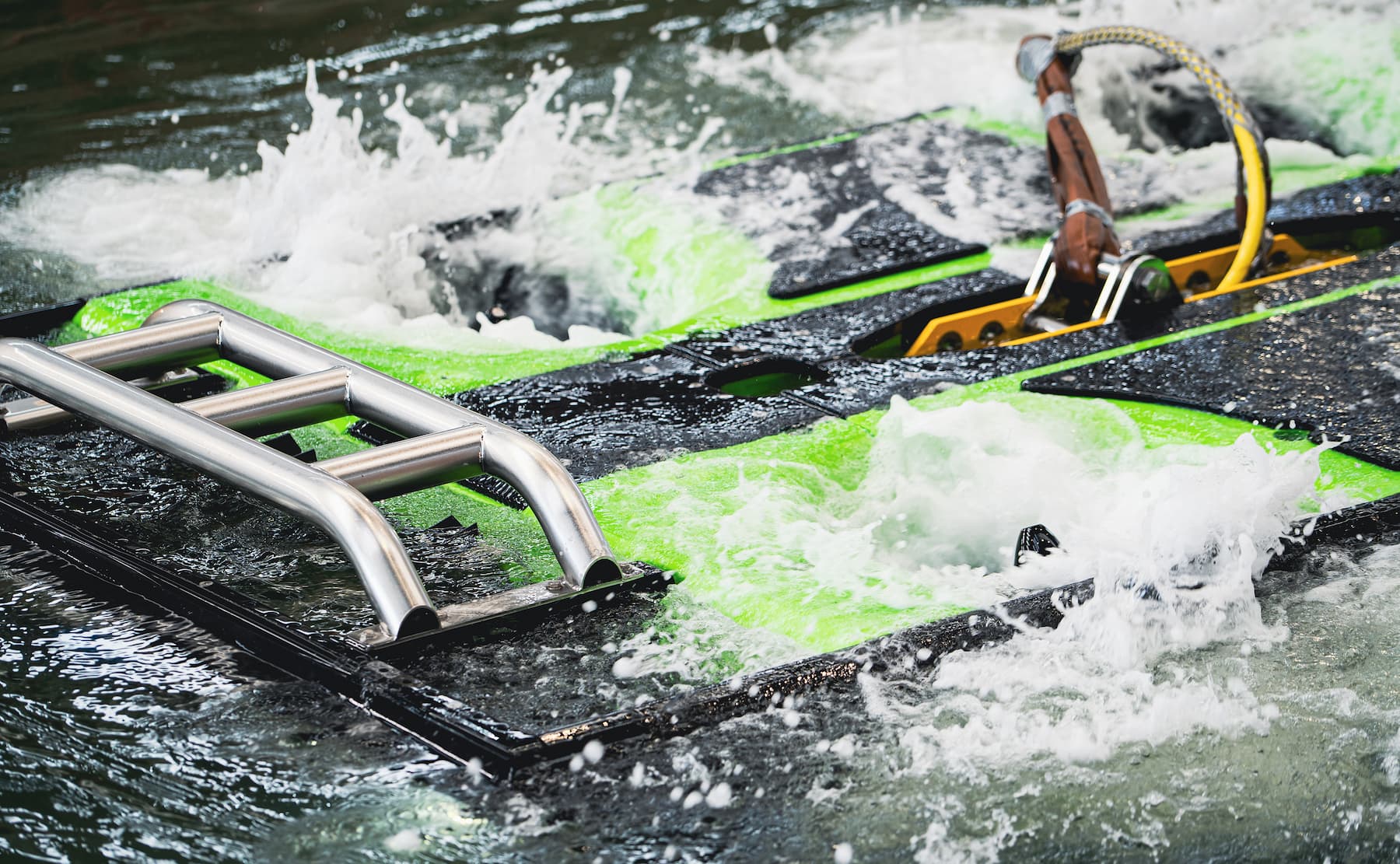
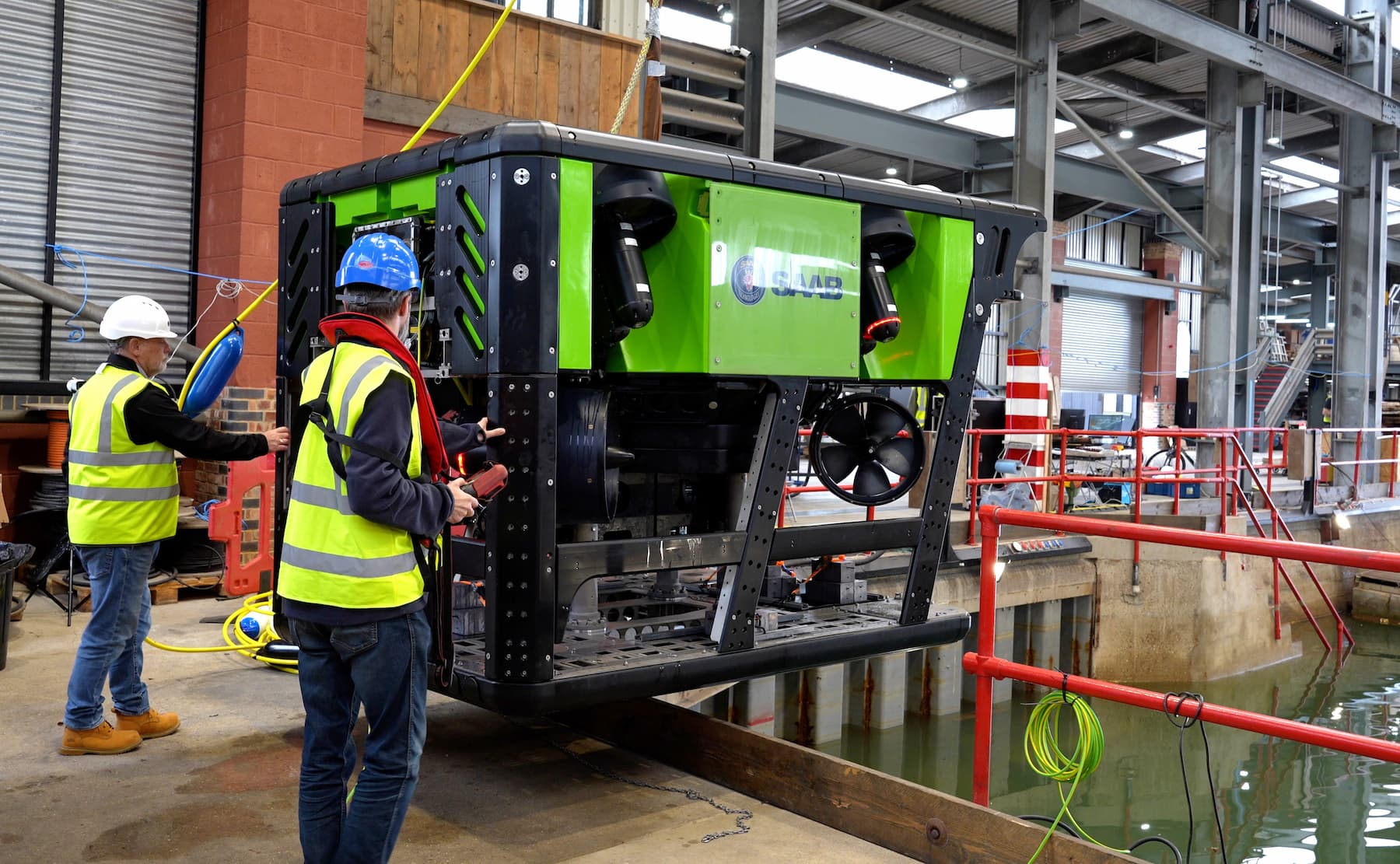
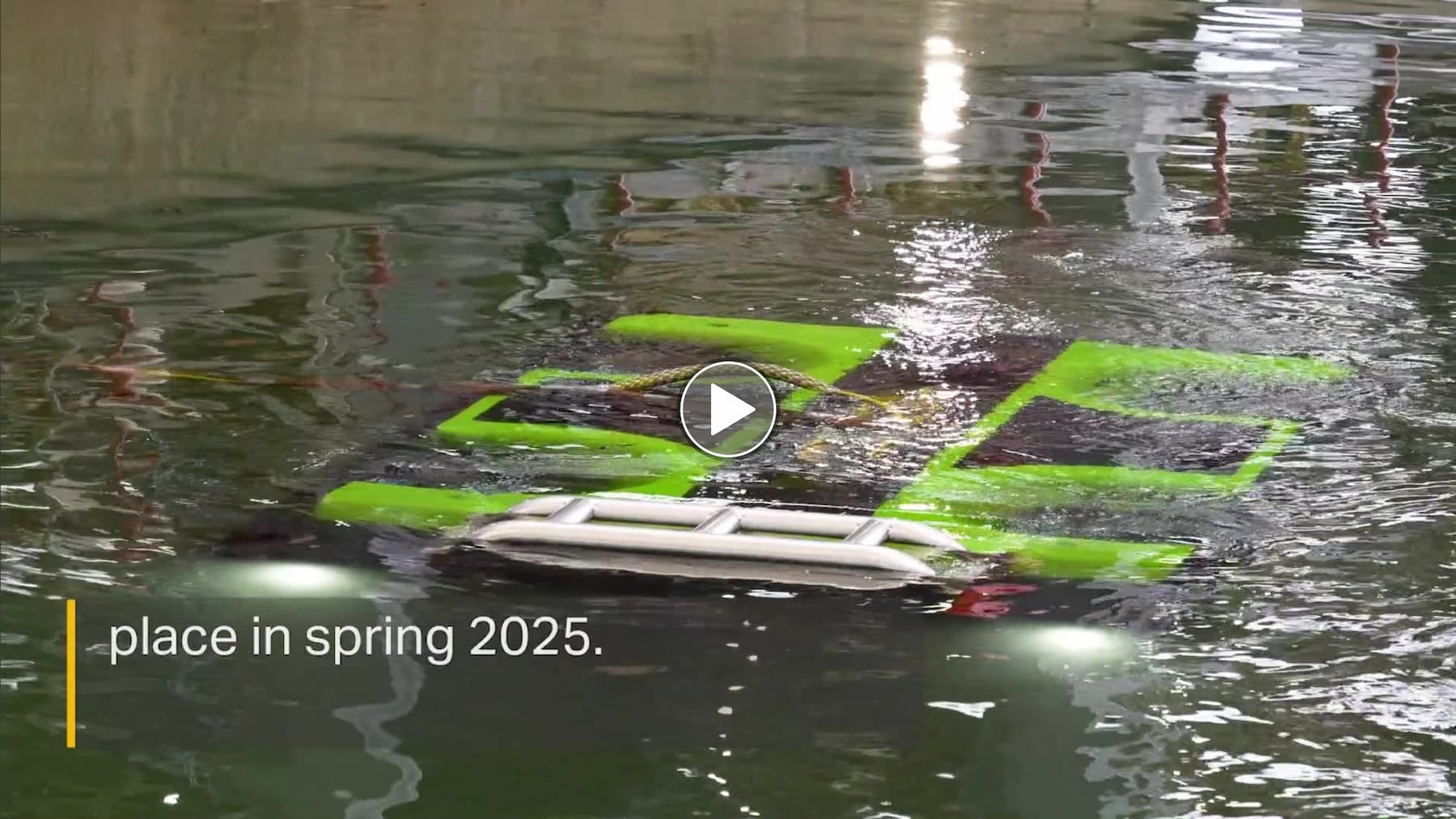
.jpg)
